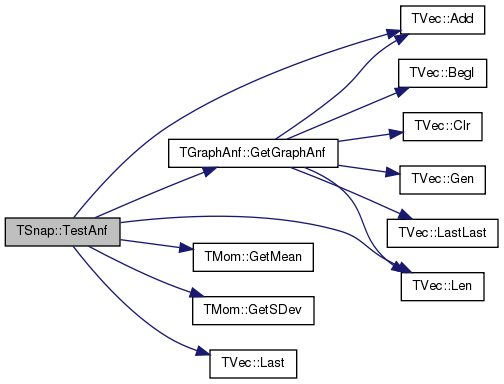|
SNAP Library , Developer Reference
2013-01-07 14:03:36
SNAP, a general purpose, high performance system for analysis and manipulation of large networks
|
|
SNAP Library , Developer Reference
2013-01-07 14:03:36
SNAP, a general purpose, high performance system for analysis and manipulation of large networks
|
Main namespace for all the Snap global entities. More...
Namespaces | |
| namespace | TSnapDetail |
Classes | |
| struct | IsDirected< TBigNet< TNodeData, IsDir > > |
| struct | IsDirected< TBigNet< TNodeData, true > > |
| struct | IsNodeDat< TBigNet< TNodeData, IsDir > > |
| struct | IsDirected |
| Tests (at compile time) if the graph is directed. More... | |
| struct | IsMultiGraph |
| Tests (at compile time) if the graph is a multigraph with multiple edges between the same nodes. More... | |
| struct | IsNodeDat |
| Tests (at compile time) if the graph is a network with data on nodes. More... | |
| struct | IsEdgeDat |
| Tests (at compile time) if the graph is a network with data on edges. More... | |
| struct | IsSources |
| Tests (at compile time) if the nodes store only out-edges, but not in-edges. More... | |
| struct | IsBipart |
| Tests (at compile time) if the graph is a bipartite graph type. More... | |
| class | IsDerivedFrom |
| Tests (at compile time) whether TDerivClass is derived from TBaseClass. More... | |
| struct | IsDirected< TNGraph > |
| struct | IsMultiGraph< TNEGraph > |
| struct | IsDirected< TNEGraph > |
| struct | IsBipart< TBPGraph > |
| struct | IsDirected< TNodeNet< TNodeData > > |
| struct | IsNodeDat< TNodeNet< TNodeData > > |
| struct | IsDirected< TNodeEDatNet< TNodeData, TEdgeData > > |
| struct | IsNodeDat< TNodeEDatNet< TNodeData, TEdgeData > > |
| struct | IsEdgeDat< TNodeEDatNet< TNodeData, TEdgeData > > |
| struct | IsMultiGraph< TNodeEdgeNet< TNodeData, TEdgeData > > |
| struct | IsDirected< TNodeEdgeNet< TNodeData, TEdgeData > > |
| struct | IsNodeDat< TNodeEdgeNet< TNodeData, TEdgeData > > |
| struct | IsEdgeDat< TNodeEdgeNet< TNodeData, TEdgeData > > |
| struct | IsDirected< TTimeNet > |
| struct | IsNodeDat< TTimeNet > |
| struct | IsMultiGraph< TTimeNENet > |
| struct | IsDirected< TTimeNENet > |
| struct | IsNodeDat< TTimeNENet > |
| struct | IsEdgeDat< TTimeNENet > |
Functions | |
| template<class PGraph > | |
| int | CntInDegNodes (const PGraph &Graph, const int &NodeInDeg) |
| Returns the number of nodes with in-degree NodeInDeg. | |
| template<class PGraph > | |
| int | CntOutDegNodes (const PGraph &Graph, const int &NodeOutDeg) |
| Returns the number of nodes with out-degree NodeOutDeg. | |
| template<class PGraph > | |
| int | CntDegNodes (const PGraph &Graph, const int &NodeDeg) |
| Returns the number of nodes with degree NodeDeg. | |
| template<class PGraph > | |
| int | CntNonZNodes (const PGraph &Graph) |
| Returns the number of nodes with degree greater than 0. | |
| template<class PGraph > | |
| int | CntEdgesToSet (const PGraph &Graph, const int &NId, const TIntSet &NodeSet) |
| TODO ROK document CntEdgesToSet() | |
| template<class PGraph > | |
| int | GetMxDegNId (const PGraph &Graph) |
| Returns a randomly chosen node from all the nodes with the maximum degree. | |
| template<class PGraph > | |
| int | GetMxInDegNId (const PGraph &Graph) |
| Returns a randomly chosen node from all the nodes with the maximum in-degree. | |
| template<class PGraph > | |
| int | GetMxOutDegNId (const PGraph &Graph) |
| Returns a randomly chosen node from all the nodes with the maximum out-degree. | |
| template<class PGraph > | |
| void | GetInDegCnt (const PGraph &Graph, TIntPrV &DegToCntV) |
| TODO ROK document GetInDegCnt() | |
| template<class PGraph > | |
| void | GetOutDegCnt (const PGraph &Graph, TIntPrV &DegToCntV) |
| TODO ROK document GetOutDegCnt() | |
| template<class PGraph > | |
| void | GetDegCnt (const PGraph &Graph, TIntPrV &DegToCntV) |
| TODO ROK document GetDegCnt() | |
| template<class PGraph > | |
| void | GetDegSeqV (const PGraph &Graph, TIntV &DegV) |
| TODO ROK document GetDegSeqV() | |
| template<class PGraph > | |
| void | GetDegSeqV (const PGraph &Graph, TIntV &InDegV, TIntV &OutDegV) |
| TODO ROK document GetDegSeqV() | |
| template<class PGraph > | |
| void | GetNodeInDegV (const PGraph &Graph, TIntPrV &NIdInDegV) |
| template<class PGraph > | |
| void | GetNodeOutDegV (const PGraph &Graph, TIntPrV &NIdOutDegV) |
| template<class PGraph > | |
| int | CntUniqUndirEdges (const PGraph &Graph) |
| Counts unique undirected edges in the graph Graph. | |
| template<class PGraph > | |
| int | CntUniqDirEdges (const PGraph &Graph) |
| Counts unique directed edges in the graph Graph. | |
| template<class PGraph > | |
| int | CntUniqBiDirEdges (const PGraph &Graph) |
| Counts unique bidirectional edges in the graph Graph. | |
| template<class PGraph > | |
| int | CntSelfEdges (const PGraph &Graph) |
| template<class PGraph > | |
| PGraph | GetUnDir (const PGraph &Graph) |
| template<class PGraph > | |
| void | MakeUnDir (const PGraph &Graph) |
| template<class PGraph > | |
| void | AddSelfEdges (const PGraph &Graph) |
| template<class PGraph > | |
| void | DelSelfEdges (const PGraph &Graph) |
| template<class PGraph > | |
| void | DelBiDirEdges (const PGraph &Graph) |
| template<class PGraph > | |
| void | DelNodes (PGraph &Graph, const TIntV &NIdV) |
| template<class PGraph > | |
| void | DelZeroDegNodes (PGraph &Graph) |
| template<class PGraph > | |
| void | DelDegKNodes (PGraph &Graph, const int &OutDegK, const int &InDegK) |
| template<class PGraph > | |
| bool | IsTree (const PGraph &Graph, int &RootNId) |
| template<class PGraph > | |
| int | GetTreeRootNId (const PGraph &Graph) |
| template<class PGraph > | |
| void | GetTreeSig (const PGraph &Graph, const int &RootNId, TIntV &Sig) |
| template<class PGraph > | |
| void | GetTreeSig (const PGraph &Graph, const int &RootNId, TIntV &Sig, TIntPrV &NodeMap) |
| template<class PGraph > | |
| void | GetAnf (const PGraph &Graph, const int &SrcNId, TIntFltKdV &DistNbrsV, const int &MxDist, const bool &IsDir, const int &NApprox=32) |
| template<class PGraph > | |
| void | GetAnf (const PGraph &Graph, TIntFltKdV &DistNbrsV, const int &MxDist, const bool &IsDir, const int &NApprox=32) |
| template<class PGraph > | |
| double | GetAnfEffDiam (const PGraph &Graph, const bool &IsDir, const double &Percentile, const int &NApprox) |
| template<class PGraph > | |
| double | GetAnfEffDiam (const PGraph &Graph, const int NRuns=1, int NApprox=-1) |
| template<class PGraph > | |
| void | TestAnf () |
| template<class PGraph > | |
| PNGraph | GetBfsTree (const PGraph &Graph, const int &StartNId, const bool &FollowOut, const bool &FollowIn) |
| template<class PGraph > | |
| int | GetSubTreeSz (const PGraph &Graph, const int &StartNId, const bool &FollowOut, const bool &FollowIn, int &TreeSz, int &TreeDepth) |
| Returns the BFS tree size (number of nodes) and depth (number of levels) by following in-links (parameter FollowIn = true) and/or out-links (parameter FollowOut = true) of node StartNId. | |
| template<class PGraph > | |
| int | GetNodesAtHop (const PGraph &Graph, const int &StartNId, const int &Hop, TIntV &NIdV, const bool &IsDir=false) |
| template<class PGraph > | |
| int | GetNodesAtHops (const PGraph &Graph, const int &StartNId, TIntPrV &HopCntV, const bool &IsDir=false) |
| template<class PGraph > | |
| int | GetShortPath (const PGraph &Graph, const int &SrcNId, const int &DstNId, const bool &IsDir=false) |
| template<class PGraph > | |
| int | GetShortPath (const PGraph &Graph, const int &SrcNId, TIntH &NIdToDistH, const bool &IsDir=false, const int &MaxDist=TInt::Mx) |
| template<class PGraph > | |
| int | GetBfsFullDiam (const PGraph &Graph, const int &NTestNodes, const bool &IsDir=false) |
| template<class PGraph > | |
| double | GetBfsEffDiam (const PGraph &Graph, const int &NTestNodes, const bool &IsDir=false) |
| template<class PGraph > | |
| double | GetBfsEffDiam (const PGraph &Graph, const int &NTestNodes, const bool &IsDir, double &EffDiam, int &FullDiam) |
| template<class PGraph > | |
| double | GetBfsEffDiam (const PGraph &Graph, const int &NTestNodes, const bool &IsDir, double &EffDiam, int &FullDiam, double &AvgDiam) |
| template<class PGraph > | |
| double | GetBfsEffDiam (const PGraph &Graph, const int &NTestNodes, const TIntV &SubGraphNIdV, const bool &IsDir, double &EffDiam, int &FullDiam) |
| double | GetDegreeCentr (const PUNGraph &Graph, const int &NId) |
| double | GetFarnessCentr (const PUNGraph &Graph, const int &NId) |
| double | GetClosenessCentr (const PUNGraph &Graph, const int &NId) |
| void | GetBetweennessCentr (const PUNGraph &Graph, const TIntV &BtwNIdV, TIntFltH &NodeBtwH, const bool &DoNodeCent, TIntPrFltH &EdgeBtwH, const bool &DoEdgeCent) |
| void | GetBetweennessCentr (const PUNGraph &Graph, TIntFltH &NodeBtwH, const double &NodeFrac) |
| void | GetBetweennessCentr (const PUNGraph &Graph, TIntFltH &NodeBtwH, TIntPrFltH &EdgeBtwH, const double &NodeFrac) |
| void | GetEigenVectorCentr (const PUNGraph &Graph, TIntFltH &NIdEigenH, const double &Eps, const int &MaxIter) |
| template<class PGraph > | |
| int | GetNodeEcc (const PGraph &Graph, const int &NId, const bool &IsDir=false) |
| template<class PGraph > | |
| void | GetPageRank (const PGraph &Graph, TIntFltH &PRankH, const double &C=0.85, const double &Eps=1e-4, const int &MaxIter=100) |
| template<class PGraph > | |
| void | GetHits (const PGraph &Graph, TIntFltH &NIdHubH, TIntFltH &NIdAuthH, const int &MaxIter=20) |
| double | CommunityGirvanNewman (PUNGraph &Graph, TCnComV &CmtyV) |
| double | CommunityCNM (const PUNGraph &Graph, TCnComV &CmtyV) |
| template<typename PGraph > | |
| double | GetModularity (const PGraph &G, const TIntV &NIdV, int GEdges=-1) |
| template<typename PGraph > | |
| void | GetEdgesInOut (const PGraph &Graph, const TIntV &NIdV, int &EdgesIn, int &EdgesOut) |
| void | GetBiConSzCnt (const PUNGraph &Graph, TIntPrV &SzCntV) |
| void | GetBiCon (const PUNGraph &Graph, TCnComV &BiCnComV) |
| void | GetArtPoints (const PUNGraph &Graph, TIntV &ArtNIdV) |
| void | GetEdgeBridges (const PUNGraph &Graph, TIntPrV &EdgeV) |
| void | Get1CnComSzCnt (const PUNGraph &Graph, TIntPrV &SzCntV) |
| void | Get1CnCom (const PUNGraph &Graph, TCnComV &Cn1ComV) |
| PUNGraph | GetMxBiCon (const PUNGraph &Graph, const bool &RenumberNodes) |
| template<class PGraph > | |
| void | GetNodeWcc (const PGraph &Graph, const int &NId, TIntV &CnCom) |
| Returns (via output parameter CnCom) all nodes that are in the same connected component as node NId. | |
| template<class PGraph > | |
| bool | IsConnected (const PGraph &Graph) |
| Tests whether the Graph is (weakly) connected. | |
| template<class PGraph > | |
| bool | IsWeaklyConn (const PGraph &Graph) |
| Tests whether the Graph is weakly connected. | |
| template<class PGraph > | |
| void | GetWccSzCnt (const PGraph &Graph, TIntPrV &WccSzCnt) |
| template<class PGraph > | |
| void | GetWccs (const PGraph &Graph, TCnComV &CnComV) |
| template<class PGraph > | |
| void | GetSccSzCnt (const PGraph &Graph, TIntPrV &SccSzCnt) |
| template<class PGraph > | |
| void | GetSccs (const PGraph &Graph, TCnComV &CnComV) |
| template<class PGraph > | |
| double | GetMxWccSz (const PGraph &Graph) |
| Returns the fraction of nodes in the largest weakly connected component of a Graph. | |
| template<class PGraph > | |
| PGraph | GetMxWcc (const PGraph &Graph) |
| template<class PGraph > | |
| PGraph | GetMxScc (const PGraph &Graph) |
| template<class PGraph > | |
| PGraph | GetMxBiCon (const PGraph &Graph) |
| TStr | GetFlagStr (const TGraphFlag &GraphFlag) |
| Returns a string representation of a flag. | |
| template<class PGraph > | |
| void | PrintInfo (const PGraph &Graph, const TStr &Desc="", const TStr &OutFNm="", const bool &Fast=true) |
| template<class PGraph > | |
| int | GetTriads (const PGraph &Graph, int &ClosedTriads, int &OpenTriads, int SampleNodes=-1) |
| PBPGraph | GenRndBipart (const int &LeftNodes, const int &RightNodes, const int &Edges, TRnd &Rnd=TInt::Rnd) |
| Generates a random bipartite graph. | |
| PUNGraph | GenRndDegK (const int &Nodes, const int &NodeDeg, const int &NSwitch=100, TRnd &Rnd=TInt::Rnd) |
| Generates a random graph where each node has degree exactly NodeDeg. | |
| PUNGraph | GenRndPowerLaw (const int &Nodes, const double &PowerExp, const bool &ConfModel=true, TRnd &Rnd=TInt::Rnd) |
| Generates a random scale-free graph with power-law degree distribution. | |
| PUNGraph | GenDegSeq (const TIntV &DegSeqV, TRnd &Rnd=TInt::Rnd) |
| Generates a random graph with exact degree sequence. | |
| PUNGraph | GenConfModel (const TIntV &DegSeqV, TRnd &Rnd=TInt::Rnd) |
| Generates a random undirect graph with a given degree sequence. | |
| PUNGraph | GenRewire (const PUNGraph &Graph, const int &NSwitch=100, TRnd &Rnd=TInt::Rnd) |
| Rewire a random undirected graph. Keeps node degrees the same, but randomly rewires the edges. | |
| PUNGraph | GenPrefAttach (const int &Nodes, const int &NodeOutDeg, TRnd &Rnd=TInt::Rnd) |
| Generates a power-law degree distribution using Barabasi-Albert model of scale-free graphs. | |
| PUNGraph | GenGeoPrefAttach (const int &Nodes, const int &OutDeg, const double &Beta, TRnd &Rnd=TInt::Rnd) |
| Generates a random scale-free graph using the Geometric Preferential model. | |
| PUNGraph | GenSmallWorld (const int &Nodes, const int &NodeOutDeg, const double &RewireProb, TRnd &Rnd=TInt::Rnd) |
| Generates a randomly small-world graph using the Watts-Strogatz model. | |
| PNGraph | GenForestFire (const int &Nodes, const double &FwdProb, const double &BckProb) |
| Generates a random Forest Fire, directed graph with given probabilities. | |
| PNGraph | GenCopyModel (const int &Nodes, const double &Beta, TRnd &Rnd=TInt::Rnd) |
| Generates a random scale-free network using the Copying Model. | |
| PNGraph | GenRMat (const int &Nodes, const int &Edges, const double &A, const double &B, const double &C, TRnd &Rnd=TInt::Rnd) |
| Generates a R-MAT graph using recursive descent into a 2x2 matrix [A,B; C, 1-(A+B+C)]. | |
| PNGraph | GenRMatEpinions () |
| Generates a R-Mat graph, with a synthetic copy of the Epinions social network. | |
| template<class PGraph > | |
| PGraph | GenGrid (const int &Rows, const int &Cols, const bool &IsDir=true) |
| Generates a 2D-grid graph of Rows rows and Cols columns. | |
| template<class PGraph > | |
| PGraph | GenStar (const int &Nodes, const bool &IsDir=true) |
| Generates a graph with star topology. Node id 0 is in the center and then links to all other nodes. | |
| template<class PGraph > | |
| PGraph | GenCircle (const int &Nodes, const int &NodeOutDeg=1, const bool &IsDir=true) |
| Generates a circle graph where every node creates out-links to NodeOutDeg forward nodes. | |
| template<class PGraph > | |
| PGraph | GenFull (const int &Nodes) |
| Generates a complete graph on Nodes nodes. Graph has no self-loops. | |
| template<class PGraph > | |
| PGraph | GenTree (const int &Fanout, const int &Levels, const bool &IsDir=true, const bool &ChildPointsToParent=true) |
| Generates a tree graph of Levels levels with every parent having Fanout children. | |
| template<class PGraph > | |
| PGraph | GenBaraHierar (const int &Levels, const bool &IsDir=true) |
| Generates a Ravasz-Barabasi deterministic scale-free graph. | |
| template<class PGraph > | |
| PGraph | GenRndGnm (const int &Nodes, const int &Edges, const bool &IsDir=true, TRnd &Rnd=TInt::Rnd) |
| Generates an Erdos-Renyi random graph. | |
| PNGraph | LoadDyNet (const TStr &FNm) |
| For more info see ORA Network Analysis Data (http://www.casos.cs.cmu.edu/computational_tools/data2.php) | |
| TVec< PNGraph > | LoadDyNetGraphV (const TStr &FNm) |
| For more info see ORA Network Analysis Data (http://www.casos.cs.cmu.edu/computational_tools/data2.php) | |
| template<class PGraph > | |
| PGraph | LoadEdgeList (const TStr &InFNm, const int &SrcColId=0, const int &DstColId=1) |
| Loads a (directed, undirected or multi) graph from a text file InFNm with 1 edge per line (whitespace separated columns, integer node ids). | |
| template<class PGraph > | |
| PGraph | LoadEdgeList (const TStr &InFNm, const int &SrcColId, const int &DstColId, const char &Separator) |
| Loads a (directed, undirected or multi) graph from a text file InFNm with 1 edge per line ('Separator' separated columns, integer node ids). | |
| template<class PGraph > | |
| PGraph | LoadEdgeListStr (const TStr &InFNm, const int &SrcColId=0, const int &DstColId=1) |
| Loads a (directed, undirected or multi) graph from a text file InFNm with 1 edge per line (whitespace separated columns, arbitrary string node ids). | |
| template<class PGraph > | |
| PGraph | LoadEdgeListStr (const TStr &InFNm, const int &SrcColId, const int &DstColId, TStrHash< TInt > &StrToNIdH) |
| Loads a (directed, undirected or multi) graph from a text file InFNm with 1 edge per line (whitespace separated columns, arbitrary string node ids). | |
| template<class PGraph > | |
| PGraph | LoadConnList (const TStr &InFNm) |
| Loads a (directed, undirected or multi) graph from a text file InFNm with 1 node and all its edges in a single line. | |
| template<class PGraph > | |
| PGraph | LoadConnListStr (const TStr &InFNm, TStrHash< TInt > &StrToNIdH) |
| Loads a (directed, undirected or multi) graph from a text file InFNm with 1 node and all its edges in a single line. | |
| template<class PGraph > | |
| PGraph | LoadPajek (const TStr &InFNm) |
| Loads a (directed, undirected or multi) graph from Pajek .PAJ format file. | |
| template<class PGraph > | |
| void | SaveEdgeList (const PGraph &Graph, const TStr &OutFNm, const TStr &Desc=TStr()) |
| Saves a graph into a text file. Each line contains two columns and encodes a single edge: <source node="" id>=""><tab><destination node="" id>=""> | |
| template<class PGraph > | |
| void | SavePajek (const PGraph &Graph, const TStr &OutFNm) |
| Saves a graph in a Pajek .NET format. | |
| template<class PGraph > | |
| void | SavePajek (const PGraph &Graph, const TStr &OutFNm, const TIntStrH &NIdColorH) |
| Saves a graph in a Pajek .NET format. | |
| template<class PGraph > | |
| void | SavePajek (const PGraph &Graph, const TStr &OutFNm, const TIntStrH &NIdColorH, const TIntStrH &NIdLabelH) |
| Saves a graph in a Pajek .NET format. | |
| template<class PGraph > | |
| void | SavePajek (const PGraph &Graph, const TStr &OutFNm, const TIntStrH &NIdColorH, const TIntStrH &NIdLabelH, const TIntStrH &EIdColorH) |
| Saves a graph in a Pajek .NET format. | |
| template<class PGraph > | |
| void | SaveMatlabSparseMtx (const PGraph &Graph, const TStr &OutFNm) |
| Saves a graph in a MATLAB sparse matrix format. | |
| template<class PGraph > | |
| void | SaveGViz (const PGraph &Graph, const TStr &OutFNm, const TStr &Desc=TStr(), const bool &NodeLabels=false, const TIntStrH &NIdColorH=TIntStrH()) |
| Save a graph in GraphVizp .DOT format. | |
| template<class PGraph > | |
| void | SaveGViz (const PGraph &Graph, const TStr &OutFNm, const TStr &Desc, const TIntStrH &NIdLabelH) |
| Save a graph in GraphVizp .DOT format. | |
| void | SetAllInvertSign (TFltV &ValV, const double &Val) |
| bool | IsAllValVNeg (TFltV &ValV, const bool &InvertSign) |
| void | GetSngVals (const PNGraph &Graph, const int &SngVals, TFltV &SngValV) |
| Computes largest SngVals singular values of the adjacency matrix representing a directed Graph. | |
| void | GetSngVec (const PNGraph &Graph, TFltV &LeftSV, TFltV &RightSV) |
| Computes the leading left and right singular vector of the adjacency matrix representing a directed Graph. | |
| void | GetSngVec (const PNGraph &Graph, const int &SngVecs, TFltV &SngValV, TVec< TFltV > &LeftSV, TVec< TFltV > &RightSV) |
| void | GetEigVals (const PUNGraph &Graph, const int &EigVals, TFltV &EigValV) |
| Computes top EigVals eigenvalues of the adjacency matrix representing a given undirected Graph. | |
| void | GetEigVec (const PUNGraph &Graph, TFltV &EigVecV) |
| Computes the leading eigenvector of the adjacency matrix representing a given undirected Graph. | |
| void | GetEigVec (const PUNGraph &Graph, const int &EigVecs, TFltV &EigValV, TVec< TFltV > &EigVecV) |
| Computes top EigVecs eigenvalues and eigenvectors of the adjacency matrix representing a given undirected Graph. | |
| void | GetInvParticipRat (const PUNGraph &Graph, int MaxEigVecs, int TimeLimit, TFltPrV &EigValIprV) |
| template<class PGraph > | |
| void | DrawGViz (const PGraph &Graph, const TGVizLayout &Layout, const TStr &PltFNm, const TStr &Desc=TStr(), const bool &NodeLabels=false, const TIntStrH &NIdColorH=TIntStrH()) |
| template<class PGraph > | |
| void | DrawGViz (const PGraph &Graph, const TGVizLayout &Layout, const TStr &PltFNm, const TStr &Desc, const TIntStrH &NIdColorH) |
| template<class PGraph > | |
| PGraph | GetKCore (const PGraph &Graph, const int &K) |
| void | PlotEigValRank (const PUNGraph &Graph, const int &EigVals, const TStr &FNmPref, TStr DescStr=TStr()) |
| Plots the eigen-value rank distribution of the Graph adjacency matrix. Plots first EigVals eigenvalues. | |
| void | PlotEigValDistr (const PUNGraph &Graph, const int &EigVals, const TStr &FNmPref, TStr DescStr=TStr()) |
| Plots the distribution of components of the leading eigen-vector of the Graph adjacency matrix. Plots first EigVals values. | |
| void | PlotInvParticipRat (const PUNGraph &Graph, const int &MaxEigVecs, const int &TimeLimit, const TStr &FNmPref, TStr DescStr) |
| void | PlotSngValRank (const PNGraph &Graph, const int &SngVals, const TStr &FNmPref, TStr DescStr=TStr()) |
| Plots the rank distribution of singular values of the Graph adjacency matrix. Plots first SngVals values. | |
| void | PlotSngValDistr (const PNGraph &Graph, const int &SngVals, const TStr &FNmPref, TStr DescStr=TStr()) |
| Plots the rank distribution of singular values of the Graph adjacency matrix. Plots first SngVals values. | |
| void | PlotSngVec (const PNGraph &Graph, const TStr &FNmPref, TStr DescStr=TStr()) |
| Plots the distribution of the values of the leading left singular vector of the Graph adjacency matrix. Plots first SngVals values. | |
| template<class PGraph > | |
| void | PlotInDegDistr (const PGraph &Graph, const TStr &FNmPref, TStr DescStr=TStr(), const bool &PlotCCdf=false, const bool &PowerFit=false) |
| template<class PGraph > | |
| void | PlotOutDegDistr (const PGraph &Graph, const TStr &FNmPref, TStr DescStr=TStr(), const bool &PlotCCdf=false, const bool &PowerFit=false) |
| template<class PGraph > | |
| void | PlotWccDistr (const PGraph &Graph, const TStr &FNmPref, TStr DescStr=TStr()) |
| Plots the distribution of sizes of weakly connected components of a Graph. | |
| template<class PGraph > | |
| void | PlotSccDistr (const PGraph &Graph, const TStr &FNmPref, TStr DescStr=TStr()) |
| Plots the distribution of sizes of strongly connected components of a Graph. | |
| template<class PGraph > | |
| void | PlotClustCf (const PGraph &Graph, const TStr &FNmPref, TStr DescStr=TStr()) |
| Plots the distribution of clustering coefficient of a Graph. | |
| template<class PGraph > | |
| void | PlotHops (const PGraph &Graph, const TStr &FNmPref, const TStr &DescStr, const bool &IsDir=false, const int &NApprox=32) |
| template<class PGraph > | |
| void | PlotShortPathDistr (const PGraph &Graph, const TStr &FNmPref, TStr DescStr=TStr(), int TestNodes=TInt::Mx) |
| Plots the distribution of the shortest path lengths of a Graph. Implementation is based on BFS. | |
| PUNGraph | GetSubGraph (const PUNGraph &Graph, const TIntV &NIdV, const bool &RenumberNodes=false) |
| Returns an induced subgraph of an undirected graph Graph with NIdV nodes with an optional node renumbering. | |
| template<class PGraph > | |
| PGraph | GetSubGraph (const PGraph &Graph, const TIntV &NIdV) |
| Returns an induced subgraph of graph Graph with NIdV nodes. | |
| template<class PGraph > | |
| PGraph | GetESubGraph (const PGraph &Graph, const TIntV &EIdV) |
| Returns a subgraph of graph Graph with EIdV edges. | |
| template<class PGraph , class TEdgeDat > | |
| PGraph | GetEDatSubGraph (const PGraph &Graph, const TEdgeDat &EDat, const int &Cmp) |
| Returns a subgraph of graph Graph with edges where edge data matches the parameters. | |
| template<class PGraph , class TEdgeDat > | |
| PGraph | GetEDatSubGraph (const PGraph &Graph, const TIntV &NIdV, const TEdgeDat &EDat, const int &Cmp) |
| Returns a subgraph of graph Graph with NIdV nodes and edges where edge data matches the parameters. | |
| template<class POutGraph , class PInGraph > | |
| POutGraph | ConvertGraph (const PInGraph &InGraph, const bool &RenumberNodes=false) |
| Performs conversion of graph InGraph with an optional node renumbering. | |
| template<class POutGraph , class PInGraph > | |
| POutGraph | ConvertSubGraph (const PInGraph &InGraph, const TIntV &NIdV, const bool &RenumberNodes=false) |
| Returns an induced subgraph of graph InGraph with NIdV nodes with an optional node renumbering. | |
| template<class POutGraph , class PInGraph > | |
| POutGraph | ConvertESubGraph (const PInGraph &InGraph, const TIntV &EIdV, const bool &RenumberNodes=false) |
| Returns a subgraph of graph InGraph with EIdV edges with an optional node renumbering. | |
| template<class PGraph > | |
| PGraph | GetRndSubGraph (const PGraph &Graph, const int &NNodes) |
| Returns an induced random subgraph of graph Graph with NNodes nodes. | |
| template<class PGraph > | |
| PGraph | GetRndESubGraph (const PGraph &Graph, const int &NEdges) |
| Returns a random subgraph of graph Graph with NEdges edges. | |
| template<class PGraph > | |
| double | GetClustCf (const PGraph &Graph, int SampleNodes=-1) |
| Computes the average clustering coefficient as defined in Watts and Strogatz, Collective dynamics of 'small-world' networks. | |
| template<class PGraph > | |
| double | GetClustCf (const PGraph &Graph, TFltPrV &DegToCCfV, int SampleNodes=-1) |
| template<class PGraph > | |
| double | GetClustCf (const PGraph &Graph, TFltPrV &DegToCCfV, int &ClosedTriads, int &OpenTriads, int SampleNodes=-1) |
| template<class PGraph > | |
| double | GetNodeClustCf (const PGraph &Graph, const int &NId) |
| Returns clustering coefficient of a particular node. | |
| template<class PGraph > | |
| void | GetNodeClustCf (const PGraph &Graph, TIntFltH &NIdCCfH) |
| Computes clustering coefficient of each node of the Graph. | |
| template<class PGraph > | |
| int | GetTriads (const PGraph &Graph, int SampleNodes=-1) |
| template<class PGraph > | |
| void | GetTriads (const PGraph &Graph, TIntTrV &NIdCOTriadV, int SampleNodes=-1) |
| template<class PGraph > | |
| int | GetTriadEdges (const PGraph &Graph, int SampleEdges=-1) |
| template<class PGraph > | |
| int | GetNodeTriads (const PGraph &Graph, const int &NId) |
| Returns number of undirected triads a node NId participates in. | |
| template<class PGraph > | |
| int | GetNodeTriads (const PGraph &Graph, const int &NId, int &ClosedTriads, int &OpenTriads) |
| Returns number of undirected Open and Closed triads a node NId participates in. | |
| template<class PGraph > | |
| int | GetNodeTriads (const PUNGraph &Graph, const int &NId, const TIntSet &GroupSet, int &InGroupEdges, int &InOutGroupEdges) |
| template<class PGraph > | |
| int | GetNodeTriads (const PUNGraph &Graph, const int &NId, const TIntSet &GroupSet, int &InGroupEdges, int &InOutGroupEdges, int &OutGroup) |
| template<class PGraph > | |
| void | GetTriadParticip (const PGraph &Graph, TIntPrV &TriadCntV) |
| Triangle Participation Ratio: For each node counts how many triangles it participates in and then returns a set of pairs (number of triangles, number of such nodes). | |
| template<class PGraph > | |
| int | GetCmnNbrs (const PGraph &Graph, const int &NId1, const int &NId2) |
| Returns a number of shared neighbors between a pair of nodes NId1 and NId2. | |
| template<class PGraph > | |
| int | GetCmnNbrs (const PGraph &Graph, const int &NId1, const int &NId2, TIntV &NbrV) |
| Returns the shared neighbors between a pair of nodes NId1 and NId2. | |
| template<class PGraph > | |
| int | GetLen2Paths (const PGraph &Graph, const int &NId1, const int &NId2) |
| Returns the number of length 2 directed paths between a pair of nodes NId1, NId2 (NId1 --> U --> NId2). | |
| template<class PGraph > | |
| int | GetLen2Paths (const PGraph &Graph, const int &NId1, const int &NId2, TIntV &NbrV) |
| Returns the 2 directed paths between a pair of nodes NId1, NId2 (NId1 --> U --> NId2). NbrV intermediary stores nodes U. | |
| template<class PGraph > | |
| int | GetNodeTriads (const PGraph &Graph, const int &NId, const TIntSet &GroupSet, int &InGroupEdges, int &InOutGroupEdges) |
| template<class PGraph > | |
| int | GetNodeTriads (const PGraph &Graph, const int &NId, const TIntSet &GroupSet, int &InGroupEdges, int &InOutGroupEdges, int &OutGroupEdges) |
| template<> | |
| int | GetCmnNbrs< PUNGraph > (const PUNGraph &Graph, const int &NId1, const int &NId2, TIntV &NbrV) |
Main namespace for all the Snap global entities.
| void TSnap::AddSelfEdges | ( | const PGraph & | Graph | ) |
Definition at line 346 of file alg.h.
References TVec< TVal >::Add(), and TVec< TVal >::Len().
{
TIntV EdgeV;
for (typename PGraph::TObj::TNodeI NI = Graph->BegNI(); NI < Graph->EndNI(); NI++) {
const int NId = NI.GetId();
if (! Graph->IsEdge(NId, NId)) {
EdgeV.Add(NId);
}
}
for (int i = 0; i < EdgeV.Len(); i++) {
Graph->AddEdge(EdgeV[i], EdgeV[i]);
}
}

| int TSnap::CntDegNodes | ( | const PGraph & | Graph, |
| const int & | NodeDeg | ||
| ) |
Returns the number of nodes with degree NodeDeg.
Definition at line 90 of file alg.h.
Referenced by TTimeNet::LoadArxiv(), TTimeNet::LoadPatents(), and TGStat::TakeBasicStat().
{
int Cnt = 0;
for (typename PGraph::TObj::TNodeI NI = Graph->BegNI(); NI < Graph->EndNI(); NI++) {
if (NI.GetDeg() == NodeDeg) Cnt++;
}
return Cnt;
}
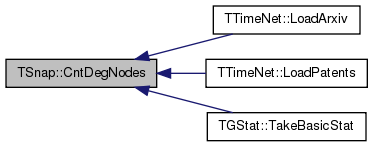
| int TSnap::CntEdgesToSet | ( | const PGraph & | Graph, |
| const int & | NId, | ||
| const TIntSet & | NodeSet | ||
| ) |
TODO ROK document CntEdgesToSet()
Definition at line 108 of file alg.h.
References THashSet< TKey, THashFunc >::AddKey(), gfDirected, and THashSet< TKey, THashFunc >::IsKey().
{
if (! Graph->IsNode(NId)) { return 0; }
const bool IsDir = Graph->HasFlag(gfDirected);
const typename PGraph::TObj::TNodeI NI = Graph->GetNI(NId);
if (! IsDir) {
int EdgesToSet = 0;
for (int e = 0; e < NI.GetOutDeg(); e++) {
if (NodeSet.IsKey(NI.GetOutNId(e))) { EdgesToSet++; } }
return EdgesToSet;
} else {
TIntSet Set(NI.GetDeg());
for (int e = 0; e < NI.GetOutDeg(); e++) {
if (NodeSet.IsKey(NI.GetOutNId(e))) { Set.AddKey(NI.GetOutNId(e)); } }
for (int e = 0; e < NI.GetInDeg(); e++) {
if (NodeSet.IsKey(NI.GetInNId(e))) { Set.AddKey(NI.GetInNId(e)); } }
return Set.Len();
}
}

| int TSnap::CntInDegNodes | ( | const PGraph & | Graph, |
| const int & | NodeInDeg | ||
| ) |
Returns the number of nodes with in-degree NodeInDeg.
Definition at line 72 of file alg.h.
Referenced by TTimeNet::LoadBipartite(), and TGStat::TakeBasicStat().
{
int Cnt = 0;
for (typename PGraph::TObj::TNodeI NI = Graph->BegNI(); NI < Graph->EndNI(); NI++) {
if (NI.GetInDeg() == NodeInDeg) Cnt++;
}
return Cnt;
}

| int TSnap::CntNonZNodes | ( | const PGraph & | Graph | ) |
Returns the number of nodes with degree greater than 0.
Definition at line 99 of file alg.h.
Referenced by TTimeNet::PlotMedianDegOverTm().
{
int Cnt = 0;
for (typename PGraph::TObj::TNodeI NI = Graph->BegNI(); NI < Graph->EndNI(); NI++) {
if (NI.GetDeg() > 0) Cnt++;
}
return Cnt;
}

| int TSnap::CntOutDegNodes | ( | const PGraph & | Graph, |
| const int & | NodeOutDeg | ||
| ) |
Returns the number of nodes with out-degree NodeOutDeg.
Definition at line 81 of file alg.h.
Referenced by TTimeNet::LoadBipartite(), and TGStat::TakeBasicStat().
{
int Cnt = 0;
for (typename PGraph::TObj::TNodeI NI = Graph->BegNI(); NI < Graph->EndNI(); NI++) {
if (NI.GetOutDeg() == NodeOutDeg) Cnt++;
}
return Cnt;
}

| int TSnap::CntSelfEdges | ( | const PGraph & | Graph | ) |
| int TSnap::CntUniqBiDirEdges | ( | const PGraph & | Graph | ) |
Counts unique bidirectional edges in the graph Graph.
Definition at line 295 of file alg.h.
References CntUniqUndirEdges(), and gfDirected.
Referenced by TGStat::TakeBasicStat().
{
if (! Graph->HasFlag(gfDirected)) { // graph is undirected
return CntUniqUndirEdges(Graph); // then every edge is bi-directional
}
TIntSet NbrSet;
int Cnt = 0;
for (typename PGraph::TObj::TNodeI NI = Graph->BegNI(); NI < Graph->EndNI(); NI++) {
const int SrcId = NI.GetId();
for (int e = 0; e < NI.GetOutDeg(); e++) {
const int DstId = NI.GetOutNId(e);
if (DstId <= SrcId) { continue; } // count each un-dir edge only once
if (Graph->IsEdge(DstId, SrcId)) { Cnt++; }
}
}
return 2*Cnt;
}


| int TSnap::CntUniqDirEdges | ( | const PGraph & | Graph | ) |
Counts unique directed edges in the graph Graph.
Definition at line 280 of file alg.h.
References THashSet< TKey, THashFunc >::AddKey(), THashSet< TKey, THashFunc >::Clr(), and THashSet< TKey, THashFunc >::Len().
Referenced by TGStat::TakeBasicStat().
{
TIntSet NbrSet;
int Cnt = 0;
for (typename PGraph::TObj::TNodeI NI = Graph->BegNI(); NI < Graph->EndNI(); NI++) {
NbrSet.Clr(false);
for (int e = 0; e < NI.GetOutDeg(); e++) { // unique out-neighbors of a node
NbrSet.AddKey(NI.GetOutNId(e));
}
Cnt += NbrSet.Len();
}
return Cnt;
}
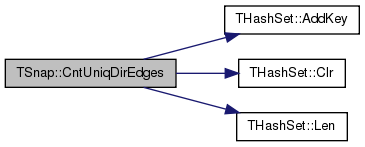

| int TSnap::CntUniqUndirEdges | ( | const PGraph & | Graph | ) |
Counts unique undirected edges in the graph Graph.
Definition at line 265 of file alg.h.
References THashSet< TKey, THashFunc >::AddKey(), THashSet< TKey, THashFunc >::Clr(), and THashSet< TKey, THashFunc >::Len().
Referenced by CntUniqBiDirEdges().
{
TIntSet NbrSet;
int Cnt = 0;
for (typename PGraph::TObj::TNodeI NI = Graph->BegNI(); NI < Graph->EndNI(); NI++) {
NbrSet.Clr(false);
for (int e = 0; e < NI.GetDeg(); e++) { // unique neighbors of a node
NbrSet.AddKey(NI.GetNbrNId(e));
}
Cnt += NbrSet.Len();
}
return Cnt / 2;
}
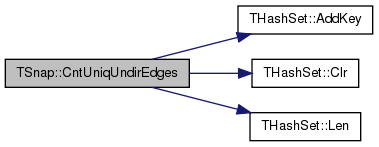

| double TSnap::CommunityCNM | ( | const PUNGraph & | Graph, |
| TCnComV & | CmtyV | ||
| ) |
Clauset-Newman-Moore community detection method for large networks. At every step of the algorithm two communities that contribute maximum positive value to global modularity are merged. See: Finding community structure in very large networks, A. Clauset, M.E.J. Newman, C. Moore, 2004
Definition at line 196 of file cmty.cpp.
References TSnap::TSnapDetail::TCNMQMatrix::CmtyCMN().
{
return TSnapDetail::TCNMQMatrix::CmtyCMN(Graph, CmtyV);
}
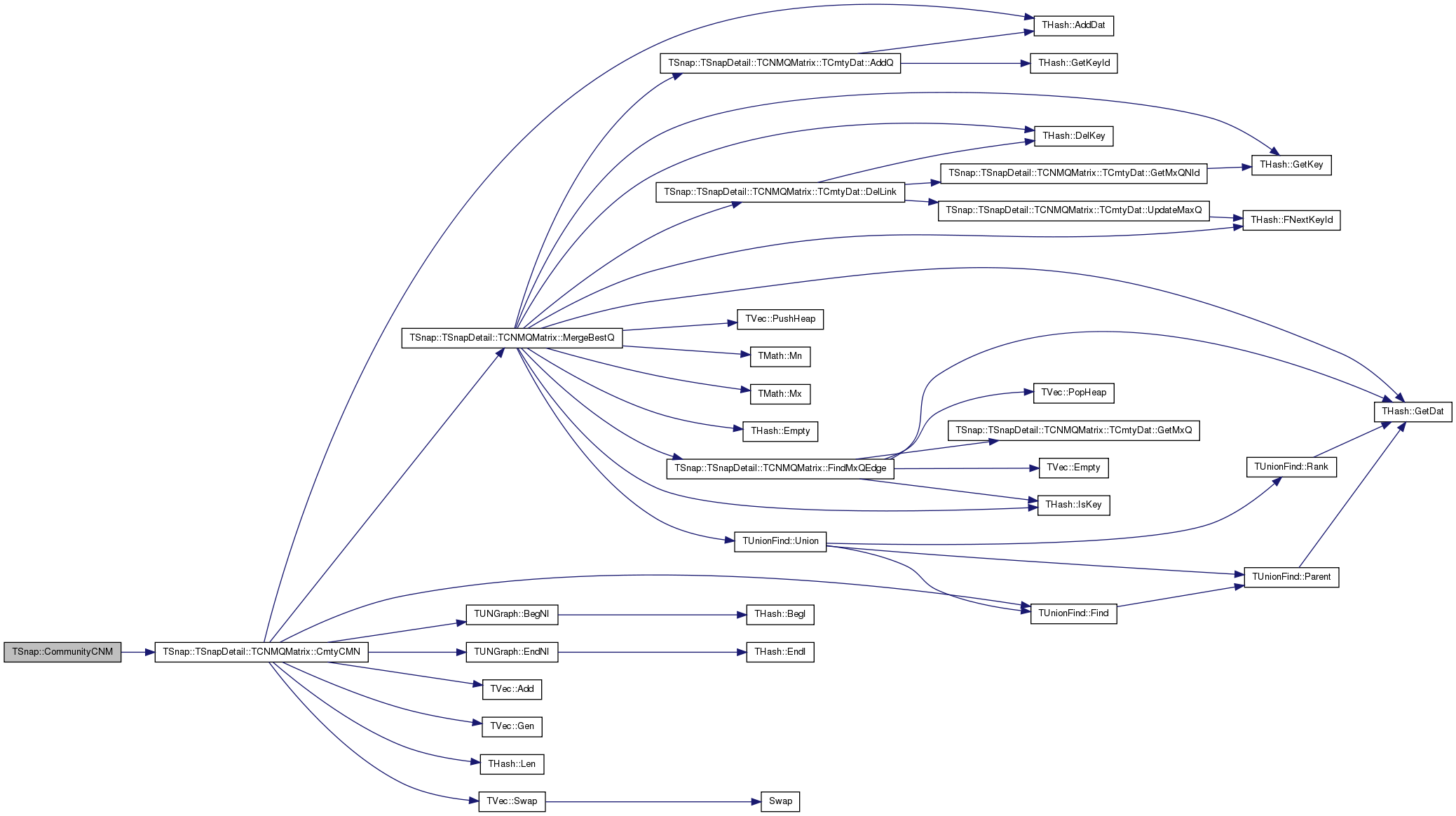
| double TSnap::CommunityGirvanNewman | ( | PUNGraph & | Graph, |
| TCnComV & | CmtyV | ||
| ) |
Girvan-Newman community detection algorithm based on Betweenness centrality. See: Girvan M. and Newman M. E. J., Community structure in social and biological networks, Proc. Natl. Acad. Sci. USA 99, 7821-7826 (2002)
Definition at line 57 of file cmty.cpp.
References TSnap::TSnapDetail::_GirvanNewmanGetModularity(), THash< TKey, TDat, THashFunc >::AddDat(), TVec< TVal >::Clr(), TSnap::TSnapDetail::CmtyGirvanNewmanStep(), TVec< TVal >::Len(), and TVec< TVal >::Swap().
{
TIntH OutDegH;
const int NEdges = Graph->GetEdges();
for (TUNGraph::TNodeI NI = Graph->BegNI(); NI < Graph->EndNI(); NI++) {
OutDegH.AddDat(NI.GetId(), NI.GetOutDeg());
}
double BestQ = -1; // modularity
TCnComV CurCmtyV;
CmtyV.Clr();
TIntV Cmty1, Cmty2;
while (true) {
TSnapDetail::CmtyGirvanNewmanStep(Graph, Cmty1, Cmty2);
const double Q = TSnapDetail::_GirvanNewmanGetModularity(Graph, OutDegH, NEdges, CurCmtyV);
//printf("current modularity: %f\n", Q);
if (Q > BestQ) {
BestQ = Q;
CmtyV.Swap(CurCmtyV);
}
if (Cmty1.Len()==0 || Cmty2.Len() == 0) { break; }
}
return BestQ;
}
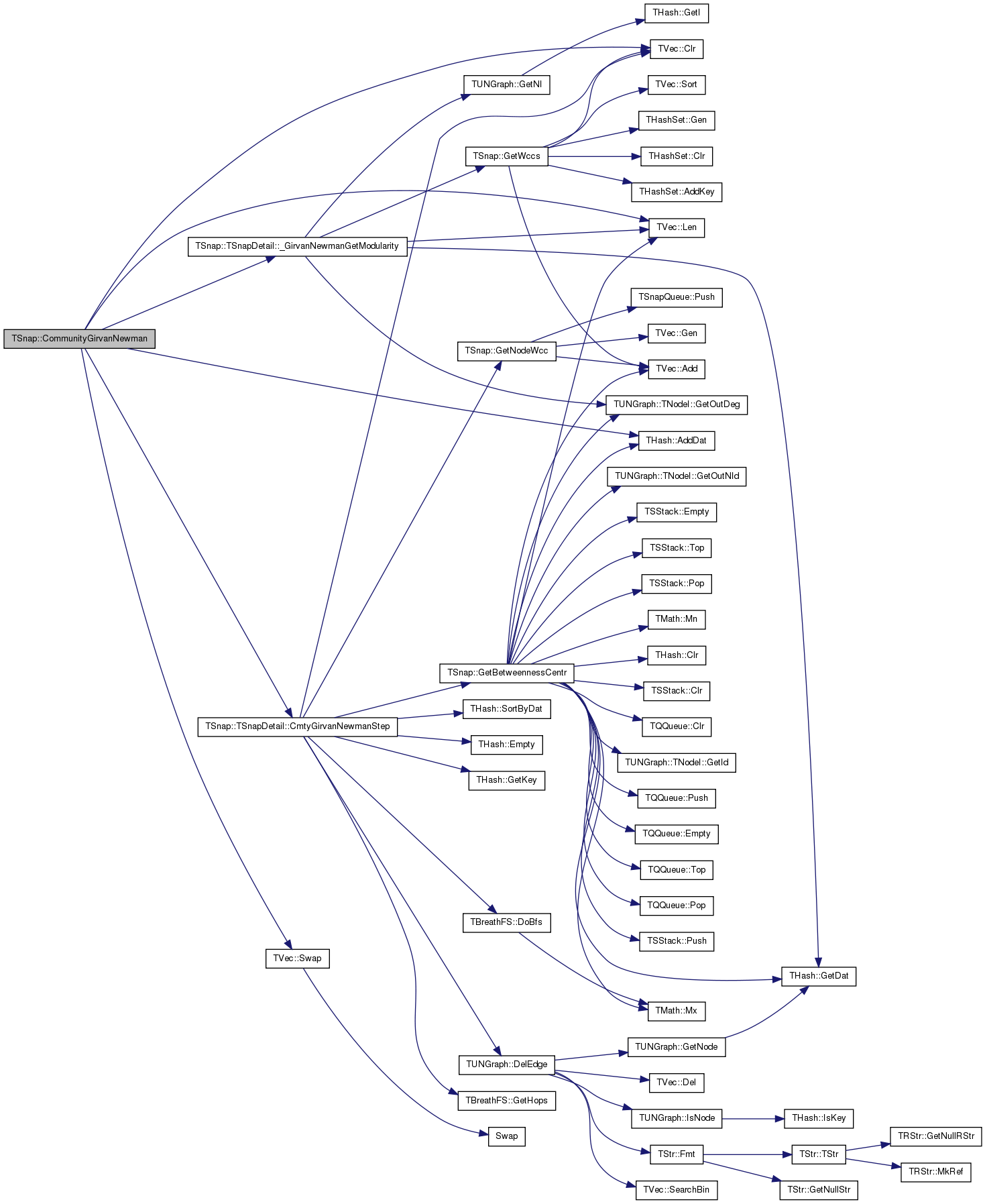
| POutGraph TSnap::ConvertESubGraph | ( | const PInGraph & | InGraph, |
| const TIntV & | EIdV, | ||
| const bool & | RenumberNodes = false |
||
| ) |
Returns a subgraph of graph InGraph with EIdV edges with an optional node renumbering.
Creates a subgraph of the input graph InGraph on EIdV edges and returns an output graph. Input and output graphs can have different types. Node and edge data is not copied, but it is shared by input and output graphs.
Parameter RenumberNodes determines, whether the node IDs are preserved or not. If RenumberNodes is false, then nodes in the resulting graph have the same node IDs as nodes in InGraph. If RenumberNodes is true, then nodes in the resulting graph are renumbered sequentially from 0 to N-1. By default, the nodes are not renumbered.
Definition at line 397 of file subgraph.h.
References CAssert, gfMultiGraph, HasGraphFlag, IAssert, and TVec< TVal >::Len().
{
CAssert(HasGraphFlag(typename PInGraph::TObj, gfMultiGraph)); // needs to have explicit edges
POutGraph NewGraphPt = POutGraph::TObj::New();
typename POutGraph::TObj& NewGraph = *NewGraphPt;
NewGraph.Reserve(-1, EIdV.Len());
if (! RenumberNodes) {
for (int edge = 0; edge < EIdV.Len(); edge++) {
const int EId = EIdV[edge];
IAssert(InGraph->IsEdge(EId));
const typename PInGraph::TObj::TEdgeI EI = InGraph->GetEI(EId);
const int SrcNId = EI.GetSrcNId();
const int DstNId = EI.GetDstNId();
if (! NewGraph.IsNode(SrcNId)) {
NewGraph.AddNode(SrcNId); }
if (! NewGraph.IsNode(DstNId)) {
NewGraph.AddNode(DstNId); }
NewGraph.AddEdge(SrcNId, DstNId);
}
} else {
// renumber nodes so that node ids are 0...N-1
TIntSet NIdSet(InGraph->GetNodes());
for (int edge = 0; edge < EIdV.Len(); edge++) {
const int EId = EIdV[edge];
IAssert(InGraph->IsEdge(EId));
const typename PInGraph::TObj::TEdgeI EI = InGraph->GetEI(EId);
const int SrcNId = NIdSet.AddKey(EI.GetSrcNId()); // map node ids
const int DstNId = NIdSet.AddKey(EI.GetDstNId());
if (! NewGraph.IsNode(SrcNId)) {
NewGraph.AddNode(SrcNId); }
if (! NewGraph.IsNode(DstNId)) {
NewGraph.AddNode(DstNId); }
NewGraph.AddEdge(SrcNId, DstNId);
}
}
return NewGraphPt;
}

| POutGraph TSnap::ConvertGraph | ( | const PInGraph & | InGraph, |
| const bool & | RenumberNodes = false |
||
| ) |
Performs conversion of graph InGraph with an optional node renumbering.
Takes an input graph InGraph and returns an output graph. Input and output graphs can have different types. Node and edge data is not copied, but it is shared by input and output graphs.
Parameter RenumberNodes determines, whether the node IDs are preserved or not. If RenumberNodes is false, then nodes in the resulting graph have the same node IDs as nodes in InGraph. If RenumberNodes is true, then nodes in the resulting graph are renumbered sequentially from 0 to N-1. By default, the nodes are not renumbered.
Definition at line 282 of file subgraph.h.
References THashSet< TKey, THashFunc >::AddKey(), gfDirected, and HasGraphFlag.
{
POutGraph OutGraphPt = POutGraph::TObj::New();
typename POutGraph::TObj& OutGraph = *OutGraphPt;
OutGraph.Reserve(InGraph->GetNodes(), InGraph->GetEdges());
if (! RenumberNodes) {
for (typename PInGraph::TObj::TNodeI NI = InGraph->BegNI(); NI < InGraph->EndNI(); NI++) {
OutGraph.AddNode(NI.GetId());
}
for (typename PInGraph::TObj::TEdgeI EI = InGraph->BegEI(); EI < InGraph->EndEI(); EI++) {
OutGraph.AddEdge(EI.GetSrcNId(), EI.GetDstNId());
if (! HasGraphFlag(typename PInGraph::TObj, gfDirected) && HasGraphFlag(typename POutGraph::TObj, gfDirected)) { // add edge in the other direction
OutGraph.AddEdge(EI.GetDstNId(), EI.GetSrcNId()); }
}
} else { // renumber nodes so that node ids are 0...N-1
TIntSet NIdSet(InGraph->GetNodes());
for (typename PInGraph::TObj::TNodeI NI = InGraph->BegNI(); NI < InGraph->EndNI(); NI++) {
const int nid = NIdSet.AddKey(NI.GetId());
OutGraph.AddNode(nid);
}
for (typename PInGraph::TObj::TEdgeI EI = InGraph->BegEI(); EI < InGraph->EndEI(); EI++) {
const int SrcNId = NIdSet.GetKeyId(EI.GetSrcNId());
const int DstNId = NIdSet.GetKeyId(EI.GetDstNId());
OutGraph.AddEdge(SrcNId, DstNId);
if (! HasGraphFlag(typename PInGraph::TObj, gfDirected) && HasGraphFlag(typename POutGraph::TObj, gfDirected)) {
OutGraph.AddEdge(DstNId, SrcNId); }
}
}
//OutGraph.Defrag();
return OutGraphPt;
}

| POutGraph TSnap::ConvertSubGraph | ( | const PInGraph & | InGraph, |
| const TIntV & | NIdV, | ||
| const bool & | RenumberNodes = false |
||
| ) |
Returns an induced subgraph of graph InGraph with NIdV nodes with an optional node renumbering.
Creates a subgraph of the input graph InGraph on NIdV nodes and returns an output graph. Input and output graphs can have different types. Node and edge data is not copied, but it is shared by input and output graphs.
Parameter RenumberNodes determines, whether the node IDs are preserved or not. If RenumberNodes is false, then nodes in the resulting graph have the same node IDs as nodes in InGraph. If RenumberNodes is true, then nodes in the resulting graph are renumbered sequentially from 0 to N-1. By default, the nodes are not renumbered.
Definition at line 392 of file subgraph.h.
{
return TSnapDetail::TConvertSubGraph<POutGraph, PInGraph, HasGraphFlag(typename PInGraph::TObj, gfMultiGraph)>::Do(InGraph, NIdV, RenumberNodes);
}
| void TSnap::DelBiDirEdges | ( | const PGraph & | Graph | ) |
| void TSnap::DelDegKNodes | ( | PGraph & | Graph, |
| const int & | OutDegK, | ||
| const int & | InDegK | ||
| ) |
Definition at line 422 of file alg.h.
References TVec< TVal >::Add(), and TVec< TVal >::Len().
{
TIntV DelNIdV;
for (typename PGraph::TObj::TNodeI NI = Graph->BegNI(); NI < Graph->EndNI(); NI++) {
if (NI.GetOutDeg() == OutDegK || NI.GetInDeg() == InDegK) {
DelNIdV.Add(NI.GetId());
}
}
for (int i = 0; i < DelNIdV.Len(); i++) {
Graph->DelNode(DelNIdV[i]);
}
}

| void TSnap::DelNodes | ( | PGraph & | Graph, |
| const TIntV & | NIdV | ||
| ) |
Definition at line 402 of file alg.h.
References TVec< TVal >::Len().
{
for (int n = 0; n < NIdV.Len(); n++) {
Graph->DelNode(NIdV[n]);
}
}

| void TSnap::DelSelfEdges | ( | const PGraph & | Graph | ) |
Definition at line 396 of file alg.h.
Referenced by TKronMomentsFit::Test().
{
TSnapDetail::TDelSelfEdges<PGraph, HasGraphFlag(typename PGraph::TObj, gfMultiGraph)>
::Do(Graph);
}

| void TSnap::DelZeroDegNodes | ( | PGraph & | Graph | ) |
Definition at line 409 of file alg.h.
References TVec< TVal >::Add(), and TVec< TVal >::Len().
Referenced by TKronMtx::PlotCmpGraphs(), and TMAGFitBern::PlotProperties().
{
TIntV DelNIdV;
for (typename PGraph::TObj::TNodeI NI = Graph->BegNI(); NI < Graph->EndNI(); NI++) {
if (NI.GetDeg() == 0) {
DelNIdV.Add(NI.GetId());
}
}
for (int i = 0; i < DelNIdV.Len(); i++) {
Graph->DelNode(DelNIdV[i]);
}
}


| void TSnap::DrawGViz | ( | const PGraph & | Graph, |
| const TGVizLayout & | Layout, | ||
| const TStr & | PltFNm, | ||
| const TStr & | Desc = TStr(), |
||
| const bool & | NodeLabels = false, |
||
| const TIntStrH & | NIdColorH = TIntStrH() |
||
| ) |
Draws a given Graph using a selected GraphViz Layout engine. Useful for drawing small (<100 node) graphs.
| PltFNm | Output filename (extension .ps, .png, .gif) determines the output format. |
| NIdColorH | Maps node ids to node colors (see GraphViz documentation for more details). |
Definition at line 28 of file gviz.h.
References TStr::GetFExt(), TStr::GetSubStr(), TSnap::TSnapDetail::GVizDoLayout(), TStr::Len(), and SaveGViz().
Referenced by TLocClust::DrawWhiskers().
{
const TStr Ext = PltFNm.GetFExt();
const TStr GraphFNm = PltFNm.GetSubStr(0, PltFNm.Len()-Ext.Len()) + "dot";
SaveGViz(Graph, GraphFNm, Desc, NodeLabels, NIdColorH);
TSnap::TSnapDetail::GVizDoLayout(GraphFNm, PltFNm, Layout);
}
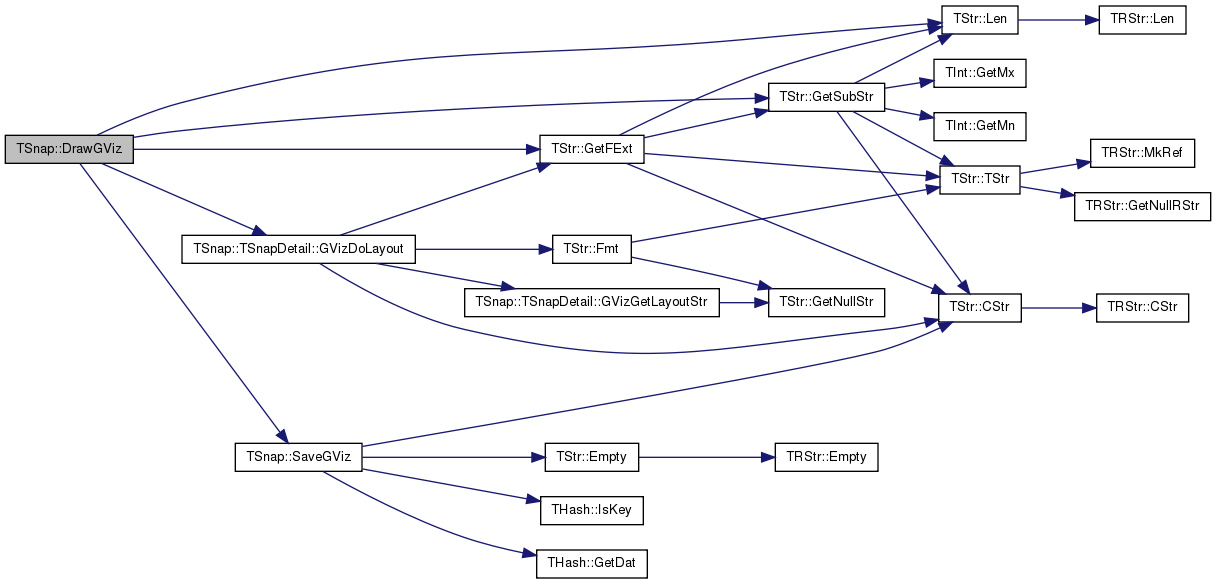

| void TSnap::DrawGViz | ( | const PGraph & | Graph, |
| const TGVizLayout & | Layout, | ||
| const TStr & | PltFNm, | ||
| const TStr & | Desc, | ||
| const TIntStrH & | NIdColorH | ||
| ) |
Draws a given Graph using a selected GraphViz Layout engine. Useful for drawing small (<100 node) graphs.
| PltFNm | Output filename (extension .ps, .png, .gif) determines the output format. |
| NIdColorH | Maps node ids to node colors (see GraphViz documentation for more details). |
Definition at line 36 of file gviz.h.
References TStr::GetFExt(), TStr::GetSubStr(), TSnap::TSnapDetail::GVizDoLayout(), TStr::Len(), and SaveGViz().
{
const TStr Ext = PltFNm.GetFExt();
const TStr GraphFNm = PltFNm.GetSubStr(0, PltFNm.Len()-Ext.Len()) + "dot";
SaveGViz(Graph, GraphFNm, Desc, NodeLabelH);
TSnap::TSnapDetail::GVizDoLayout(GraphFNm, PltFNm, Layout);
}
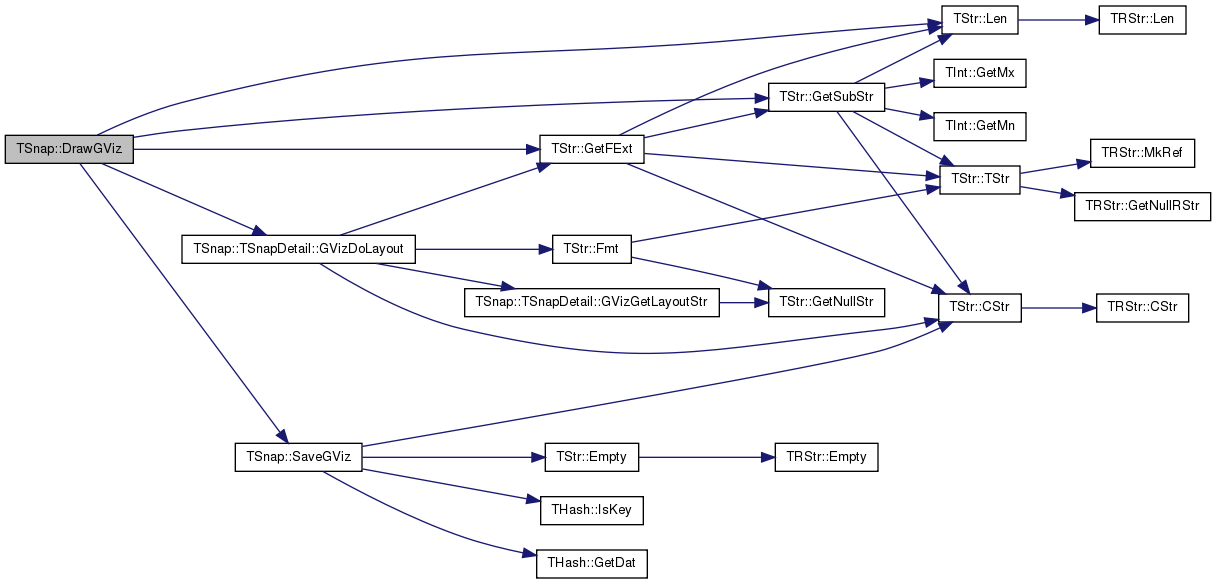
| PGraph TSnap::GenBaraHierar | ( | const int & | Levels, |
| const bool & | IsDir | ||
| ) |
Generates a Ravasz-Barabasi deterministic scale-free graph.
Corners of the graph are recursively expanded with miniature copies of the base graph (below). The graph has power-law degree distribution with the exponent 1+ln(5)/ln(4) and clustering coefficient with power-law decay exponent -1. Base graph:
* o---o * |\ /| * | o | * |/ \| * o---o *
See: Hierarchical organization in complex networks. Ravasz and Barabasi. URL: http://arxiv.org/abs/cond-mat/0206130
Definition at line 170 of file ggen.h.
References TMath::Power(), and TMath::Round().
{
const int Nodes = (int) TMath::Round(TMath::Power(5, Levels));
PGraph GraphPt = PGraph::New();
typename PGraph::TObj& Graph = *GraphPt;
Graph.Reserve(Nodes, -1);
// base graph
for (int i = 0; i < 5; i++) { Graph.AddNode(i); }
Graph.AddEdge(1,2); Graph.AddEdge(2,3);
Graph.AddEdge(3,4); Graph.AddEdge(4,1);
Graph.AddEdge(1,0); Graph.AddEdge(3,0);
Graph.AddEdge(2,0); Graph.AddEdge(4,0);
// expansion
const int CenterId = 0;
for (int lev = 1; lev < Levels+1; lev++) {
const int MxNId = Graph.GetNodes();
// make 4 duplicate copies
for (int d = 0; d < 4; d++) {
for (int n = 0; n < MxNId; n++) { Graph.AddNode(); }
for (int n = 0; n < MxNId; n++) {
typename PGraph::TObj::TNodeI NI = Graph.GetNI(n);
const int SrcId = n+MxNId*(d+1);
for (int e = 0; e < NI.GetOutDeg(); e++) {
Graph.AddEdge(SrcId, NI.GetOutNId(e)+MxNId*(d+1));
}
}
}
// add edges to the center
//const int LevPow = (int)TMath::Round(TMath::Power(5,lev-1));
for (int n = MxNId; n < Graph.GetNodes(); n++) {
typename PGraph::TObj::TNodeI NI = Graph.GetNI(n);
const int SrcId = n;
int Pow = 1; bool Skip = false;
for (int p = 1; p <= lev; p++) {
if (SrcId % (5*Pow) < Pow) { Skip=true; break; }
Pow *= 5;
}
if (Skip) { continue; }
Graph.AddEdge(SrcId, CenterId);
}
}
return GraphPt;
}

| PGraph TSnap::GenCircle | ( | const int & | Nodes, |
| const int & | NodeOutDeg = 1, |
||
| const bool & | IsDir = true |
||
| ) |
Generates a circle graph where every node creates out-links to NodeOutDeg forward nodes.
Definition at line 100 of file ggen.h.
References gfDirected.
{
PGraph Graph = PGraph::TObj::New();
Graph->Reserve(Nodes, Nodes*NodeOutDeg);
for (int n = 0; n < Nodes; n++) {
Graph->AddNode(n); }
for (int n = 0; n < Nodes; n++) {
for (int x = 0; x < NodeOutDeg; x++) {
Graph->AddEdge(n, (n+x+1) % Nodes);
if (Graph->HasFlag(gfDirected) && ! IsDir) { Graph->AddEdge((n+x) % Nodes, n); }
}
}
return Graph;
}
| PUNGraph TSnap::GenConfModel | ( | const TIntV & | DegSeqV, |
| TRnd & | Rnd | ||
| ) |
Generates a random undirect graph with a given degree sequence.
Generates a random undirect graph with a given degree sequence DegSeqV. Configuration model operates as follows. For each node N, of degree DeqSeqV[N] we create DeqSeqV[N] spokes (half-edges). We then pick two spokes at random, and connect the spokes endpoints. We continue this process until no spokes are left. Generally this generates a multigraph (i.e., spokes out of same nodes can be chosen multiple times).We ignore (discard) self-loops and multiple edges. Thus, the generated graph will only approximate follow the given degree sequence. The method is very fast!
Definition at line 119 of file ggen.cpp.
References TUNGraph::AddEdge(), THashSet< TKey, THashFunc >::AddKey(), TUNGraph::AddNode(), TRnd::GetUniDevInt(), THashSet< TKey, THashFunc >::IsKey(), TVec< TVal >::Len(), TMath::Mn(), TUNGraph::New(), TUNGraph::Reserve(), and Swap().
Referenced by GenRndPowerLaw(), and TTimeNet::PlotEffDiam().
{
const int Nodes = DegSeqV.Len();
PUNGraph GraphPt = TUNGraph::New();
TUNGraph& Graph = *GraphPt;
Graph.Reserve(Nodes, -1);
TIntV NIdDegV(DegSeqV.Len(), 0);
int DegSum=0, edges=0;
for (int node = 0; node < Nodes; node++) {
Graph.AddNode(node);
for (int d = 0; d < DegSeqV[node]; d++) { NIdDegV.Add(node); }
DegSum += DegSeqV[node];
}
NIdDegV.Shuffle(Rnd);
TIntPrSet EdgeH(DegSum/2); // set of all edges, is faster than graph edge lookup
if (DegSum % 2 != 0) {
printf("Seg seq is odd [%d]: ", DegSeqV.Len());
for (int d = 0; d < TMath::Mn(100, DegSeqV.Len()); d++) { printf(" %d", (int)DegSeqV[d]); }
printf("\n");
}
int u=0, v=0;
for (int c = 0; NIdDegV.Len() > 1; c++) {
u = Rnd.GetUniDevInt(NIdDegV.Len());
while ((v = Rnd.GetUniDevInt(NIdDegV.Len())) == u) { }
if (u > v) { Swap(u, v); }
const int E1 = NIdDegV[u];
const int E2 = NIdDegV[v];
if (v == NIdDegV.Len()-1) { NIdDegV.DelLast(); }
else { NIdDegV[v] = NIdDegV.Last(); NIdDegV.DelLast(); }
if (u == NIdDegV.Len()-1) { NIdDegV.DelLast(); }
else { NIdDegV[u] = NIdDegV.Last(); NIdDegV.DelLast(); }
if (E1 == E2 || EdgeH.IsKey(TIntPr(E1, E2))) { continue; }
EdgeH.AddKey(TIntPr(E1, E2));
Graph.AddEdge(E1, E2);
edges++;
if (c % (DegSum/100+1) == 0) { printf("\r configuration model: iter %d: edges: %d, left: %d", c, edges, NIdDegV.Len()/2); }
}
printf("\n");
return GraphPt;
}
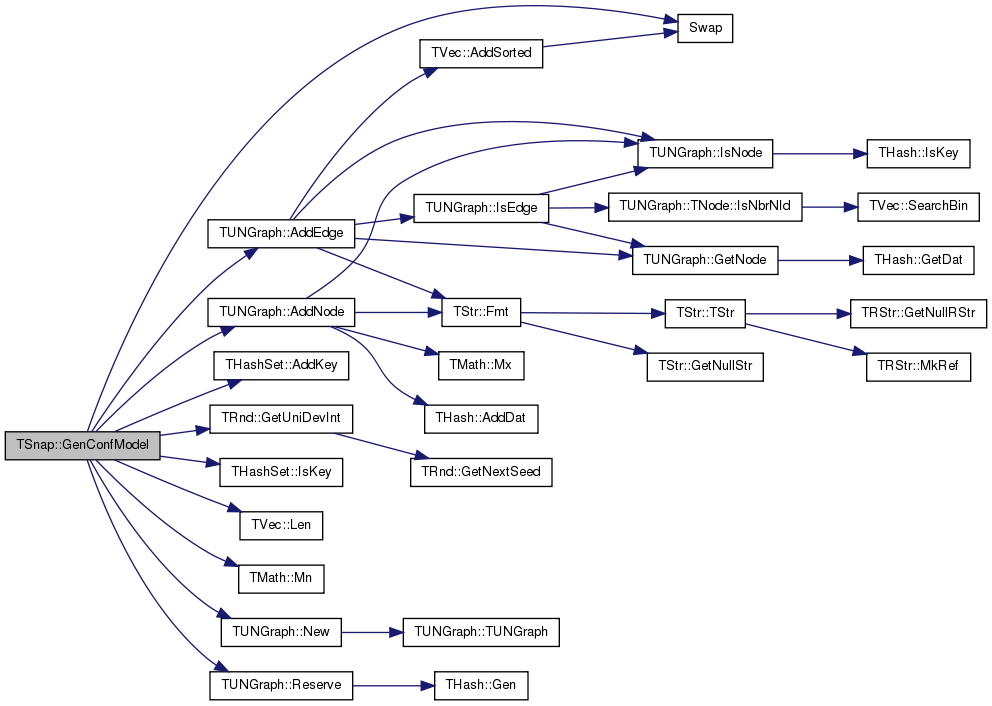

| PNGraph TSnap::GenCopyModel | ( | const int & | Nodes, |
| const double & | Beta, | ||
| TRnd & | Rnd | ||
| ) |
Generates a random scale-free network using the Copying Model.
Generates a random scale-free network using the Copying Model. The generating process operates as follows: Node u is added to a graph, it selects a random node v, and with prob Beta it links to v, with 1-Beta links u links to neighbor of v. The power-law degree exponent is -1/(1-Beta). See: Stochastic models for the web graph. Kumar, Raghavan, Rajagopalan, Sivakumar, Tomkins, Upfal. URL: http://snap.stanford.edu/class/cs224w-readings/kumar00stochastic.pdf
Definition at line 447 of file ggen.cpp.
References TNGraph::AddEdge(), TNGraph::AddNode(), TNGraph::GetNI(), TNGraph::TNodeI::GetOutDeg(), TNGraph::TNodeI::GetOutNId(), TNGraph::GetRndNId(), TRnd::GetUniDev(), TRnd::GetUniDevInt(), TNGraph::New(), and TNGraph::Reserve().
{
PNGraph GraphPt = TNGraph::New();
TNGraph& Graph = *GraphPt;
Graph.Reserve(Nodes, Nodes);
const int startNId = Graph.AddNode();
Graph.AddEdge(startNId, startNId);
for (int n = 1; n < Nodes; n++) {
const int rnd = Graph.GetRndNId();
const int NId = Graph.AddNode();
if (Rnd.GetUniDev() < Beta) {
Graph.AddEdge(NId, rnd); }
else {
const TNGraph::TNodeI NI = Graph.GetNI(rnd);
const int rnd2 = Rnd.GetUniDevInt(NI.GetOutDeg());
Graph.AddEdge(NId, NI.GetOutNId(rnd2));
}
}
return GraphPt;
}
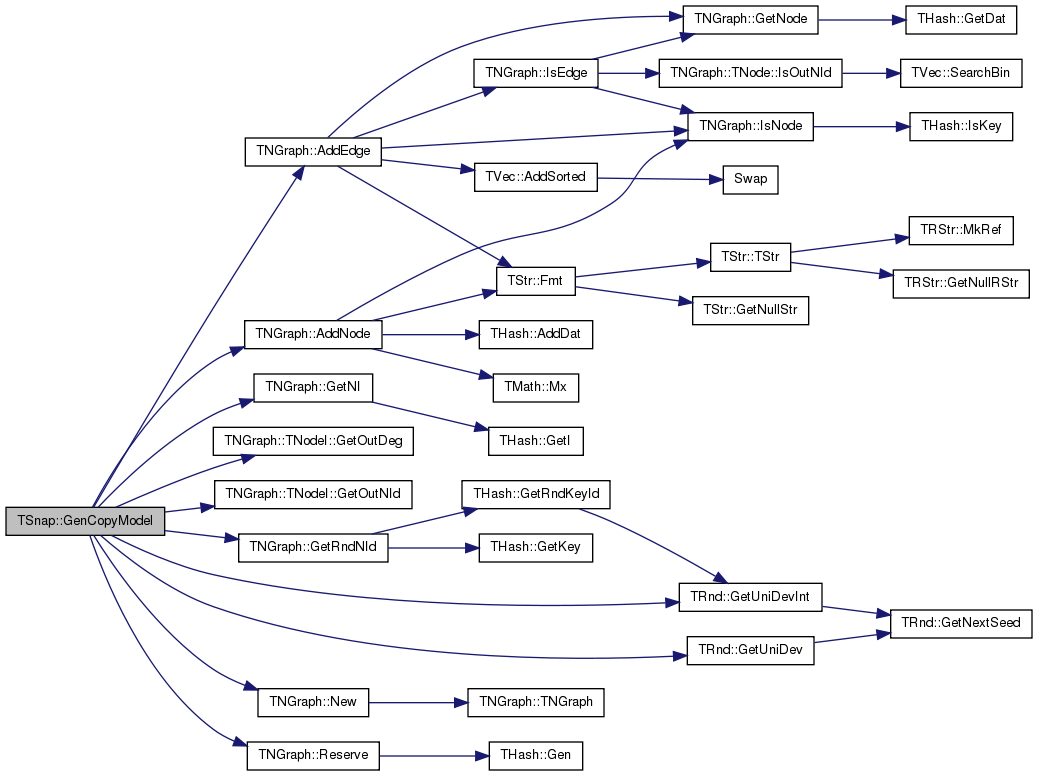
| PUNGraph TSnap::GenDegSeq | ( | const TIntV & | DegSeqV, |
| TRnd & | Rnd | ||
| ) |
Generates a random graph with exact degree sequence.
Generates a random graph with exact degree sequence DegSeqV. The generated graph has no self loops. The graph generation process simulates the Configuration Model but if a duplicate edge occurs, we find a random edge, break it and reconnect it with the duplicate.
Definition at line 58 of file ggen.cpp.
References TUNGraph::AddEdge(), TUNGraph::AddNode(), TUNGraph::DelEdge(), TSnap::TSnapDetail::GetRndEdgeNonAdjNode(), IAssert, IAssertR, TUNGraph::IsEdge(), TVec< TVal >::IsSorted(), TVec< TVal >::Len(), TUNGraph::New(), TUNGraph::Reserve(), TInt::Rnd, TPair< TVal1, TVal2 >::Val1, and TPair< TVal1, TVal2 >::Val2.
Referenced by GenRndDegK(), and GenRndPowerLaw().
{
const int Nodes = DegSeqV.Len();
PUNGraph GraphPt = TUNGraph::New();
TUNGraph& Graph = *GraphPt;
Graph.Reserve(Nodes, -1);
TIntH DegH(DegSeqV.Len(), true);
IAssertR(DegSeqV.IsSorted(false), "DegSeqV must be sorted in descending order.");
int DegSum=0, edge=0;
for (int node = 0; node < Nodes; node++) {
IAssert(Graph.AddNode(node) == node);
DegH.AddDat(node, DegSeqV[node]);
DegSum += DegSeqV[node];
}
IAssert(DegSum % 2 == 0);
while (! DegH.Empty()) {
// pick random nodes and connect
const int NId1 = DegH.GetKey(DegH.GetRndKeyId(TInt::Rnd, 0.5));
const int NId2 = DegH.GetKey(DegH.GetRndKeyId(TInt::Rnd, 0.5));
IAssert(DegH.IsKey(NId1) && DegH.IsKey(NId2));
if (NId1 == NId2) {
if (DegH.GetDat(NId1) == 1) { continue; }
// find rnd edge, break it, and connect the endpoints to the nodes
const TIntPr Edge = TSnapDetail::GetRndEdgeNonAdjNode(GraphPt, NId1, -1);
if (Edge.Val1==-1) { continue; }
Graph.DelEdge(Edge.Val1, Edge.Val2);
Graph.AddEdge(Edge.Val1, NId1);
Graph.AddEdge(NId1, Edge.Val2);
if (DegH.GetDat(NId1) == 2) { DegH.DelKey(NId1); }
else { DegH.GetDat(NId1) -= 2; }
} else {
if (! Graph.IsEdge(NId1, NId2)) {
Graph.AddEdge(NId1, NId2); } // good edge
else {
// find rnd edge, break and cross-connect
const TIntPr Edge = TSnapDetail::GetRndEdgeNonAdjNode(GraphPt, NId1, NId2);
if (Edge.Val1==-1) {continue; }
Graph.DelEdge(Edge.Val1, Edge.Val2);
Graph.AddEdge(NId1, Edge.Val1);
Graph.AddEdge(NId2, Edge.Val2);
}
if (DegH.GetDat(NId1)==1) { DegH.DelKey(NId1); }
else { DegH.GetDat(NId1) -= 1; }
if (DegH.GetDat(NId2)==1) { DegH.DelKey(NId2); }
else { DegH.GetDat(NId2) -= 1; }
}
if (++edge % 1000 == 0) {
printf("\r %dk / %dk", edge/1000, DegSum/2000); }
}
return GraphPt;
}
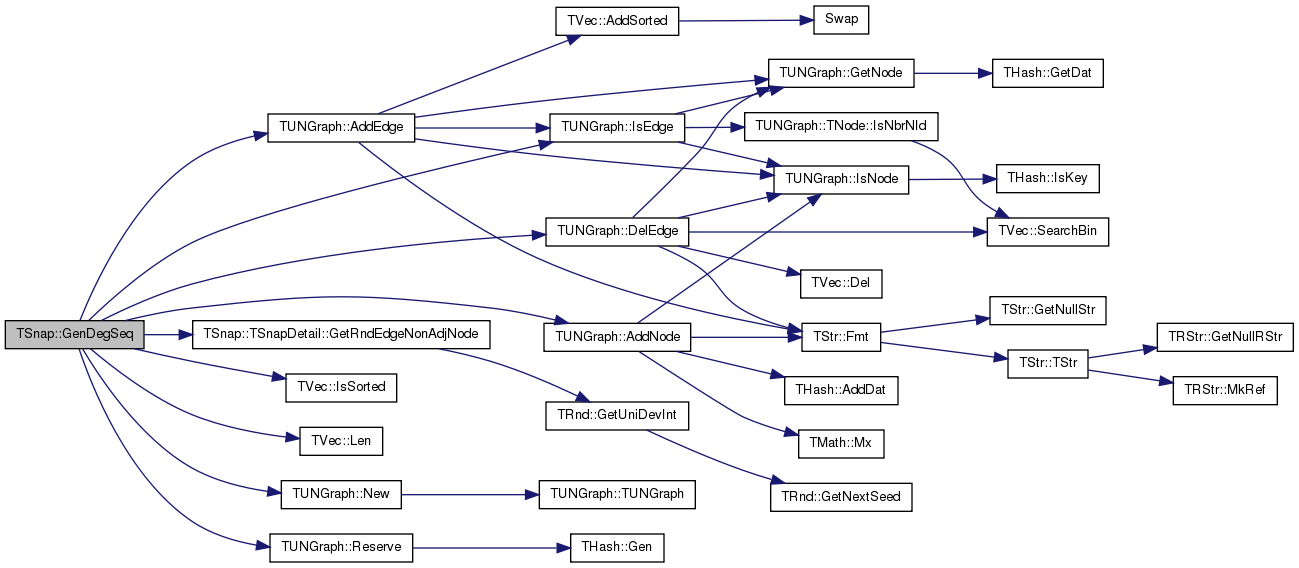

| PNGraph TSnap::GenForestFire | ( | const int & | Nodes, |
| const double & | FwdProb, | ||
| const double & | BckProb | ||
| ) |
Generates a random Forest Fire, directed graph with given probabilities.
Definition at line 436 of file ggen.cpp.
References TForestFire::GenGraph().
{
return TForestFire::GenGraph(Nodes, FwdProb, BckProb);
}
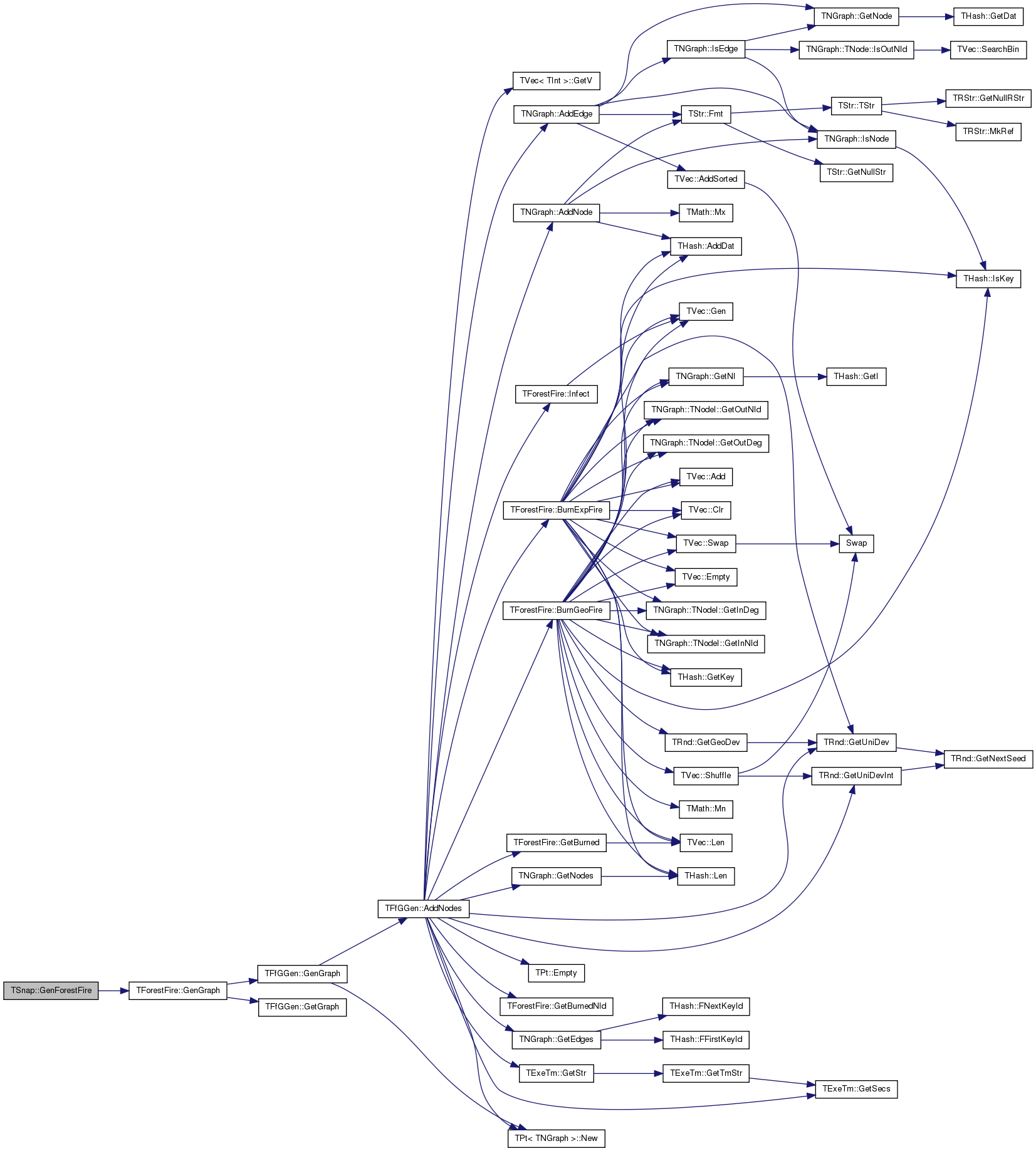
| PGraph TSnap::GenFull | ( | const int & | Nodes | ) |
Generates a complete graph on Nodes nodes. Graph has no self-loops.
Definition at line 115 of file ggen.h.
{
PGraph Graph = PGraph::TObj::New();
Graph->Reserve(Nodes, Nodes*Nodes);
for (int n = 0; n < Nodes; n++) {
Graph->AddNode(n); }
for (int n1 = 0; n1 < Nodes; n1++) {
for (int n2 = 0; n2 < Nodes; n2++) {
if (n1 != n2) { Graph->AddEdge(n1, n2); }
}
}
return Graph;
}
| PUNGraph TSnap::GenGeoPrefAttach | ( | const int & | Nodes, |
| const int & | OutDeg, | ||
| const double & | Beta, | ||
| TRnd & | Rnd | ||
| ) |
Generates a random scale-free graph using the Geometric Preferential model.
Generates a random scale-free graph using the Geometric Preferential Attachment model by Flexman, Frieze and Vera. See: A geometric preferential attachment model of networks by Flexman, Frieze and Vera. WAW 2004. URL: http://math.cmu.edu/~af1p/Texfiles/GeoWeb.pdf
Definition at line 355 of file ggen.cpp.
References TVec< TVal >::Add(), TVec< TVal >::Clr(), TVec< TVal >::Del(), TSnap::TSnapDetail::GetSphereDev(), TRnd::GetUniDevInt(), TVec< TVal >::Last(), TVec< TVal >::Len(), TUNGraph::New(), TMath::Pi, TMath::Sqr(), TTriple< TVal1, TVal2, TVal3 >::Val1, TTriple< TVal1, TVal2, TVal3 >::Val2, and TTriple< TVal1, TVal2, TVal3 >::Val3.
{
PUNGraph G = TUNGraph::New(Nodes, Nodes*OutDeg);
TFltTrV PointV(Nodes, 0);
TFltV ValV;
// points on a sphere of radius 1/(2*pi)
const double Rad = 0.5 * TMath::Pi;
for (int i = 0; i < Nodes; i++) {
TSnapDetail::GetSphereDev(3, Rnd, ValV);
PointV.Add(TFltTr(Rad*ValV[0], Rad*ValV[1], Rad*ValV[2]));
}
const double R2 = TMath::Sqr(log((double) Nodes) / (pow((double) Nodes, 0.5-Beta)));
TIntV DegV, NIdV;
int SumDeg;
for (int t = 0; t < Nodes; t++) {
const int pid = t;
const TFltTr& P1 = PointV[pid];
// add node
if (! G->IsNode(pid)) { G->AddNode(pid); }
// find neighborhood
DegV.Clr(false); NIdV.Clr(false); SumDeg=0;
for (int p = 0; p < t; p++) {
const TFltTr& P2 = PointV[p];
if (TMath::Sqr(P1.Val1-P2.Val1)+TMath::Sqr(P1.Val2-P2.Val2)+TMath::Sqr(P1.Val3-P2.Val3) < R2) {
NIdV.Add(p);
DegV.Add(G->GetNI(p).GetDeg()+1);
SumDeg += DegV.Last();
}
}
// add edges
for (int m = 0; m < OutDeg; m++) {
const int rnd = Rnd.GetUniDevInt(SumDeg);
int sum = 0, dst = -1;
for (int s = 0; s < DegV.Len(); s++) {
sum += DegV[s];
if (rnd < sum) { dst=s; break; }
}
if (dst != -1) {
G->AddEdge(pid, NIdV[dst]);
SumDeg -= DegV[dst];
NIdV.Del(dst); DegV.Del(dst);
}
}
}
return G;
}
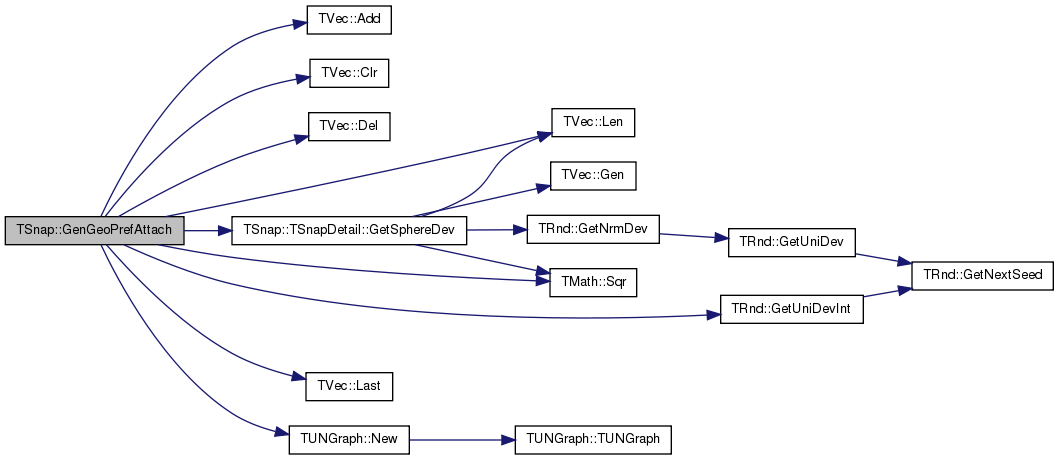
| PGraph TSnap::GenGrid | ( | const int & | Rows, |
| const int & | Cols, | ||
| const bool & | IsDir = true |
||
| ) |
Generates a 2D-grid graph of Rows rows and Cols columns.
Definition at line 61 of file ggen.h.
References gfDirected.
{
PGraph GraphPt = PGraph::New();
typename PGraph::TObj& Graph = *GraphPt;
Graph.Reserve(Rows*Cols, 4*Rows*Cols);
int node, r, c;
for (node = 0; node < Rows * Cols; node++) {
Graph.AddNode(node); }
for (r = 0; r < Rows; r++) {
for (c = 0; c < Cols; c++) {
const int nodeId = Cols*r + c;
if (r < Rows-1) { // bottom node
Graph.AddEdge(nodeId, nodeId+Cols);
if (Graph.HasFlag(gfDirected) && ! IsDir) {
Graph.AddEdge(nodeId+Cols-1, nodeId); }
}
if (c < Cols-1) { // right node
Graph.AddEdge(nodeId, nodeId+1);
if (Graph.HasFlag(gfDirected) && ! IsDir) {
Graph.AddEdge(nodeId+1, nodeId); }
}
}
}
return GraphPt;
}
| PUNGraph TSnap::GenPrefAttach | ( | const int & | Nodes, |
| const int & | NodeOutDeg, | ||
| TRnd & | Rnd | ||
| ) |
Generates a power-law degree distribution using Barabasi-Albert model of scale-free graphs.
Barabasi-Albert model of scale-free graphs. The graph has power-law degree distribution. See: Emergence of scaling in random networks by Barabasi and Albert. URL: http://arxiv.org/abs/cond-mat/9910332
Definition at line 310 of file ggen.cpp.
References TVec< TVal >::Add(), TUNGraph::AddEdge(), THashSet< TKey, THashFunc >::AddKey(), TUNGraph::AddNode(), THashSet< TKey, THashFunc >::Clr(), TVec< TVal >::Len(), THashSet< TKey, THashFunc >::Len(), TPt< TUNGraph >::New(), TUNGraph::Reserve(), and TInt::Rnd.
{
PUNGraph GraphPt = PUNGraph::New();
TUNGraph& Graph = *GraphPt;
Graph.Reserve(Nodes, NodeOutDeg*Nodes);
TIntV NIdV(NodeOutDeg*Nodes, 0);
// first edge
Graph.AddNode(0); Graph.AddNode(1);
NIdV.Add(0); NIdV.Add(1);
Graph.AddEdge(0, 1);
TIntSet NodeSet;
for (int node = 2; node < Nodes; node++) {
NodeSet.Clr(false);
while (NodeSet.Len() < NodeOutDeg && NodeSet.Len() < node) {
NodeSet.AddKey(NIdV[TInt::Rnd.GetUniDevInt(NIdV.Len())]);
}
const int N = Graph.AddNode();
for (int i = 0; i < NodeSet.Len(); i++) {
Graph.AddEdge(N, NodeSet[i]);
NIdV.Add(N);
NIdV.Add(NodeSet[i]);
}
}
return GraphPt;
}
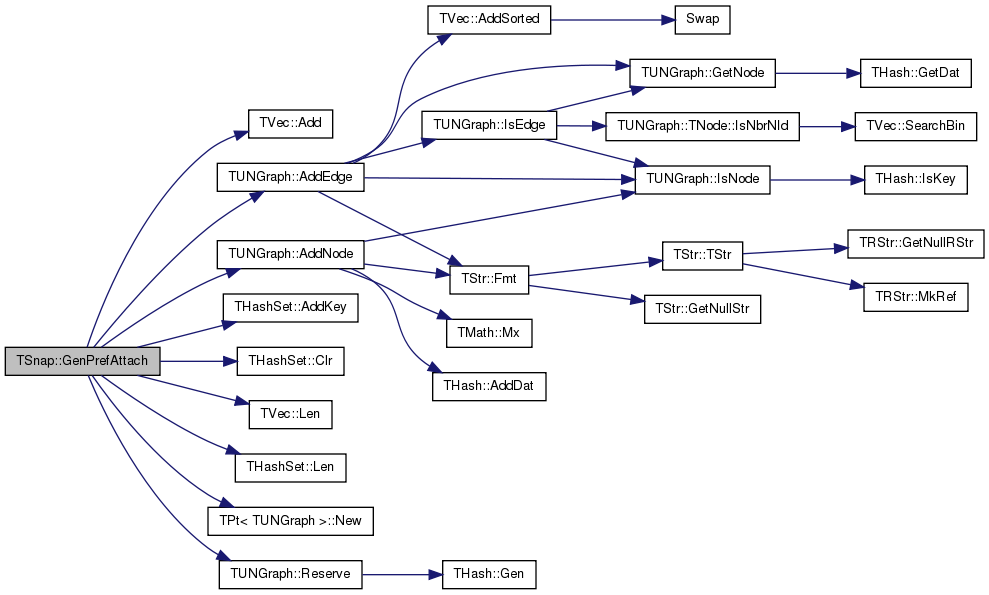
| PBPGraph TSnap::GenRewire | ( | const PUNGraph & | OrigGraph, |
| const int & | NSwitch, | ||
| TRnd & | Rnd | ||
| ) |
Rewire a random undirected graph. Keeps node degrees the same, but randomly rewires the edges.
Rewire a random bipartite graph. Keeps node degrees the same, but randomly rewires the edges.
Rewire a random directed graph. Keeps node degrees the same, but randomly rewires the edges.
Rewire the network. Keeps node degrees as is but randomly rewires the edges. Use this function to generate a random graph with the same degree sequence as the OrigGraph. See: On the uniform generation of random graphs with prescribed degree sequences by R. Milo, N. Kashtan, S. Itzkovitz, M. E. J. Newman, U. Alon URL: http://arxiv.org/abs/cond-mat/0312028
Rewire the network. Keeps node degrees as is but randomly rewires the edges. Use this function to generate a random graph with the same degree sequence as the OrigGraph. See: On the uniform generation of random graphs with prescribed degree sequences by R. Milo, N. Kashtan, S. Itzkovitz, M. E. J. Newman, U. Alon. URL: http://arxiv.org/abs/cond-mat/0312028
Rewire a bipartite graph. Keeps node degrees as is but randomly rewires the edges. Use this function to generate a random graph with the same degree sequence as the OrigGraph. See: On the uniform generation of random graphs with prescribed degree sequences by R. Milo, N. Kashtan, S. Itzkovitz, M. E. J. Newman, U. Alon URL: http://arxiv.org/abs/cond-mat/0312028
Definition at line 165 of file ggen.cpp.
References TUNGraph::AddEdge(), THashSet< TKey, THashFunc >::AddKey(), TUNGraph::AddNode(), THashSet< TKey, THashFunc >::DelKeyId(), THashSet< TKey, THashFunc >::GetRndKeyId(), TExeTm::GetSecs(), TExeTm::GetStr(), THashSet< TKey, THashFunc >::IsKey(), THashSet< TKey, THashFunc >::Len(), TUNGraph::New(), TUNGraph::Reserve(), Swap(), TPair< TVal1, TVal2 >::Val1, and TPair< TVal1, TVal2 >::Val2.
Referenced by GenRndDegK(), GenRndPowerLaw(), and TLocClust::PlotNCP().
{
const int Nodes = OrigGraph->GetNodes();
const int Edges = OrigGraph->GetEdges();
PUNGraph GraphPt = TUNGraph::New();
TUNGraph& Graph = *GraphPt;
Graph.Reserve(Nodes, -1);
TExeTm ExeTm;
// generate a graph that satisfies the constraints
printf("Randomizing edges (%d, %d)...\n", Nodes, Edges);
TIntPrSet EdgeSet(Edges);
for (TUNGraph::TNodeI NI = OrigGraph->BegNI(); NI < OrigGraph->EndNI(); NI++) {
const int NId = NI.GetId();
for (int e = 0; e < NI.GetOutDeg(); e++) {
if (NId <= NI.GetOutNId(e)) { continue; }
EdgeSet.AddKey(TIntPr(NId, NI.GetOutNId(e)));
}
Graph.AddNode(NI.GetId());
}
// edge switching
uint skip=0;
for (uint swps = 0; swps < 2*uint(Edges)*uint(NSwitch); swps++) {
const int keyId1 = EdgeSet.GetRndKeyId(Rnd);
const int keyId2 = EdgeSet.GetRndKeyId(Rnd);
if (keyId1 == keyId2) { skip++; continue; }
const TIntPr& E1 = EdgeSet[keyId1];
const TIntPr& E2 = EdgeSet[keyId2];
TIntPr NewE1(E1.Val1, E2.Val1), NewE2(E1.Val2, E2.Val2);
if (NewE1.Val1 > NewE1.Val2) { Swap(NewE1.Val1, NewE1.Val2); }
if (NewE2.Val1 > NewE2.Val2) { Swap(NewE2.Val1, NewE2.Val2); }
if (NewE1!=NewE2 && NewE1.Val1!=NewE1.Val2 && NewE2.Val1!=NewE2.Val2 && ! EdgeSet.IsKey(NewE1) && ! EdgeSet.IsKey(NewE2)) {
EdgeSet.DelKeyId(keyId1); EdgeSet.DelKeyId(keyId2);
EdgeSet.AddKey(TIntPr(NewE1));
EdgeSet.AddKey(TIntPr(NewE2));
} else { skip++; }
if (swps % Edges == 0) {
printf("\r %uk/%uk: %uk skip [%s]", swps/1000u, 2*uint(Edges)*uint(NSwitch)/1000u, skip/1000u, ExeTm.GetStr());
if (ExeTm.GetSecs() > 2*3600) { printf(" *** Time limit!\n"); break; } // time limit 2 hours
}
}
printf("\r total %uk switchings attempted, %uk skiped [%s]\n", 2*uint(Edges)*uint(NSwitch)/1000u, skip/1000u, ExeTm.GetStr());
for (int e = 0; e < EdgeSet.Len(); e++) {
Graph.AddEdge(EdgeSet[e].Val1, EdgeSet[e].Val2); }
return GraphPt;
}
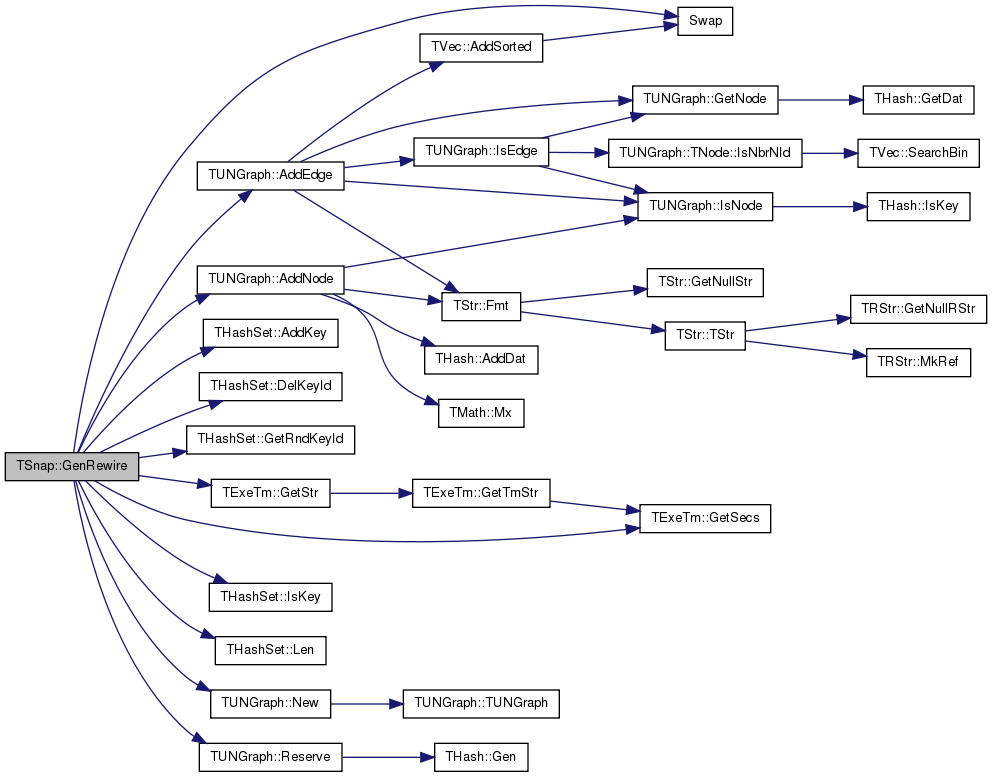
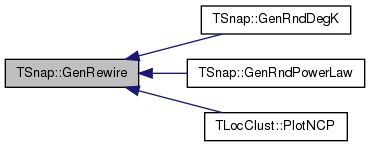
| PNGraph TSnap::GenRMat | ( | const int & | Nodes, |
| const int & | Edges, | ||
| const double & | A, | ||
| const double & | B, | ||
| const double & | C, | ||
| TRnd & | Rnd | ||
| ) |
Generates a R-MAT graph using recursive descent into a 2x2 matrix [A,B; C, 1-(A+B+C)].
R-MAT Generator. The modes is based on the recursive descent into a 2x2 matrix [A,B; C, 1-(A+B+C)]. See: R-MAT Generator: A Recursive Model for Graph Mining. D. Chakrabarti, Y. Zhan and C. Faloutsos, in SIAM Data Mining 2004. URL: http://www.cs.cmu.edu/~deepay/mywww/papers/siam04.pdf
Definition at line 472 of file ggen.cpp.
References TVec< TVal >::Add(), TNGraph::AddEdge(), TNGraph::AddNode(), TNGraph::Defrag(), Fail, TRnd::GetUniDev(), IAssert, TNGraph::IsEdge(), TNGraph::New(), and TNGraph::Reserve().
Referenced by GenRMatEpinions().
{
PNGraph GraphPt = TNGraph::New();
TNGraph& Graph = *GraphPt;
Graph.Reserve(Nodes, Edges);
IAssert(A+B+C < 1.0);
int rngX, rngY, offX, offY;
int Depth=0, Collisions=0, Cnt=0, PctDone=0;
const int EdgeGap = Edges / 100 + 1;
// sum of parameters (probabilities)
TVec<double> sumA(128, 0), sumAB(128, 0), sumAC(128, 0), sumABC(128, 0); // up to 2^128 vertices ~ 3.4e38
for (int i = 0; i < 128; i++) {
const double a = A * (Rnd.GetUniDev() + 0.5);
const double b = B * (Rnd.GetUniDev() + 0.5);
const double c = C * (Rnd.GetUniDev() + 0.5);
const double d = (1.0 - (A+B+C)) * (Rnd.GetUniDev() + 0.5);
const double abcd = a+b+c+d;
sumA.Add(a / abcd);
sumAB.Add((a+b) / abcd);
sumAC.Add((a+c) / abcd);
sumABC.Add((a+b+c) / abcd);
}
// nodes
for (int node = 0; node < Nodes; node++) {
IAssert(Graph.AddNode(-1) == node);
}
// edges
for (int edge = 0; edge < Edges; ) {
rngX = Nodes; rngY = Nodes; offX = 0; offY = 0;
Depth = 0;
// recurse the matrix
while (rngX > 1 || rngY > 1) {
const double RndProb = Rnd.GetUniDev();
if (rngX>1 && rngY>1) {
if (RndProb < sumA[Depth]) { rngX/=2; rngY/=2; }
else if (RndProb < sumAB[Depth]) { offX+=rngX/2; rngX-=rngX/2; rngY/=2; }
else if (RndProb < sumABC[Depth]) { offY+=rngY/2; rngX/=2; rngY-=rngY/2; }
else { offX+=rngX/2; offY+=rngY/2; rngX-=rngX/2; rngY-=rngY/2; }
} else
if (rngX>1) { // row vector
if (RndProb < sumAC[Depth]) { rngX/=2; rngY/=2; }
else { offX+=rngX/2; rngX-=rngX/2; rngY/=2; }
} else
if (rngY>1) { // column vector
if (RndProb < sumAB[Depth]) { rngX/=2; rngY/=2; }
else { offY+=rngY/2; rngX/=2; rngY-=rngY/2; }
} else { Fail; }
Depth++;
}
// add edge
const int NId1 = offX;
const int NId2 = offY;
if (NId1 != NId2 && ! Graph.IsEdge(NId1, NId2)) {
Graph.AddEdge(NId1, NId2);
if (++Cnt > EdgeGap) {
Cnt=0; printf("\r %d%% edges", ++PctDone); }
edge++;
} else {
Collisions++; }
}
printf("\r RMat: nodes:%d, edges:%d, Iterations:%d, Collisions:%d (%.1f%%).\n", Nodes, Edges,
Edges+Collisions, Collisions, 100*Collisions/double(Edges+Collisions));
Graph.Defrag();
return GraphPt;
}
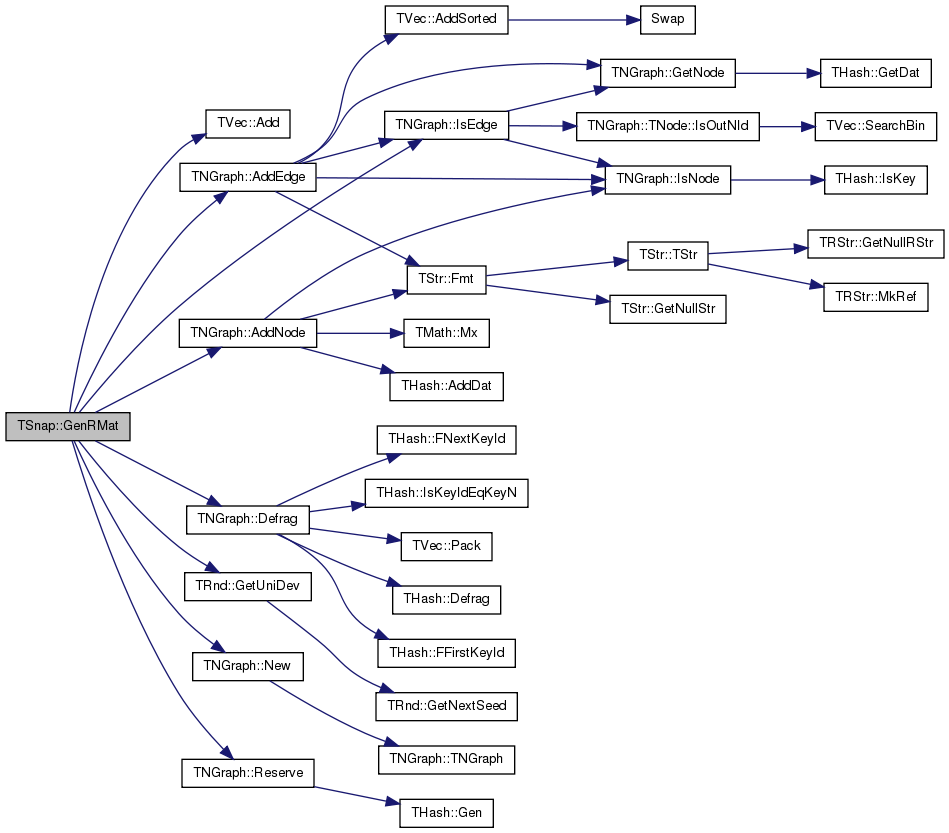

Generates a R-Mat graph, with a synthetic copy of the Epinions social network.
R-Mat generator with parameters set so that it generates a synthetic copy of the Epinions social network. The original Epinions social network can be downloaded at http://snap.stanford.edu/data/soc-Epinions1.html
Definition at line 541 of file ggen.cpp.
References GenRMat().
{
return GenRMat(75888, 508837, 0.550, 0.228, 0.212);
}
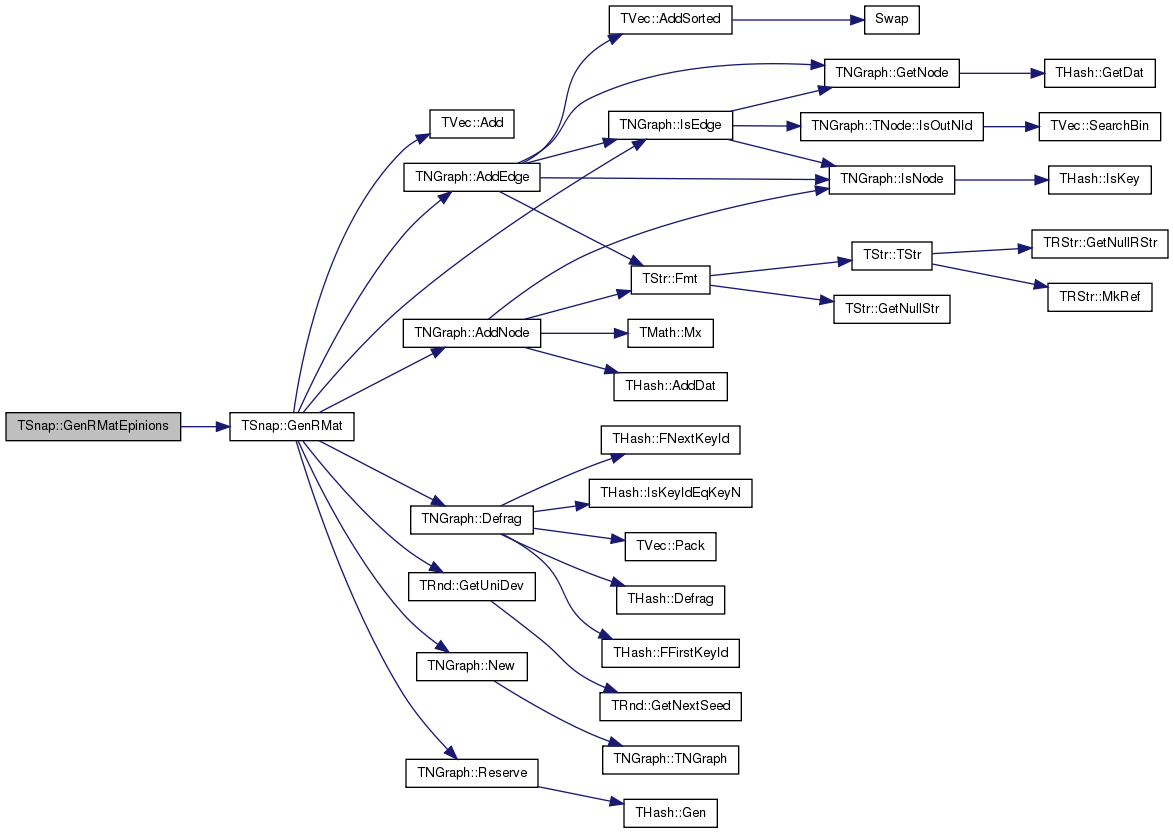
| PBPGraph TSnap::GenRndBipart | ( | const int & | LeftNodes, |
| const int & | RightNodes, | ||
| const int & | Edges, | ||
| TRnd & | Rnd | ||
| ) |
Generates a random bipartite graph.
Definition at line 5 of file ggen.cpp.
References TRnd::GetUniDevInt(), IAssertR, and TBPGraph::New().
{
PBPGraph G = TBPGraph::New();
for (int i = 0; i < LeftNodes; i++) { G->AddNode(i, true); }
for (int i = 0; i < RightNodes; i++) { G->AddNode(LeftNodes+i, false); }
IAssertR(Edges <= LeftNodes*RightNodes, "Too many edges in the bipartite graph!");
for (int edges = 0; edges < Edges; ) {
const int LNId = Rnd.GetUniDevInt(LeftNodes);
const int RNId = LeftNodes + Rnd.GetUniDevInt(RightNodes);
if (G->AddEdge(LNId, RNId) != -2) { edges++; } // is new edge
}
return G;
}

| PUNGraph TSnap::GenRndDegK | ( | const int & | Nodes, |
| const int & | NodeDeg, | ||
| const int & | NSwitch, | ||
| TRnd & | Rnd | ||
| ) |
Generates a random graph where each node has degree exactly NodeDeg.
Definition at line 18 of file ggen.cpp.
References TVec< TVal >::Add(), GenDegSeq(), GenRewire(), and IAssert.
{
// create degree sequence
TIntV DegV(Nodes, 0);
int DegSum=0;
for (int i = 0; i < Nodes; i++) {
DegV.Add(NodeDeg);
DegSum += NodeDeg;
}
IAssert(DegSum % 2 == 0);
PUNGraph G = GenDegSeq(DegV, Rnd); // get some graph that obeys the degree sequnce
return GenRewire(G, NSwitch, Rnd); // make it random
}
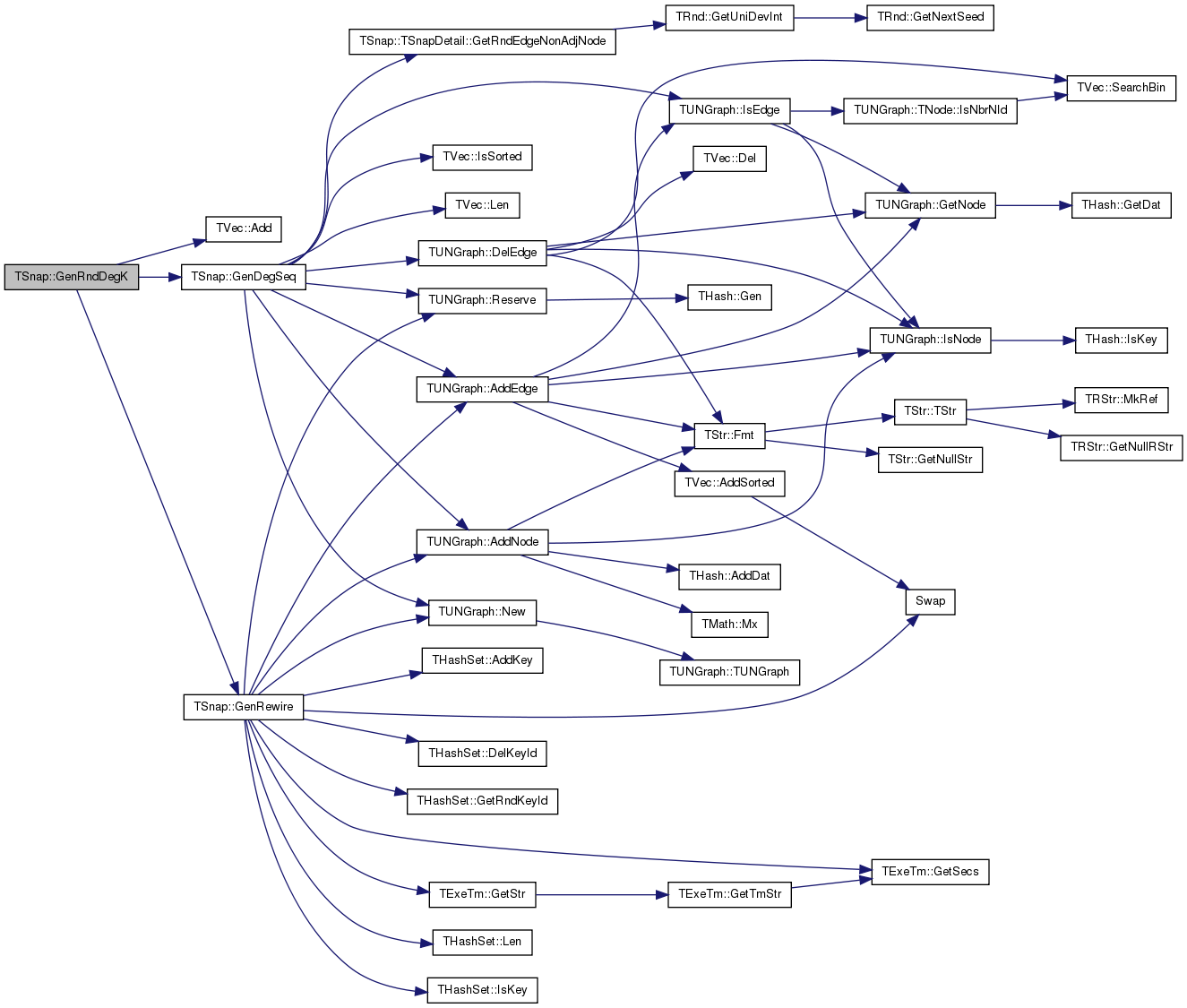
| PGraph TSnap::GenRndGnm | ( | const int & | Nodes, |
| const int & | Edges, | ||
| const bool & | IsDir = true, |
||
| TRnd & | Rnd = TInt::Rnd |
||
| ) |
Generates an Erdos-Renyi random graph.
Definition at line 214 of file ggen.h.
References TStr::Fmt(), TRnd::GetUniDevInt(), IAssert, and IAssertR.
{
PGraph GraphPt = PGraph::New();
typename PGraph::TObj& Graph = *GraphPt;
Graph.Reserve(Nodes, Edges);
IAssertR(Nodes * (Nodes-1) / 2 * (IsDir ? 2 : 1) >= Edges, TStr::Fmt("Not enough nodes (%d), for edges (%d).", Nodes, Edges));
for (int node = 0; node < Nodes; node++) {
IAssert(Graph.AddNode(node) == node);
}
for (int edge = 0; edge < Edges; ) {
const int SrcNId = Rnd.GetUniDevInt(Nodes);
const int DstNId = Rnd.GetUniDevInt(Nodes);
if (SrcNId != DstNId && Graph.AddEdge(SrcNId, DstNId) != -2) { // is new edge
if (! IsDir) { Graph.AddEdge(DstNId, SrcNId); }
edge++;
}
}
return GraphPt;
}

| PUNGraph TSnap::GenRndPowerLaw | ( | const int & | Nodes, |
| const double & | PowerExp, | ||
| const bool & | ConfModel, | ||
| TRnd & | Rnd | ||
| ) |
Generates a random scale-free graph with power-law degree distribution.
Generates a random scale-free graph with power-law degree distribution with exponent PowerExp. The method uses either the Configuration model (fast but the result is approximate) or the Edge Rewiring method (slow but exact).
Definition at line 34 of file ggen.cpp.
References TVec< TVal >::Add(), GenConfModel(), GenDegSeq(), GenRewire(), TRnd::GetPowerDev(), and TMath::Round().
{
TIntV DegSeqV;
uint DegSum=0;
for (int n = 0; n < Nodes; n++) {
const int Val = (int) TMath::Round(Rnd.GetPowerDev(PowerExp));
if (! (Val >= 1 && Val < Nodes/2)) { n--; continue; } // skip nodes with too large degree
DegSeqV.Add(Val);
DegSum += Val;
}
printf("%d nodes, %u edges\n", Nodes, DegSum);
if (DegSum % 2 == 1) { DegSeqV[0] += 1; }
if (ConfModel) {
// use configuration model -- fast but does not exactly obey the degree sequence
return GenConfModel(DegSeqV, Rnd);
} else {
PUNGraph G = TSnap::GenDegSeq(DegSeqV, Rnd);
return TSnap::GenRewire(G, 10, Rnd);
}
}
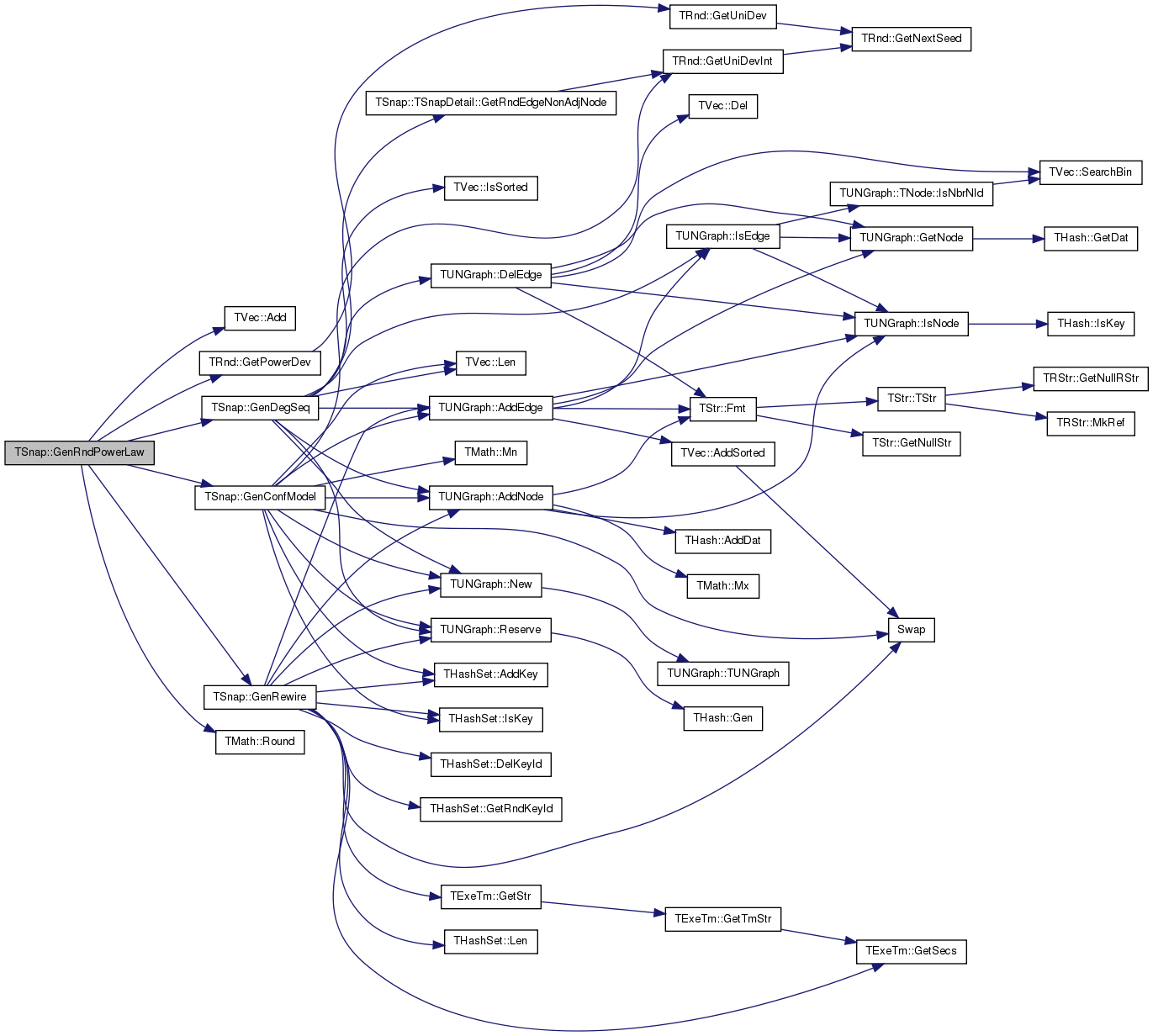
| PUNGraph TSnap::GenSmallWorld | ( | const int & | Nodes, |
| const int & | NodeOutDeg, | ||
| const double & | RewireProb, | ||
| TRnd & | Rnd | ||
| ) |
Generates a randomly small-world graph using the Watts-Strogatz model.
Generates a small-world graph using the Watts-Strogatz model. We assume a circle where each node creates links to NodeOutDeg other nodes. This way at the end each node is connected to 2*NodeOutDeg other nodes. See: Collective dynamics of 'small-world' networks. Watts and Strogatz. URL: http://research.yahoo.com/files/w_s_NATURE_0.pdf
Definition at line 406 of file ggen.cpp.
References TUNGraph::AddEdge(), THashSet< TKey, THashFunc >::AddKey(), TUNGraph::AddNode(), TUNGraph::Defrag(), TStr::Fmt(), TRnd::GetUniDev(), TRnd::GetUniDevInt(), IAssert, IAssertR, THashSet< TKey, THashFunc >::IsKey(), THashSet< TKey, THashFunc >::Len(), TUNGraph::New(), and TUNGraph::Reserve().
{
THashSet<TIntPr> EdgeSet(Nodes*NodeOutDeg);
IAssertR(Nodes > NodeOutDeg, TStr::Fmt("Insufficient nodes for out degree, %d!", NodeOutDeg));
for (int node = 0; node < Nodes; node++) {
const int src = node;
for (int edge = 1; edge <= NodeOutDeg; edge++) {
int dst = (node+edge) % Nodes; // edge to next neighbor
if (Rnd.GetUniDev() < RewireProb) { // random edge
dst = Rnd.GetUniDevInt(Nodes);
while (dst == src || EdgeSet.IsKey(TIntPr(src, dst))) {
dst = Rnd.GetUniDevInt(Nodes); }
}
EdgeSet.AddKey(TIntPr(src, dst));
}
}
PUNGraph GraphPt = TUNGraph::New();
TUNGraph& Graph = *GraphPt;
Graph.Reserve(Nodes, EdgeSet.Len());
int node;
for (node = 0; node < Nodes; node++) {
IAssert(Graph.AddNode(node) == node);
}
for (int edge = 0; edge < EdgeSet.Len(); edge++) {
Graph.AddEdge(EdgeSet[edge].Val1, EdgeSet[edge].Val2);
}
Graph.Defrag();
return GraphPt;
}
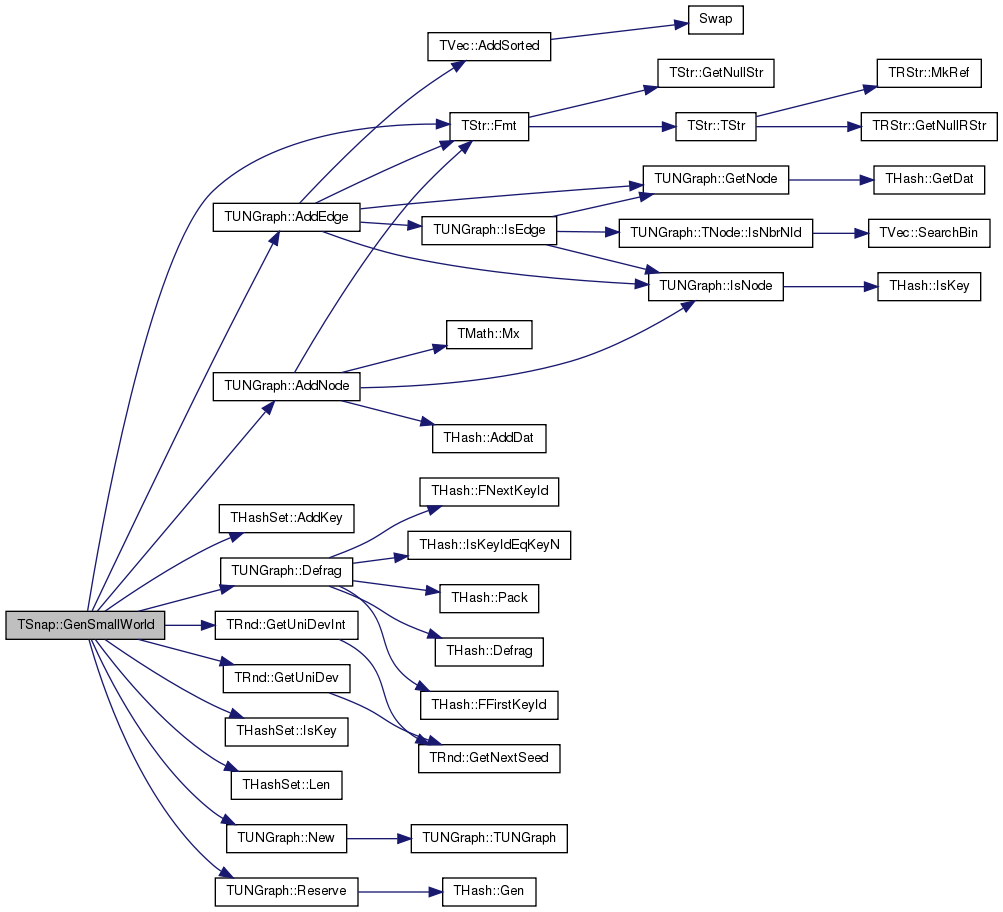
| PGraph TSnap::GenStar | ( | const int & | Nodes, |
| const bool & | IsDir = true |
||
| ) |
Generates a graph with star topology. Node id 0 is in the center and then links to all other nodes.
Definition at line 87 of file ggen.h.
References gfDirected.
{
PGraph Graph = PGraph::TObj::New();
Graph->Reserve(Nodes, Nodes);
Graph->AddNode(0);
for (int n = 1; n < Nodes; n++) {
Graph->AddNode(n);
Graph->AddEdge(0, n);
if (Graph->HasFlag(gfDirected) && ! IsDir) { Graph->AddEdge(n, 0); }
}
return Graph;
}
| PGraph TSnap::GenTree | ( | const int & | Fanout, |
| const int & | Levels, | ||
| const bool & | IsDir = true, |
||
| const bool & | ChildPointsToParent = true |
||
| ) |
Generates a tree graph of Levels levels with every parent having Fanout children.
Definition at line 129 of file ggen.h.
{
const int Nodes = (int) (pow(double(Fanout), double(Levels+1)) - 1) / (Fanout - 1);
const int Edges = Nodes - 1;
PGraph GraphPt = PGraph::New();
typename PGraph::TObj& Graph = *GraphPt;
Graph.Reserve(Nodes, Edges);
int node;
for (node = 0; node < Nodes; node++) {
Graph.AddNode(node); }
// non-leaf nodes
for (node = 0; node < (int) Nodes - (int) pow(double(Fanout), double(Levels)); node++) {
for (int edge = 1; edge <= Fanout; edge++) {
if (IsDir) {
if (ChildPointsToParent) { Graph.AddEdge(Fanout*node+edge, node); }
else { Graph.AddEdge(node, Fanout*node+edge); }
} else {
Graph.AddEdge(node, Fanout*node+edge); // link children
Graph.AddEdge(Fanout*node+edge, node);
}
}
}
return GraphPt;
}
| void TSnap::Get1CnCom | ( | const PUNGraph & | Graph, |
| TCnComV & | Cn1ComV | ||
| ) |
Returns 1-components: maximal connected components of that can be disconnected from the Graph by removing a single edge. We find such components as follows: Find all bridge edges, remove them from the Graph, find largest component K and add back all bridges that do not touch K. Now, find the connected components of this graph.
Definition at line 98 of file cncom.cpp.
References THashSet< TKey, THashFunc >::AddKey(), TVec< TVal >::Clr(), TVec< TVal >::Del(), TVec< TVal >::Empty(), GetEdgeBridges(), GetWccs(), IAssert, TVec< TVal >::Len(), and TUNGraph::New().
Referenced by TLocClustStat::BagOfWhiskers(), TLocClustStat::BagOfWhiskers2(), and TLocClust::DrawWhiskers().
{
//TCnCom::GetWccCnt(Graph, SzCntV); IAssertR(SzCntV.Len() == 1, "Graph is not connected.");
TIntPrV EdgeV;
GetEdgeBridges(Graph, EdgeV);
if (EdgeV.Empty()) { Cn1ComV.Clr(false); return; }
PUNGraph TmpG = TUNGraph::New();
*TmpG = *Graph;
for (int e = 0; e < EdgeV.Len(); e++) {
TmpG->DelEdge(EdgeV[e].Val1, EdgeV[e].Val2); }
TCnComV CnComV; GetWccs(TmpG, CnComV);
IAssert(CnComV.Len() >= 2);
const TIntV& MxWcc = CnComV[0].NIdV;
TIntSet MxCcSet(MxWcc.Len());
for (int i = 0; i < MxWcc.Len(); i++) {
MxCcSet.AddKey(MxWcc[i]); }
// create new graph: bridges not touching MxCc of G with no bridges
for (int e = 0; e < EdgeV.Len(); e++) {
if (! MxCcSet.IsKey(EdgeV[e].Val1) && ! MxCcSet.IsKey(EdgeV[e].Val2)) {
TmpG->AddEdge(EdgeV[e].Val1, EdgeV[e].Val2); }
}
GetWccs(TmpG, Cn1ComV);
// remove the largest component of G
for (int c = 0; c < Cn1ComV.Len(); c++) {
if (MxCcSet.IsKey(Cn1ComV[c].NIdV[0])) {
Cn1ComV.Del(c); break; }
}
}
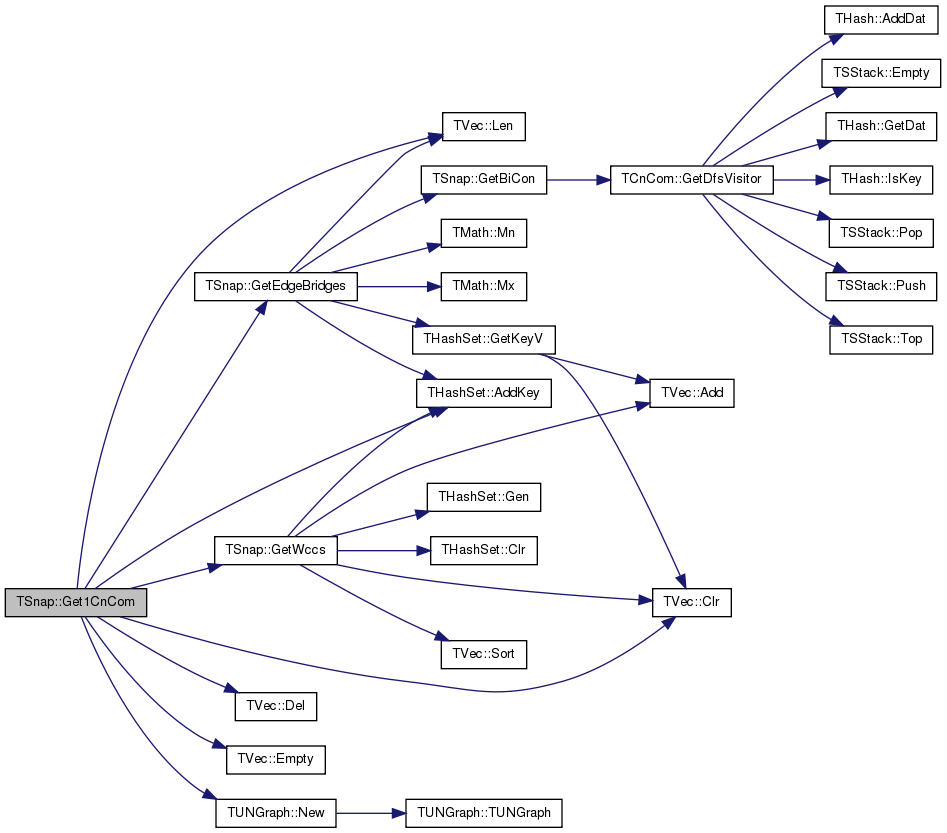

| void TSnap::Get1CnComSzCnt | ( | const PUNGraph & | Graph, |
| TIntPrV & | SzCntV | ||
| ) |
Distribution of sizes of 1-components, maximal components of that can be disconnected from the Graph by removing a single edge. We find such components as follows: Find all bridge edges, remove them from the Graph, find largest component K and add back all bridges that do not touch K. Now, find the connected components of this graph.
Definition at line 70 of file cncom.cpp.
References THashSet< TKey, THashFunc >::AddKey(), TVec< TVal >::Clr(), TVec< TVal >::Del(), TVec< TVal >::Empty(), GetEdgeBridges(), GetWccs(), GetWccSzCnt(), IAssert, TVec< TVal >::Len(), and TUNGraph::New().
{
//TCnCom::GetWccCnt(Graph, SzCntV); IAssertR(SzCntV.Len() == 1, "Graph is not connected.");
TIntPrV EdgeV;
GetEdgeBridges(Graph, EdgeV);
if (EdgeV.Empty()) { SzCntV.Clr(false); return; }
PUNGraph TmpG = TUNGraph::New();
*TmpG = *Graph;
for (int e = 0; e < EdgeV.Len(); e++) {
TmpG->DelEdge(EdgeV[e].Val1, EdgeV[e].Val2); }
TCnComV CnComV; GetWccs(TmpG, CnComV);
IAssert(CnComV.Len() >= 2);
const TIntV& MxWcc = CnComV[0].NIdV;
TIntSet MxCcSet(MxWcc.Len());
for (int i = 0; i < MxWcc.Len(); i++) {
MxCcSet.AddKey(MxWcc[i]); }
// create new graph: bridges not touching MxCc of G with no bridges
for (int e = 0; e < EdgeV.Len(); e++) {
if (! MxCcSet.IsKey(EdgeV[e].Val1) && ! MxCcSet.IsKey(EdgeV[e].Val2)) {
TmpG->AddEdge(EdgeV[e].Val1, EdgeV[e].Val2); }
}
GetWccSzCnt(TmpG, SzCntV);
for (int c = 0; c < SzCntV.Len(); c++) {
if (SzCntV[c].Val1 == MxCcSet.Len()) {
SzCntV.Del(c); break; }
}
}
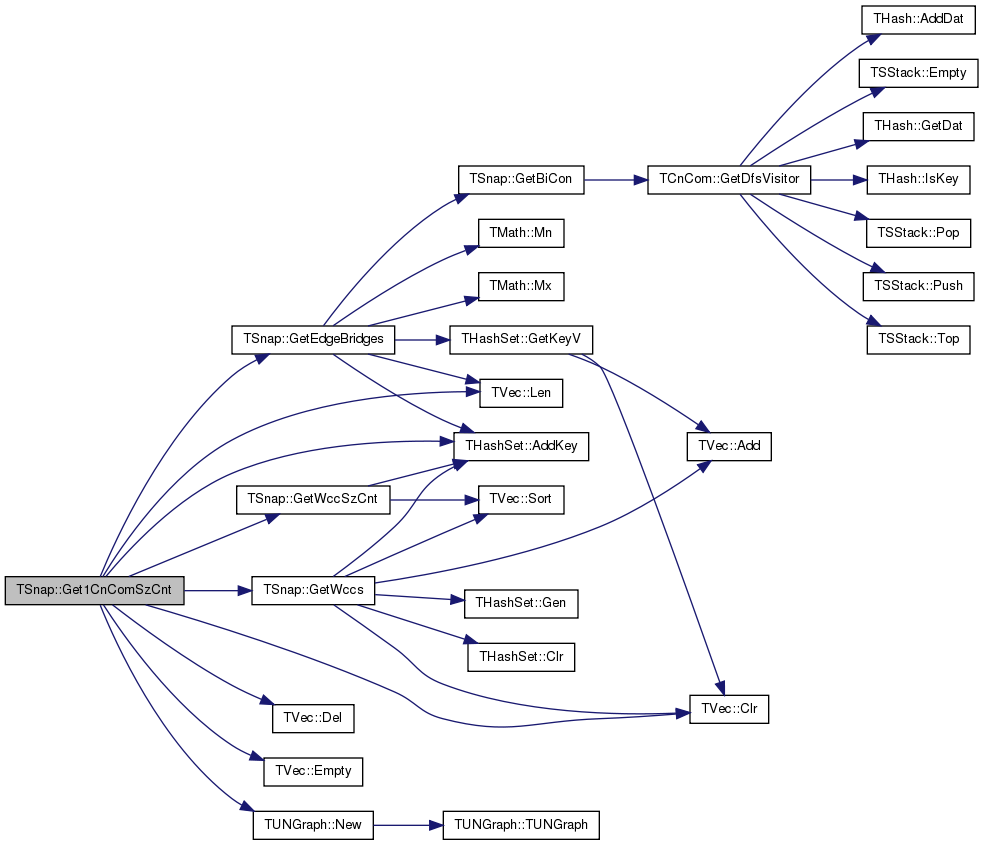
| void TSnap::GetAnf | ( | const PGraph & | Graph, |
| const int & | SrcNId, | ||
| TIntFltKdV & | DistNbrsV, | ||
| const int & | MxDist, | ||
| const bool & | IsDir, | ||
| const int & | NApprox = 32 |
||
| ) |
Approximate Neighborhood Function of a node: Returns the (approximate) number of nodes reachable from SrcNId in less than H hops.
| SrcNId | Starting node. |
| DistNbrsV | Maps between the distance H (in hops) and the number of nodes reachable in <=H hops. |
| MxDist | Maximum number of hops the algorithm spreads from SrcNId. |
| IsDir | false: consider links as undirected (drop link directions). |
| NApprox | Quality of approximation. See the ANF paper. |
Definition at line 205 of file anf.h.
References TGraphAnf< PGraph >::GetNodeAnf().
Referenced by PlotHops(), and TGStat::TakeDiam().
{
TGraphAnf<PGraph> Anf(Graph, NApprox, 5, 0);
Anf.GetNodeAnf(SrcNId, DistNbrsV, MxDist, IsDir);
}
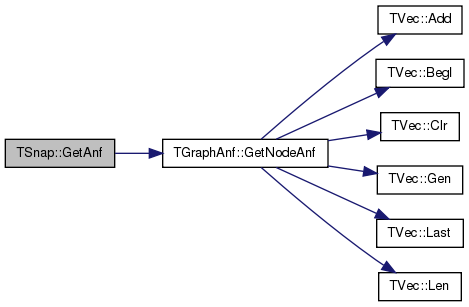

| void TSnap::GetAnf | ( | const PGraph & | Graph, |
| TIntFltKdV & | DistNbrsV, | ||
| const int & | MxDist, | ||
| const bool & | IsDir, | ||
| const int & | NApprox = 32 |
||
| ) |
Approximate Neighborhood Function of a Graph: Returns the number of pairs of nodes reachable in less than H hops. For example, DistNbrsV.GetDat(0) is the number of nodes in the graph, DistNbrsV.GetDat(1) is the number of nodes+edges and so on.
| DistNbrsV | Maps between the distance H (in hops) and the number of nodes reachable in <=H hops. |
| MxDist | Maximum number of hops the algorithm spreads from SrcNId. |
| IsDir | false: consider links as undirected (drop link directions). |
| NApprox | Quality of approximation. See the ANF paper. |
Definition at line 211 of file anf.h.
References TGraphAnf< PGraph >::GetGraphAnf().
{
TGraphAnf<PGraph> Anf(Graph, NApprox, 5, 0);
Anf.GetGraphAnf(DistNbrsV, MxDist, IsDir);
}
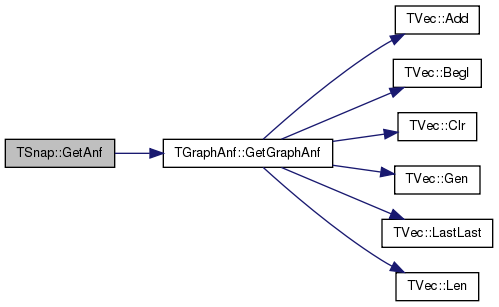
| double TSnap::GetAnfEffDiam | ( | const PGraph & | Graph, |
| const bool & | IsDir, | ||
| const double & | Percentile, | ||
| const int & | NApprox | ||
| ) |
Returns a given Percentile of the shortest path length distribution of a Graph (based on a single run of ANF of approximation quality NApprox).
| IsDir | false: consider links as undirected (drop link directions). |
Definition at line 217 of file anf.h.
References TSnap::TSnapDetail::CalcEffDiam(), and TGraphAnf< PGraph >::GetGraphAnf().
Referenced by GetAnfEffDiam(), TKroneckerLL::GradDescentConvergence(), TTimeNet::PlotEffDiam(), and TTimeNENet::PlotEffDiam().
{
TIntFltKdV DistNbrsV;
TGraphAnf<PGraph> Anf(Graph, NApprox, 5, 0);
Anf.GetGraphAnf(DistNbrsV, -1, IsDir);
return TSnap::TSnapDetail::CalcEffDiam(DistNbrsV, Percentile);
}
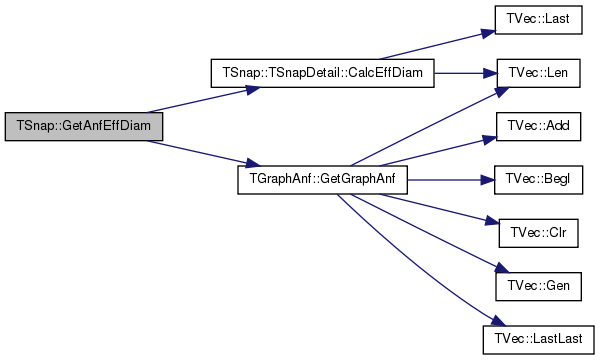
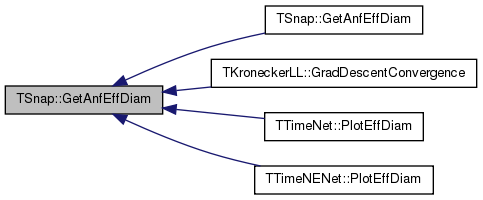
| double TSnap::GetAnfEffDiam | ( | const PGraph & | Graph, |
| const int | NRuns = 1, |
||
| int | NApprox = -1 |
||
| ) |
Returns a 90-th percentile of the shortest path length distribution of a Graph (based on a NRuns runs of ANF of approximation quality NApprox).
| IsDir | false: consider links as undirected (drop link directions). |
Definition at line 225 of file anf.h.
References TMom::Add(), TMom::Def(), GetAnfEffDiam(), and TMom::GetMean().
{
//return TSnap::GetEffDiam(Graph, IsDir, 0.9, 32);
TMom Mom;
if (NApprox == -1) {
if (Graph->GetNodes() < 100000) { NApprox = 64; }
else if (Graph->GetNodes() < 1000000) { NApprox = 32; }
else { NApprox = 16; }
}
const bool IsDir = false;
for (int r = 0; r < NRuns; r++) {
Mom.Add(TSnap::GetAnfEffDiam(Graph, IsDir, 0.9, NApprox));
}
Mom.Def();
return Mom.GetMean();
}
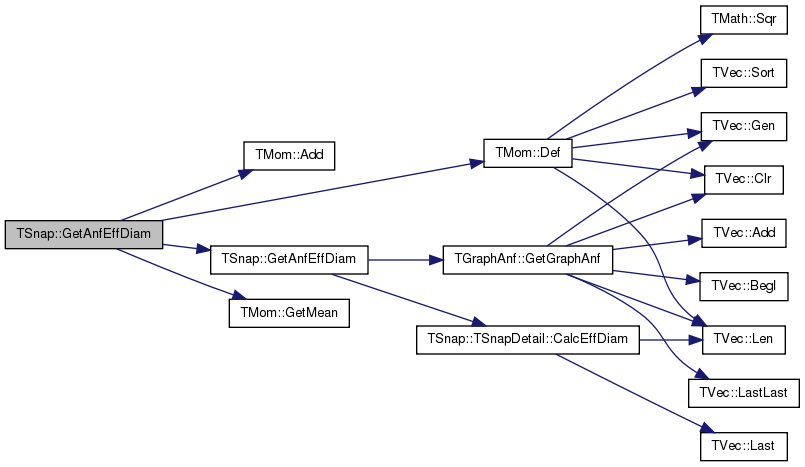
| void TSnap::GetArtPoints | ( | const PUNGraph & | Graph, |
| TIntV & | ArtNIdV | ||
| ) |
Returns articulartion points of a Graph. Articulation point (or a cut vertex) is any node that when removed increases the number of connected components.
Definition at line 48 of file cncom.cpp.
References TCnCom::GetDfsVisitor().
{
TArtPointVisitor Visitor(Graph->GetNodes());
TCnCom::GetDfsVisitor(Graph, Visitor);
Visitor.ArtSet.GetKeyV(ArtNIdV);
}
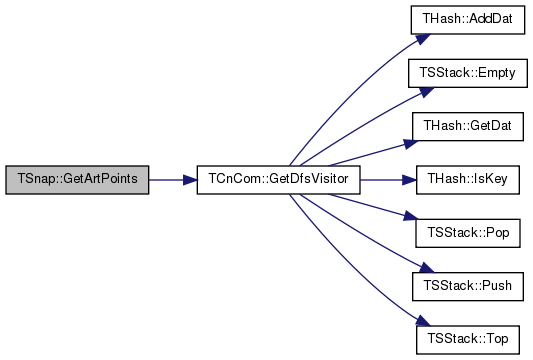
| void TSnap::GetBetweennessCentr | ( | const PUNGraph & | Graph, |
| const TIntV & | BtwNIdV, | ||
| TIntFltH & | NodeBtwH, | ||
| const bool & | DoNodeCent, | ||
| TIntPrFltH & | EdgeBtwH, | ||
| const bool & | DoEdgeCent | ||
| ) |
Computes (approximate) Beetweenness Centrality of all nodes and all edges of the network. To obtain exact betweenness values one needs to solve single-source shortest-path problem for every node. To speed up the algorithm we solve the shortest-path problem for the BtwNIdV subset of nodes. This gives centrality values that are about Graph->GetNodes()/BtwNIdV.Len() times lower than the exact betweenness centrality valus. See "A Faster Algorithm for Beetweenness Centrality", Ulrik Brandes, Journal of Mathematical Sociology, 2001, and "Centrality Estimation in Large Networks", Urlik Brandes and Christian Pich, 2006 for more details.
Definition at line 28 of file centr.cpp.
References TVec< TVal >::Add(), THash< TKey, TDat, THashFunc >::AddDat(), THash< TKey, TDat, THashFunc >::Clr(), TSStack< TVal >::Clr(), TQQueue< TVal >::Clr(), TSStack< TVal >::Empty(), TQQueue< TVal >::Empty(), THash< TKey, TDat, THashFunc >::GetDat(), TUNGraph::TNodeI::GetId(), TUNGraph::TNodeI::GetOutDeg(), TUNGraph::TNodeI::GetOutNId(), TVec< TVal >::Len(), TMath::Mn(), TMath::Mx(), TSStack< TVal >::Pop(), TQQueue< TVal >::Pop(), TSStack< TVal >::Push(), TQQueue< TVal >::Push(), TSStack< TVal >::Top(), and TQQueue< TVal >::Top().
Referenced by TSnap::TSnapDetail::CmtyGirvanNewmanStep(), and GetBetweennessCentr().
{
if (DoNodeCent) { NodeBtwH.Clr(); }
if (DoEdgeCent) { EdgeBtwH.Clr(); }
const int nodes = Graph->GetNodes();
TIntS S(nodes);
TIntQ Q(nodes);
TIntIntVH P(nodes); // one vector for every node
TIntFltH delta(nodes);
TIntH sigma(nodes), d(nodes);
// init
for (TUNGraph::TNodeI NI = Graph->BegNI(); NI < Graph->EndNI(); NI++) {
if (DoNodeCent) {
NodeBtwH.AddDat(NI.GetId(), 0); }
if (DoEdgeCent) {
for (int e = 0; e < NI.GetOutDeg(); e++) {
if (NI.GetId() < NI.GetOutNId(e)) {
EdgeBtwH.AddDat(TIntPr(NI.GetId(), NI.GetOutNId(e)), 0); }
}
}
sigma.AddDat(NI.GetId(), 0);
d.AddDat(NI.GetId(), -1);
P.AddDat(NI.GetId(), TIntV());
delta.AddDat(NI.GetId(), 0);
}
// calc betweeness
for (int k=0; k < BtwNIdV.Len(); k++) {
const TUNGraph::TNodeI NI = Graph->GetNI(BtwNIdV[k]);
// reset
for (int i = 0; i < sigma.Len(); i++) {
sigma[i]=0; d[i]=-1; delta[i]=0; P[i].Clr(false);
}
S.Clr(false);
Q.Clr(false);
sigma.AddDat(NI.GetId(), 1);
d.AddDat(NI.GetId(), 0);
Q.Push(NI.GetId());
while (! Q.Empty()) {
const int v = Q.Top(); Q.Pop();
const TUNGraph::TNodeI NI2 = Graph->GetNI(v);
S.Push(v);
const int VDat = d.GetDat(v);
for (int e = 0; e < NI2.GetOutDeg(); e++) {
const int w = NI2.GetOutNId(e);
if (d.GetDat(w) < 0) { // find w for the first time
Q.Push(w);
d.AddDat(w, VDat+1);
}
//shortest path to w via v ?
if (d.GetDat(w) == VDat+1) {
sigma.AddDat(w) += sigma.GetDat(v);
P.GetDat(w).Add(v);
}
}
}
while (! S.Empty()) {
const int w = S.Top();
const double SigmaW = sigma.GetDat(w);
const double DeltaW = delta.GetDat(w);
const TIntV NIdV = P.GetDat(w);
S.Pop();
for (int i = 0; i < NIdV.Len(); i++) {
const int nid = NIdV[i];
const double c = (sigma.GetDat(nid)*1.0/SigmaW) * (1+DeltaW);
delta.AddDat(nid) += c;
if (DoEdgeCent) {
EdgeBtwH.AddDat(TIntPr(TMath::Mn(nid, w), TMath::Mx(nid, w))) += c; }
}
if (DoNodeCent && w != NI.GetId()) {
NodeBtwH.AddDat(w) += delta.GetDat(w)/2.0; }
}
}
}
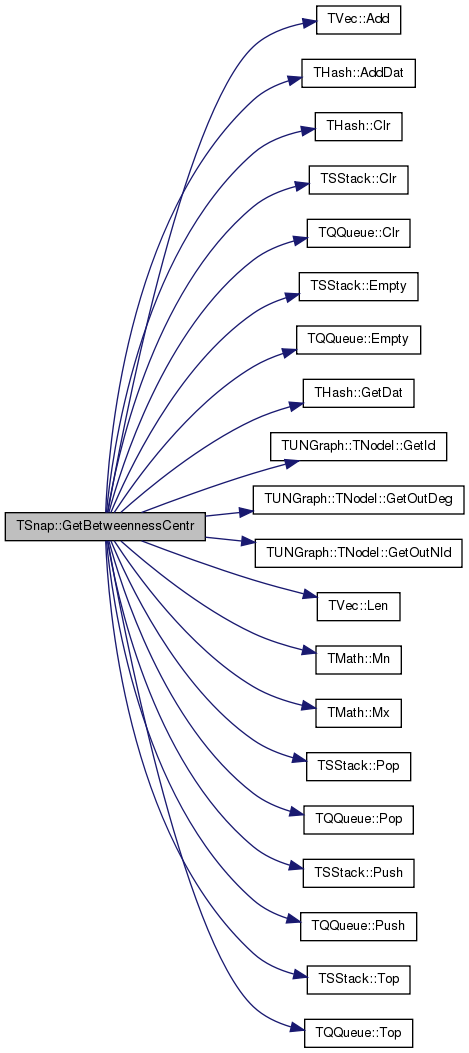

| void TSnap::GetBetweennessCentr | ( | const PUNGraph & | Graph, |
| TIntFltH & | NIdBtwH, | ||
| const double & | NodeFrac = 1.0 |
||
| ) |
Computes (approximate) Node Beetweenness Centrality based on a sample of NodeFrac nodes.
| NIdBtwH | hash table mapping node ids to their corresponding betweenness centrality values. |
| NodeFrac | quality of approximation. NodeFrac=1.0 gives exact betweenness values. |
Computes (approximate) Edge Beetweenness Centrality based on a sample of NodeFrac nodes.
| EdgeBtwH | hash table mapping edges (pairs of node ids) to their corresponding betweenness centrality values. |
| NodeFrac | quality of approximation. NodeFrac=1.0 gives exact betweenness values. |
Definition at line 103 of file centr.cpp.
References TVec< TVal >::DelLast(), GetBetweennessCentr(), TVec< TVal >::Len(), TInt::Rnd, and TVec< TVal >::Shuffle().
{
TIntPrFltH EdgeBtwH;
TIntV NIdV; Graph->GetNIdV(NIdV);
if (NodeFrac < 1.0) { // calculate beetweenness centrality for a subset of nodes
NIdV.Shuffle(TInt::Rnd);
for (int i = int((1.0-NodeFrac)*NIdV.Len()); i > 0; i--) {
NIdV.DelLast(); }
}
GetBetweennessCentr(Graph, NIdV, NodeBtwH, true, EdgeBtwH, false);
}
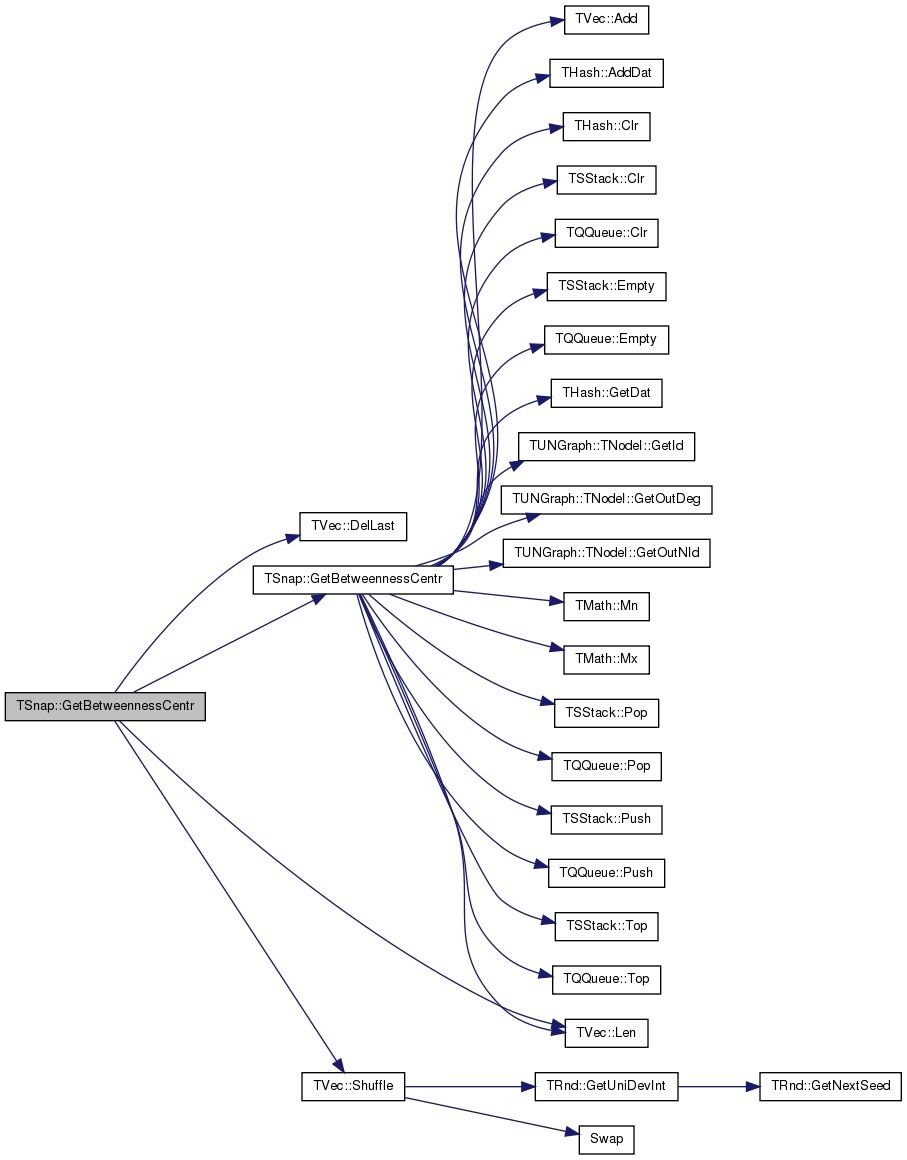
| void TSnap::GetBetweennessCentr | ( | const PUNGraph & | Graph, |
| TIntFltH & | NIdBtwH, | ||
| TIntPrFltH & | EdgeBtwH, | ||
| const double & | NodeFrac = 1.0 |
||
| ) |
Computes (approximate) Node and Edge Beetweenness Centrality based on a sample of NodeFrac nodes.
| NIdBtwH | hash table mapping node ids to their corresponding betweenness centrality values. |
| EdgeBtwH | hash table mapping edges (pairs of node ids) to their corresponding betweenness centrality values. |
| NodeFrac | quality of approximation. NodeFrac=1.0 gives exact betweenness values. |
Definition at line 125 of file centr.cpp.
References TVec< TVal >::DelLast(), GetBetweennessCentr(), TVec< TVal >::Len(), TInt::Rnd, and TVec< TVal >::Shuffle().
{
TIntV NIdV; Graph->GetNIdV(NIdV);
if (NodeFrac < 1.0) { // calculate beetweenness centrality for a subset of nodes
NIdV.Shuffle(TInt::Rnd);
for (int i = int((1.0-NodeFrac)*NIdV.Len()); i > 0; i--) {
NIdV.DelLast(); }
}
GetBetweennessCentr(Graph, NIdV, NodeBtwH, true, EdgeBtwH, true);
}
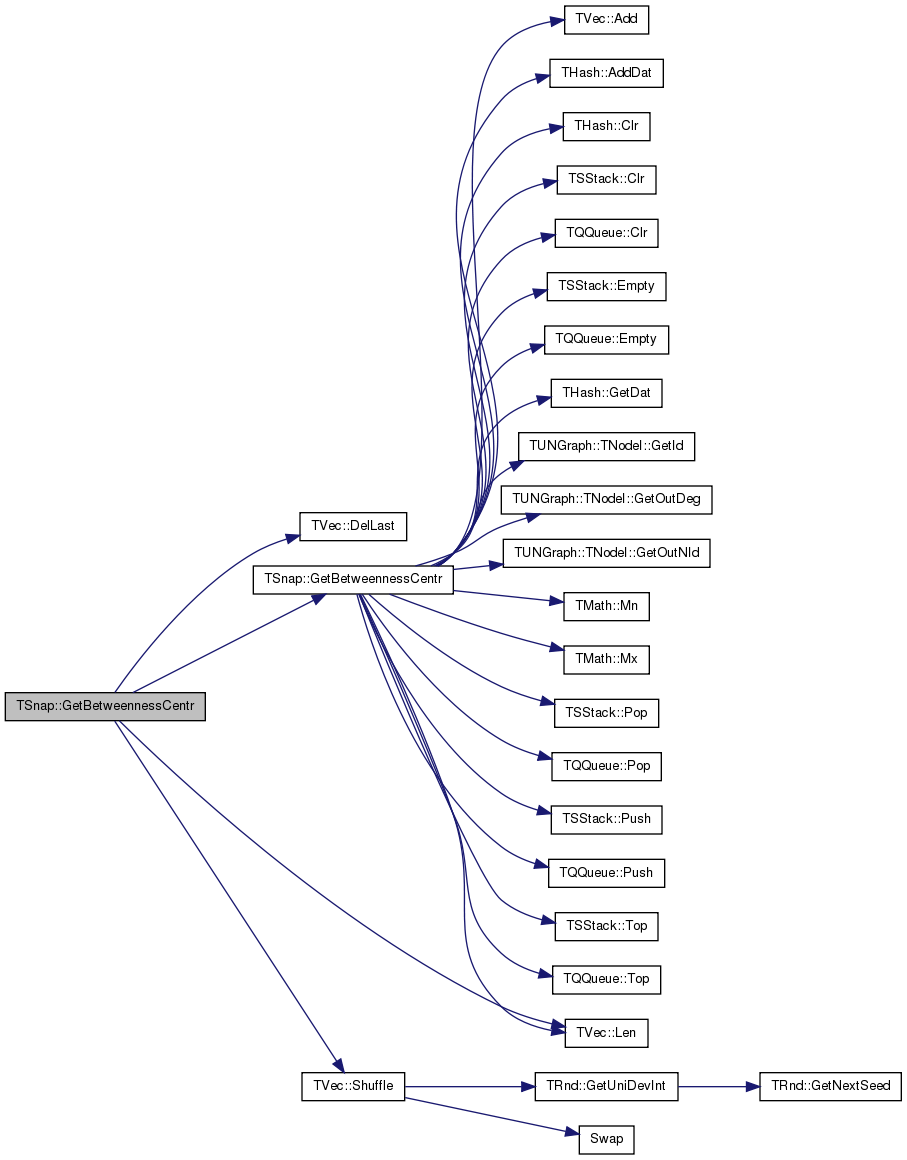
| double TSnap::GetBfsEffDiam | ( | const PGraph & | Graph, |
| const int & | NTestNodes, | ||
| const bool & | IsDir = false |
||
| ) |
Returns the (approximation of the) Effective Diameter (90-th percentile of the distribution of shortest path lenghts) of a graph (by performing BFS from NTestNodes random starting nodes).
| IsDir | false: ignore edge directions and consider edges/paths as undirected (in case they are directed). |
Definition at line 269 of file bfsdfs.h.
Referenced by GetBfsEffDiam(), GetBfsFullDiam(), and TTimeNet::PlotMissingPast().
{
int FullDiam;
double EffDiam;
GetBfsEffDiam(Graph, NTestNodes, IsDir, EffDiam, FullDiam);
return EffDiam;
}

| double TSnap::GetBfsEffDiam | ( | const PGraph & | Graph, |
| const int & | NTestNodes, | ||
| const bool & | IsDir, | ||
| double & | EffDiam, | ||
| int & | FullDiam | ||
| ) |
Returns the (approximation of the) Effective Diameter and the Diameter of a graph (by performing BFS from NTestNodes random starting nodes).
| IsDir | false: ignore edge directions and consider edges/paths as undirected (in case they are directed). |
Definition at line 277 of file bfsdfs.h.
References GetBfsEffDiam().
{
double AvgDiam;
EffDiam = -1; FullDiam = -1;
return GetBfsEffDiam(Graph, NTestNodes, IsDir, EffDiam, FullDiam, AvgDiam);
}

| double TSnap::GetBfsEffDiam | ( | const PGraph & | Graph, |
| const int & | NTestNodes, | ||
| const bool & | IsDir, | ||
| double & | EffDiam, | ||
| int & | FullDiam, | ||
| double & | AvgDiam | ||
| ) |
Returns the (approximation of the) Effective Diameter, the Diameter and the Average Shortest Path lenght in a graph (by performing BFS from NTestNodes random starting nodes).
| IsDir | false: ignore edge directions and consider edges/paths as undirected (in case they are directed). |
Definition at line 284 of file bfsdfs.h.
References TVec< TVal >::Add(), THash< TKey, TDat, THashFunc >::AddDat(), TSnap::TSnapDetail::CalcEffDiamPdf(), TBreathFS< PGraph >::DoBfs(), THash< TKey, TDat, THashFunc >::GetKey(), TVec< TVal >::Last(), THash< TKey, TDat, THashFunc >::Len(), TMath::Mn(), TInt::Mx, TBreathFS< PGraph >::NIdDistH, TInt::Rnd, TVec< TVal >::Shuffle(), and TVec< TVal >::Sort().
{
EffDiam = -1; FullDiam = -1; AvgDiam = -1;
TIntFltH DistToCntH;
TBreathFS<PGraph> BFS(Graph);
// shotest paths
TIntV NodeIdV;
Graph->GetNIdV(NodeIdV); NodeIdV.Shuffle(TInt::Rnd);
for (int tries = 0; tries < TMath::Mn(NTestNodes, Graph->GetNodes()); tries++) {
const int NId = NodeIdV[tries];
BFS.DoBfs(NId, true, ! IsDir, -1, TInt::Mx);
for (int i = 0; i < BFS.NIdDistH.Len(); i++) {
DistToCntH.AddDat(BFS.NIdDistH[i]) += 1; }
}
TIntFltKdV DistNbrsPdfV;
double SumPathL=0, PathCnt=0;
for (int i = 0; i < DistToCntH.Len(); i++) {
DistNbrsPdfV.Add(TIntFltKd(DistToCntH.GetKey(i), DistToCntH[i]));
SumPathL += DistToCntH.GetKey(i) * DistToCntH[i];
PathCnt += DistToCntH[i];
}
DistNbrsPdfV.Sort();
EffDiam = TSnap::TSnapDetail::CalcEffDiamPdf(DistNbrsPdfV, 0.9); // effective diameter (90-th percentile)
FullDiam = DistNbrsPdfV.Last().Key; // approximate full diameter (max shortest path length over the sampled nodes)
AvgDiam = SumPathL/PathCnt; // average shortest path length
return EffDiam;
}
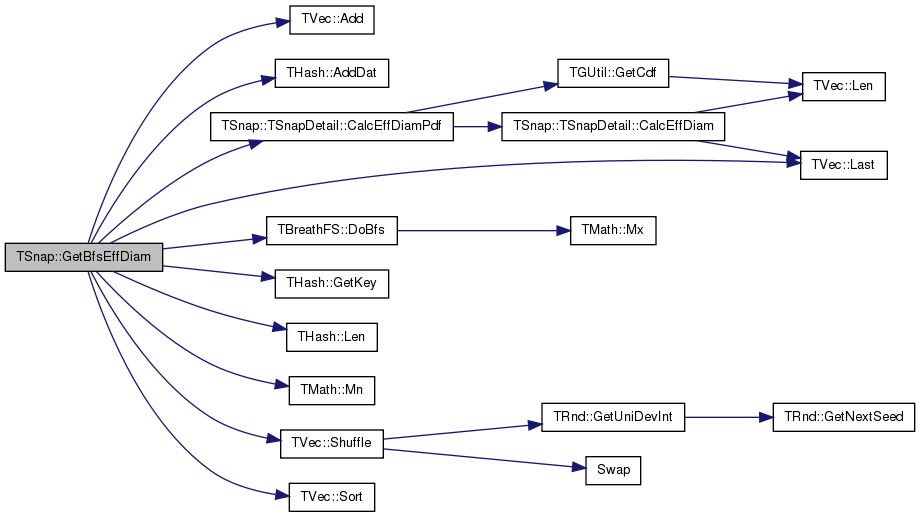
| double TSnap::GetBfsEffDiam | ( | const PGraph & | Graph, |
| const int & | NTestNodes, | ||
| const TIntV & | SubGraphNIdV, | ||
| const bool & | IsDir, | ||
| double & | EffDiam, | ||
| int & | FullDiam | ||
| ) |
Use the whole graph (all edges) to measure the shortest path lenghts but report the path lengths only between nodes in the SubGraphNIdV.
| IsDir | false: ignore edge directions and consider edges/paths as undirected (in case they are directed). |
Definition at line 312 of file bfsdfs.h.
References TVec< TVal >::Add(), THash< TKey, TDat, THashFunc >::AddDat(), TSnap::TSnapDetail::CalcEffDiamPdf(), TBreathFS< PGraph >::DoBfs(), THash< TKey, TDat, THashFunc >::GetKey(), THash< TKey, TDat, THashFunc >::IsKeyGetDat(), TVec< TVal >::Last(), THash< TKey, TDat, THashFunc >::Len(), TVec< TVal >::Len(), TMath::Mn(), TInt::Mx, TBreathFS< PGraph >::NIdDistH, TInt::Rnd, TVec< TVal >::Shuffle(), and TVec< TVal >::Sort().
{
EffDiam = -1;
FullDiam = -1;
TIntFltH DistToCntH;
TBreathFS<PGraph> BFS(Graph);
// shotest paths
TIntV NodeIdV(SubGraphNIdV); NodeIdV.Shuffle(TInt::Rnd);
TInt Dist;
for (int tries = 0; tries < TMath::Mn(NTestNodes, Graph->GetNodes()); tries++) {
const int NId = NodeIdV[tries];
BFS.DoBfs(NId, true, ! IsDir, -1, TInt::Mx);
for (int i = 0; i < SubGraphNIdV.Len(); i++) {
if (BFS.NIdDistH.IsKeyGetDat(SubGraphNIdV[i], Dist)) {
DistToCntH.AddDat(Dist) += 1; }
}
}
TIntFltKdV DistNbrsPdfV;
for (int i = 0; i < DistToCntH.Len(); i++) {
DistNbrsPdfV.Add(TIntFltKd(DistToCntH.GetKey(i), DistToCntH[i]));
}
DistNbrsPdfV.Sort();
EffDiam = TSnap::TSnapDetail::CalcEffDiamPdf(DistNbrsPdfV, 0.9); // effective diameter (90-th percentile)
FullDiam = DistNbrsPdfV.Last().Key; // approximate full diameter (max shortest path length over the sampled nodes)
return EffDiam; // average shortest path length
}
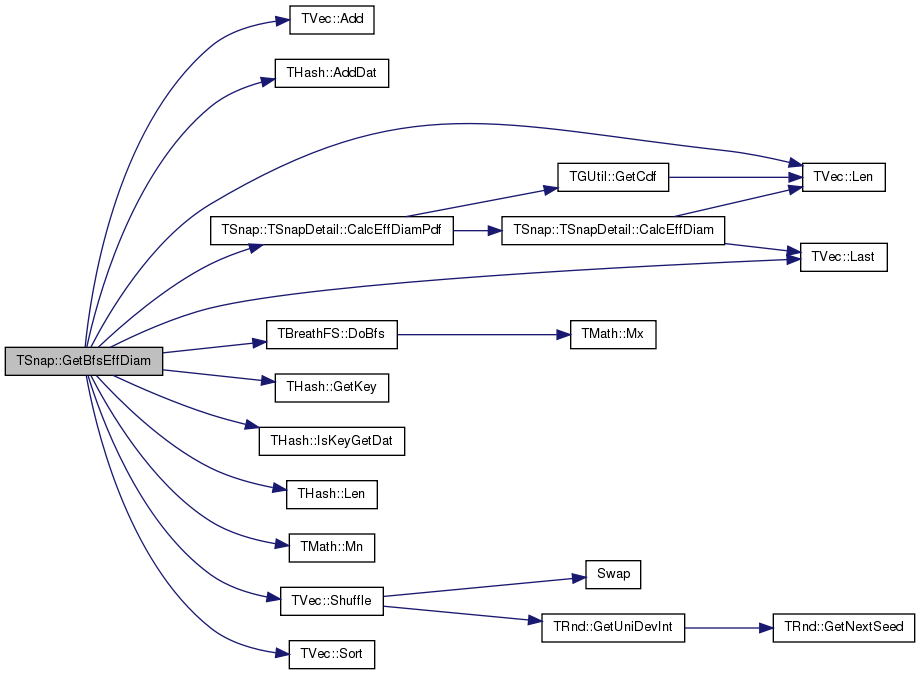
| int TSnap::GetBfsFullDiam | ( | const PGraph & | Graph, |
| const int & | NTestNodes, | ||
| const bool & | IsDir = false |
||
| ) |
Returns the (approximation of the) Diameter (maximum shortest path length) of a graph (by performing BFS from NTestNodes random starting nodes).
| IsDir | false: ignore edge directions and consider edges/paths as undirected (in case they are directed). |
Definition at line 261 of file bfsdfs.h.
References GetBfsEffDiam().
Referenced by TGStat::TakeDiam().
{
int FullDiam;
double EffDiam;
GetBfsEffDiam(Graph, NTestNodes, IsDir, EffDiam, FullDiam);
return FullDiam;
}


| PNGraph TSnap::GetBfsTree | ( | const PGraph & | Graph, |
| const int & | StartNId, | ||
| const bool & | FollowOut, | ||
| const bool & | FollowIn | ||
| ) |
Returns a directed Breath-First-Search tree rooted at StardNId. Returns a directed graph where a parent points to its childer. Tree is created by following in-links (parameter FollowIn = true) and/or out-links (parameter FollowOut = true).
Definition at line 177 of file bfsdfs.h.
References TNGraph::AddEdge(), TNGraph::AddNode(), TBreathFS< PGraph >::DoBfs(), THash< TKey, TDat, THashFunc >::GetDat(), THash< TKey, TDat, THashFunc >::GetKey(), TNGraph::IsNode(), THash< TKey, TDat, THashFunc >::Len(), TInt::Mx, TNGraph::New(), TBreathFS< PGraph >::NIdDistH, and THash< TKey, TDat, THashFunc >::SortByDat().
{
TBreathFS<PGraph> BFS(Graph, false);
BFS.DoBfs(StartNId, FollowOut, FollowIn, -1, TInt::Mx);
PNGraph Tree = TNGraph::New();
BFS.NIdDistH.SortByDat();
for (int i = 0; i < BFS.NIdDistH.Len(); i++) {
const int NId = BFS.NIdDistH.GetKey(i);
const int Dist = BFS.NIdDistH[i];
typename PGraph::TObj::TNodeI NI = Graph->GetNI(NId);
if (!Tree->IsNode(NId)) {
Tree->AddNode(NId);
}
if (FollowOut) {
for (int e = 0; e < NI.GetInDeg(); e++) {
const int Prev = NI.GetInNId(e);
if (Tree->IsNode(Prev) && BFS.NIdDistH.GetDat(Prev)==Dist-1) {
Tree->AddEdge(Prev, NId); }
}
}
if (FollowIn) {
for (int e = 0; e < NI.GetOutDeg(); e++) {
const int Prev = NI.GetOutNId(e);
if (Tree->IsNode(Prev) && BFS.NIdDistH.GetDat(Prev)==Dist-1) {
Tree->AddEdge(Prev, NId); }
}
}
}
return Tree;
}
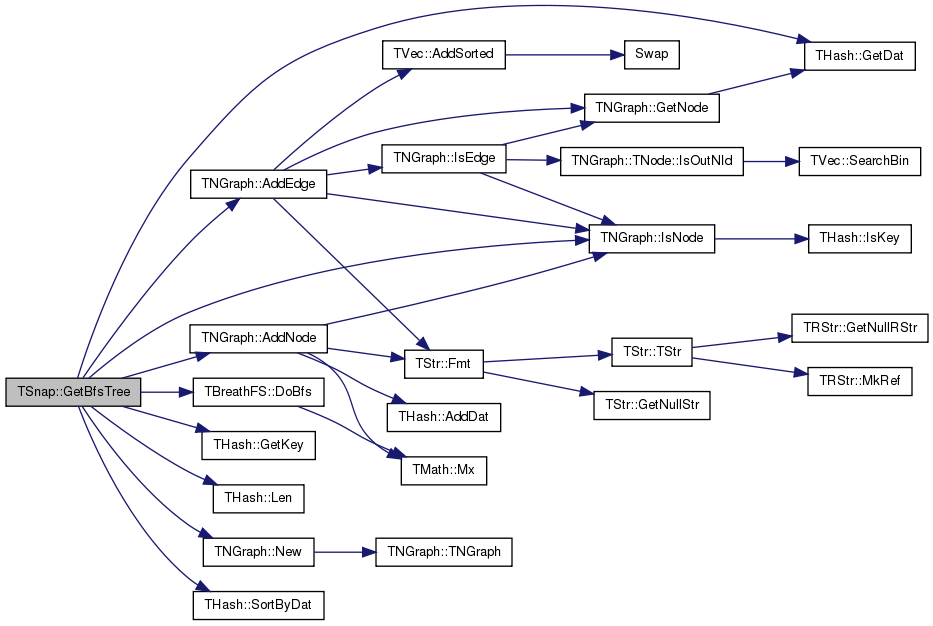
| void TSnap::GetBiCon | ( | const PUNGraph & | Graph, |
| TCnComV & | BiCnComV | ||
| ) |
Returns all bi-connected components of a Graph.
| BiCnComV | is a vector of bi-connected components. Each component is defined by the IDs of its member nodes. |
Definition at line 42 of file cncom.cpp.
References TCnCom::GetDfsVisitor().
Referenced by GetBiConSzCnt(), GetEdgeBridges(), and GetMxBiCon().
{
TBiConVisitor Visitor(Graph->GetNodes());
TCnCom::GetDfsVisitor(Graph, Visitor);
BiCnComV = Visitor.CnComV;
}
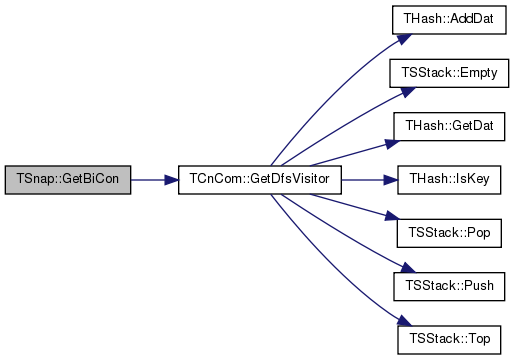

| void TSnap::GetBiConSzCnt | ( | const PUNGraph & | Graph, |
| TIntPrV & | SzCntV | ||
| ) |
Returns a distribution of bi-connected component sizes.
| SzCntV | returns a set of pairs (number of nodes in the bi-component, number of such components) |
Definition at line 31 of file cncom.cpp.
References THash< TKey, TDat, THashFunc >::AddDat(), GetBiCon(), THash< TKey, TDat, THashFunc >::GetKeyDatPrV(), TVec< TVal >::Len(), and TVec< TVal >::Sort().
{
TCnComV BiCnComV;
GetBiCon(Graph, BiCnComV);
TIntH SzCntH;
for (int c =0; c < BiCnComV.Len(); c++) {
SzCntH.AddDat(BiCnComV[c].Len()) += 1;
}
SzCntH.GetKeyDatPrV(SzCntV);
SzCntV.Sort();
}
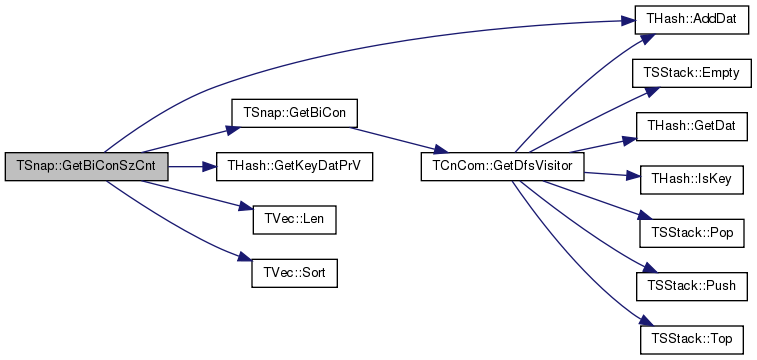
| double TSnap::GetClosenessCentr | ( | const PUNGraph & | Graph, |
| const int & | NId | ||
| ) |
Returns Closeness centrality of a given node NId. Closeness centrality of a node is defined as 1/FarnessCentrality.
Definition at line 22 of file centr.cpp.
References GetFarnessCentr().
{
const double Farness = GetFarnessCentr(Graph, NId);
if (Farness != 0.0) { return 1.0/Farness; }
else { return 0.0; }
}

| double TSnap::GetClustCf | ( | const PGraph & | Graph, |
| int | SampleNodes = -1 |
||
| ) |
Computes the average clustering coefficient as defined in Watts and Strogatz, Collective dynamics of 'small-world' networks.
Definition at line 64 of file triad.h.
References TVec< TVal >::Empty(), GetTriads(), IAssert, and TVec< TVal >::Len().
Referenced by TTimeNet::PlotCCfOverTm(), PlotClustCf(), and TGStat::TakeClustCf().
{
TIntTrV NIdCOTriadV;
GetTriads(Graph, NIdCOTriadV, SampleNodes);
if (NIdCOTriadV.Empty()) { return 0.0; }
double SumCcf = 0.0;
for (int i = 0; i < NIdCOTriadV.Len(); i++) {
const double OpenCnt = NIdCOTriadV[i].Val2()+NIdCOTriadV[i].Val3();
if (OpenCnt > 0) {
SumCcf += NIdCOTriadV[i].Val2() / OpenCnt; }
}
IAssert(SumCcf>=0);
return SumCcf / double(NIdCOTriadV.Len());
}


| double TSnap::GetClustCf | ( | const PGraph & | Graph, |
| TFltPrV & | DegToCCfV, | ||
| int | SampleNodes = -1 |
||
| ) |
Computes the distribution of average clustering coefficient.
| DegToCCfV | Vector of pairs (degree, avg. clustering coefficient of nodes of that degree). |
| SampleNodes | If !=-1 then compute clustering coefficient only for a random sample of SampleNodes nodes. Useful for approximate but quick computations. |
Definition at line 78 of file triad.h.
References TVec< TVal >::Add(), THash< TKey, TDat, THashFunc >::AddDat(), TVec< TVal >::Gen(), THash< TKey, TDat, THashFunc >::GetKey(), GetTriads(), THash< TKey, TDat, THashFunc >::Len(), TVec< TVal >::Len(), TVec< TVal >::Sort(), TInt::Val, TPair< TVal1, TVal2 >::Val1, and TPair< TVal1, TVal2 >::Val2.
{
TIntTrV NIdCOTriadV;
GetTriads(Graph, NIdCOTriadV, SampleNodes);
THash<TInt, TFltPr> DegSumCnt;
double SumCcf = 0.0;
for (int i = 0; i < NIdCOTriadV.Len(); i++) {
const int D = NIdCOTriadV[i].Val2()+NIdCOTriadV[i].Val3();
const double Ccf = D!=0 ? NIdCOTriadV[i].Val2() / double(D) : 0.0;
TFltPr& SumCnt = DegSumCnt.AddDat(Graph->GetNI(NIdCOTriadV[i].Val1).GetDeg());
SumCnt.Val1 += Ccf;
SumCnt.Val2 += 1;
SumCcf += Ccf;
}
// get average clustering coefficient for each degree
DegToCCfV.Gen(DegSumCnt.Len(), 0);
for (int d = 0; d < DegSumCnt.Len(); d++) {
DegToCCfV.Add(TFltPr(DegSumCnt.GetKey(d).Val, double(DegSumCnt[d].Val1()/DegSumCnt[d].Val2())));
}
DegToCCfV.Sort();
return SumCcf / double(NIdCOTriadV.Len());
}
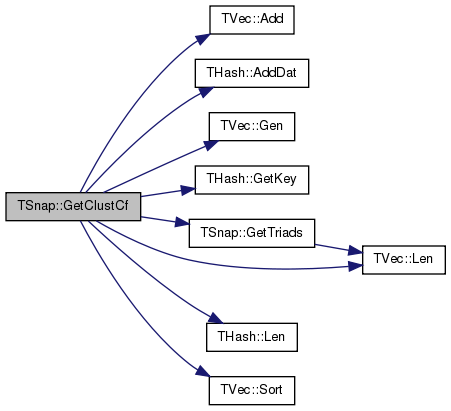
| double TSnap::GetClustCf | ( | const PGraph & | Graph, |
| TFltPrV & | DegToCCfV, | ||
| int & | ClosedTriads, | ||
| int & | OpenTriads, | ||
| int | SampleNodes = -1 |
||
| ) |
Computes the distribution of average clustering coefficient as well as the number of open and closed triads in the graph.
| DegToCCfV | Vector of pairs (degree, avg. clustering coefficient of nodes of that degree). |
| SampleNodes | If !=-1 then compute clustering coefficient only for a random sample of SampleNodes nodes. Useful for approximate but quick computations. |
Definition at line 101 of file triad.h.
References TVec< TVal >::Add(), THash< TKey, TDat, THashFunc >::AddDat(), TStr::Fmt(), TVec< TVal >::Gen(), THash< TKey, TDat, THashFunc >::GetKey(), GetTriads(), THash< TKey, TDat, THashFunc >::Len(), TVec< TVal >::Len(), TInt::Mx, TVec< TVal >::Sort(), TInt::Val, TPair< TVal1, TVal2 >::Val1, TPair< TVal1, TVal2 >::Val2, and WarnNotify().
{
TIntTrV NIdCOTriadV;
GetTriads(Graph, NIdCOTriadV, SampleNodes);
THash<TInt, TFltPr> DegSumCnt;
double SumCcf = 0.0;
uint64 closedTriads = 0;
uint64 openTriads = 0;
for (int i = 0; i < NIdCOTriadV.Len(); i++) {
const int D = NIdCOTriadV[i].Val2()+NIdCOTriadV[i].Val3();
const double Ccf = D!=0 ? NIdCOTriadV[i].Val2() / double(D) : 0.0;
closedTriads += NIdCOTriadV[i].Val2;
openTriads += NIdCOTriadV[i].Val3;
TFltPr& SumCnt = DegSumCnt.AddDat(Graph->GetNI(NIdCOTriadV[i].Val1).GetDeg());
SumCnt.Val1 += Ccf;
SumCnt.Val2 += 1;
SumCcf += Ccf;
}
// get average clustering coefficient for each degree
DegToCCfV.Gen(DegSumCnt.Len(), 0);
for (int d = 0; d < DegSumCnt.Len(); d++) {
DegToCCfV.Add(TFltPr(DegSumCnt.GetKey(d).Val, DegSumCnt[d].Val1()/DegSumCnt[d].Val2()));
}
if(closedTriads/3 > (uint64) TInt::Mx) { WarnNotify(TStr::Fmt("[%s line %d] %g closed triads.\n", __FILE__, __LINE__, float(closedTriads/3)).CStr()); }
if(openTriads > (uint64) TInt::Mx) { WarnNotify(TStr::Fmt("[%s line %d] %g open triads.\n", __FILE__, __LINE__, float(openTriads/3)).CStr()); }
ClosedTriads = int(closedTriads/3); // each triad is counted 3 times
OpenTriads = int(openTriads);
DegToCCfV.Sort();
return SumCcf / double(NIdCOTriadV.Len());
}
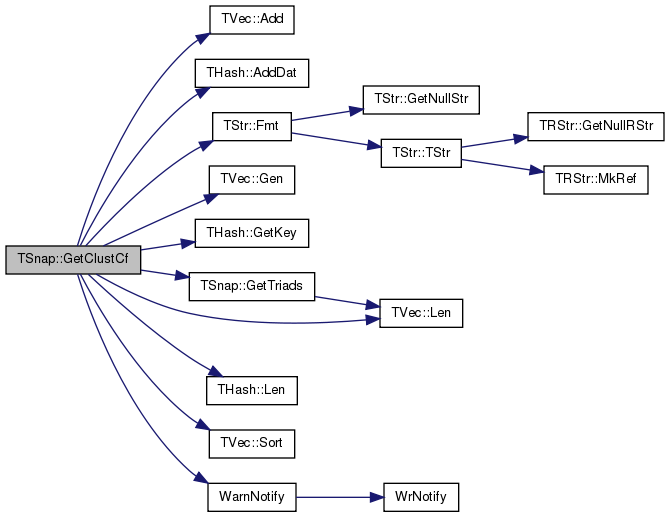
| int TSnap::GetCmnNbrs | ( | const PGraph & | Graph, |
| const int & | NId1, | ||
| const int & | NId2 | ||
| ) |
Returns a number of shared neighbors between a pair of nodes NId1 and NId2.
Definition at line 382 of file triad.h.
Referenced by TTimeNENet::GetTriadEdges().
{
TIntV NbrV;
return GetCmnNbrs(Graph, NId1, NId2, NbrV);
}

| int TSnap::GetCmnNbrs | ( | const PGraph & | Graph, |
| const int & | NId1, | ||
| const int & | NId2, | ||
| TIntV & | NbrV | ||
| ) |
Returns the shared neighbors between a pair of nodes NId1 and NId2.
Definition at line 389 of file triad.h.
References THashSet< TKey, THashFunc >::AddKey(), TVec< TVal >::Clr(), TVec< TVal >::Len(), TMath::Mn(), and TVec< TVal >::Reserve().
{
if (! Graph->IsNode(NId1) || ! Graph->IsNode(NId2)) { NbrV.Clr(false); return 0; }
typename PGraph::TObj::TNodeI NI1 = Graph->GetNI(NId1);
typename PGraph::TObj::TNodeI NI2 = Graph->GetNI(NId2);
NbrV.Clr(false);
NbrV.Reserve(TMath::Mn(NI1.GetDeg(), NI2.GetDeg()));
TIntSet NSet1(NI1.GetDeg()), NSet2(NI2.GetDeg());
for (int i = 0; i < NI1.GetDeg(); i++) {
const int nid = NI1.GetNbrNId(i);
if (nid!=NId1 && nid!=NId2) {
NSet1.AddKey(nid); }
}
for (int i = 0; i < NI2.GetDeg(); i++) {
const int nid = NI2.GetNbrNId(i);
if (NSet1.IsKey(nid)) {
NSet2.AddKey(nid);
}
}
NSet2.GetKeyV(NbrV);
return NbrV.Len();
}
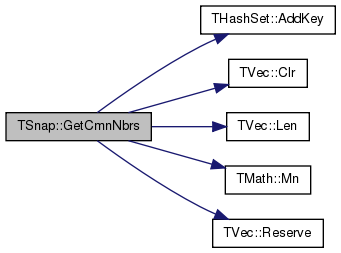
| int TSnap::GetCmnNbrs< PUNGraph > | ( | const PUNGraph & | Graph, |
| const int & | NId1, | ||
| const int & | NId2, | ||
| TIntV & | NbrV | ||
| ) | [inline] |
Definition at line 412 of file triad.h.
References TUNGraph::TNodeI::GetDeg(), TUNGraph::TNodeI::GetNbrNId(), IAssert, and TMath::Mn().
{
if (! Graph->IsNode(NId1) || ! Graph->IsNode(NId2)) { NbrV.Clr(false); return 0; }
const TUNGraph::TNodeI NI1 = Graph->GetNI(NId1);
const TUNGraph::TNodeI NI2 = Graph->GetNI(NId2);
int i=0, j=0;
NbrV.Clr(false);
NbrV.Reserve(TMath::Mn(NI1.GetDeg(), NI2.GetDeg()));
while (i < NI1.GetDeg() && j < NI2.GetDeg()) {
const int nid = NI1.GetNbrNId(i);
while (j < NI2.GetDeg() && NI2.GetNbrNId(j) < nid) { j++; }
if (j < NI2.GetDeg() && nid==NI2.GetNbrNId(j) && nid!=NId1 && nid!=NId2) {
IAssert(NbrV.Empty() || NbrV.Last() < nid);
NbrV.Add(nid);
j++;
}
i++;
}
return NbrV.Len();
}

| void TSnap::GetDegCnt | ( | const PGraph & | Graph, |
| TIntPrV & | DegToCntV | ||
| ) |
TODO ROK document GetDegCnt()
Definition at line 208 of file alg.h.
References TVec< TVal >::Add(), THash< TKey, TDat, THashFunc >::AddDat(), TVec< TVal >::Gen(), THash< TKey, TDat, THashFunc >::GetKey(), THash< TKey, TDat, THashFunc >::Len(), and TVec< TVal >::Sort().
{
TIntH DegToCntH;
for (typename PGraph::TObj::TNodeI NI = Graph->BegNI(); NI < Graph->EndNI(); NI++) {
DegToCntH.AddDat(NI.GetDeg())++; }
DegToCntV.Gen(DegToCntH.Len(), 0);
for (int i = 0; i < DegToCntH.Len(); i++) {
DegToCntV.Add(TIntPr(DegToCntH.GetKey(i), DegToCntH[i])); }
DegToCntV.Sort();
}
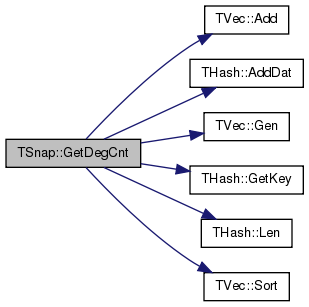
| double TSnap::GetDegreeCentr | ( | const PUNGraph & | Graph, |
| const int & | NId | ||
| ) |
Returns Degree centrality of a given node NId. Degree centrality if a node is defined as its degree/(N-1), where N is the number of nodes in the network.
| void TSnap::GetDegSeqV | ( | const PGraph & | Graph, |
| TIntV & | DegV | ||
| ) |
TODO ROK document GetDegSeqV()
Definition at line 230 of file alg.h.
References TVec< TVal >::Add(), and TVec< TVal >::Gen().
{
DegV.Gen(Graph->GetNodes(), 0);
for (typename PGraph::TObj::TNodeI NI = Graph->BegNI(); NI < Graph->EndNI(); NI++) {
DegV.Add(NI.GetDeg());
}
}

| void TSnap::GetDegSeqV | ( | const PGraph & | Graph, |
| TIntV & | InDegV, | ||
| TIntV & | OutDegV | ||
| ) |
TODO ROK document GetDegSeqV()
Definition at line 238 of file alg.h.
References TVec< TVal >::Add(), and TVec< TVal >::Gen().
{
InDegV.Gen(Graph->GetNodes(), 0);
OutDegV.Gen(Graph->GetNodes(), 0);
for (typename PGraph::TObj::TNodeI NI = Graph->BegNI(); NI < Graph->EndNI(); NI++) {
InDegV.Add(NI.GetInDeg());
OutDegV.Add(NI.GetOutDeg());
}
}

| PGraph TSnap::GetEDatSubGraph | ( | const PGraph & | Graph, |
| const TEdgeDat & | EDat, | ||
| const int & | Cmp | ||
| ) |
Returns a subgraph of graph Graph with edges where edge data matches the parameters.
EDat provides the value for edge data matching. Cmp determines the comparison function. Edges whose edge data matches EDat are included in the resulting subgraph as well as all the nodes which connect to at least one edge in the subgraph. Node IDs are preserved. Nodes in the resulting subgraph have the same node IDs as nodes in Graph.
Values of Cmp can be -1, 0, or +1. If Cmp is -1, edges with edge data less than EDat are included in the resulting subgraph. If Cmp equals 0, the values of edge data and EDat have to match. If Cmp is +1, edge data has to be greater than EDat.
Definition at line 242 of file subgraph.h.
References CAssert, gfEdgeDat, and HasGraphFlag.
{
CAssert(HasGraphFlag(typename PGraph::TObj, gfEdgeDat));
PGraph NewGraphPt = PGraph::TObj::New();
typename PGraph::TObj& NewGraph = *NewGraphPt;
for (typename PGraph::TObj::TEdgeI EI = Graph->BegEI(); EI < Graph->EndEI(); EI++) {
if ((Cmp==1 && EI()>EDat) || (Cmp==-1 && EI()<EDat) || (Cmp==0 && EI()==EDat)) {
if (! NewGraph.IsNode(EI.GetSrcNId())) {
NewGraph.AddNode(Graph->GetNI(EI.GetSrcNId()));
}
if (! NewGraph.IsNode(EI.GetDstNId())) {
NewGraph.AddNode(Graph->GetNI(EI.GetDstNId()));
}
NewGraph.AddEdge(EI);
}
}
return NewGraphPt;
}
| PGraph TSnap::GetEDatSubGraph | ( | const PGraph & | Graph, |
| const TIntV & | NIdV, | ||
| const TEdgeDat & | EDat, | ||
| const int & | Cmp | ||
| ) |
Returns a subgraph of graph Graph with NIdV nodes and edges where edge data matches the parameters.
The resulting subgraph contains all the nodes from Graph, which have node IDs in the NIdV vector and edges with both nodes in NIdV and whose edge data matches the parameters. Node IDs are preserved. Nodes in the resulting subgraph have the same node IDs as nodes in Graph.
EDat provides the value for edge data matching. Cmp determines the comparison function. Values of Cmp can be -1, 0, or +1. If Cmp is -1, edges with edge data less than EDat are included in the resulting subgraph. If Cmp equals 0, the values of edge data and EDat have to match. If Cmp is +1, edge data has to be greater than EDat.
Definition at line 262 of file subgraph.h.
References CAssert, gfEdgeDat, HasGraphFlag, and TVec< TVal >::Len().
{
CAssert(HasGraphFlag(typename PGraph::TObj, gfEdgeDat));
PGraph NewGraphPt = PGraph::TObj::New();
typename PGraph::TObj& NewGraph = *NewGraphPt;
NewGraph.Reserve(NIdV.Len(), -1);
for (int n = 0; n < NIdV.Len(); n++) {
NewGraph.AddNode(Graph->GetNI(NIdV[n]));
}
for (typename PGraph::TObj::TEdgeI EI = Graph->BegEI(); EI < Graph->EndEI(); EI++) {
if (NewGraph.IsNode(EI.GetSrcNId()) && NewGraph.IsNode(EI.GetDstNId()) &&
((Cmp==1 && EI()>EDat)|| (Cmp==-1 && EI()<EDat) || (Cmp==0 && EI()==EDat))) {
NewGraph.AddEdge(EI); }
}
NewGraph.Defrag();
return NewGraphPt;
}

| void TSnap::GetEdgeBridges | ( | const PUNGraph & | Graph, |
| TIntPrV & | EdgeV | ||
| ) |
Returns bridge edges of a Graph. Edge is a bridge if when removed increases the number of connected components. See http://en.wikipedia.org/wiki/Bridge_(graph_theory)
Definition at line 55 of file cncom.cpp.
References THashSet< TKey, THashFunc >::AddKey(), GetBiCon(), THashSet< TKey, THashFunc >::GetKeyV(), TVec< TVal >::Len(), TMath::Mn(), and TMath::Mx().
Referenced by Get1CnCom(), and Get1CnComSzCnt().
{
TCnComV BiCnComV;
GetBiCon(Graph, BiCnComV);
TIntPrSet EdgeSet;
for (int c = 0; c < BiCnComV.Len(); c++) {
const TIntV& NIdV = BiCnComV[c].NIdV;
if (NIdV.Len() == 2) {
EdgeSet.AddKey(TIntPr(TMath::Mn(NIdV[0], NIdV[1]), TMath::Mx(NIdV[0], NIdV[1])));
}
}
EdgeSet.GetKeyV(EdgeV);
}
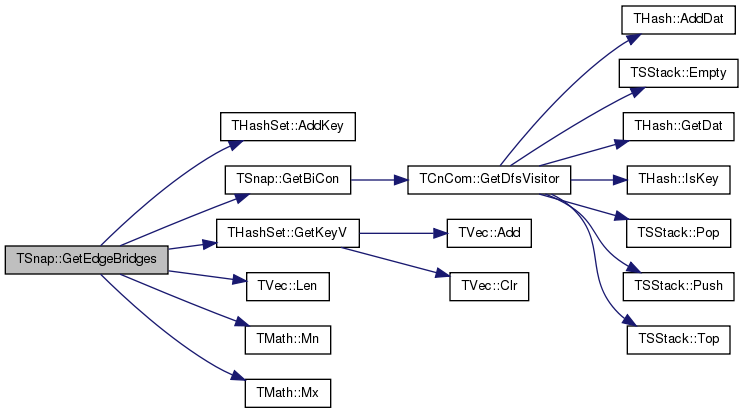

| void TSnap::GetEdgesInOut | ( | const PGraph & | Graph, |
| const TIntV & | NIdV, | ||
| int & | EdgesIn, | ||
| int & | EdgesOut | ||
| ) |
Returns the number of edges between the nodes NIdV and the edges pointing outside the set NIdV.
| EdgesIn | Number of edges between the nodes NIdV. |
| EdgesOut | Number of edges between the nodes in NIdV and the rest of the graph. |
Definition at line 62 of file cmty.h.
References THashSet< TKey, THashFunc >::AddKey(), and TVec< TVal >::Len().
Referenced by TLocClustStat::TCutInfo::TCutInfo().
{
EdgesIn=0;
EdgesOut=0;
TIntSet NIdSet(NIdV.Len());
for (int e = 0; e < NIdV.Len(); e++) {
NIdSet.AddKey(NIdV[e]); }
for (int e = 0; e < NIdV.Len(); e++) {
typename PGraph::TObj::TNodeI NI = Graph->GetNI(NIdV[e]);
for (int i = 0; i < NI.GetOutDeg(); i++) {
if (NIdSet.IsKey(NI.GetOutNId(i))) { EdgesIn += 1; }
else { EdgesOut += 1; }
}
}
EdgesIn /= 2;
}


| void TSnap::GetEigenVectorCentr | ( | const PUNGraph & | Graph, |
| TIntFltH & | NIdEigenH, | ||
| const double & | Eps = 1e-4, |
||
| const int & | MaxIter = 100 |
||
| ) |
Computes Eigenvector Centrality of all nodes in the network Eigenvector Centrality of a node N is defined recursively as the average of centrality values of N's neighbors in the network.
Definition at line 135 of file centr.cpp.
References THash< TKey, TDat, THashFunc >::AddDat(), THash< TKey, TDat, THashFunc >::Gen(), THash< TKey, TDat, THashFunc >::GetDat(), THash< TKey, TDat, THashFunc >::GetKey(), IAssert, THash< TKey, TDat, THashFunc >::Len(), TVec< TVal >::Len(), and TFlt::Mx.
{
const int NNodes = Graph->GetNodes();
NIdEigenH.Gen(NNodes);
for (TUNGraph::TNodeI NI = Graph->BegNI(); NI < Graph->EndNI(); NI++) {
NIdEigenH.AddDat(NI.GetId(), 1.0/NNodes);
IAssert(NI.GetId() == NIdEigenH.GetKey(NIdEigenH.Len()-1));
}
TFltV TmpV(NNodes);
double diff = TFlt::Mx;
for (int iter = 0; iter < MaxIter; iter++) {
int j = 0;
for (TUNGraph::TNodeI NI = Graph->BegNI(); NI < Graph->EndNI(); NI++, j++) {
TmpV[j] = 0;
for (int e = 0; e < NI.GetOutDeg(); e++) {
TmpV[j] += NIdEigenH.GetDat(NI.GetOutNId(e)); }
}
double sum = 0;
for (int i = 0; i < TmpV.Len(); i++) {
NIdEigenH[i] = TmpV[i];
sum += NIdEigenH[i];
}
for (int i = 0; i < NIdEigenH.Len(); i++) {
NIdEigenH[i] /= sum; }
if (fabs(diff-sum) < Eps) { break; }
//printf("\tdiff:%f\tsum:%f\n", fabs(diff-sum), sum);
diff = sum;
}
}
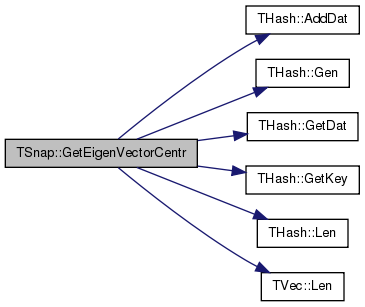
| void TSnap::GetEigVals | ( | const PUNGraph & | Graph, |
| const int & | EigVals, | ||
| TFltV & | EigValV | ||
| ) |
Computes top EigVals eigenvalues of the adjacency matrix representing a given undirected Graph.
Definition at line 308 of file gsvd.cpp.
References TSparseSVD::Lanczos(), TVec< TVal >::Len(), TSparseSVD::SimpleLanczos(), TVec< TVal >::Sort(), and ssotFull.
Referenced by PlotEigValDistr(), and PlotEigValRank().
{
// Lanczos
TUNGraphMtx GraphMtx(Graph);
//const int Nodes = Graph->GetNodes();
//int CalcVals = int(2*EigVals);
//if (CalcVals > Nodes) { CalcVals = Nodes; }
//while (EigValV.Len() < EigVals && CalcVals < 3*EigVals) {
try {
if (EigVals > 4) {
TSparseSVD::SimpleLanczos(GraphMtx, 2*EigVals, EigValV, false); }
else { TFltVV EigVecVV; // this is much more precise, but also much slower
TSparseSVD::Lanczos(GraphMtx, EigVals, 3*EigVals, ssotFull, EigValV, EigVecVV, false); }
}
catch(...) {
printf("\n ***EXCEPTION: TRIED %d GOT %d values** \n", 2*EigVals, EigValV.Len()); }
if (EigValV.Len() < EigVals) {
printf(" ***TRIED %d GOT %d values** \n", 2*EigVals, EigValV.Len()); }
// CalcVals += EigVals;
//}
EigValV.Sort(false);
/*if (EigValV.Len() > EigVals) {
EigValV.Del(EigVals, EigValV.Len()-1); }
else {
while (EigValV.Len() < EigVals) EigValV.Add(1e-6);
}
IAssert(EigValV.Len() == EigVals);*/
}
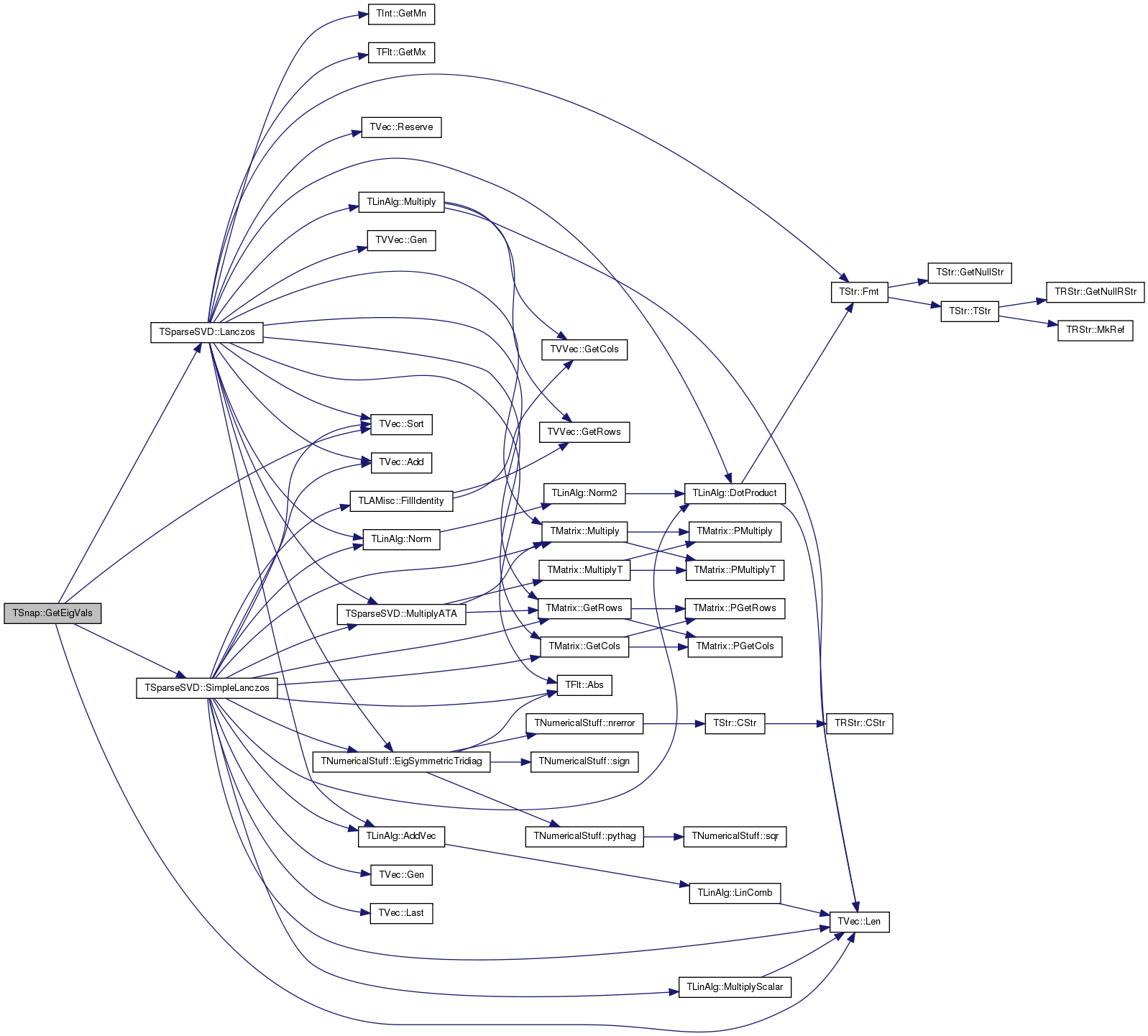

| void TSnap::GetEigVec | ( | const PUNGraph & | Graph, |
| TFltV & | EigVecV | ||
| ) |
Computes the leading eigenvector of the adjacency matrix representing a given undirected Graph.
Definition at line 336 of file gsvd.cpp.
References TVVec< TVal >::GetCol(), IsAllValVNeg(), TSparseSVD::Lanczos(), and ssotFull.
{
TUNGraphMtx GraphMtx(Graph);
TFltV EigValV;
TFltVV EigVecVV;
TSparseSVD::Lanczos(GraphMtx, 1, 8, ssotFull, EigValV, EigVecVV, false);
EigVecVV.GetCol(0, EigVecV); // vector components are not sorted!!!
IsAllValVNeg(EigVecV, true);
}
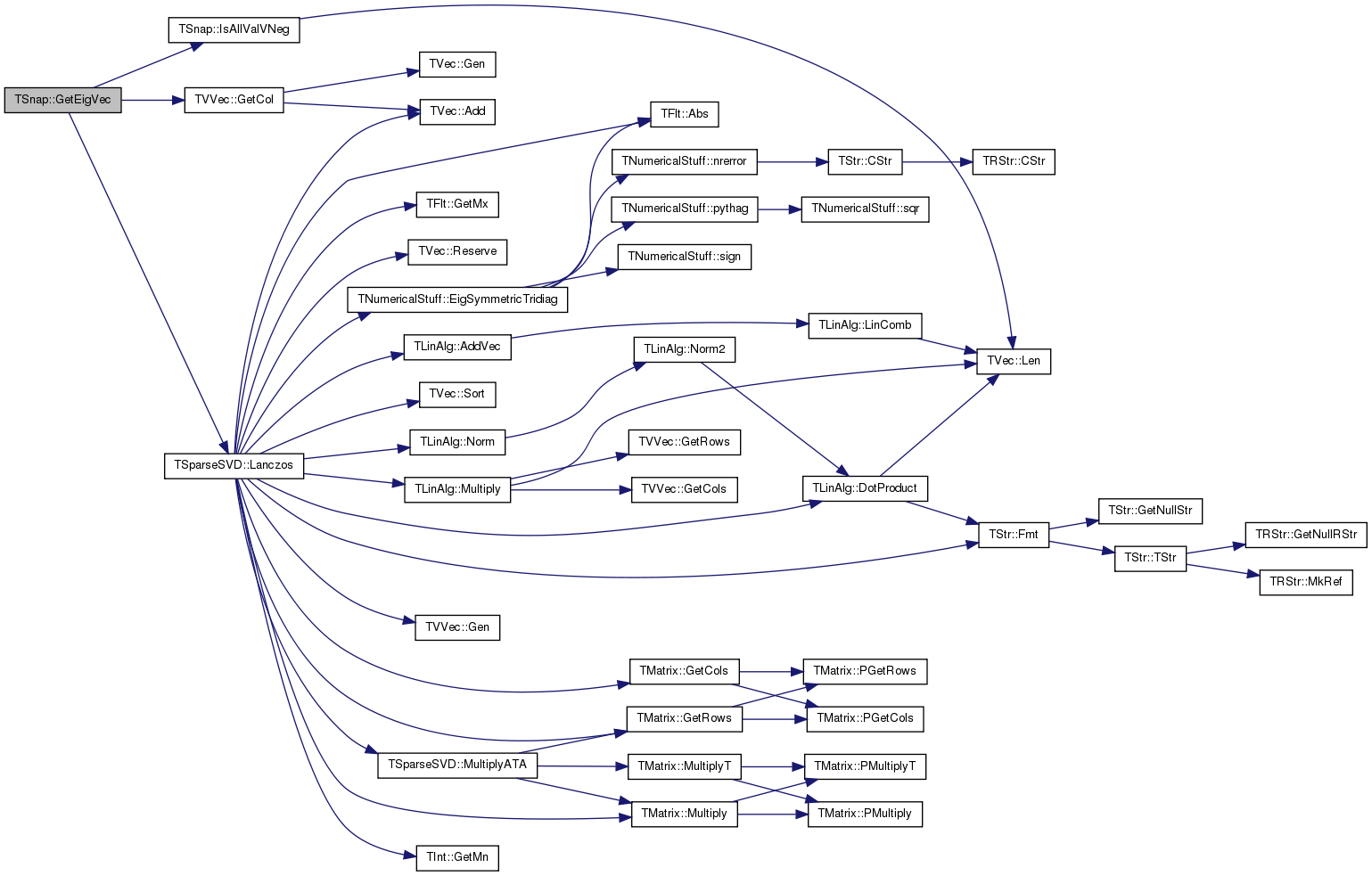
| void TSnap::GetEigVec | ( | const PUNGraph & | Graph, |
| const int & | EigVecs, | ||
| TFltV & | EigValV, | ||
| TVec< TFltV > & | EigVecV | ||
| ) |
Computes top EigVecs eigenvalues and eigenvectors of the adjacency matrix representing a given undirected Graph.
Definition at line 346 of file gsvd.cpp.
References TVec< TVal >::Add(), TVVec< TVal >::GetCol(), IsAllValVNeg(), TSparseSVD::Lanczos(), TVec< TVal >::Last(), TVec< TVal >::Len(), TVec< TVal >::Sort(), and ssotFull.
{
const int Nodes = Graph->GetNodes();
// Lanczos
TUNGraphMtx GraphMtx(Graph);
int CalcVals = int(2*EigVecs);
if (CalcVals > Nodes) { CalcVals = Nodes; }
TFltVV EigVecVV;
//while (EigValV.Len() < EigVecs && CalcVals < 10*EigVecs) {
try {
TSparseSVD::Lanczos(GraphMtx, EigVecs, 2*EigVecs, ssotFull, EigValV, EigVecVV, false); }
catch(...) {
printf("\n ***EXCEPTION: TRIED %d GOT %d values** \n", CalcVals, EigValV.Len()); }
if (EigValV.Len() < EigVecs) {
printf(" ***TRIED %d GOT %d values** \n", CalcVals, EigValV.Len()); }
// CalcVals += EigVecs;
//}
TFltIntPrV EigValIdV;
for (int i = 0; i < EigValV.Len(); i++) {
EigValIdV.Add(TFltIntPr(EigValV[i], i));
}
EigValIdV.Sort(false);
EigValV.Sort(false);
for (int v = 0; v < EigValIdV.Len(); v++) { // vector components are not sorted!!!
EigVecV.Add();
EigVecVV.GetCol(EigValIdV[v].Val2, EigVecV.Last());
}
IsAllValVNeg(EigVecV[0], true);
}
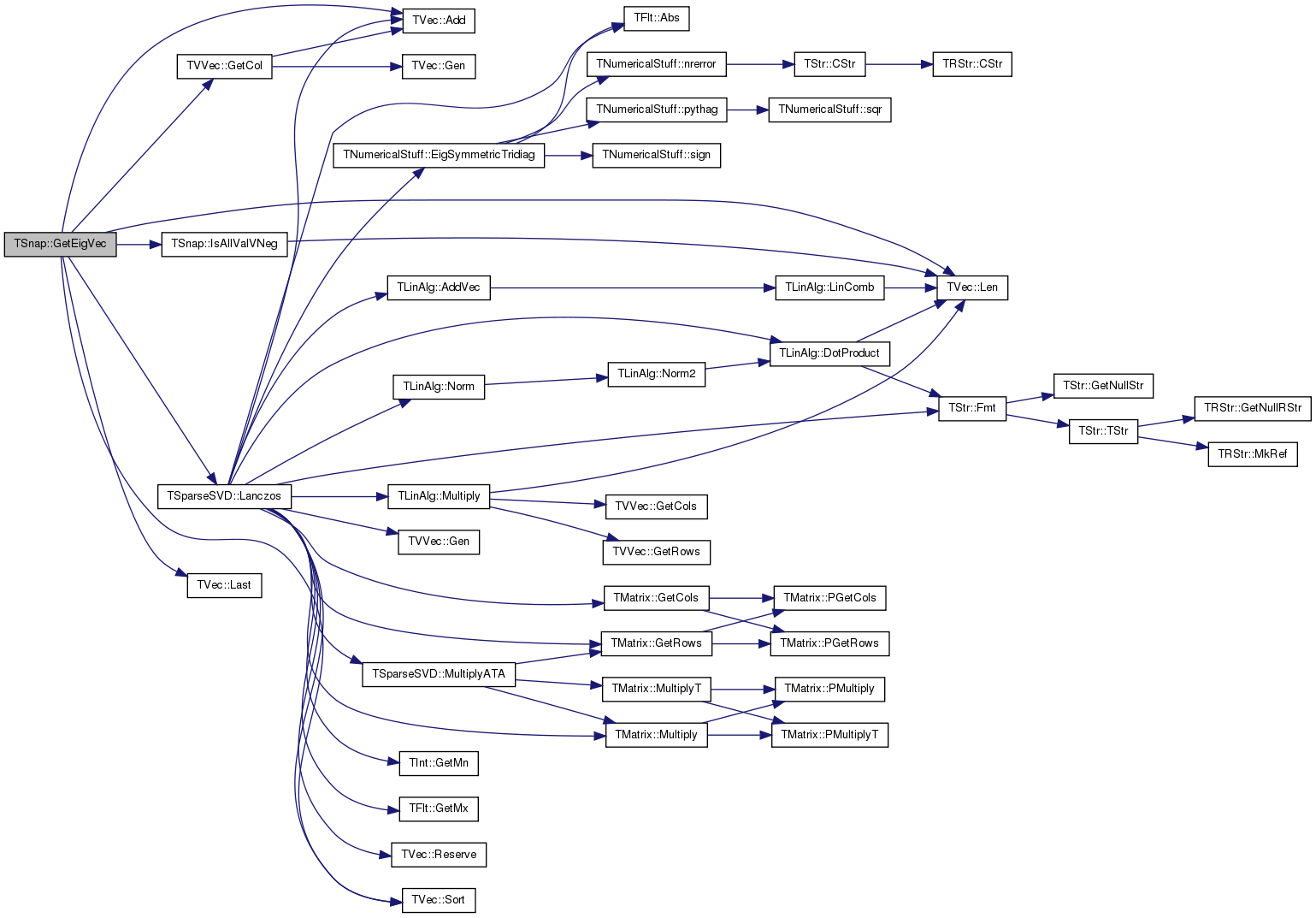
| PGraph TSnap::GetESubGraph | ( | const PGraph & | Graph, |
| const TIntV & | EIdV | ||
| ) |
Returns a subgraph of graph Graph with EIdV edges.
The resulting subgraph contains all the edges from Graph, which have edge IDs in the EIdV vector and all the nodes which connect to at least one edge in EIdV. Node and edge IDs are preserved. Nodes and edges in the resulting subgraph have the same IDs as in Graph.
Use this function for multi-graphs, where the edges have edge IDs.
Definition at line 200 of file subgraph.h.
References CAssert, gfMultiGraph, HasGraphFlag, IAssert, and TVec< TVal >::Len().
Referenced by GetRndESubGraph().
{
CAssert(HasGraphFlag(typename PGraph::TObj, gfMultiGraph));
PGraph NewGraphPt = PGraph::TObj::New();
typename PGraph::TObj& NewGraph = *NewGraphPt;
NewGraph.Reserve(-1, EIdV.Len());
for (int edge = 0; edge < EIdV.Len(); edge++) {
const int EId = EIdV[edge];
IAssert(Graph->IsEdge(EId));
const typename PGraph::TObj::TEdgeI EI = Graph->GetEI(EId);
if (! NewGraph.IsNode(EI.GetSrcNId())) {
NewGraph.AddNode(Graph->GetNI(EI.GetSrcNId()));
}
if (! NewGraph.IsNode(EI.GetDstNId())) {
NewGraph.AddNode(Graph->GetNI(EI.GetDstNId()));
}
NewGraph.AddEdge(EI);
}
return NewGraphPt;
}


| double TSnap::GetFarnessCentr | ( | const PUNGraph & | Graph, |
| const int & | NId | ||
| ) |
Returns Farness centrality of a given node NId. Farness centrality of a node is the average shortest path length to all other nodes that reside is the same connected component as the given node.
Definition at line 11 of file centr.cpp.
References THashKeyDatI< TKey, TDat >::EndI, and TInt::Mx.
Referenced by GetClosenessCentr().
{
TIntH NDistH(Graph->GetNodes());
TSnap::GetShortPath<PUNGraph>(Graph, NId, NDistH, true, TInt::Mx);
double sum = 0;
for (TIntH::TIter I = NDistH.BegI(); I < NDistH.EndI(); I++) {
sum += I->Dat();
}
if (NDistH.Len() > 1) { return sum/double(NDistH.Len()-1); }
else { return 0.0; }
}

| TStr TSnap::GetFlagStr | ( | const TGraphFlag & | GraphFlag | ) |
Returns a string representation of a flag.
Definition at line 5 of file gbase.cpp.
References FailR, gfBipart, gfDirected, gfEdgeDat, gfMultiGraph, gfNodeDat, gfSources, and gfUndef.
Referenced by TBigNet< TNodeData, IsDir >::DumpFlags(), and PrintInfo().
{
switch (GraphFlag) {
case gfUndef : return "Undef";
case gfDirected : return "Directed";
case gfMultiGraph : return "Multigraph";
case gfNodeDat : return "NodeDat";
case gfEdgeDat : return "EdgeDat";
case gfSources : return "Sources";
case gfBipart : return "Bipartite";
default: FailR("Unknown graph type");
};
return TStr();
}

| void TSnap::GetHits | ( | const PGraph & | Graph, |
| TIntFltH & | NIdHubH, | ||
| TIntFltH & | NIdAuthH, | ||
| const int & | MaxIter = 20 |
||
| ) |
HITS: Hubs and Authorities For more info see: http://en.wikipedia.org/wiki/HITS_algorithm)
Definition at line 111 of file centr.h.
References THash< TKey, TDat, THashFunc >::AddDat(), THash< TKey, TDat, THashFunc >::Gen(), THash< TKey, TDat, THashFunc >::GetDat(), and THash< TKey, TDat, THashFunc >::Len().
{
const int NNodes = Graph->GetNodes();
NIdHubH.Gen(NNodes);
NIdAuthH.Gen(NNodes);
for (typename PGraph::TObj::TNodeI NI = Graph->BegNI(); NI < Graph->EndNI(); NI++) {
NIdHubH.AddDat(NI.GetId(), 1.0);
NIdAuthH.AddDat(NI.GetId(), 1.0);
}
double Norm=0;
for (int iter = 0; iter < MaxIter; iter++) {
// update authority scores
Norm = 0;
for (typename PGraph::TObj::TNodeI NI = Graph->BegNI(); NI < Graph->EndNI(); NI++) {
double& Auth = NIdAuthH.GetDat(NI.GetId()).Val;
Auth = 0;
for (int e = 0; e < NI.GetInDeg(); e++) {
Auth += NIdHubH.GetDat(NI.GetInNId(e)); }
Norm += Auth*Auth;
}
Norm = sqrt(Norm);
for (int i = 0; i < NIdAuthH.Len(); i++) { NIdAuthH[i] /= Norm; }
// update hub scores
for (typename PGraph::TObj::TNodeI NI = Graph->BegNI(); NI < Graph->EndNI(); NI++) {
double& Hub = NIdHubH.GetDat(NI.GetId()).Val;
Hub = 0;
for (int e = 0; e < NI.GetOutDeg(); e++) {
Hub += NIdAuthH.GetDat(NI.GetOutNId(e)); }
Norm += Hub*Hub;
}
Norm = sqrt(Norm);
for (int i = 0; i < NIdHubH.Len(); i++) { NIdHubH[i] /= Norm; }
}
}
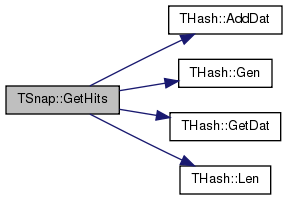
| void TSnap::GetInDegCnt | ( | const PGraph & | Graph, |
| TIntPrV & | DegToCntV | ||
| ) |
TODO ROK document GetInDegCnt()
Definition at line 164 of file alg.h.
References TVec< TVal >::Add(), THash< TKey, TDat, THashFunc >::AddDat(), TVec< TVal >::Gen(), THash< TKey, TDat, THashFunc >::GetKey(), THash< TKey, TDat, THashFunc >::Len(), and TVec< TVal >::Sort().
Referenced by PlotInDegDistr(), and TGStat::TakeDegDistr().
{
TIntH DegToCntH;
for (typename PGraph::TObj::TNodeI NI = Graph->BegNI(); NI < Graph->EndNI(); NI++) {
DegToCntH.AddDat(NI.GetInDeg())++; }
DegToCntV.Gen(DegToCntH.Len(), 0);
for (int i = 0; i < DegToCntH.Len(); i++) {
DegToCntV.Add(TIntPr(DegToCntH.GetKey(i), DegToCntH[i])); }
DegToCntV.Sort();
}
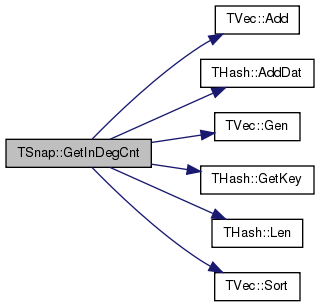

| void TSnap::GetInvParticipRat | ( | const PUNGraph & | Graph, |
| int | MaxEigVecs, | ||
| int | TimeLimit, | ||
| TFltPrV & | EigValIprV | ||
| ) |
Computes Inverse participation ratio of a given graph. See Spectra of "real-world" graphs: Beyond the semicircle law by Farkas, Derenyi, Barabasi and Vicsek
Definition at line 377 of file gsvd.cpp.
References TVec< TVal >::Add(), TVec< TVal >::Clr(), TVec< TVal >::Empty(), TVVec< TVal >::GetCol(), TVVec< TVal >::GetCols(), TSnap::TSnapDetail::GetInvParticipRat(), TExeTm::GetStr(), TSparseSVD::Lanczos2(), TVec< TVal >::Len(), TMath::Mn(), TVec< TVal >::Sort(), and ssotFull.
Referenced by PlotInvParticipRat().
{
TUNGraphMtx GraphMtx(Graph);
TFltVV EigVecVV;
TFltV EigValV;
TExeTm ExeTm;
if (MaxEigVecs<=1) { MaxEigVecs=1000; }
int EigVecs = TMath::Mn(Graph->GetNodes(), MaxEigVecs);
printf("start %d vecs...", EigVecs);
try {
TSparseSVD::Lanczos2(GraphMtx, EigVecs, TimeLimit, ssotFull, EigValV, EigVecVV, false);
} catch(...) {
printf("\n ***EXCEPTION: TRIED %d GOT %d values** \n", EigVecs, EigValV.Len()); }
printf(" ***TRIED %d GOT %d values in %s\n", EigVecs, EigValV.Len(), ExeTm.GetStr());
TFltV EigVec;
EigValIprV.Clr();
if (EigValV.Empty()) { return; }
for (int v = 0; v < EigVecVV.GetCols(); v++) {
EigVecVV.GetCol(v, EigVec);
EigValIprV.Add(TFltPr(EigValV[v], TSnapDetail::GetInvParticipRat(EigVec)));
}
EigValIprV.Sort();
}
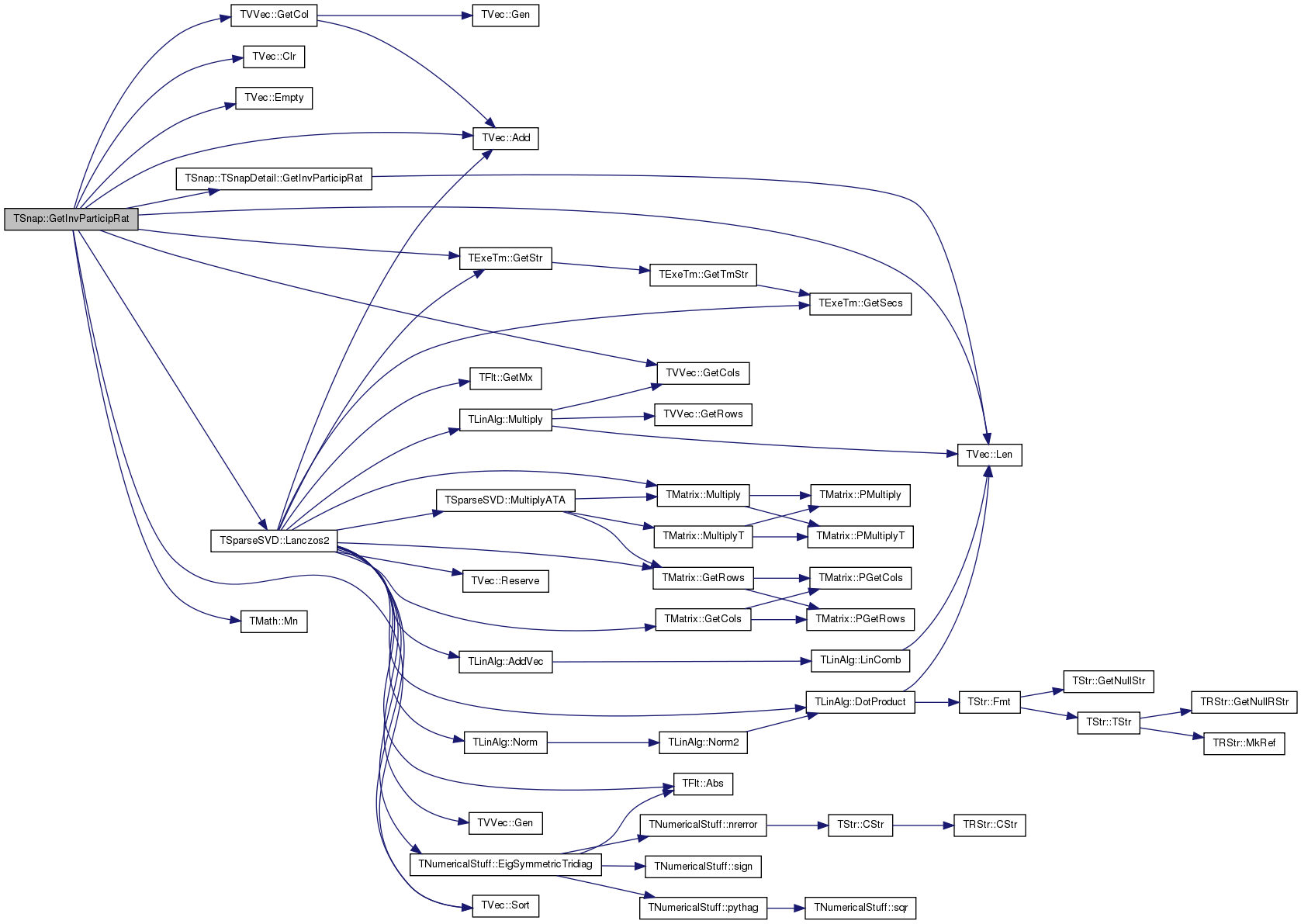

| PGraph TSnap::GetKCore | ( | const PGraph & | Graph, |
| const int & | K | ||
| ) |
Returns the K-core of a graph. If the core of order K does not exist the function returns an empty graph.
Definition at line 106 of file kcore.h.
References TKCore< PGraph >::GetCoreK(), TKCore< PGraph >::GetNIdV(), and GetSubGraph().
{
TKCore<PGraph> KCore(Graph);
KCore.GetCoreK(K);
return TSnap::GetSubGraph(Graph, KCore.GetNIdV());
}
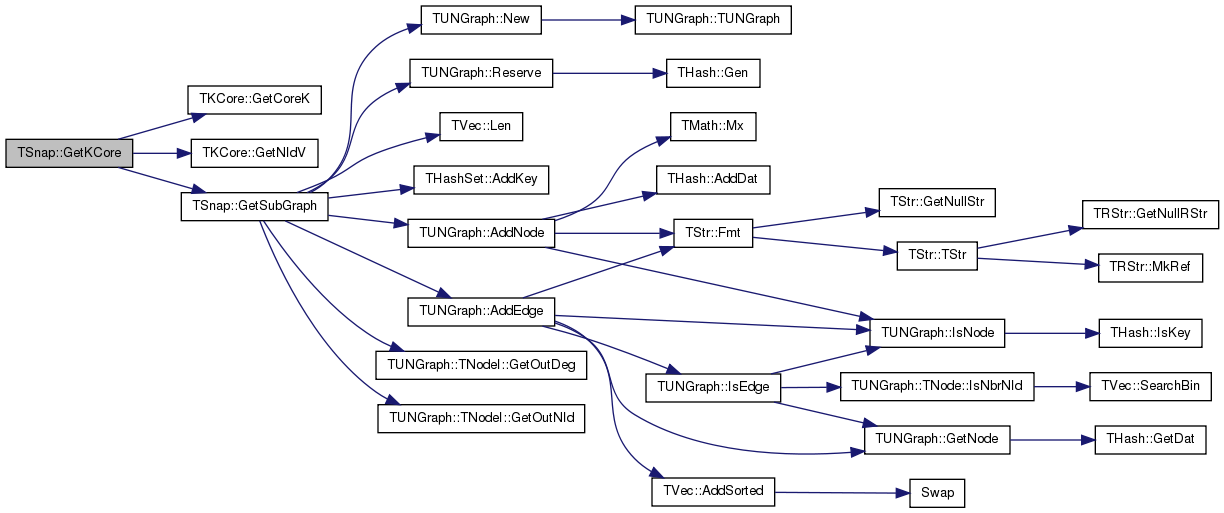
| int TSnap::GetLen2Paths | ( | const PGraph & | Graph, |
| const int & | NId1, | ||
| const int & | NId2 | ||
| ) |
Returns the number of length 2 directed paths between a pair of nodes NId1, NId2 (NId1 --> U --> NId2).
Definition at line 435 of file triad.h.
{
TIntV NbrV;
return GetLen2Paths(Graph, NId1, NId2, NbrV);
}
| int TSnap::GetLen2Paths | ( | const PGraph & | Graph, |
| const int & | NId1, | ||
| const int & | NId2, | ||
| TIntV & | NbrV | ||
| ) |
Returns the 2 directed paths between a pair of nodes NId1, NId2 (NId1 --> U --> NId2). NbrV intermediary stores nodes U.
Definition at line 443 of file triad.h.
References TVec< TVal >::Add(), TVec< TVal >::Clr(), TVec< TVal >::Len(), and TVec< TVal >::Reserve().
{
const typename PGraph::TNodeI NI = Graph->GetNI(NId1);
NbrV.Clr(false);
NbrV.Reserve(NI.GetOutDeg());
for (int e = 0; e < NI.GetOutDeg(); e++) {
const typename PGraph::TNodeI MidNI = GetNI(NI.GetOutNId(e));
if (MidNI.IsOutNId(NId2)) {
NbrV.Add(MidNI.GetId());
}
}
return NbrV.Len();
}
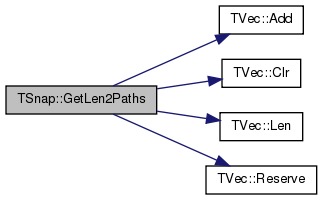
| double TSnap::GetModularity | ( | const PGraph & | G, |
| const TIntV & | NIdV, | ||
| int | GEdges = -1 |
||
| ) |
Computes Modularity score of a set of nodes NIdV in a graph G. The function runs much faster if the number of edges in graph G is given (GEdges parameter).
Computes Modularity score of a set of communities (each community is defined by its member nodes) in a graph G. The function runs much faster if the number of edges in graph G is given (GEdges parameter).
Definition at line 33 of file cmty.h.
References THashSet< TKey, THashFunc >::AddKey(), and TVec< TVal >::Len().
{
if (GEdges == -1) { GEdges = Graph->GetEdges(); }
double EdgesIn = 0.0, EEdgesIn = 0.0; // EdgesIn=2*number of edges inside the cluster, EEdgesIn=expected edges inside
TIntSet NIdSet(NIdV.Len());
for (int e = 0; e < NIdV.Len(); e++) { // edges inside
NIdSet.AddKey(NIdV[e]); }
for (int e1 = 0; e1 < NIdV.Len(); e1++) {
typename PGraph::TObj::TNodeI NI = Graph->GetNI(NIdV[e1]);
EEdgesIn += NI.GetOutDeg();
for (int i = 0; i < NI.GetOutDeg(); i++) {
if (NIdSet.IsKey(NI.GetOutNId(i))) { EdgesIn += 1; }
}
}
EEdgesIn = EEdgesIn*EEdgesIn/(2.0*GEdges);
if ((EdgesIn - EEdgesIn) == 0) { return 0; }
else { return (EdgesIn - EEdgesIn) / (2.0*GEdges); } // modularity
}

| PGraph TSnap::GetMxBiCon | ( | const PGraph & | Graph | ) |
Returns a graph representing the largest bi-connected component on an input Graph. An undirected graph is bi-connected if by removing any single node does not disconnect the graph. http://en.wikipedia.org/wiki/Biconnected_component
Definition at line 457 of file cncom.h.
References TVec< TVal >::Empty(), GetBiCon(), GetSubGraph(), and TVec< TVal >::Len().
{
TCnComV CnComV;
GetBiCon(TSnap::ConvertGraph<PUNGraph, PGraph>(Graph), CnComV);
if (CnComV.Empty()) { return PGraph::TObj::New(); }
int CcId = 0, MxSz = 0;
for (int i = 0; i < CnComV.Len(); i++) {
if (MxSz < CnComV[i].Len()) {
MxSz=CnComV[i].Len(); CcId=i; }
}
if (CnComV[CcId].Len()==Graph->GetNodes()) {
return Graph; }
else {
return TSnap::GetSubGraph(Graph, CnComV[CcId]());
}
}
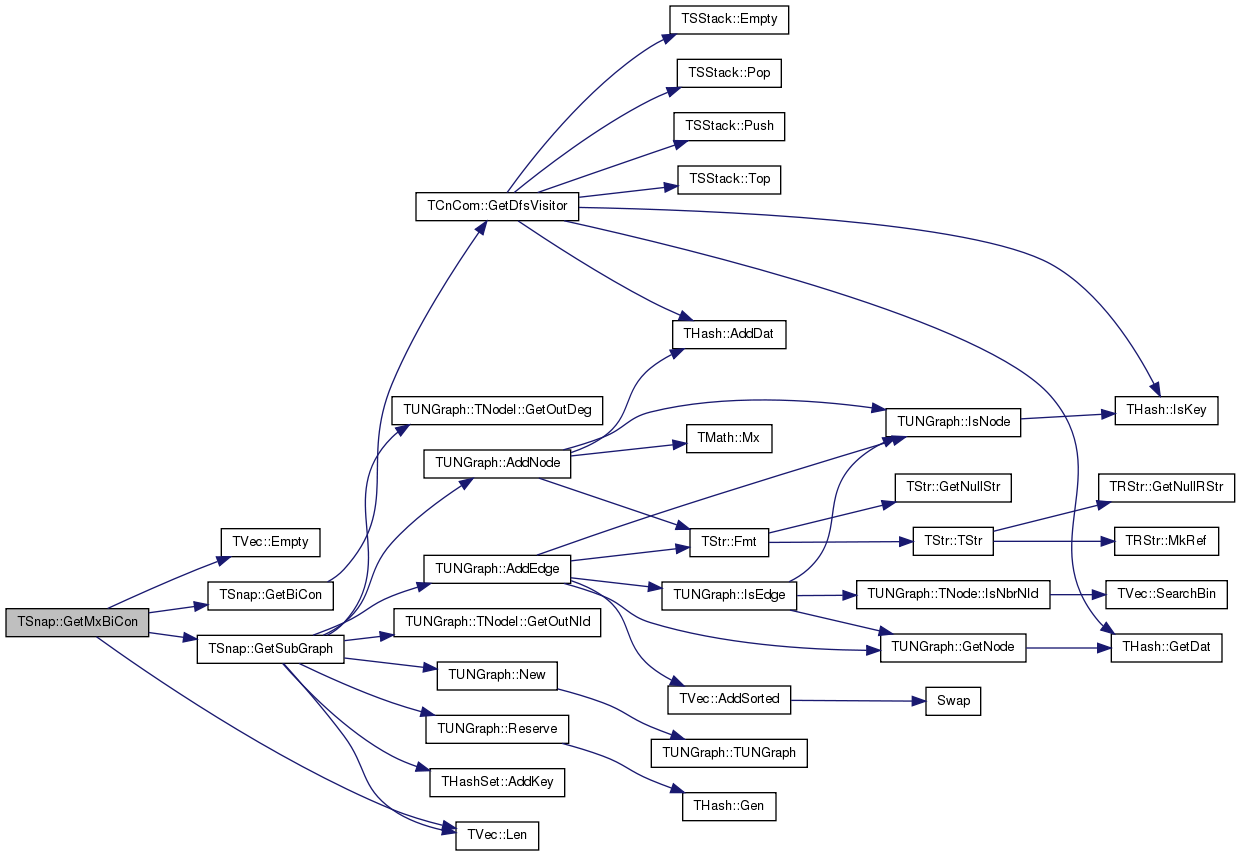
| PUNGraph TSnap::GetMxBiCon | ( | const PUNGraph & | Graph, |
| const bool & | RenumberNodes = false |
||
| ) |
Returns a graph representing the largest bi-connected component on an undirected Graph. An undirected graph is bi-connected if by removing any single node does not disconnect the graph. http://en.wikipedia.org/wiki/Biconnected_component
| RenumberNodes | if true, then node IDs of the returned graph will not match those of Graph, instead they will have a range 0...N-1. |
Definition at line 126 of file cncom.cpp.
References TVec< TVal >::Empty(), GetBiCon(), GetSubGraph(), and TVec< TVal >::Len().
{
TCnComV CnComV;
GetBiCon(Graph, CnComV);
if (CnComV.Empty()) {
return PUNGraph();
}
int CcId = 0, MxSz = 0;
for (int i = 0; i < CnComV.Len(); i++) {
if (MxSz < CnComV[i].Len()) {
MxSz = CnComV[i].Len();
CcId=i;
}
}
return TSnap::GetSubGraph(Graph, CnComV[CcId](), RenumberNodes);
}
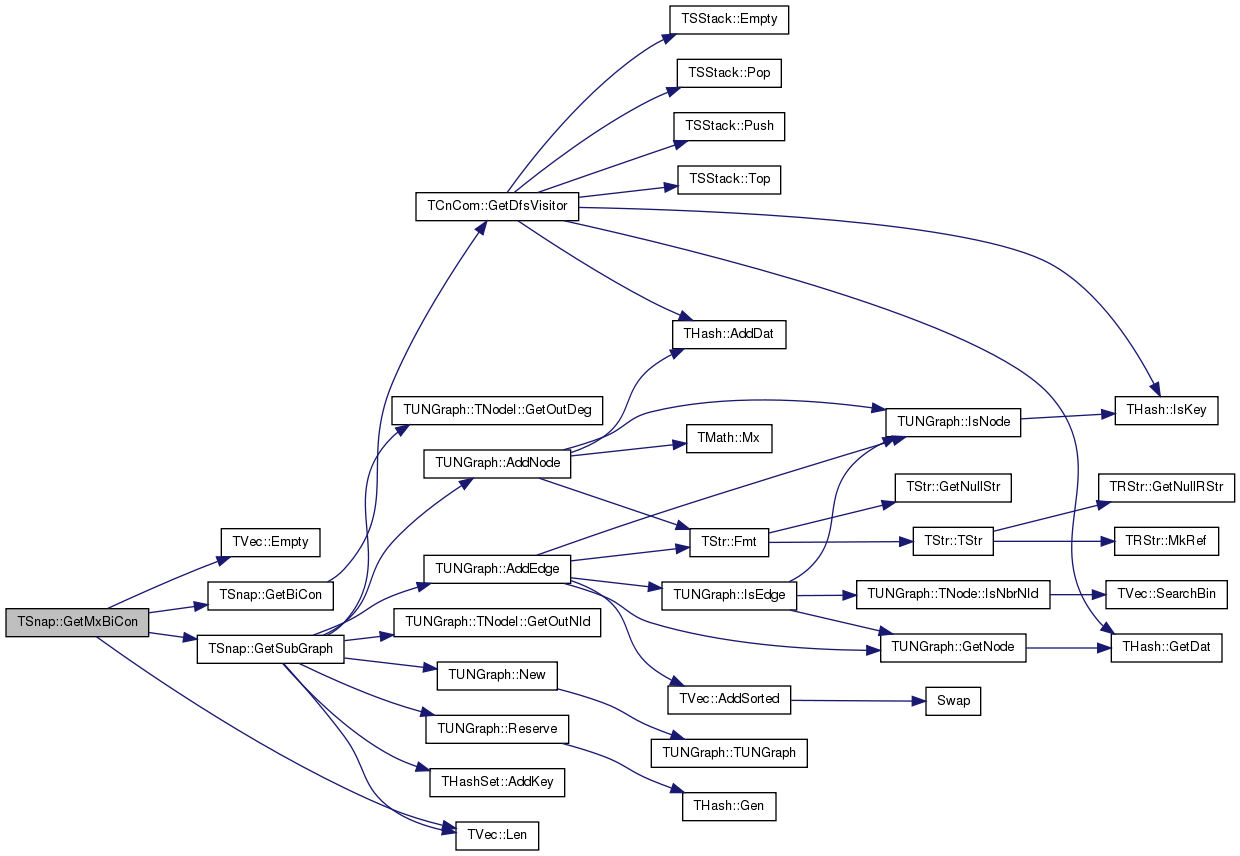
| int TSnap::GetMxDegNId | ( | const PGraph & | Graph | ) |
Returns a randomly chosen node from all the nodes with the maximum degree.
Definition at line 128 of file alg.h.
References TVec< TVal >::Add(), TVec< TVal >::Clr(), EAssertR, TVec< TVal >::Empty(), TRnd::GetUniDevInt(), TVec< TVal >::Len(), and TInt::Rnd.
{
TIntV MxDegV;
int MxDeg=-1;
for (typename PGraph::TObj::TNodeI NI = Graph->BegNI(); NI < Graph->EndNI(); NI++) {
if (MxDeg < NI.GetDeg()) { MxDegV.Clr(); MxDeg = NI.GetDeg(); }
if (MxDeg == NI.GetDeg()) { MxDegV.Add(NI.GetId()); }
}
EAssertR(! MxDegV.Empty(), "Input graph is empty!");
return MxDegV[TInt::Rnd.GetUniDevInt(MxDegV.Len())];
}
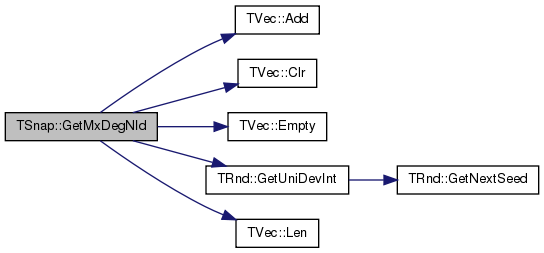
| int TSnap::GetMxInDegNId | ( | const PGraph & | Graph | ) |
Returns a randomly chosen node from all the nodes with the maximum in-degree.
Definition at line 140 of file alg.h.
References TVec< TVal >::Add(), TVec< TVal >::Clr(), EAssertR, TVec< TVal >::Empty(), TRnd::GetUniDevInt(), TVec< TVal >::Len(), and TInt::Rnd.
{
TIntV MxDegV;
int MxDeg=-1;
for (typename PGraph::TObj::TNodeI NI = Graph->BegNI(); NI < Graph->EndNI(); NI++) {
if (MxDeg < NI.GetInDeg()) { MxDegV.Clr(); MxDeg = NI.GetInDeg(); }
if (MxDeg == NI.GetInDeg()) { MxDegV.Add(NI.GetId()); }
}
EAssertR(! MxDegV.Empty(), "Input graph is empty!");
return MxDegV[TInt::Rnd.GetUniDevInt(MxDegV.Len())];
}
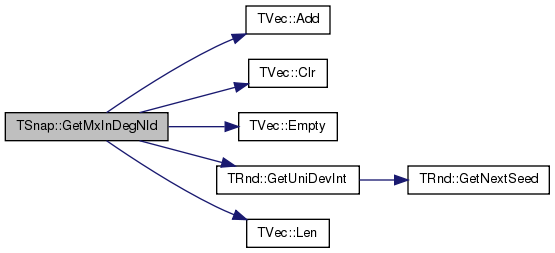
| int TSnap::GetMxOutDegNId | ( | const PGraph & | Graph | ) |
Returns a randomly chosen node from all the nodes with the maximum out-degree.
Definition at line 152 of file alg.h.
References TVec< TVal >::Add(), TVec< TVal >::Clr(), EAssertR, TVec< TVal >::Empty(), TRnd::GetUniDevInt(), TVec< TVal >::Len(), and TInt::Rnd.
{
TIntV MxDegV;
int MxDeg=-1;
for (typename PGraph::TObj::TNodeI NI = Graph->BegNI(); NI < Graph->EndNI(); NI++) {
if (MxDeg < NI.GetOutDeg()) { MxDegV.Clr(); MxDeg = NI.GetOutDeg(); }
if (MxDeg == NI.GetOutDeg()) { MxDegV.Add(NI.GetId()); }
}
EAssertR(! MxDegV.Empty(), "Input graph is empty!");
return MxDegV[TInt::Rnd.GetUniDevInt(MxDegV.Len())];
}
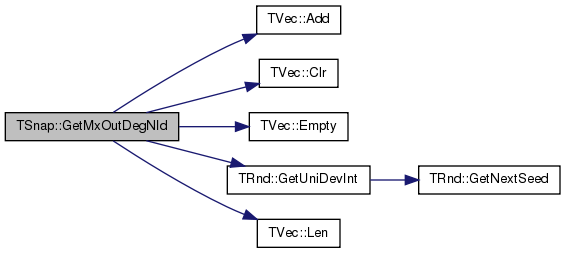
| PGraph TSnap::GetMxScc | ( | const PGraph & | Graph | ) |
Returns a graph representing the largest strongly connected component on an input Graph. A directed graph is strongly connected if there exists a directed path from any vertex to any other vertex in the graph. See http://en.wikipedia.org/wiki/Strongly_connected_component
Definition at line 440 of file cncom.h.
References TVec< TVal >::Empty(), GetSccs(), GetSubGraph(), and TVec< TVal >::Len().
{
TCnComV CnComV;
GetSccs(Graph, CnComV);
if (CnComV.Empty()) { return PGraph::TObj::New(); }
int CcId = 0, MxSz = 0;
for (int i = 0; i < CnComV.Len(); i++) {
if (MxSz < CnComV[i].Len()) {
MxSz=CnComV[i].Len(); CcId=i; }
}
if (CnComV[CcId].Len()==Graph->GetNodes()) {
return Graph; }
else {
return TSnap::GetSubGraph(Graph, CnComV[CcId]());
}
}
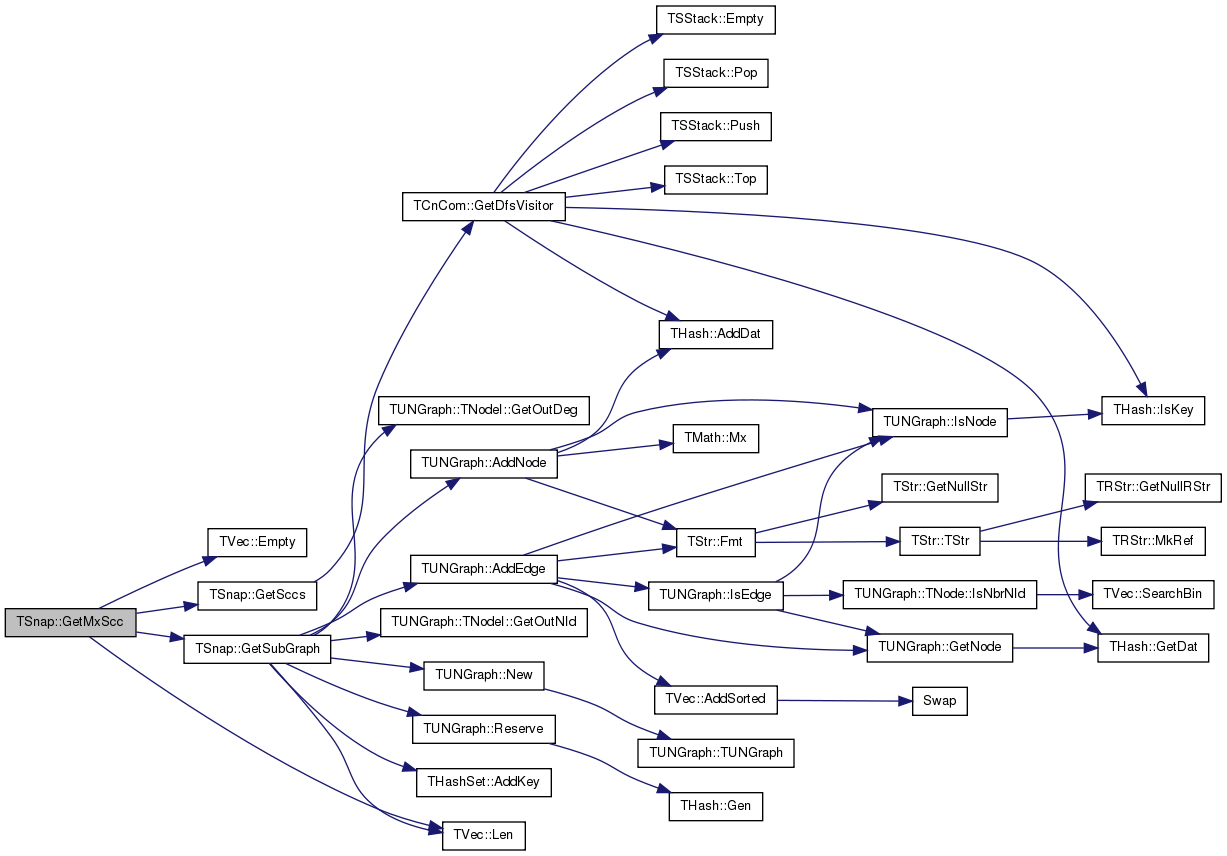
| PGraph TSnap::GetMxWcc | ( | const PGraph & | Graph | ) |
Returns a graph representing the largest weakly connected component on an input Graph. A directed/undirected graph is connected if there exist an undirected path between any pair of nodes. See http://en.wikipedia.org/wiki/Connected_component_(graph_theory)
Definition at line 423 of file cncom.h.
References TVec< TVal >::Empty(), GetSubGraph(), GetWccs(), and TVec< TVal >::Len().
Referenced by main(), TKronMtx::PlotCmpGraphs(), TTimeNet::PlotEffDiam(), TTimeNENet::PlotEffDiam(), TTimeNet::PlotMissingPast(), TLocClustStat::Run(), and TGStat::TakeStat().
{
TCnComV CnComV;
GetWccs(Graph, CnComV);
if (CnComV.Empty()) { return PGraph::TObj::New(); }
int CcId = 0, MxSz = 0;
for (int i = 0; i < CnComV.Len(); i++) {
if (MxSz < CnComV[i].Len()) {
MxSz=CnComV[i].Len(); CcId=i; }
}
if (CnComV[CcId].Len()==Graph->GetNodes()) {
return Graph; }
else {
return TSnap::GetSubGraph(Graph, CnComV[CcId]());
}
}
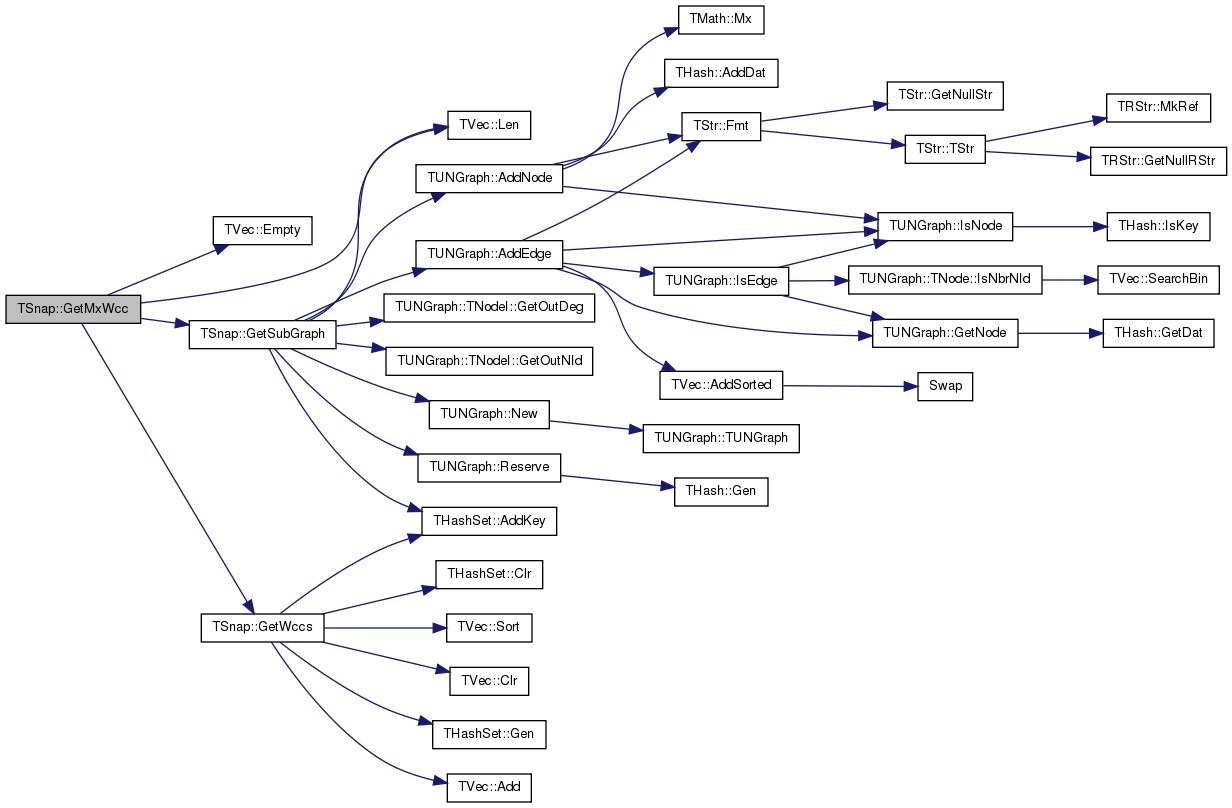
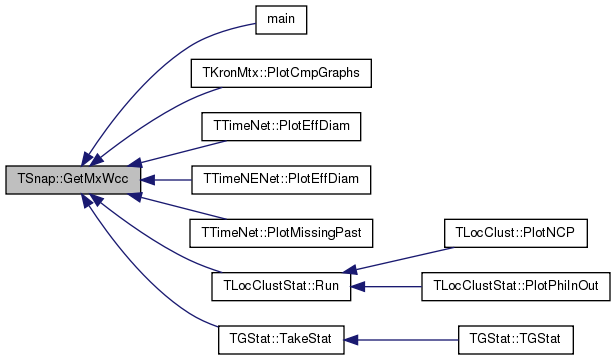
| double TSnap::GetMxWccSz | ( | const PGraph & | Graph | ) |
Returns the fraction of nodes in the largest weakly connected component of a Graph.
Definition at line 415 of file cncom.h.
References GetWccs(), and TVec< TVal >::Len().
{
TCnComV CnComV;
GetWccs(Graph, CnComV);
if (Graph->GetNodes() == 0) { return 0; }
else { return CnComV[0].Len() / double(Graph->GetNodes()); }
}
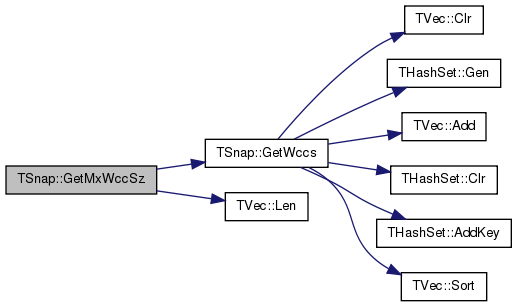
| double TSnap::GetNodeClustCf | ( | const PGraph & | Graph, |
| const int & | NId | ||
| ) |
Returns clustering coefficient of a particular node.
Definition at line 132 of file triad.h.
References GetNodeTriads().
{
int Open, Closed;
GetNodeTriads(Graph, NId, Open, Closed);
//const double Deg = Graph->GetNI(NId).GetDeg();
return (Open+Closed)==0 ? 0 : double(Open)/double(Open+Closed);
}

| void TSnap::GetNodeClustCf | ( | const PGraph & | Graph, |
| TIntFltH & | NIdCCfH | ||
| ) |
Computes clustering coefficient of each node of the Graph.
Definition at line 140 of file triad.h.
References THash< TKey, TDat, THashFunc >::AddDat(), THash< TKey, TDat, THashFunc >::Clr(), GetTriads(), and TVec< TVal >::Len().
{
TIntTrV NIdCOTriadV;
GetTriads(Graph, NIdCOTriadV);
NIdCCfH.Clr(false);
for (int i = 0; i < NIdCOTriadV.Len(); i++) {
const int D = NIdCOTriadV[i].Val2()+NIdCOTriadV[i].Val3();
const double CCf = D!=0 ? NIdCOTriadV[i].Val2() / double(D) : 0.0;
NIdCCfH.AddDat(NIdCOTriadV[i].Val1, CCf);
}
}
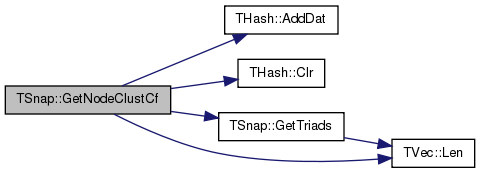
| int TSnap::GetNodeEcc | ( | const PGraph & | Graph, |
| const int & | NId, | ||
| const bool & | IsDir = false |
||
| ) |
Returns node Eccentricity, the largest shortest-path distance from the node NId to any other node in the Graph.
| IsDir | false: ignore edge directions and consider edges as undirected (in case they are directed). |
Definition at line 53 of file centr.h.
References TBreathFS< PGraph >::DoBfs(), THash< TKey, TDat, THashFunc >::Len(), TInt::Mx, and TBreathFS< PGraph >::NIdDistH.
{
int NodeEcc;
int Dist;
TBreathFS<PGraph> BFS(Graph);
// get shortest paths to all the nodes
BFS.DoBfs(NId, true, ! IsDir, -1, TInt::Mx);
NodeEcc = 0;
// find the largest value
for (int i = 0; i < BFS.NIdDistH.Len(); i++) {
Dist = BFS.NIdDistH[i];
if (Dist > NodeEcc) {
NodeEcc = Dist;
}
}
return NodeEcc;
}

| void TSnap::GetNodeInDegV | ( | const PGraph & | Graph, |
| TIntPrV & | NIdInDegV | ||
| ) |
Definition at line 248 of file alg.h.
References TVec< TVal >::Add(), and TVec< TVal >::Reserve().
{
NIdInDegV.Reserve(Graph->GetNodes(), 0);
for (typename PGraph::TObj::TNodeI NI = Graph->BegNI(); NI < Graph->EndNI(); NI++) {
NIdInDegV.Add(TIntPr(NI.GetId(), NI.GetInDeg()));
}
}

| void TSnap::GetNodeOutDegV | ( | const PGraph & | Graph, |
| TIntPrV & | NIdOutDegV | ||
| ) |
Definition at line 256 of file alg.h.
References TVec< TVal >::Add(), and TVec< TVal >::Reserve().
{
NIdOutDegV.Reserve(Graph->GetNodes(), 0);
for (typename PGraph::TObj::TNodeI NI = Graph->BegNI(); NI < Graph->EndNI(); NI++) {
NIdOutDegV.Add(TIntPr(NI.GetId(), NI.GetOutDeg()));
}
}

| int TSnap::GetNodesAtHop | ( | const PGraph & | Graph, |
| const int & | StartNId, | ||
| const int & | Hop, | ||
| TIntV & | NIdV, | ||
| const bool & | IsDir = false |
||
| ) |
Finds IDs of all nodes that are at distance Hop from node StartNId. false: ignore edge directions and consider edges/paths as undirected (in case they are directed).
Definition at line 220 of file bfsdfs.h.
References TVec< TVal >::Add(), TVec< TVal >::Clr(), TBreathFS< PGraph >::DoBfs(), THash< TKey, TDat, THashFunc >::GetKey(), THash< TKey, TDat, THashFunc >::Len(), TVec< TVal >::Len(), and TBreathFS< PGraph >::NIdDistH.
{
TBreathFS<PGraph> BFS(Graph);
BFS.DoBfs(StartNId, true, !IsDir, -1, Hop);
NIdV.Clr(false);
for (int i = 0; i < BFS.NIdDistH.Len(); i++) {
if (BFS.NIdDistH[i] == Hop) {
NIdV.Add(BFS.NIdDistH.GetKey(i)); }
}
return NIdV.Len();
}
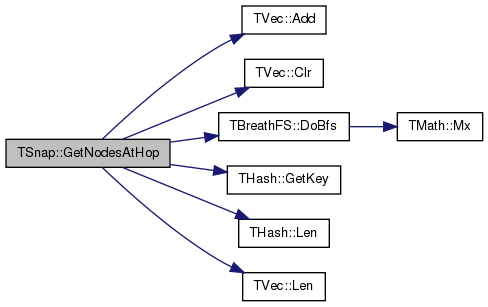
| int TSnap::GetNodesAtHops | ( | const PGraph & | Graph, |
| const int & | StartNId, | ||
| TIntPrV & | HopCntV, | ||
| const bool & | IsDir = false |
||
| ) |
Returns the number of nodes at each hop distance from the starting node StartNId. false: ignore edge directions and consider edges/paths as undirected (in case they are directed).
Definition at line 232 of file bfsdfs.h.
References THash< TKey, TDat, THashFunc >::AddDat(), TBreathFS< PGraph >::DoBfs(), THash< TKey, TDat, THashFunc >::GetKeyDatPrV(), THash< TKey, TDat, THashFunc >::Len(), TVec< TVal >::Len(), TInt::Mx, TBreathFS< PGraph >::NIdDistH, and TVec< TVal >::Sort().
{
TBreathFS<PGraph> BFS(Graph);
BFS.DoBfs(StartNId, true, !IsDir, -1, TInt::Mx);
TIntH HopCntH;
for (int i = 0; i < BFS.NIdDistH.Len(); i++) {
HopCntH.AddDat(BFS.NIdDistH[i]) += 1;
}
HopCntH.GetKeyDatPrV(HopCntV);
HopCntV.Sort();
return HopCntV.Len();
}
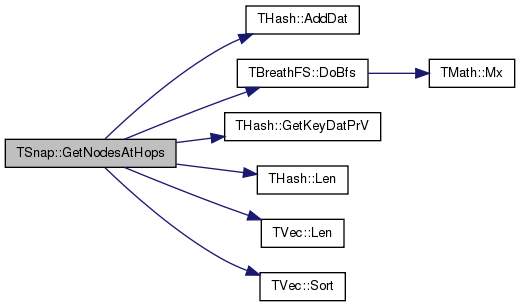
| int TSnap::GetNodeTriads | ( | const PGraph & | Graph, |
| const int & | NId | ||
| ) |
Returns number of undirected triads a node NId participates in.
Definition at line 259 of file triad.h.
Referenced by GetNodeClustCf(), and GetTriadParticip().
{
int ClosedTriads=0, OpenTriads=0;
return GetNodeTriads(Graph, NId, ClosedTriads, OpenTriads);
}

| int TSnap::GetNodeTriads | ( | const PGraph & | Graph, |
| const int & | NId, | ||
| int & | ClosedTriads, | ||
| int & | OpenTriads | ||
| ) |
Returns number of undirected Open and Closed triads a node NId participates in.
Definition at line 266 of file triad.h.
References THashSet< TKey, THashFunc >::AddKey(), and gfDirected.
{
const typename PGraph::TObj::TNodeI NI = Graph->GetNI(NId);
ClosedTriads=0; OpenTriads=0;
if (NI.GetDeg() < 2) { return 0; }
// find neighborhood
TIntSet NbrSet(NI.GetDeg());
for (int e = 0; e < NI.GetOutDeg(); e++) {
if (NI.GetOutNId(e) != NI.GetId()) { // exclude self edges
NbrSet.AddKey(NI.GetOutNId(e)); }
}
if (Graph->HasFlag(gfDirected)) {
for (int e = 0; e < NI.GetInDeg(); e++) {
if (NI.GetInNId(e) != NI.GetId()) { // exclude self edges
NbrSet.AddKey(NI.GetInNId(e)); }
}
}
// count connected neighbors
for (int srcNbr = 0; srcNbr < NbrSet.Len(); srcNbr++) {
const typename PGraph::TObj::TNodeI SrcNode = Graph->GetNI(NbrSet.GetKey(srcNbr));
for (int dstNbr = srcNbr+1; dstNbr < NbrSet.Len(); dstNbr++) {
const int dstNId = NbrSet.GetKey(dstNbr);
if (SrcNode.IsNbrNId(dstNId)) { ClosedTriads++; }
else { OpenTriads++; }
}
}
return ClosedTriads;
}

| int TSnap::GetNodeTriads | ( | const PUNGraph & | Graph, |
| const int & | NId, | ||
| const TIntSet & | GroupSet, | ||
| int & | InGroupEdges, | ||
| int & | InOutGroupEdges | ||
| ) |
Returns the number of triads between a node NId and a subset of its neighbors GroupSet.
| InGroupEdges | Number of triads triads (NId, g1, g2), where g1 and g2 are in GroupSet |
| InOutGroupEdges | Number of triads (NId, g1, o1), where g1 in GroupSet and o1 not in GroupSet |
| int TSnap::GetNodeTriads | ( | const PUNGraph & | Graph, |
| const int & | NId, | ||
| const TIntSet & | GroupSet, | ||
| int & | InGroupEdges, | ||
| int & | InOutGroupEdges, | ||
| int & | OutGroup | ||
| ) |
Returns the number of triads between a node NId and a subset of its neighbors GroupSet.
| InGroupEdges | Number of triads (NId, g1, g2), where g1 and g2 are in GroupSet |
| InOutGroupEdges | Number of triads (NId, g1, o1), where g1 in GroupSet and o1 not in GroupSet |
| OutGroupEdges | Number of triads (NId, o1, o2), where o1 and o2 are not in GroupSet |
| int TSnap::GetNodeTriads | ( | const PGraph & | Graph, |
| const int & | NId, | ||
| const TIntSet & | GroupSet, | ||
| int & | InGroupEdges, | ||
| int & | InOutGroupEdges | ||
| ) |
Definition at line 298 of file triad.h.
References THashSet< TKey, THashFunc >::AddKey(), THashSet< TKey, THashFunc >::Empty(), THashSet< TKey, THashFunc >::GetKey(), gfDirected, IAssert, THashSet< TKey, THashFunc >::IsKey(), and THashSet< TKey, THashFunc >::Len().
{
const typename PGraph::TObj::TNodeI NI = Graph->GetNI(NId);
const bool IsDir = Graph->HasFlag(gfDirected);
InGroupEdges=0; InOutGroupEdges=0;
if (NI.GetDeg() < 2 || GroupSet.Empty()) { return 0; }
// find neighborhood
TIntSet NbrSet(NI.GetDeg());
for (int e = 0; e < NI.GetOutDeg(); e++) {
if (NI.GetOutNId(e) != NI.GetId()) { // exclude self edges
NbrSet.AddKey(NI.GetOutNId(e)); }
}
if (IsDir) {
for (int e = 0; e < NI.GetInDeg(); e++) {
if (NI.GetInNId(e) != NI.GetId()) {
NbrSet.AddKey(NI.GetInNId(e)); }
}
}
// count connected neighbors
for (int srcGrp = 0; srcGrp < GroupSet.Len(); srcGrp++) {
IAssert(NbrSet.IsKey(GroupSet[srcGrp]));
const typename PGraph::TObj::TNodeI SrcNode = Graph->GetNI(GroupSet.GetKey(srcGrp));
for (int i = 0; i < SrcNode.GetOutDeg(); i++) {
const int dst = SrcNode.GetOutNId(i);
if (! NbrSet.IsKey(dst)) { continue; } // not triangle
if (GroupSet.IsKey(dst)) { InGroupEdges++; }
else { InOutGroupEdges++; }
}
}
return InGroupEdges;
}
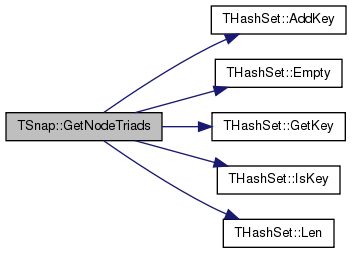
| int TSnap::GetNodeTriads | ( | const PGraph & | Graph, |
| const int & | NId, | ||
| const TIntSet & | GroupSet, | ||
| int & | InGroupEdges, | ||
| int & | InOutGroupEdges, | ||
| int & | OutGroupEdges | ||
| ) |
Definition at line 334 of file triad.h.
References THashSet< TKey, THashFunc >::AddKey(), THashSet< TKey, THashFunc >::Empty(), gfDirected, and THashSet< TKey, THashFunc >::IsKey().
{
const typename PGraph::TObj::TNodeI NI = Graph->GetNI(NId);
const bool IsDir = Graph->HasFlag(gfDirected);
InGroupEdges=0; InOutGroupEdges=0; OutGroupEdges=0;
if (NI.GetDeg() < 2 || GroupSet.Empty()) { return 0; }
// find neighborhood
TIntSet NbrSet(NI.GetDeg());
for (int e = 0; e < NI.GetOutDeg(); e++) {
if (NI.GetOutNId(e) != NI.GetId()) { // exclude self edges
NbrSet.AddKey(NI.GetOutNId(e)); }
}
if (IsDir) {
for (int e = 0; e < NI.GetInDeg(); e++) {
if (NI.GetInNId(e) != NI.GetId()) {
NbrSet.AddKey(NI.GetInNId(e)); }
}
}
// count connected neighbors
for (int srcNbr = 0; srcNbr < NbrSet.Len(); srcNbr++) {
const int NbrId = NbrSet.GetKey(srcNbr);
const bool NbrIn = GroupSet.IsKey(NbrId);
const typename PGraph::TObj::TNodeI SrcNode = Graph->GetNI(NbrId);
for (int dstNbr = srcNbr+1; dstNbr < NbrSet.Len(); dstNbr++) {
const int DstNId = NbrSet.GetKey(dstNbr);
if (SrcNode.IsNbrNId(DstNId)) { // triad (NId, NbrId, DstNid)
bool DstIn = GroupSet.IsKey(DstNId);
if (NbrIn && DstIn) { InGroupEdges++; }
else if (NbrIn || DstIn) { InOutGroupEdges++; }
else { OutGroupEdges++; }
}
}
}
return InGroupEdges;
}
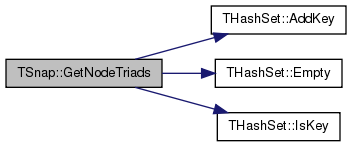
| void TSnap::GetNodeWcc | ( | const PGraph & | Graph, |
| const int & | NId, | ||
| TIntV & | CnCom | ||
| ) |
Returns (via output parameter CnCom) all nodes that are in the same connected component as node NId.
Definition at line 260 of file cncom.h.
References TVec< TVal >::Add(), TVec< TVal >::Gen(), gfDirected, HasGraphFlag, and TSnapQueue< TVal >::Push().
Referenced by TSnap::TSnapDetail::CmtyGirvanNewmanStep().
{
typename PGraph::TObj::TNodeI NI;
THashSet<TInt> VisitedNId(Graph->GetNodes()+1);
TSnapQueue<int> NIdQ(Graph->GetNodes()+1);
VisitedNId.AddKey(NId);
NIdQ.Push(NId);
while (! NIdQ.Empty()) {
const typename PGraph::TObj::TNodeI Node = Graph->GetNI(NIdQ.Top()); NIdQ.Pop();
if (HasGraphFlag(typename PGraph::TObj, gfDirected)) {
for (int e = 0; e < Node.GetInDeg(); e++) {
const int InNId = Node.GetInNId(e);
if (! VisitedNId.IsKey(InNId)) {
NIdQ.Push(InNId); VisitedNId.AddKey(InNId); }
}
}
for (int e = 0; e < Node.GetOutDeg(); e++) {
const int OutNId = Node.GetOutNId(e);
if (! VisitedNId.IsKey(OutNId)) {
NIdQ.Push(OutNId); VisitedNId.AddKey(OutNId); }
}
}
CnCom.Gen(VisitedNId.Len(), 0);
for (int i = 0; i < VisitedNId.Len(); i++) {
CnCom.Add(VisitedNId.GetKey(i));
}
}
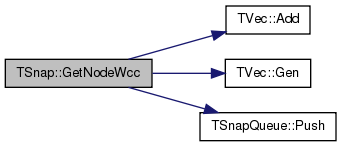

| void TSnap::GetOutDegCnt | ( | const PGraph & | Graph, |
| TIntPrV & | DegToCntV | ||
| ) |
TODO ROK document GetOutDegCnt()
Definition at line 186 of file alg.h.
References TVec< TVal >::Add(), THash< TKey, TDat, THashFunc >::AddDat(), TVec< TVal >::Gen(), THash< TKey, TDat, THashFunc >::GetKey(), THash< TKey, TDat, THashFunc >::Len(), and TVec< TVal >::Sort().
Referenced by PlotOutDegDistr(), and TGStat::TakeDegDistr().
{
TIntH DegToCntH;
for (typename PGraph::TObj::TNodeI NI = Graph->BegNI(); NI < Graph->EndNI(); NI++) {
DegToCntH.AddDat(NI.GetOutDeg())++; }
DegToCntV.Gen(DegToCntH.Len(), 0);
for (int i = 0; i < DegToCntH.Len(); i++) {
DegToCntV.Add(TIntPr(DegToCntH.GetKey(i), DegToCntH[i])); }
DegToCntV.Sort();
}
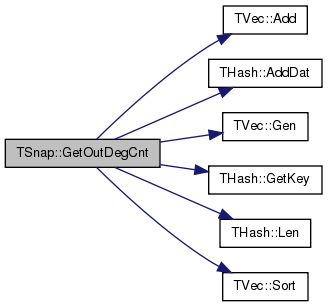

| void TSnap::GetPageRank | ( | const PGraph & | Graph, |
| TIntFltH & | PRankH, | ||
| const double & | C = 0.85, |
||
| const double & | Eps = 1e-4, |
||
| const int & | MaxIter = 100 |
||
| ) |
PageRank For more info see: http://en.wikipedia.org/wiki/PageRank
Definition at line 75 of file centr.h.
References THash< TKey, TDat, THashFunc >::AddDat(), THash< TKey, TDat, THashFunc >::Gen(), THash< TKey, TDat, THashFunc >::GetDat(), THash< TKey, TDat, THashFunc >::Len(), and TVec< TVal >::Len().
{
const int NNodes = Graph->GetNodes();
//const double OneOver = 1.0/double(NNodes);
PRankH.Gen(NNodes);
for (typename PGraph::TObj::TNodeI NI = Graph->BegNI(); NI < Graph->EndNI(); NI++) {
PRankH.AddDat(NI.GetId(), 1.0/NNodes);
//IAssert(NI.GetId() == PRankH.GetKey(PRankH.Len()-1));
}
TFltV TmpV(NNodes);
for (int iter = 0; iter < MaxIter; iter++) {
int j = 0;
for (typename PGraph::TObj::TNodeI NI = Graph->BegNI(); NI < Graph->EndNI(); NI++, j++) {
TmpV[j] = 0;
for (int e = 0; e < NI.GetInDeg(); e++) {
const int InNId = NI.GetInNId(e);
const int OutDeg = Graph->GetNI(InNId).GetOutDeg();
if (OutDeg > 0) {
TmpV[j] += PRankH.GetDat(InNId) / OutDeg; }
}
TmpV[j] = C*TmpV[j]; // Berkhin (the correct way of doing it)
//TmpV[j] = C*TmpV[j] + (1.0-C)*OneOver; // iGraph
}
double diff=0, sum=0, NewVal;
for (int i = 0; i < TmpV.Len(); i++) { sum += TmpV[i]; }
const double Leaked = (1.0-sum) / double(NNodes);
for (int i = 0; i < PRankH.Len(); i++) { // re-instert leaked PageRank
NewVal = TmpV[i] + Leaked; // Berkhin
//NewVal = TmpV[i] / sum; // iGraph
diff += fabs(NewVal-PRankH[i]);
PRankH[i] = NewVal;
}
if (diff < Eps) { break; }
}
}
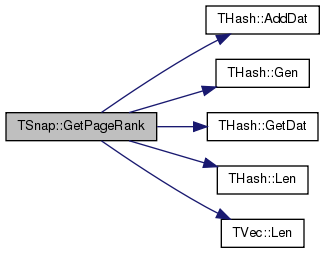
| PGraph TSnap::GetRndESubGraph | ( | const PGraph & | Graph, |
| const int & | NEdges | ||
| ) |
Returns a random subgraph of graph Graph with NEdges edges.
Randomly selects NEdges edges from the input graph and returns a subgraph on those edges.
Definition at line 446 of file subgraph.h.
References TVec< TVal >::Add(), CAssert, TVec< TVal >::Del(), GetESubGraph(), gfMultiGraph, HasGraphFlag, IAssert, TVec< TVal >::Len(), TInt::Rnd, and TVec< TVal >::Shuffle().
{
CAssert(! HasGraphFlag(typename PGraph::TObj, gfMultiGraph));
TIntPrV EdgeV(Graph->GetEdges(), 0);
for (typename PGraph::TObj::TEdgeI EI = Graph->BegEI(); EI < Graph->EndEI(); EI++) {
EdgeV.Add(TIntPr(EI.GetSrcNId(), EI.GetDstNId()));
}
EdgeV.Shuffle(TInt::Rnd);
EdgeV.Del(NEdges, EdgeV.Len()-1);
IAssert(EdgeV.Len() == NEdges);
return GetESubGraph(Graph, EdgeV);
}
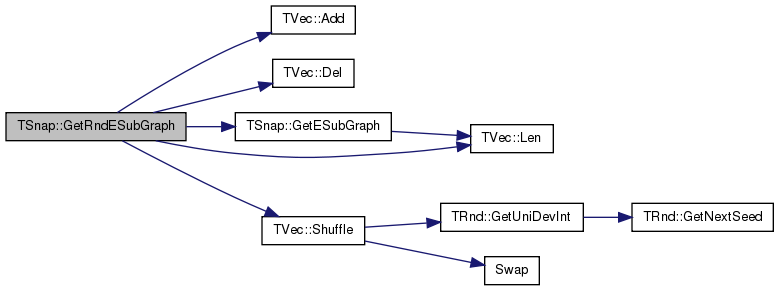
| PGraph TSnap::GetRndSubGraph | ( | const PGraph & | Graph, |
| const int & | NNodes | ||
| ) |
Returns an induced random subgraph of graph Graph with NNodes nodes.
Randomly selects NNodes nodes from the input graph and returns an induced graph on those nodes.
Definition at line 435 of file subgraph.h.
References TVec< TVal >::Del(), GetSubGraph(), IAssert, TVec< TVal >::Len(), TInt::Rnd, and TVec< TVal >::Shuffle().
{
IAssert(NNodes <= Graph->GetNodes());
TIntV NIdV;
Graph->GetNIdV(NIdV);
NIdV.Shuffle(TInt::Rnd);
NIdV.Del(NNodes, NIdV.Len()-1);
IAssert(NIdV.Len() == NNodes);
return GetSubGraph(Graph, NIdV);
}
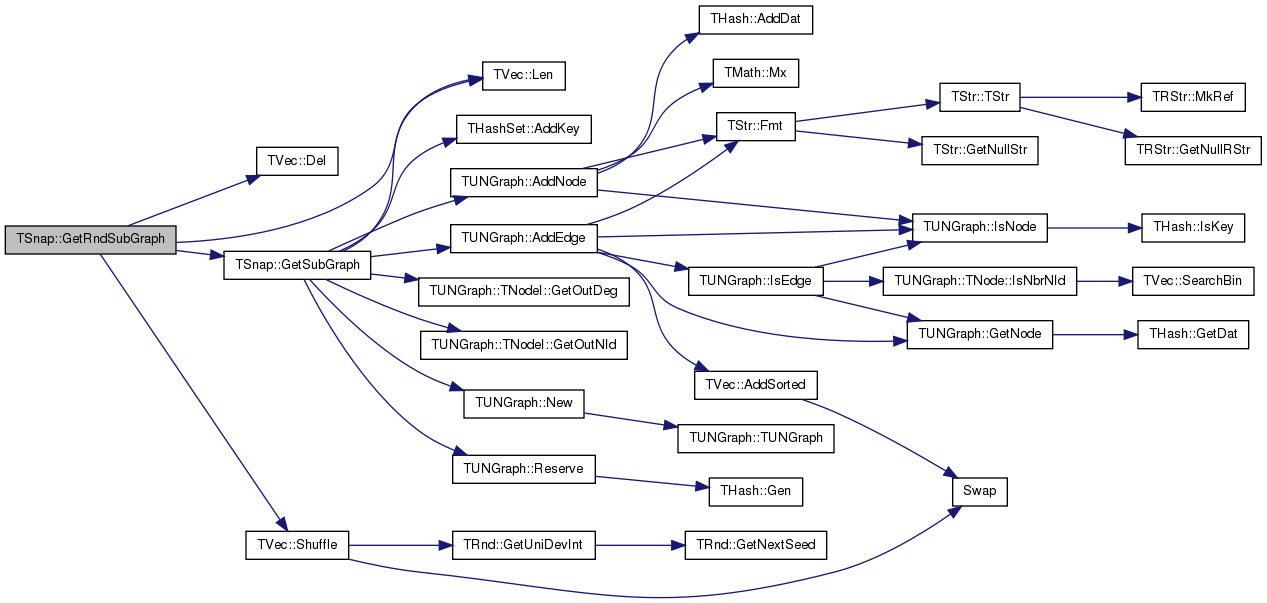
| void TSnap::GetSccs | ( | const PGraph & | Graph, |
| TCnComV & | CnComV | ||
| ) |
Returns all strongly connected components in a Graph.
| CnComV | is a vector of connected components. Each component is defined by the IDs of its member nodes. |
Definition at line 408 of file cncom.h.
References TSccVisitor< PGraph, OnlyCount >::CnComV, and TCnCom::GetDfsVisitor().
Referenced by GetMxScc().
{
TSccVisitor<PGraph, false> Visitor(Graph);
TCnCom::GetDfsVisitor(Graph, Visitor);
CnComV = Visitor.CnComV;
}
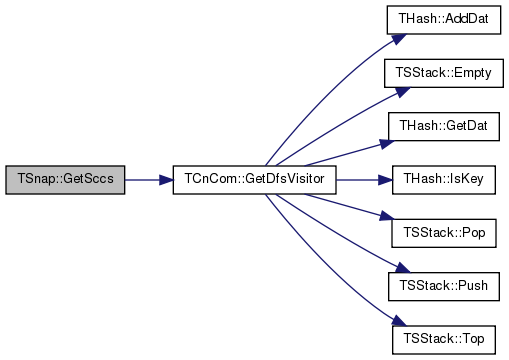

| void TSnap::GetSccSzCnt | ( | const PGraph & | Graph, |
| TIntPrV & | SccSzCnt | ||
| ) |
Returns a distribution of strongly connected component sizes.
| SccSzCnt | returns a set of pairs (number of nodes in the component, number of such components) |
Definition at line 400 of file cncom.h.
References TCnCom::GetDfsVisitor(), THash< TKey, TDat, THashFunc >::GetKeyDatPrV(), TSccVisitor< PGraph, OnlyCount >::SccCntH, and TVec< TVal >::Sort().
Referenced by PlotSccDistr(), and TGStat::TakeConnComp().
{
TSccVisitor<PGraph, true> Visitor(Graph);
TCnCom::GetDfsVisitor(Graph, Visitor);
Visitor.SccCntH.GetKeyDatPrV(SccSzCnt);
SccSzCnt.Sort(true);
}
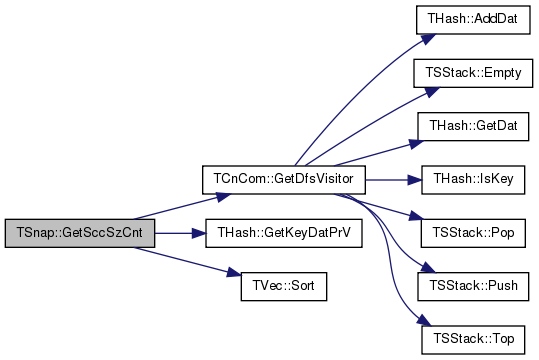

| int TSnap::GetShortPath | ( | const PGraph & | Graph, |
| const int & | SrcNId, | ||
| const int & | DstNId, | ||
| const bool & | IsDir = false |
||
| ) |
Returns the lenght of the shortest path from node SrcNId to node DstNId.
| IsDir | false: ignore edge directions and consider edges/paths as undirected (in case they are directed). |
Definition at line 254 of file bfsdfs.h.
References TBreathFS< PGraph >::DoBfs(), TBreathFS< PGraph >::GetHops(), and TInt::Mx.
{
TBreathFS<PGraph> BFS(Graph);
BFS.DoBfs(SrcNId, true, ! IsDir, DstNId, TInt::Mx);
return BFS.GetHops(SrcNId, DstNId);
}

| int TSnap::GetShortPath | ( | const PGraph & | Graph, |
| const int & | SrcNId, | ||
| TIntH & | NIdToDistH, | ||
| const bool & | IsDir = false, |
||
| const int & | MaxDist = TInt::Mx |
||
| ) |
Returns the lenght of the shortest path from node SrcNId to all other nodes in the network.
| IsDir | false: ignore edge directions and consider edges/paths as undirected (in case they are directed). |
| MaxDist | Maximum number of hops that BFS expands to. This is helpful for speeding-up the code if one in interested only in nodes less than MaxDist away from SrcNId. |
| NIdToDistH | Maps node ID to shortest path distance. NIdToDistH contains only nodes that are reachable from SrcNId. |
Definition at line 245 of file bfsdfs.h.
References THash< TKey, TDat, THashFunc >::Clr(), TBreathFS< PGraph >::DoBfs(), THash< TKey, TDat, THashFunc >::Len(), TBreathFS< PGraph >::NIdDistH, and THash< TKey, TDat, THashFunc >::Swap().
{
TBreathFS<PGraph> BFS(Graph);
BFS.DoBfs(SrcNId, true, ! IsDir, -1, MaxDist);
NIdToDistH.Clr();
NIdToDistH.Swap(BFS.NIdDistH);
return NIdToDistH[NIdToDistH.Len()-1];
}
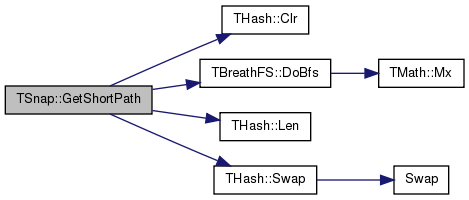
| void TSnap::GetSngVals | ( | const PNGraph & | Graph, |
| const int & | SngVals, | ||
| TFltV & | SngValV | ||
| ) |
Computes largest SngVals singular values of the adjacency matrix representing a directed Graph.
Definition at line 175 of file gsvd.cpp.
References THash< TKey, TDat, THashFunc >::AddKey(), TVVec< TVal >::At(), TNGraph::BegNI(), TNGraph::EndNI(), TNGraph::GetEdges(), THash< TKey, TDat, THashFunc >::GetKeyId(), TNGraph::GetNodes(), IAssert, TSparseSVD::LanczosSVD(), TVec< TVal >::Len(), TSparseSVD::SimpleLanczosSVD(), TVec< TVal >::Sort(), ssotFull, and TSvd::Svd1Based().
Referenced by TKroneckerLL::GradDescentConvergence(), PlotSngValDistr(), PlotSngValRank(), and TGStat::TakeSpectral().
{
const int Nodes = Graph->GetNodes();
IAssert(SngVals > 0);
if (Nodes < 100) {
// perform full SVD
TFltVV AdjMtx(Nodes+1, Nodes+1);
TFltVV LSingV, RSingV;
TIntH NodeIdH;
// create adjecency matrix
for (TNGraph::TNodeI NodeI = Graph->BegNI(); NodeI < Graph->EndNI(); NodeI++) {
NodeIdH.AddKey(NodeI.GetId()); }
for (TNGraph::TNodeI NodeI = Graph->BegNI(); NodeI < Graph->EndNI(); NodeI++) {
const int NodeId = NodeIdH.GetKeyId(NodeI.GetId()) + 1;
for (int e = 0; e < NodeI.GetOutDeg(); e++) {
const int DstNId = NodeIdH.GetKeyId(NodeI.GetOutNId(e)) + 1; // no self edges
if (NodeId != DstNId) AdjMtx.At(NodeId, DstNId) = 1;
}
}
try { // can fail to converge but results seem to be good
TSvd::Svd1Based(AdjMtx, LSingV, SngValV, RSingV); }
catch(...) {
printf("\n***No SVD convergence: G(%d, %d)\n", Nodes, Graph->GetEdges()); }
} else {
// Lanczos
TNGraphMtx GraphMtx(Graph);
int CalcVals = int(2*SngVals);
//if (CalcVals > Nodes) { CalcVals = int(2*Nodes); }
//if (CalcVals > Nodes) { CalcVals = Nodes; }
//while (SngValV.Len() < SngVals && CalcVals < 10*SngVals) {
try {
if (SngVals > 4) {
TSparseSVD::SimpleLanczosSVD(GraphMtx, 2*SngVals, SngValV, false); }
else { TFltVV LSingV, RSingV; // this is much more precise, but also much slower
TSparseSVD::LanczosSVD(GraphMtx, SngVals, 3*SngVals, ssotFull, SngValV, LSingV, RSingV); }
}
catch(...) {
printf("\n ***EXCEPTION: TRIED %d GOT %d values** \n", 2*SngVals, SngValV.Len()); }
if (SngValV.Len() < SngVals) {
printf(" ***TRIED %d GOT %d values** \n", CalcVals, SngValV.Len()); }
// CalcVals += SngVals;
//}
}
SngValV.Sort(false);
//if (SngValV.Len() > SngVals) {
// SngValV.Del(SngVals, SngValV.Len()-1); }
//else {
// while (SngValV.Len() < SngVals) SngValV.Add(1e-6); }
//IAssert(SngValV.Len() == SngVals);
}

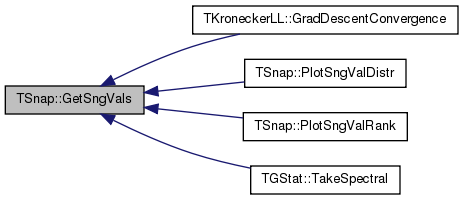
| void TSnap::GetSngVec | ( | const PNGraph & | Graph, |
| TFltV & | LeftSV, | ||
| TFltV & | RightSV | ||
| ) |
Computes the leading left and right singular vector of the adjacency matrix representing a directed Graph.
Definition at line 225 of file gsvd.cpp.
References THash< TKey, TDat, THashFunc >::AddKey(), TVVec< TVal >::At(), TNGraph::BegNI(), TNGraph::EndNI(), TVVec< TVal >::GetCol(), TNGraph::GetEdges(), THash< TKey, TDat, THashFunc >::GetKeyId(), TNGraph::GetNodes(), IsAllValVNeg(), TSparseSVD::LanczosSVD(), TVec< TVal >::Len(), TFlt::Mn, ssotFull, and TSvd::Svd1Based().
Referenced by PlotSngVec(), and TGStat::TakeSpectral().
{
const int Nodes = Graph->GetNodes();
TFltVV LSingV, RSingV;
TFltV SngValV;
if (Nodes < 500) {
// perform full SVD
TFltVV AdjMtx(Nodes+1, Nodes+1);
TIntH NodeIdH;
// create adjecency matrix
for (TNGraph::TNodeI NodeI = Graph->BegNI(); NodeI < Graph->EndNI(); NodeI++) {
NodeIdH.AddKey(NodeI.GetId()); }
for (TNGraph::TNodeI NodeI = Graph->BegNI(); NodeI < Graph->EndNI(); NodeI++) {
const int NodeId = NodeIdH.GetKeyId(NodeI.GetId()) + 1;
for (int e = 0; e < NodeI.GetOutDeg(); e++) {
const int DstNId = NodeIdH.GetKeyId(NodeI.GetOutNId(e)) + 1; // no self edges
if (NodeId != DstNId) AdjMtx.At(NodeId, DstNId) = 1;
}
}
try { // can fail to converge but results seem to be good
TSvd::Svd1Based(AdjMtx, LSingV, SngValV, RSingV); }
catch(...) {
printf("\n***No SVD convergence: G(%d, %d)\n", Nodes, Graph->GetEdges()); }
} else { // Lanczos
TNGraphMtx GraphMtx(Graph);
TSparseSVD::LanczosSVD(GraphMtx, 1, 8, ssotFull, SngValV, LSingV, RSingV);
}
TFlt MxSngVal = TFlt::Mn;
int ValN = 0;
for (int i = 0; i < SngValV.Len(); i++) {
if (MxSngVal < SngValV[i]) { MxSngVal = SngValV[i]; ValN = i; } }
LSingV.GetCol(ValN, LeftSV);
RSingV.GetCol(ValN, RightSV);
IsAllValVNeg(LeftSV, true);
IsAllValVNeg(RightSV, true);
}
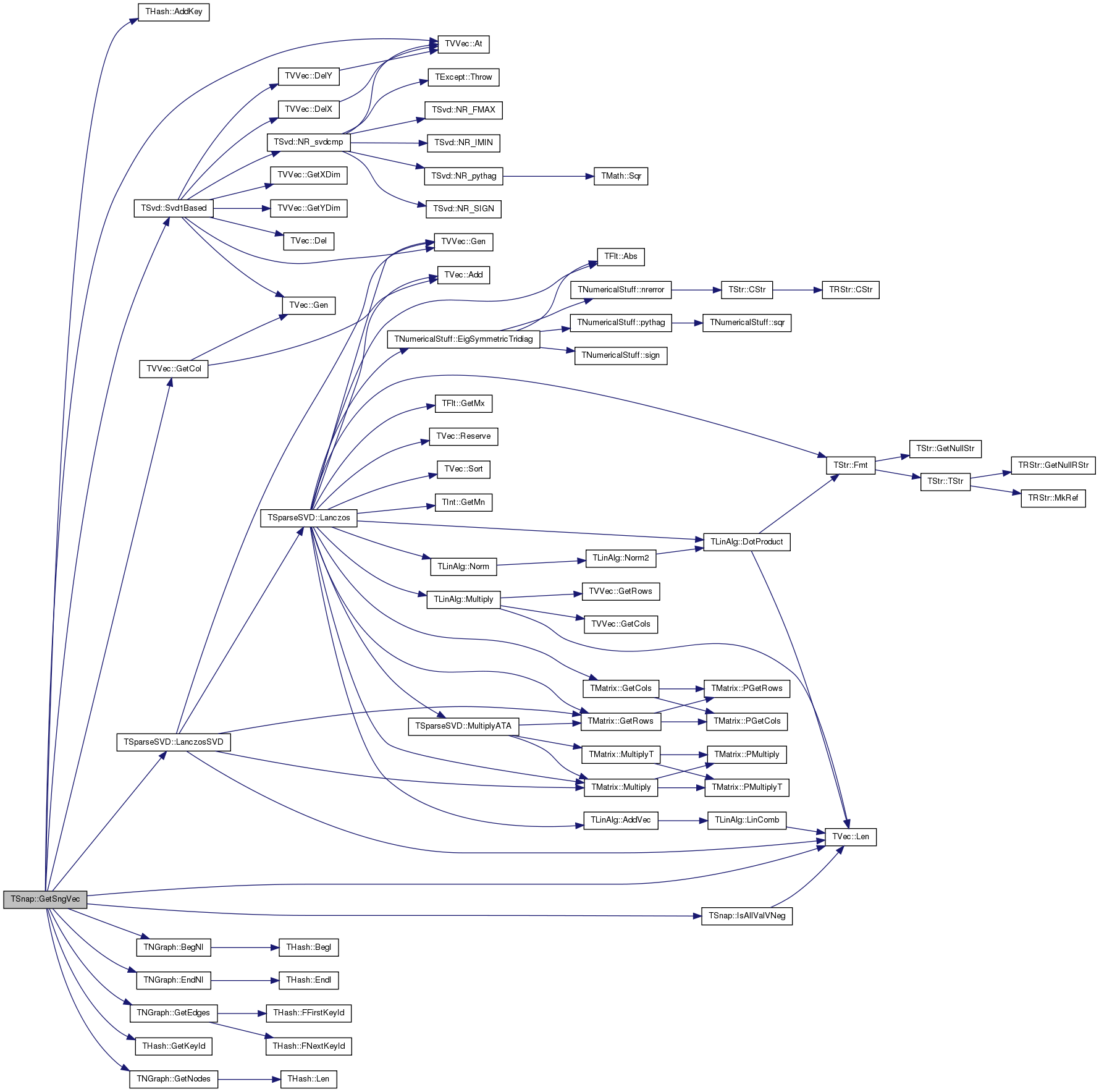

| void TSnap::GetSngVec | ( | const PNGraph & | Graph, |
| const int & | SngVecs, | ||
| TFltV & | SngValV, | ||
| TVec< TFltV > & | LeftSV, | ||
| TVec< TFltV > & | RightSV | ||
| ) |
Computes the singular values and left and right singular vectors of the adjacency matrix representing a directed Graph.
| SngVecs | Number of singular values/vectors to compute. |
Definition at line 261 of file gsvd.cpp.
References TVec< TVal >::Add(), THash< TKey, TDat, THashFunc >::AddKey(), TVVec< TVal >::At(), TNGraph::BegNI(), TVec< TVal >::Clr(), TNGraph::EndNI(), TVVec< TVal >::GetCol(), TNGraph::GetEdges(), THash< TKey, TDat, THashFunc >::GetKeyId(), TNGraph::GetNodes(), IsAllValVNeg(), TSparseSVD::LanczosSVD(), TVec< TVal >::Last(), TVec< TVal >::Len(), TVec< TVal >::Sort(), ssotFull, and TSvd::Svd1Based().
{
const int Nodes = Graph->GetNodes();
SngValV.Clr();
LeftSV.Clr();
RightSV.Clr();
TFltVV LSingV, RSingV;
if (Nodes < 100) {
// perform full SVD
TFltVV AdjMtx(Nodes+1, Nodes+1);
TIntH NodeIdH;
// create adjecency matrix (1-based)
for (TNGraph::TNodeI NodeI = Graph->BegNI(); NodeI < Graph->EndNI(); NodeI++) {
NodeIdH.AddKey(NodeI.GetId()); }
for (TNGraph::TNodeI NodeI = Graph->BegNI(); NodeI < Graph->EndNI(); NodeI++) {
const int NodeId = NodeIdH.GetKeyId(NodeI.GetId())+1;
for (int e = 0; e < NodeI.GetOutDeg(); e++) {
const int DstNId = NodeIdH.GetKeyId(NodeI.GetOutNId(e))+1; // no self edges
if (NodeId != DstNId) AdjMtx.At(NodeId, DstNId) = 1;
}
}
try { // can fail to converge but results seem to be good
TSvd::Svd1Based(AdjMtx, LSingV, SngValV, RSingV);
} catch(...) {
printf("\n***No SVD convergence: G(%d, %d)\n", Nodes, Graph->GetEdges());
}
} else { // Lanczos
TNGraphMtx GraphMtx(Graph);
TSparseSVD::LanczosSVD(GraphMtx, SngVecs, 2*SngVecs, ssotFull, SngValV, LSingV, RSingV);
//TGAlg::SaveFullMtx(Graph, "adj_mtx.txt");
//TLAMisc::DumpTFltVVMjrSubMtrx(LSingV, LSingV.GetRows(), LSingV.GetCols(), "LSingV2.txt"); // save MTX
}
TFltIntPrV SngValIdV;
for (int i = 0; i < SngValV.Len(); i++) {
SngValIdV.Add(TFltIntPr(SngValV[i], i));
}
SngValIdV.Sort(false);
SngValV.Sort(false);
for (int v = 0; v < SngValIdV.Len(); v++) {
LeftSV.Add();
LSingV.GetCol(SngValIdV[v].Val2, LeftSV.Last());
RightSV.Add();
RSingV.GetCol(SngValIdV[v].Val2, RightSV.Last());
}
IsAllValVNeg(LeftSV[0], true);
IsAllValVNeg(RightSV[0], true);
}
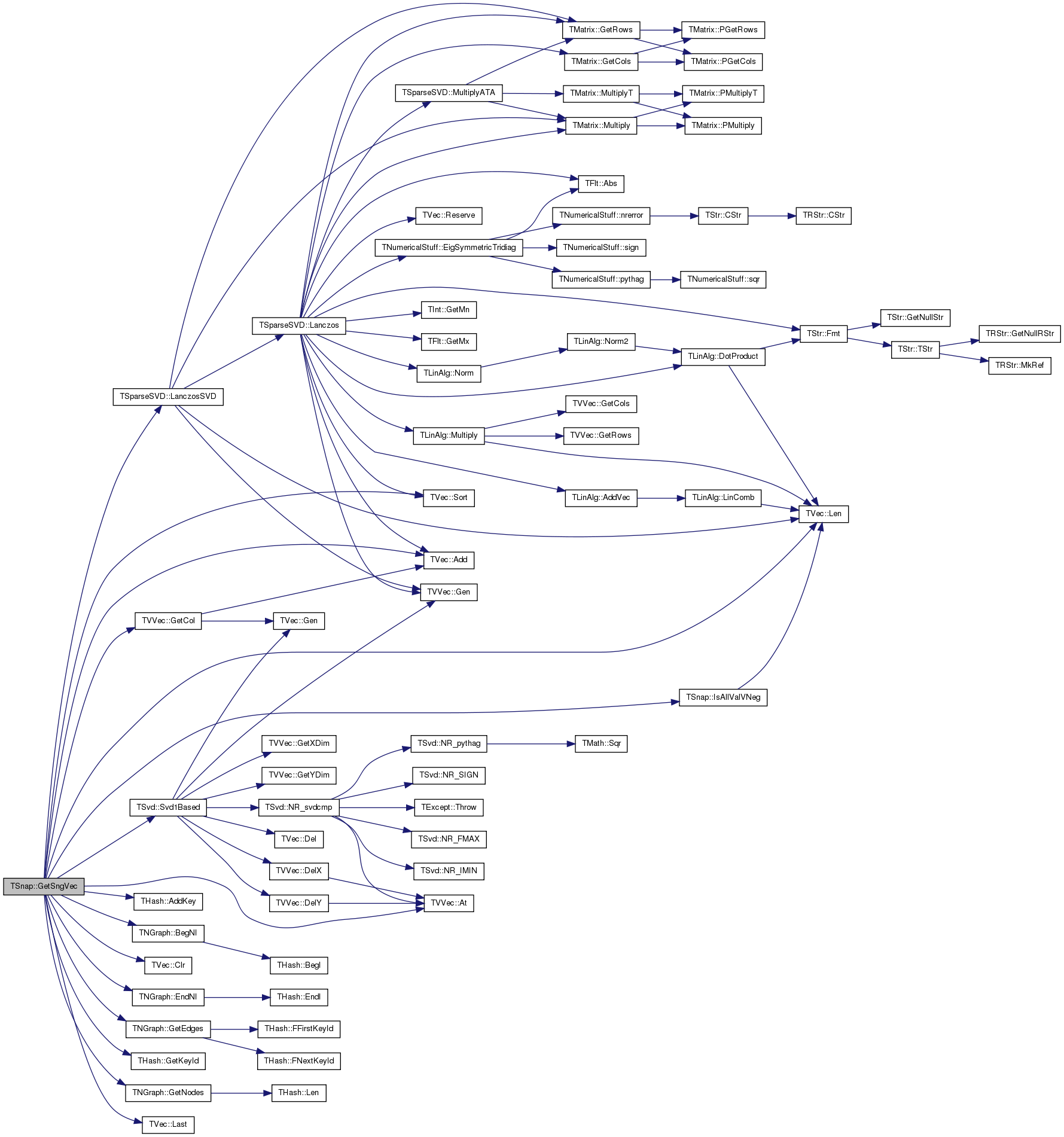
| PUNGraph TSnap::GetSubGraph | ( | const PUNGraph & | Graph, |
| const TIntV & | NIdV, | ||
| const bool & | RenumberNodes = false |
||
| ) |
Returns an induced subgraph of an undirected graph Graph with NIdV nodes with an optional node renumbering.
The resulting subgraph contains all the nodes from Graph, which have node IDs in the NIdV vector and all the edges with both nodes in NIdV. Parameter RenumberNodes determines, whether the node IDs are preserved or not. If RenumberNodes is false, then nodes in the resulting subgraph have the same node IDs as nodes in Graph. If RenumberNodes is true, then nodes in the resulting subgraph are renumbered sequentially from 0 to N-1. By default, the nodes are not renumbered.
Definition at line 7 of file subgraph.cpp.
References TUNGraph::AddEdge(), THashSet< TKey, THashFunc >::AddKey(), TUNGraph::AddNode(), TUNGraph::TNodeI::GetOutDeg(), TUNGraph::TNodeI::GetOutNId(), TVec< TVal >::Len(), TUNGraph::New(), and TUNGraph::Reserve().
Referenced by TLocClust::DrawWhiskers(), TKCore< PGraph >::GetCoreG(), GetKCore(), GetMxBiCon(), GetMxScc(), GetMxWcc(), GetRndSubGraph(), TLocClustStat::PlotPhiInOut(), TKroneckerLL::SetGraph(), and TMAGFitBern::SetGraph().
{
//if (! RenumberNodes) { return TSnap::GetSubGraph(Graph, NIdV); }
PUNGraph NewGraphPt = TUNGraph::New();
TUNGraph& NewGraph = *NewGraphPt;
NewGraph.Reserve(NIdV.Len(), -1);
TIntSet NIdSet(NIdV.Len());
for (int n = 0; n < NIdV.Len(); n++) {
if (Graph->IsNode(NIdV[n])) {
NIdSet.AddKey(NIdV[n]);
if (! RenumberNodes) { NewGraph.AddNode(NIdV[n]); }
else { NewGraph.AddNode(NIdSet.GetKeyId(NIdV[n])); }
}
}
if (! RenumberNodes) {
for (int n = 0; n < NIdSet.Len(); n++) {
const int SrcNId = NIdSet[n];
const TUNGraph::TNodeI NI = Graph->GetNI(SrcNId);
for (int edge = 0; edge < NI.GetOutDeg(); edge++) {
const int OutNId = NI.GetOutNId(edge);
if (NIdSet.IsKey(OutNId)) {
NewGraph.AddEdge(SrcNId, OutNId); }
}
}
} else {
for (int n = 0; n < NIdSet.Len(); n++) {
const int SrcNId = NIdSet[n];
const TUNGraph::TNodeI NI = Graph->GetNI(SrcNId);
for (int edge = 0; edge < NI.GetOutDeg(); edge++) {
const int OutNId = NI.GetOutNId(edge);
if (NIdSet.IsKey(OutNId)) {
NewGraph.AddEdge(NIdSet.GetKeyId(SrcNId), NIdSet.GetKeyId(OutNId)); }
}
}
}
return NewGraphPt;
}
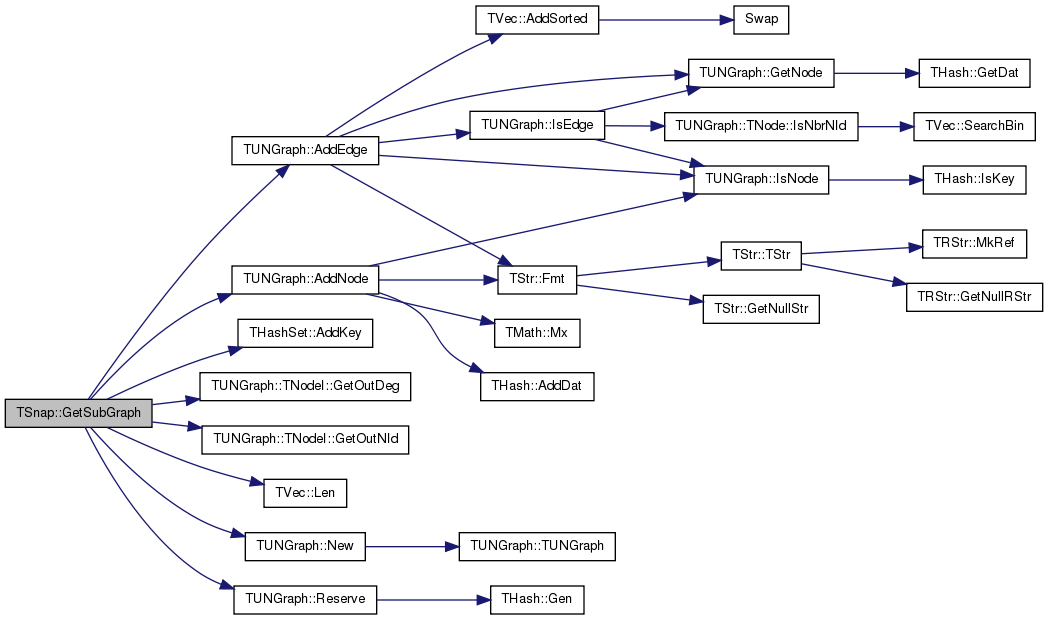
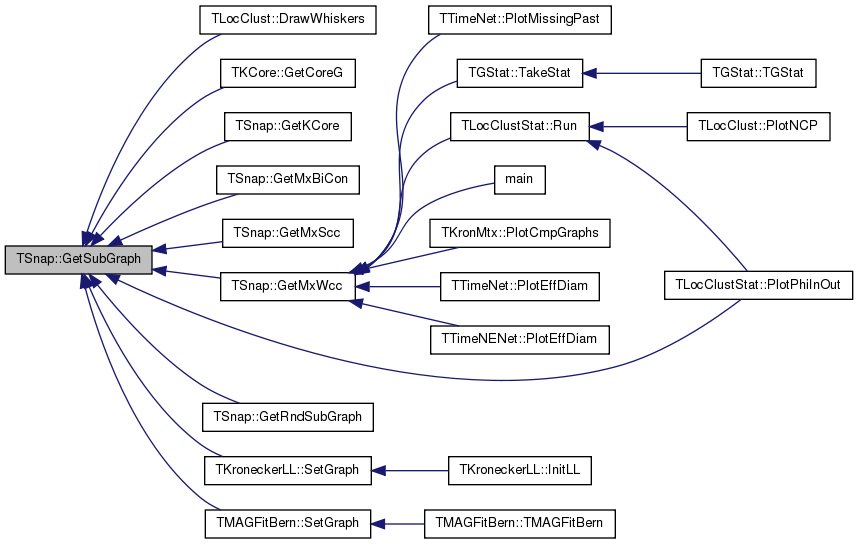
| PGraph TSnap::GetSubGraph | ( | const PGraph & | Graph, |
| const TIntV & | NIdV | ||
| ) |
Returns an induced subgraph of graph Graph with NIdV nodes.
The resulting subgraph contains all the nodes from Graph, which have node IDs in the NIdV vector and all the edges with both nodes in NIdV. Node IDs are preserved. Nodes in the resulting subgraph have the same node IDs as nodes in Graph.
Definition at line 194 of file subgraph.h.
{
return TSnapDetail::TGetSubGraph<PGraph, HasGraphFlag(typename PGraph::TObj, gfMultiGraph)>
::Do(Graph, NIdV);
}
| int TSnap::GetSubTreeSz | ( | const PGraph & | Graph, |
| const int & | StartNId, | ||
| const bool & | FollowOut, | ||
| const bool & | FollowIn, | ||
| int & | TreeSz, | ||
| int & | TreeDepth | ||
| ) |
Returns the BFS tree size (number of nodes) and depth (number of levels) by following in-links (parameter FollowIn = true) and/or out-links (parameter FollowOut = true) of node StartNId.
Definition at line 208 of file bfsdfs.h.
References TBreathFS< PGraph >::DoBfs(), THash< TKey, TDat, THashFunc >::Len(), TMath::Mx(), TInt::Mx, and TBreathFS< PGraph >::NIdDistH.
{
TBreathFS<PGraph> BFS(Graph);
BFS.DoBfs(StartNId, FollowOut, FollowIn, -1, TInt::Mx);
TreeSz = BFS.NIdDistH.Len();
TreeDepth = 0;
for (int i = 0; i < BFS.NIdDistH.Len(); i++) {
TreeDepth = TMath::Mx(TreeDepth, BFS.NIdDistH[i].Val);
}
return TreeSz;
}

| int TSnap::GetTreeRootNId | ( | const PGraph & | Graph | ) |
| void TSnap::GetTreeSig | ( | const PGraph & | Graph, |
| const int & | RootNId, | ||
| TIntV & | Sig | ||
| ) |
Definition at line 457 of file alg.h.
References TVec< TVal >::Add(), CAssert, TVec< TVal >::Gen(), gfDirected, HasGraphFlag, IAssert, TVec< TVal >::Len(), TSnapQueue< TVal >::Push(), and TVec< TVal >::QSort().
Referenced by TGHash< TDat >::AddKey(), TGHash< TDat >::GetNodeMap(), and TGHash< TDat >::IsGetKeyId().
{
CAssert(HasGraphFlag(typename PGraph::TObj, gfDirected));
Sig.Gen(Graph->GetNodes(), 0);
TSnapQueue<int> NIdQ(Graph->GetNodes());
NIdQ.Push(RootNId);
int LastPos = 0, NodeCnt = 1;
while (! NIdQ.Empty()) {
const typename PGraph::TObj::TNodeI Node = Graph->GetNI(NIdQ.Top()); NIdQ.Pop();
IAssert(Node.GetInDeg()==0 || Node.GetOutDeg()==0); // child points or is-pointed to by the parent
if (Node.GetInDeg() != 0) {
for (int e = 0; e < Node.GetInDeg(); e++) {
NIdQ.Push(Node.GetInNId(e)); }
} else if (Node.GetOutDeg() != 0) {
for (int e = 0; e < Node.GetOutDeg(); e++) {
NIdQ.Push(Node.GetOutNId(e)); }
}
Sig.Add(Node.GetInDeg());
if (--NodeCnt == 0) {
for (int i = LastPos; i < Sig.Len(); i++) NodeCnt += Sig[i];
Sig.QSort(LastPos, Sig.Len()-1, false);
LastPos = Sig.Len();
}
}
}
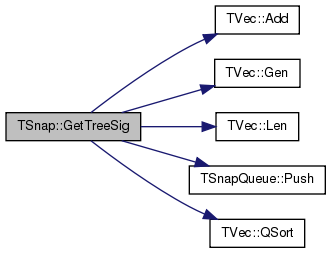

| void TSnap::GetTreeSig | ( | const PGraph & | Graph, |
| const int & | RootNId, | ||
| TIntV & | Sig, | ||
| TIntPrV & | NodeMap | ||
| ) |
Definition at line 484 of file alg.h.
References TVec< TVal >::Add(), CAssert, TVec< TVal >::Gen(), gfDirected, HasGraphFlag, IAssert, TVec< TVal >::Len(), TSnapQueue< TVal >::Push(), and TVec< TVal >::QSort().
{
CAssert(HasGraphFlag(typename PGraph::TObj, gfDirected));
NodeMap.Gen(Graph->GetNodes(), 0);
Sig.Gen(Graph->GetNodes(), 0);
TSnapQueue<int> NIdQ(Graph->GetNodes());
NIdQ.Push(RootNId);
int LastPos = 0, NodeCnt = 1;
while (! NIdQ.Empty()) {
const typename PGraph::TObj::TNodeI Node = Graph->GetNI(NIdQ.Top()); NIdQ.Pop();
IAssert(Node.GetInDeg()==0 || Node.GetOutDeg()==0); // child points or is-pointed to by the parent
if (Node.GetInDeg() != 0) {
for (int e = 0; e < Node.GetInDeg(); e++) {
NIdQ.Push(Node.GetInNId(e)); }
NodeMap.Add(TIntPr(Node.GetInDeg(), Node.GetId()));
} else if (Node.GetOutDeg() != 0) {
for (int e = 0; e < Node.GetOutDeg(); e++) {
NIdQ.Push(Node.GetOutNId(e)); }
NodeMap.Add(TIntPr(Node.GetOutDeg(), Node.GetId()));
}
if (--NodeCnt == 0) {
for (int i = LastPos; i < NodeMap.Len(); i++) {
NodeCnt += NodeMap[i].Val1; }
NodeMap.QSort(LastPos, NodeMap.Len()-1, false);
LastPos = NodeMap.Len();
}
}
for (int i = 0; i < NodeMap.Len(); i++) {
Sig.Add(NodeMap[i].Val1); // degree dignature
NodeMap[i].Val1 = NodeMap[i].Val2;
NodeMap[i].Val2 = i;
}
}
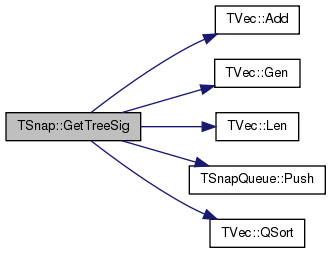
| int TSnap::GetTriadEdges | ( | const PGraph & | Graph, |
| int | SampleEdges = -1 |
||
| ) |
Counts the number of edges that participate in at least one triad
| SampleNodes | If !=-1 then compute triads only for a random sample of SampleNodes nodes. Useful for approximate but quick computations. |
Definition at line 223 of file triad.h.
References THashSet< TKey, THashFunc >::AddKey(), THashSet< TKey, THashFunc >::Clr(), gfDirected, and THashSet< TKey, THashFunc >::IsKey().
{
const bool IsDir = Graph->HasFlag(gfDirected);
TIntSet NbrH;
int TriadEdges = 0;
for(typename PGraph::TObj::TNodeI NI = Graph->BegNI(); NI < Graph->EndNI(); NI++) {
NbrH.Clr(false);
for (int e = 0; e < NI.GetOutDeg(); e++) {
if (NI.GetOutNId(e) != NI.GetId()) {
NbrH.AddKey(NI.GetOutNId(e)); }
}
if (IsDir) {
for (int e = 0; e < NI.GetInDeg(); e++) {
if (NI.GetInNId(e) != NI.GetId()) {
NbrH.AddKey(NI.GetInNId(e)); }
}
}
for (int e = 0; e < NI.GetOutDeg(); e++) {
if (!IsDir && NI.GetId()<NI.GetOutNId(e)) { continue; } // for undirected graphs count each edge only once
const typename PGraph::TObj::TNodeI SrcNode = Graph->GetNI(NI.GetOutNId(e));
bool Triad=false;
for (int e1 = 0; e1 < SrcNode.GetOutDeg(); e1++) {
if (NbrH.IsKey(SrcNode.GetOutNId(e1))) { Triad=true; break; }
}
if (IsDir && ! Triad) {
for (int e1 = 0; e1 < SrcNode.GetInDeg(); e1++) {
if (NbrH.IsKey(SrcNode.GetInNId(e1))) { Triad=true; break; }
}
}
if (Triad) { TriadEdges++; }
}
}
return TriadEdges;
}
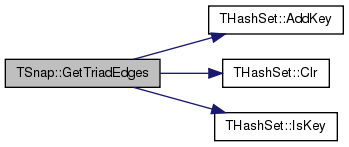
| void TSnap::GetTriadParticip | ( | const PGraph & | Graph, |
| TIntPrV & | TriadCntV | ||
| ) |
Triangle Participation Ratio: For each node counts how many triangles it participates in and then returns a set of pairs (number of triangles, number of such nodes).
Definition at line 371 of file triad.h.
References THash< TKey, TDat, THashFunc >::AddDat(), THash< TKey, TDat, THashFunc >::GetKeyDatPrV(), GetNodeTriads(), and TVec< TVal >::Sort().
Referenced by TGStat::TakeTriadPart().
{
TIntH TriadCntH;
for (typename PGraph::TObj::TNodeI NI = Graph->BegNI(); NI < Graph->EndNI(); NI++) {
const int Triads = GetNodeTriads(Graph, NI.GetId());
TriadCntH.AddDat(Triads) += 1;
}
TriadCntH.GetKeyDatPrV(TriadCntV);
TriadCntV.Sort();
}
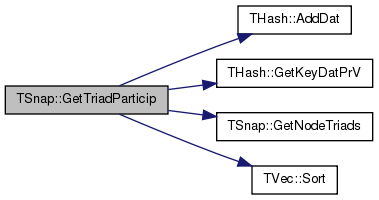

| int TSnap::GetTriads | ( | const PGraph & | Graph, |
| int | SampleNodes = -1 |
||
| ) |
Returns the number of triangles in a graph. Function returns the number of unique triples of connected nodes (regardless of the number of edges between each pair of nodes).
| SampleNodes | If !=-1 then compute triads only for a random sample of SampleNodes nodes. Useful for approximate but quick computations. |
Definition at line 152 of file triad.h.
References GetTriads().
{
int OpenTriads, ClosedTriads;
return GetTriads(Graph, ClosedTriads, OpenTriads, SampleNodes);
}

| void TSnap::GetTriads | ( | const PGraph & | Graph, |
| TIntTrV & | NIdCOTriadV, | ||
| int | SampleNodes = -1 |
||
| ) |
Computes the number of open and close triads for every node of the network.
| NIdCOTriadV | Triple (node id, open triads: number of pairs of node's neighbors that are not connected, closed triads: number of pairs of node's neighbors that are connected between themselves). |
| SampleNodes | If !=-1 then compute triads only for a random sample of SampleNodes nodes. Useful for approximate but quick computations. |
Definition at line 176 of file triad.h.
References TVec< TVal >::Add(), THashSet< TKey, THashFunc >::AddKey(), TVec< TVal >::Clr(), THashSet< TKey, THashFunc >::Clr(), THashSet< TKey, THashFunc >::GetKey(), gfDirected, IAssert, THashSet< TKey, THashFunc >::Len(), TVec< TVal >::Reserve(), and TVec< TVal >::Shuffle().
{
const bool IsDir = Graph->HasFlag(gfDirected);
TIntSet NbrH;
TIntV NIdV;
TRnd Rnd(0);
Graph->GetNIdV(NIdV);
NIdV.Shuffle(Rnd);
if (SampleNodes == -1) {
SampleNodes = Graph->GetNodes(); }
NIdCOTriadV.Clr(false);
NIdCOTriadV.Reserve(SampleNodes);
for (int node = 0; node < SampleNodes; node++) {
typename PGraph::TObj::TNodeI NI = Graph->GetNI(NIdV[node]);
if (NI.GetDeg() < 2) {
NIdCOTriadV.Add(TIntTr(NI.GetId(), 0, 0)); // zero triangles
continue;
}
// find neighborhood
NbrH.Clr(false);
for (int e = 0; e < NI.GetOutDeg(); e++) {
if (NI.GetOutNId(e) != NI.GetId()) {
NbrH.AddKey(NI.GetOutNId(e)); }
}
if (IsDir) {
for (int e = 0; e < NI.GetInDeg(); e++) {
if (NI.GetInNId(e) != NI.GetId()) {
NbrH.AddKey(NI.GetInNId(e)); }
}
}
// count connected neighbors
int OpenCnt=0, CloseCnt=0;
for (int srcNbr = 0; srcNbr < NbrH.Len(); srcNbr++) {
const typename PGraph::TObj::TNodeI SrcNode = Graph->GetNI(NbrH.GetKey(srcNbr));
for (int dstNbr = srcNbr+1; dstNbr < NbrH.Len(); dstNbr++) {
const int dstNId = NbrH.GetKey(dstNbr);
if (SrcNode.IsNbrNId(dstNId)) { CloseCnt++; } // is edge
else { OpenCnt++; }
}
}
IAssert(2*(OpenCnt+CloseCnt) == NbrH.Len()*(NbrH.Len()-1));
NIdCOTriadV.Add(TIntTr(NI.GetId(), CloseCnt, OpenCnt));
}
}
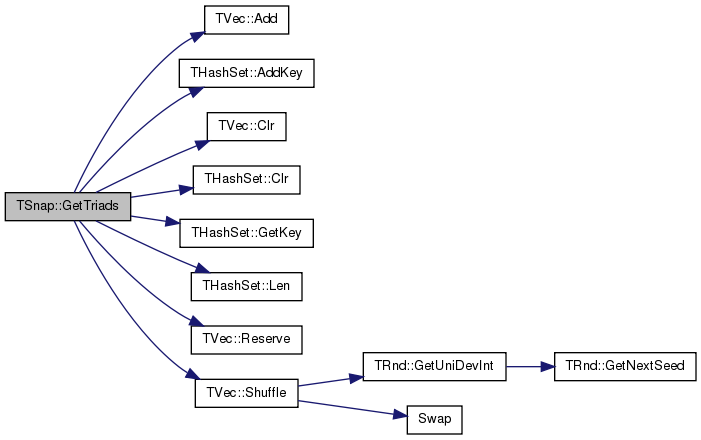
| int TSnap::GetTriads | ( | const PGraph & | Graph, |
| int & | ClosedTriads, | ||
| int & | OpenTriads, | ||
| int | SampleNodes = -1 |
||
| ) |
Computes the number of Closed and Open triads.
| SampleNodes | If !=-1 then compute triads only for a random sample of SampleNodes nodes. Useful for approximate but quick computations. |
Definition at line 158 of file triad.h.
References IAssert, TVec< TVal >::Len(), and TInt::Mx.
Referenced by GetClustCf(), GetNodeClustCf(), GetTriads(), PrintInfo(), and TKronMomentsFit::TKronMomentsFit().
{
TIntTrV NIdCOTriadV;
GetTriads(Graph, NIdCOTriadV, SampleNodes);
uint64 closedTriads = 0;
uint64 openTriads = 0;
for (int i = 0; i < NIdCOTriadV.Len(); i++) {
closedTriads += NIdCOTriadV[i].Val2;
openTriads += NIdCOTriadV[i].Val3;
}
IAssert(closedTriads/3 < (uint64) TInt::Mx);
IAssert(openTriads < (uint64) TInt::Mx);
ClosedTriads = int(closedTriads/3); // each triad is counted 3 times
OpenTriads = int(openTriads);
return ClosedTriads;
}


| PGraph TSnap::GetUnDir | ( | const PGraph & | Graph | ) |
Definition at line 322 of file alg.h.
References MakeUnDir().
{
PGraph NewGraphPt = PGraph::New();
*NewGraphPt = *Graph;
MakeUnDir(NewGraphPt);
return NewGraphPt;
}

| void TSnap::GetWccs | ( | const PGraph & | Graph, |
| TCnComV & | CnComV | ||
| ) |
Returns all weakly connected components in a Graph.
| CnComV | is a vector of connected components. Each component is defined by the IDs of its member nodes. |
Definition at line 356 of file cncom.h.
References TVec< TVal >::Add(), THashSet< TKey, THashFunc >::AddKey(), TVec< TVal >::Clr(), THashSet< TKey, THashFunc >::Clr(), THashSet< TKey, THashFunc >::Gen(), gfDirected, HasGraphFlag, and TVec< TVal >::Sort().
Referenced by TSnap::TSnapDetail::_GirvanNewmanGetModularity(), Get1CnCom(), Get1CnComSzCnt(), TCliqueOverlap::GetCPMCommunities(), GetMxWcc(), and GetMxWccSz().
{
typename PGraph::TObj::TNodeI NI;
THashSet<TInt> VisitedNId(Graph->GetNodes()+1);
TSnapQueue<int> NIdQ(Graph->GetNodes()+1);
TIntV CcNIdV;
CnComV.Clr(); CcNIdV.Gen(1);
// zero degree nodes
for (NI = Graph->BegNI(); NI < Graph->EndNI(); NI++) {
if (NI.GetDeg() == 0) {
const int NId = NI.GetId();
VisitedNId.AddKey(NId);
CcNIdV[0] = NId; CnComV.Add(CcNIdV);
}
}
// the rest of the nodes
for (NI = Graph->BegNI(); NI < Graph->EndNI(); NI++) {
const int NId = NI.GetId();
if (! VisitedNId.IsKey(NId)) {
VisitedNId.AddKey(NId);
NIdQ.Clr(false); NIdQ.Push(NId);
CcNIdV.Clr(); CcNIdV.Add(NId);
while (! NIdQ.Empty()) {
const typename PGraph::TObj::TNodeI Node = Graph->GetNI(NIdQ.Top()); NIdQ.Pop();
if (HasGraphFlag(typename PGraph::TObj, gfDirected)) {
for (int e = 0; e < Node.GetInDeg(); e++) {
const int InNId = Node.GetInNId(e);
if (! VisitedNId.IsKey(InNId)) {
NIdQ.Push(InNId); VisitedNId.AddKey(InNId); CcNIdV.Add(InNId); }
}
}
for (int e = 0; e < Node.GetOutDeg(); e++) {
const int OutNId = Node.GetOutNId(e);
if (! VisitedNId.IsKey(OutNId)) {
NIdQ.Push(OutNId); VisitedNId.AddKey(OutNId); CcNIdV.Add(OutNId); }
}
}
CcNIdV.Sort(true);
CnComV.Add(TCnCom(CcNIdV)); // add wcc comoponent
}
}
CnComV.Sort(false);
}
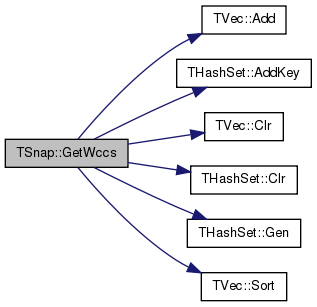
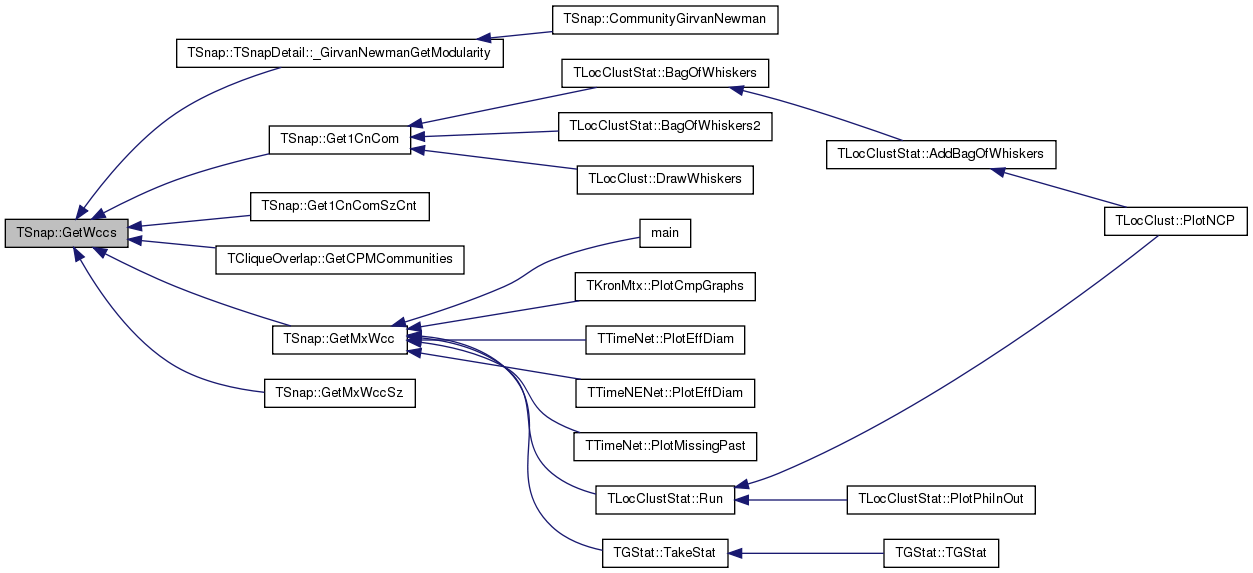
| void TSnap::GetWccSzCnt | ( | const PGraph & | Graph, |
| TIntPrV & | WccSzCnt | ||
| ) |
Returns a distribution of weakly connected component sizes.
| WccSzCnt | returns a set of pairs (number of nodes in the component, number of such components) |
Definition at line 317 of file cncom.h.
References THashSet< TKey, THashFunc >::AddKey(), gfDirected, HasGraphFlag, and TVec< TVal >::Sort().
Referenced by Get1CnComSzCnt(), PlotWccDistr(), and TGStat::TakeConnComp().
{
THashSet<TInt> VisitedNId(Graph->GetNodes());
TIntH SzToCntH;
TSnapQueue<int> NIdQ(Graph->GetNodes()+1);
typename PGraph::TObj::TNodeI NI;
int Cnt = 0;
// zero degree nodes
for (NI = Graph->BegNI(); NI < Graph->EndNI(); NI++) {
if (NI.GetDeg() == 0) { Cnt++; VisitedNId.AddKey(NI.GetId()); }
}
if (Cnt > 0) SzToCntH.AddDat(1, Cnt);
// the rest of the nodes
for (NI = Graph->BegNI(); NI < Graph->EndNI(); NI++) {
if (! VisitedNId.IsKey(NI.GetId())) {
VisitedNId.AddKey(NI.GetId());
NIdQ.Clr(false); NIdQ.Push(NI.GetId());
Cnt = 0;
while (! NIdQ.Empty()) {
const typename PGraph::TObj::TNodeI Node = Graph->GetNI(NIdQ.Top()); NIdQ.Pop();
if (HasGraphFlag(typename PGraph::TObj, gfDirected)) {
for (int e = 0; e < Node.GetInDeg(); e++) {
const int InNId = Node.GetInNId(e);
if (! VisitedNId.IsKey(InNId)) { NIdQ.Push(InNId); VisitedNId.AddKey(InNId); }
}
}
for (int e = 0; e < Node.GetOutDeg(); e++) {
const int OutNId = Node.GetOutNId(e);
if (! VisitedNId.IsKey(OutNId)) { NIdQ.Push(OutNId); VisitedNId.AddKey(OutNId); }
}
Cnt++;
}
SzToCntH.AddDat(Cnt) += 1;
}
}
SzToCntH.GetKeyDatPrV(WccSzCnt);
WccSzCnt.Sort(true);
}


| bool TSnap::IsAllValVNeg | ( | TFltV & | ValV, |
| const bool & | InvertSign | ||
| ) |
Definition at line 163 of file gsvd.cpp.
References TVec< TVal >::Len().
Referenced by GetEigVec(), and GetSngVec().
{
bool IsAllNeg=true;
for (int i = 0; i < ValV.Len(); i++) {
if (ValV[i]>0.0) { IsAllNeg=false; break; }
}
if (IsAllNeg && InvertSign) {
for (int i = 0; i < ValV.Len(); i++) {
ValV[i] = -ValV[i]; }
}
return IsAllNeg;
}


| bool TSnap::IsConnected | ( | const PGraph & | Graph | ) |
Tests whether the Graph is (weakly) connected.
Definition at line 288 of file cncom.h.
References IsWeaklyConn().
Referenced by IsTree().
{
return IsWeaklyConn(Graph);
}


| bool TSnap::IsTree | ( | const PGraph & | Graph, |
| int & | RootNId | ||
| ) |
Definition at line 437 of file alg.h.
References IsConnected().
Referenced by TGHash< TDat >::AddKey(), TGHash< TDat >::GetNodeMap(), GetTreeRootNId(), and TGHash< TDat >::IsGetKeyId().
{
RootNId = -1;
if (Graph->GetNodes() != Graph->GetEdges()+1) { return false; }
int NZeroOutDeg = 0;
int ZeroOutDegN = -1;
for (typename PGraph::TObj::TNodeI NI = Graph->BegNI(); NI < Graph->EndNI(); NI++) {
if (NI.GetOutDeg() == 0) {
ZeroOutDegN = NI.GetId(); NZeroOutDeg++;
}
if (NI.GetDeg() == 0) { return false; } // isolated nodes
}
if (ZeroOutDegN==1) {
if (! TSnap::IsConnected(Graph)) { return false; }
RootNId = ZeroOutDegN; return true;
}
return false;
}

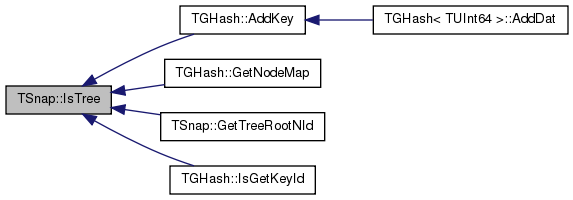
| bool TSnap::IsWeaklyConn | ( | const PGraph & | Graph | ) |
Tests whether the Graph is weakly connected.
Definition at line 293 of file cncom.h.
References gfDirected, HasGraphFlag, and TSnapQueue< TVal >::Push().
Referenced by IsConnected().
{
THashSet<TInt> VisitedNId(Graph->GetNodes());
TSnapQueue<int> NIdQ(Graph->GetNodes()+1);
typename PGraph::TObj::TNodeI NI;
// the rest of the nodes
NIdQ.Push(Graph->BegNI().GetId());
while (! NIdQ.Empty()) {
const typename PGraph::TObj::TNodeI Node = Graph->GetNI(NIdQ.Top()); NIdQ.Pop();
if (HasGraphFlag(typename PGraph::TObj, gfDirected)) {
for (int e = 0; e < Node.GetInDeg(); e++) {
const int InNId = Node.GetInNId(e);
if (! VisitedNId.IsKey(InNId)) { NIdQ.Push(InNId); VisitedNId.AddKey(InNId); }
}
}
for (int e = 0; e < Node.GetOutDeg(); e++) {
const int OutNId = Node.GetOutNId(e);
if (! VisitedNId.IsKey(OutNId)) { NIdQ.Push(OutNId); VisitedNId.AddKey(OutNId); }
}
}
if (VisitedNId.Len() < Graph->GetNodes()) { return false; }
return true;
}


| PGraph TSnap::LoadConnList | ( | const TStr & | InFNm | ) |
Loads a (directed, undirected or multi) graph from a text file InFNm with 1 node and all its edges in a single line.
Loads Whitespace separated file of several columns: <source node="" id>=""> <destination node="" id1>=""> <destination node="" id2>="">
Whitespace separated file of several columns: <source node="" id>=""> <destination node="" id1>=""> <destination node="" id2>=""> ... First column of each line contains a source node id followed by ids of the destination nodes. For example, '1 2 3' encodes edges 1-->2 and 1-->3. Note that this format allows for saving isolated nodes.
Definition at line 152 of file gio.h.
References TSsParser::GetInt(), TSsParser::IsInt(), TSsParser::Len(), TSsParser::Next(), and ssfWhiteSep.
{
TSsParser Ss(InFNm, ssfWhiteSep, true, true, true);
PGraph Graph = PGraph::TObj::New();
while (Ss.Next()) {
if (! Ss.IsInt(0)) { continue; }
const int SrcNId = Ss.GetInt(0);
if (! Graph->IsNode(SrcNId)) { Graph->AddNode(SrcNId); }
for (int dst = 1; dst < Ss.Len(); dst++) {
const int DstNId = Ss.GetInt(dst);
if (! Graph->IsNode(DstNId)) { Graph->AddNode(DstNId); }
Graph->AddEdge(SrcNId, DstNId);
}
}
Graph->Defrag();
return Graph;
}
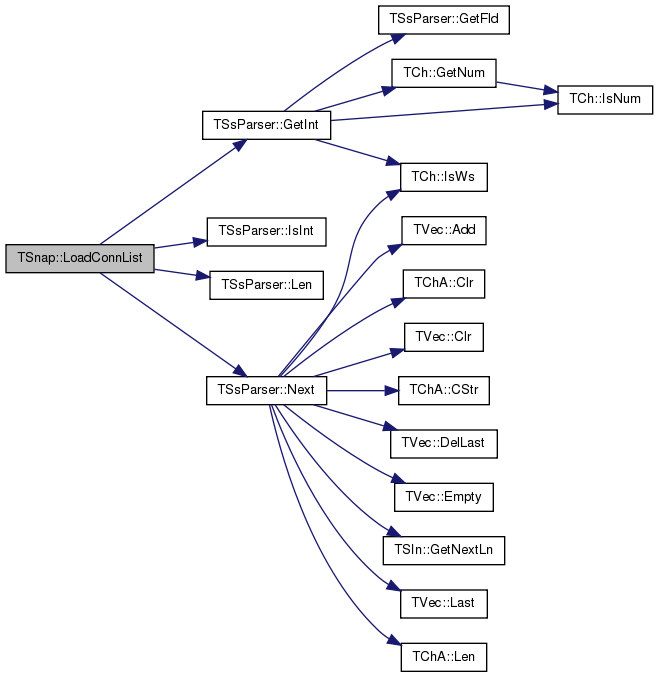
| PGraph TSnap::LoadConnListStr | ( | const TStr & | InFNm, |
| TStrHash< TInt > & | StrToNIdH | ||
| ) |
Loads a (directed, undirected or multi) graph from a text file InFNm with 1 node and all its edges in a single line.
Loads Whitespace separated file of several columns: <source node="" id>=""> <destination node="" id1>=""> <destination node="" id2>="">, with a mapping of strings to node IDs.
Whitespace separated file of several columns: <source node="" name>=""> <destination node name 1> <destination node name 2> ... First colum of each line contains a source node name followed by ids of the destination nodes. For example, 'A B C' encodes edges A-->B and A-->C. Note that this format allows for saving isolated nodes. stores the mapping from node names to node ids.
Definition at line 176 of file gio.h.
References TStrHash< TDat, TStringPool, THashFunc >::AddDatId(), TSsParser::Len(), TSsParser::Next(), and ssfWhiteSep.
{
TSsParser Ss(InFNm, ssfWhiteSep, true, true, true);
PGraph Graph = PGraph::TObj::New();
while (Ss.Next()) {
const int SrcNId = StrToNIdH.AddDatId(Ss[0]);
if (! Graph->IsNode(SrcNId)) { Graph->AddNode(SrcNId); }
for (int dst = 1; dst < Ss.Len(); dst++) {
const int DstNId = StrToNIdH.AddDatId(Ss[dst]);
if (! Graph->IsNode(DstNId)) { Graph->AddNode(DstNId); }
Graph->AddEdge(SrcNId, DstNId);
}
}
Graph->Defrag();
return Graph;
}
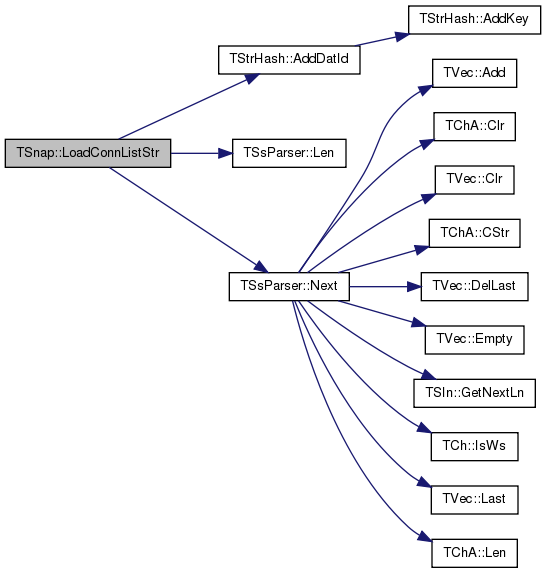
| PNGraph TSnap::LoadDyNet | ( | const TStr & | FNm | ) |
For more info see ORA Network Analysis Data (http://www.casos.cs.cmu.edu/computational_tools/data2.php)
Loads a directed network in the DyNetML format. Loads only the first network in the file FNm.
Definition at line 4 of file gio.cpp.
References TNGraph::AddEdge(), THashSet< TKey, THashFunc >::AddKey(), TNGraph::AddNode(), TXmlLx::GetArg(), THashSet< TKey, THashFunc >::GetKeyId(), TXmlLx::GetSym(), IAssert, TNGraph::IsNode(), TZipIn::IsZipFNm(), TZipIn::New(), TFIn::New(), TNGraph::New(), TXmlLx::Sym, TXmlLx::TagNm, xspTruncate, xsyEof, and xsySTag.
{
TXmlLx XmlLx(TZipIn::IsZipFNm(FNm)?TZipIn::New(FNm):TFIn::New(FNm), xspTruncate);
THashSet<TStr> NIdStr;
while (XmlLx.GetSym()!=xsyEof) {
if (XmlLx.Sym==xsySTag && XmlLx.TagNm=="network") {
PNGraph G = TNGraph::New();
XmlLx.GetSym();
while (XmlLx.TagNm=="link") {
TStr Str1, Val1, Str2, Val2;
XmlLx.GetArg(0, Str1, Val1); XmlLx.GetArg(1, Str2, Val2);
IAssert(Str1=="source" && Str2=="target");
NIdStr.AddKey(Val1); NIdStr.AddKey(Val2);
const int src=NIdStr.GetKeyId(Val1);
const int dst=NIdStr.GetKeyId(Val2);
if (! G->IsNode(src)) { G->AddNode(src); }
if (! G->IsNode(dst)) { G->AddNode(dst); }
G->AddEdge(src, dst);
XmlLx.GetSym();
}
return G;
}
}
return PNGraph();
}
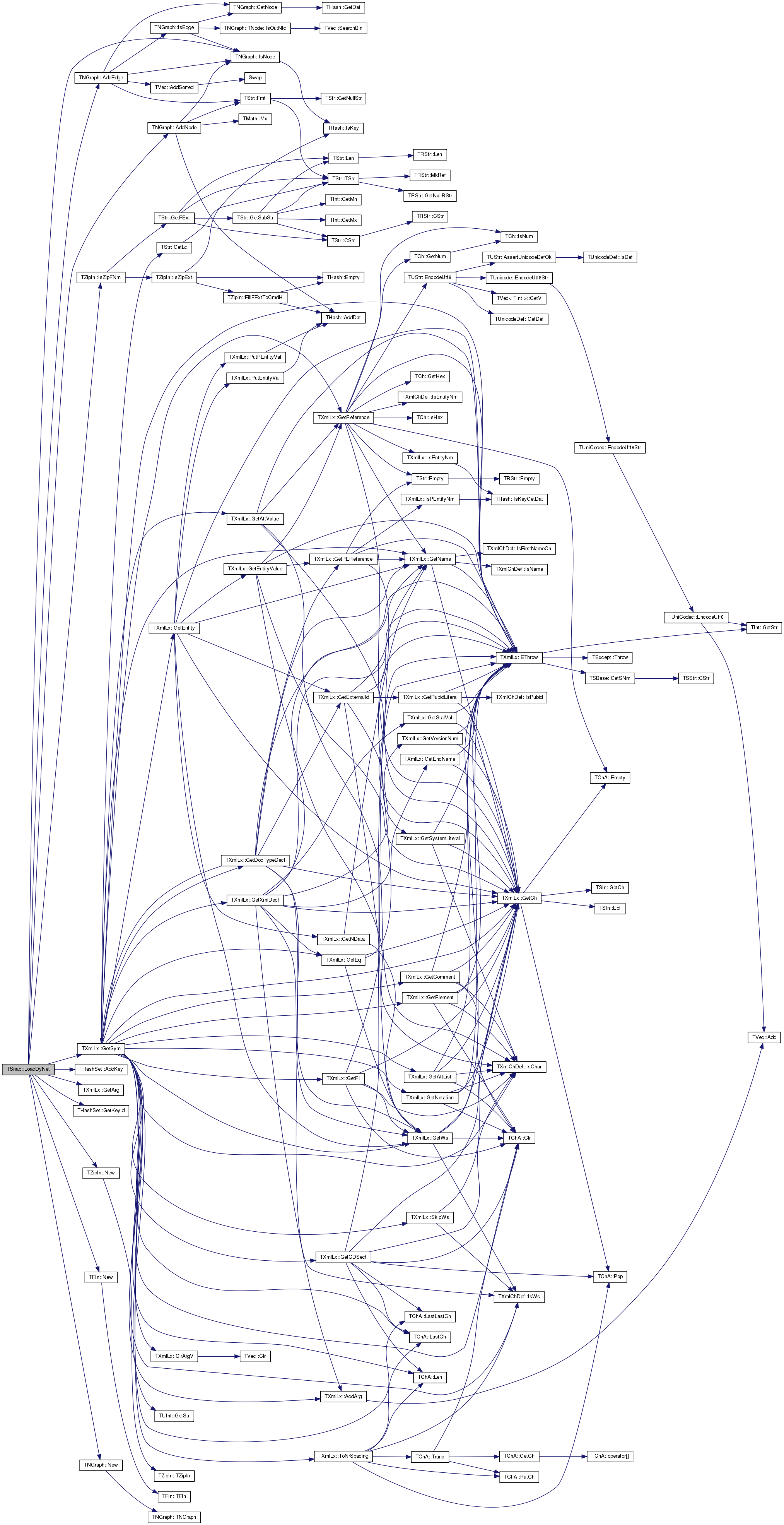
| TVec< PNGraph > TSnap::LoadDyNetGraphV | ( | const TStr & | FNm | ) |
For more info see ORA Network Analysis Data (http://www.casos.cs.cmu.edu/computational_tools/data2.php)
Loads directed networks in the DyNetML format. Loads all the networks in the file FNm.
Definition at line 30 of file gio.cpp.
References TVec< TVal >::Add(), TNGraph::AddEdge(), THashSet< TKey, THashFunc >::AddKey(), TNGraph::AddNode(), TXmlLx::GetArg(), THashSet< TKey, THashFunc >::GetKeyId(), TXmlLx::GetSym(), IAssert, TNGraph::IsNode(), TZipIn::IsZipFNm(), TZipIn::New(), TFIn::New(), TNGraph::New(), TXmlLx::Sym, TXmlLx::TagNm, xspTruncate, xsyEof, and xsySTag.
{
TXmlLx XmlLx(TZipIn::IsZipFNm(FNm)?TZipIn::New(FNm):TFIn::New(FNm), xspTruncate);
TVec<PNGraph> GraphV;
THashSet<TStr> NIdStr;
while (XmlLx.GetSym()!=xsyEof) {
if (XmlLx.Sym==xsySTag && XmlLx.TagNm=="network") {
PNGraph G = TNGraph::New();
GraphV.Add(G);
XmlLx.GetSym();
while (XmlLx.TagNm=="link") {
TStr Str1, Val1, Str2, Val2;
XmlLx.GetArg(0, Str1, Val1); XmlLx.GetArg(1, Str2, Val2);
IAssert(Str1=="source" && Str2=="target");
NIdStr.AddKey(Val1); NIdStr.AddKey(Val2);
const int src=NIdStr.GetKeyId(Val1);
const int dst=NIdStr.GetKeyId(Val2);
if (! G->IsNode(src)) { G->AddNode(src); }
if (! G->IsNode(dst)) { G->AddNode(dst); }
G->AddEdge(src, dst);
XmlLx.GetSym();
}
}
}
return GraphV;
}
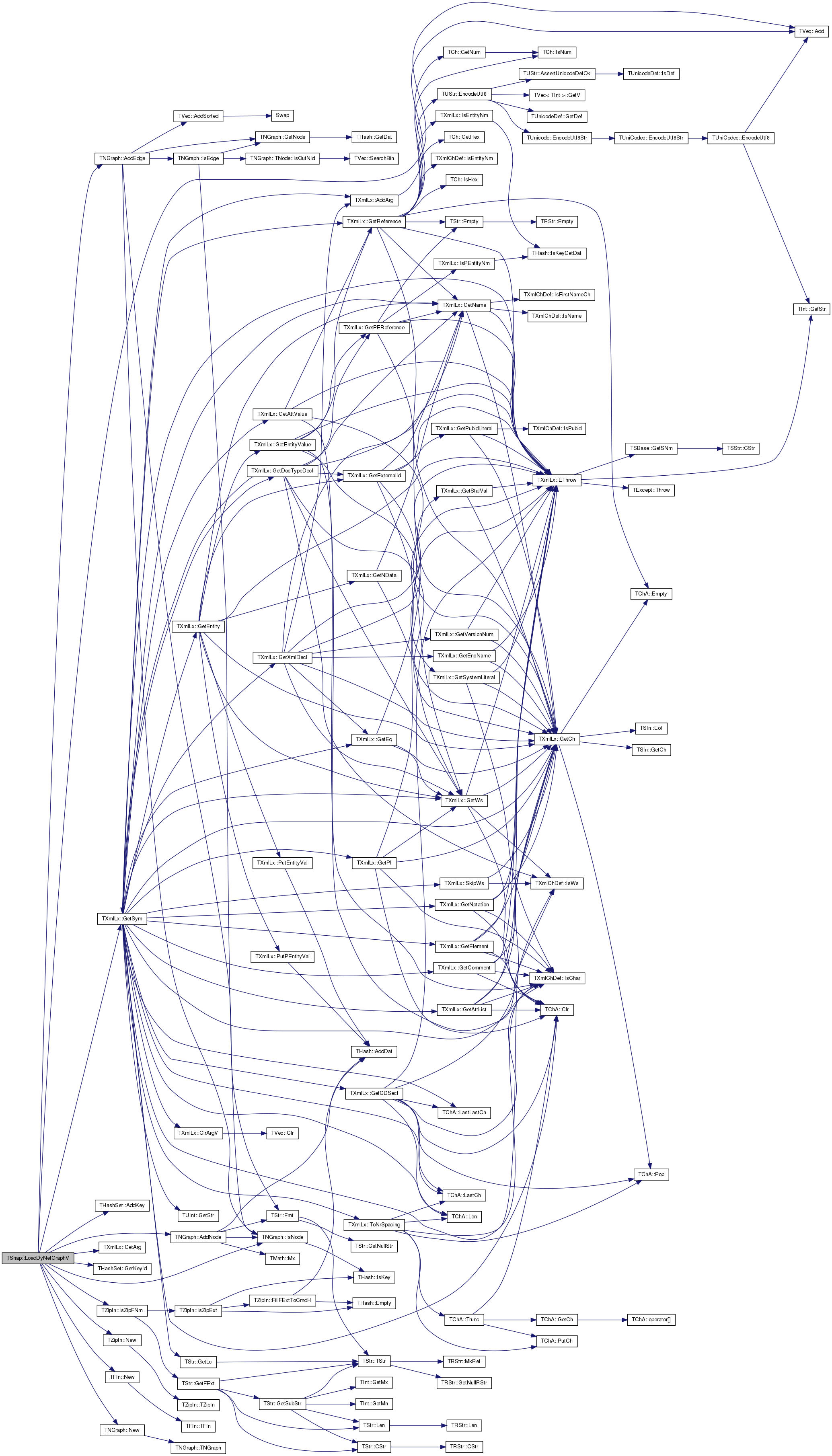
| PGraph TSnap::LoadEdgeList | ( | const TStr & | InFNm, |
| const int & | SrcColId, | ||
| const int & | DstColId | ||
| ) |
Loads a (directed, undirected or multi) graph from a text file InFNm with 1 edge per line (whitespace separated columns, integer node ids).
Loads the format saved by TSnap::SaveEdgeList()
Whitespace separated file of several columns: ... <source node="" id>=""> ... <destination node="" id>=""> ... SrcColId and DstColId are column indexes of source/destination (integer!) node ids. This means there is one edge per line and node IDs are assumed to be integers.
Definition at line 68 of file gio.h.
References TSsParser::GetInt(), TSsParser::Next(), and ssfWhiteSep.
{
TSsParser Ss(InFNm, ssfWhiteSep, true, true, true);
PGraph Graph = PGraph::TObj::New();
int SrcNId, DstNId;
while (Ss.Next()) {
if (! Ss.GetInt(SrcColId, SrcNId) || ! Ss.GetInt(DstColId, DstNId)) { continue; }
if (! Graph->IsNode(SrcNId)) { Graph->AddNode(SrcNId); }
if (! Graph->IsNode(DstNId)) { Graph->AddNode(DstNId); }
Graph->AddEdge(SrcNId, DstNId);
}
Graph->Defrag();
return Graph;
}
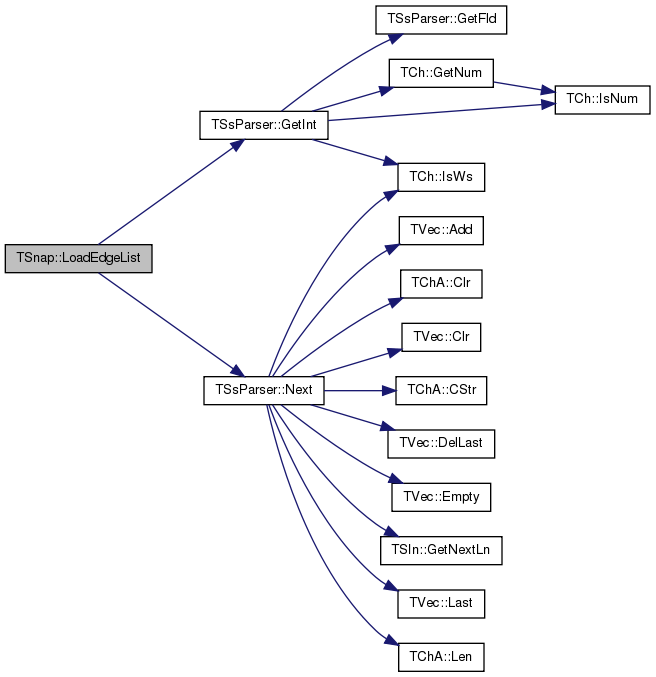
| PGraph TSnap::LoadEdgeList | ( | const TStr & | InFNm, |
| const int & | SrcColId, | ||
| const int & | DstColId, | ||
| const char & | Separator | ||
| ) |
Loads a (directed, undirected or multi) graph from a text file InFNm with 1 edge per line ('Separator' separated columns, integer node ids).
Loads the format saved by TSnap::SaveEdgeList() if we set Separator=''.
'Separator' separated file of several columns: ... <source node="" id>=""> ... <destination node="" id>=""> ... SrcColId and DstColId are column indexes of source/destination (integer!) node ids. This means there is one edge per line and node IDs are assumed to be integers.
Definition at line 88 of file gio.h.
References TSsParser::GetInt(), and TSsParser::Next().
{
TSsParser Ss(InFNm, Separator);
PGraph Graph = PGraph::TObj::New();
int SrcNId, DstNId;
while (Ss.Next()) {
if (! Ss.GetInt(SrcColId, SrcNId) || ! Ss.GetInt(DstColId, DstNId)) { continue; }
if (! Graph->IsNode(SrcNId)) { Graph->AddNode(SrcNId); }
if (! Graph->IsNode(DstNId)) { Graph->AddNode(DstNId); }
Graph->AddEdge(SrcNId, DstNId);
}
Graph->Defrag();
return Graph;
}
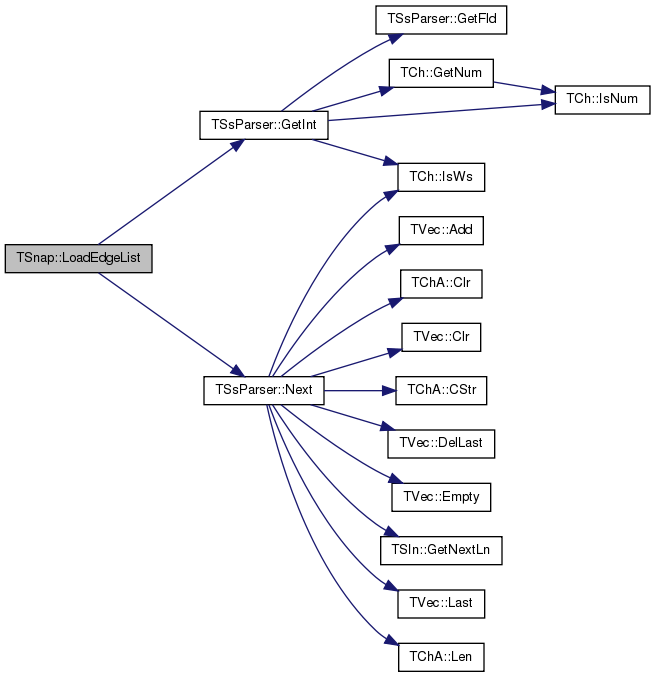
| PGraph TSnap::LoadEdgeListStr | ( | const TStr & | InFNm, |
| const int & | SrcColId, | ||
| const int & | DstColId | ||
| ) |
Loads a (directed, undirected or multi) graph from a text file InFNm with 1 edge per line (whitespace separated columns, arbitrary string node ids).
Loads the format saved by TSnap::SaveEdgeList(), where node IDs are strings.
Whitespace separated file of several columns: ... <source node="" id>=""> ... <destination node="" id>=""> ... SrcColId and DstColId are column indexes of source/destination (string) node ids. This means there is one edge per line and node IDs can be arbitrary STRINGs. Note that the mapping of node names to ids is discarded.
Definition at line 109 of file gio.h.
References TStrHash< TDat, TStringPool, THashFunc >::AddKey(), Mega, TSsParser::Next(), and ssfWhiteSep.
{
TSsParser Ss(InFNm, ssfWhiteSep);
PGraph Graph = PGraph::TObj::New();
TStrHash<TInt> StrToNIdH(Mega(1), true); // hash-table mapping strings to integer node ids
while (Ss.Next()) {
const int SrcNId = StrToNIdH.AddKey(Ss[SrcColId]);
const int DstNId = StrToNIdH.AddKey(Ss[DstColId]);
if (! Graph->IsNode(SrcNId)) { Graph->AddNode(SrcNId); }
if (! Graph->IsNode(DstNId)) { Graph->AddNode(DstNId); }
Graph->AddEdge(SrcNId, DstNId);
}
Graph->Defrag();
return Graph;
}
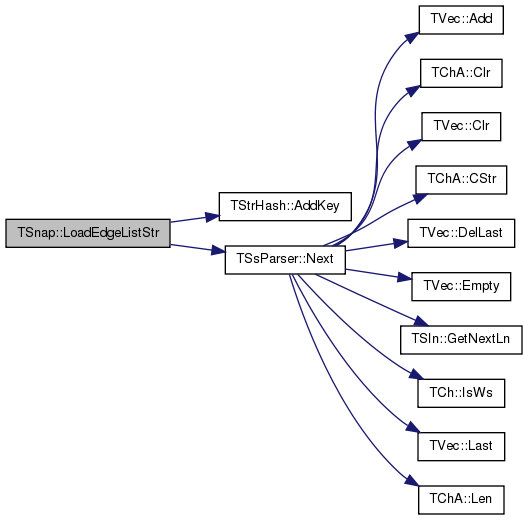
| PGraph TSnap::LoadEdgeListStr | ( | const TStr & | InFNm, |
| const int & | SrcColId, | ||
| const int & | DstColId, | ||
| TStrHash< TInt > & | StrToNIdH | ||
| ) |
Loads a (directed, undirected or multi) graph from a text file InFNm with 1 edge per line (whitespace separated columns, arbitrary string node ids).
Loads the format saved by TSnap::SaveEdgeList(), where node IDs are strings and mapping of strings to node ids are stored.
Whitespace separated file of several columns: ... <source node="" id>=""> ... <destination node="" id>=""> ... SrcColId and DstColId are column indexes of source/destination (string) node ids. This means there is one edge per line and node IDs can be arbitrary STRINGs. The mapping of strings to node ids in stored in StrToNIdH. To map between node names and ids use: NId = StrToNIdH.GetKeyId(NodeName) and TStr NodeName = StrToNIdH.GetKey(NId);
Definition at line 132 of file gio.h.
References TStrHash< TDat, TStringPool, THashFunc >::AddKey(), TSsParser::Next(), and ssfWhiteSep.
{
TSsParser Ss(InFNm, ssfWhiteSep);
PGraph Graph = PGraph::TObj::New();
while (Ss.Next()) {
const int SrcNId = StrToNIdH.AddKey(Ss[SrcColId]);
const int DstNId = StrToNIdH.AddKey(Ss[DstColId]);
if (! Graph->IsNode(SrcNId)) { Graph->AddNode(SrcNId); }
if (! Graph->IsNode(DstNId)) { Graph->AddNode(DstNId); }
Graph->AddEdge(SrcNId, DstNId);
}
Graph->Defrag();
return Graph;
}
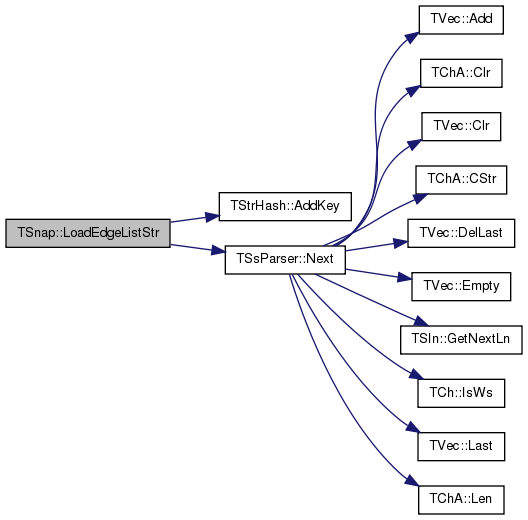
| PGraph TSnap::LoadPajek | ( | const TStr & | InFNm | ) |
Loads a (directed, undirected or multi) graph from Pajek .PAJ format file.
Function supports both the 1 edge per line (<source> <destination> <weight>) as well as the 1 node per line (<source> <destination1> <destination2> ...) formats.
Definition at line 193 of file gio.h.
References EAssert, TSsParser::Eof(), TSsParser::GetInt(), TSsParser::IsInt(), TSsParser::Len(), TSsParser::Next(), ssfSpaceSep, and TSsParser::ToLc().
{
PGraph Graph = PGraph::TObj::New();
TSsParser Ss(InFNm, ssfSpaceSep, true, true, true);
while ((Ss.Len()==0 || strstr(Ss[0], "*vertices") == NULL) && ! Ss.Eof()) {
Ss.Next(); Ss.ToLc(); }
// nodes
bool EdgeList = true;
EAssert(strstr(Ss[0], "*vertices") != NULL);
while (Ss.Next()) {
Ss.ToLc();
if (Ss.Len()>0 && Ss[0][0] == '%') { continue; } // comment
if (strstr(Ss[0], "*arcslist")!=NULL || strstr(Ss[0],"*edgeslist")!=NULL) { EdgeList=false; break; }
if (strstr(Ss[0], "*arcs")!=NULL || strstr(Ss[0],"*edges")!=NULL) { break; } // arcs are directed, edges are undirected
Graph->AddNode(Ss.GetInt(0));
}
// edges
while (Ss.Next()) {
if (Ss.Len()>0 && Ss[0][0] == '%') { continue; } // comment
if (Ss.Len()>0 && Ss[0][0] == '*') { break; }
if (EdgeList) {
// <source> <destination> <weight>
if (Ss.Len() >= 3 && Ss.IsInt(0) && Ss.IsInt(1)) {
Graph->AddEdge(Ss.GetInt(0), Ss.GetInt(1)); }
} else {
// <source> <destination1> <destination2> <destination3> ...
const int SrcNId = Ss.GetInt(0);
for (int i = 1; i < Ss.Len(); i++) {
Graph->AddEdge(SrcNId, Ss.GetInt(i)); }
}
}
return Graph;
}
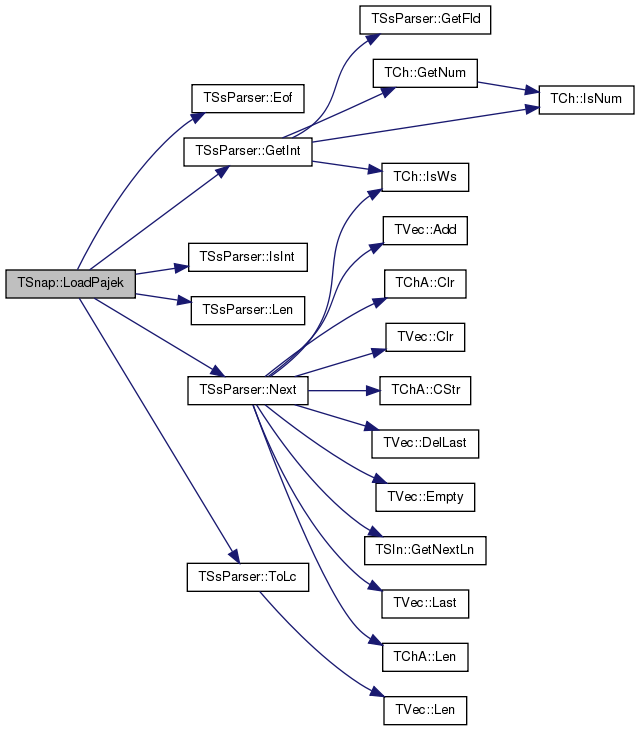
| void TSnap::MakeUnDir | ( | const PGraph & | Graph | ) |
Definition at line 330 of file alg.h.
References TVec< TVal >::Add(), CAssert, gfDirected, HasGraphFlag, and TVec< TVal >::Len().
Referenced by GetUnDir().
{
CAssert(HasGraphFlag(typename PGraph::TObj, gfDirected)); // graph has to be directed
TIntPrV EdgeV;
for (typename PGraph::TObj::TEdgeI EI = Graph->BegEI(); EI < Graph->EndEI(); EI++) {
const int SrcNId = EI.GetSrcNId();
const int DstNId = EI.GetDstNId();
if (! Graph->IsEdge(DstNId, SrcNId)) {
EdgeV.Add(TIntPr(DstNId, SrcNId));
}
}
for (int i = 0; i < EdgeV.Len(); i++) {
Graph->AddEdge(EdgeV[i].Val1, EdgeV[i].Val2);
}
}


| void TSnap::PlotClustCf | ( | const PGraph & | Graph, |
| const TStr & | FNmPref, | ||
| TStr | DescStr = TStr() |
||
| ) |
Plots the distribution of clustering coefficient of a Graph.
Definition at line 107 of file statplot.h.
References TGnuPlot::AddPlot(), TStr::CStr(), TStr::Empty(), TStr::Fmt(), GetClustCf(), gpsLog10XY, gpwLinesPoints, TGnuPlot::SavePng(), TGnuPlot::SetScale(), and TGnuPlot::SetXYLabel().
{
TFltPrV DegToCCfV;
int ClosedTriads, OpenTriads;
const double CCF = GetClustCf(Graph, DegToCCfV, ClosedTriads, OpenTriads);
if (DescStr.Empty()) { DescStr = FNmPref; }
TGnuPlot GnuPlot("ccf."+FNmPref,
TStr::Fmt("%s. G(%d, %d). Average clustering: %.4f OpenTriads: %d (%.4f) ClosedTriads: %d (%.4f)", DescStr.CStr(), Graph->GetNodes(), Graph->GetEdges(),
CCF, OpenTriads, OpenTriads/double(OpenTriads+ClosedTriads), ClosedTriads, ClosedTriads/double(OpenTriads+ClosedTriads)));
GnuPlot.AddPlot(DegToCCfV, gpwLinesPoints, "", "pt 6");
GnuPlot.SetXYLabel("Node degree", "Average clustering coefficient");
GnuPlot.SetScale(gpsLog10XY);
GnuPlot.SavePng();
}
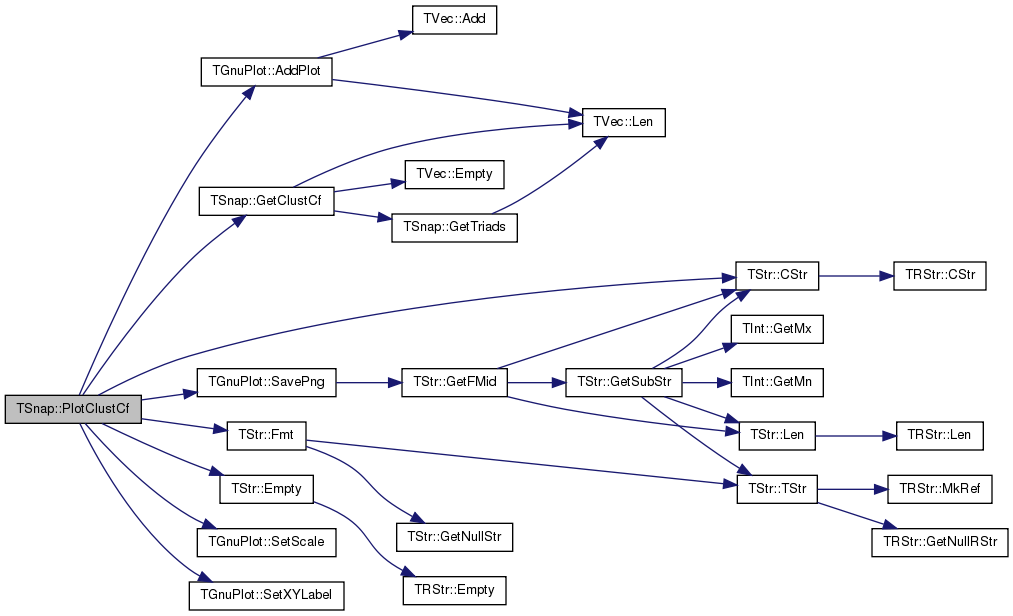
| void TSnap::PlotEigValDistr | ( | const PUNGraph & | Graph, |
| const int & | EigVals, | ||
| const TStr & | FNmPref, | ||
| TStr | DescStr | ||
| ) |
Plots the distribution of components of the leading eigen-vector of the Graph adjacency matrix. Plots first EigVals values.
Definition at line 14 of file statplot.cpp.
References THash< TKey, TDat, THashFunc >::AddDat(), TStr::CStr(), TVec< TVal >::Empty(), TStr::Empty(), TStr::Fmt(), GetEigVals(), THash< TKey, TDat, THashFunc >::GetKeyDatPrV(), gpsAuto, gpwLinesPoints, TVec< TVal >::Last(), TVec< TVal >::Len(), TGnuPlot::PlotValV(), and TVec< TVal >::Sort().
{
const int NBuckets = 50;
TFltV EigValV;
for (int f = 1; EigValV.Empty() && f < 4; f++) {
TSnap::GetEigVals(Graph, f*EigVals, EigValV);
}
EigValV.Sort(true);
THash<TFlt, TFlt> BucketCntH;
double Step = (EigValV.Last()-EigValV[0]) / double(NBuckets-1);
for (int i = 0; i < NBuckets; i++) {
BucketCntH.AddDat(EigValV[0]+Step*(i+0.5), 0);
}
for (int i = 0; i < EigValV.Len(); i++) {
const int Bucket = (int) floor((EigValV[i]-EigValV[0]) / Step);
BucketCntH[Bucket] += 1;
}
TFltPrV EigCntV;
BucketCntH.GetKeyDatPrV(EigCntV);
if (DescStr.Empty()) { DescStr = FNmPref; }
TGnuPlot::PlotValV(EigCntV, "eigDistr."+FNmPref, TStr::Fmt("%s. G(%d, %d). Largest eig val = %f", DescStr.CStr(),
Graph->GetNodes(), Graph->GetEdges(), EigValV.Last().Val), "Eigen value", "Count", gpsAuto, false, gpwLinesPoints);
}
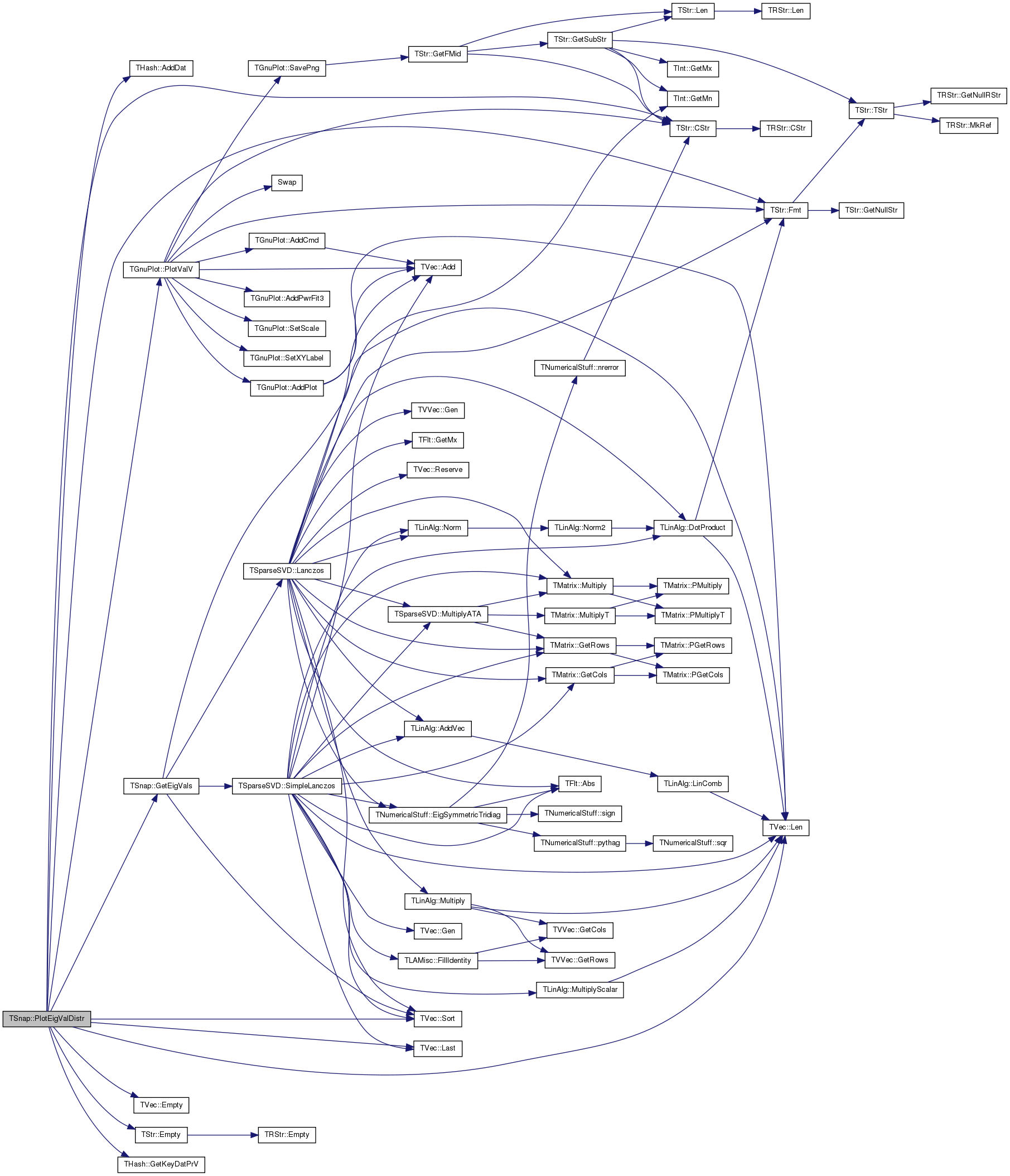
| void TSnap::PlotEigValRank | ( | const PUNGraph & | Graph, |
| const int & | EigVals, | ||
| const TStr & | FNmPref, | ||
| TStr | DescStr | ||
| ) |
Plots the eigen-value rank distribution of the Graph adjacency matrix. Plots first EigVals eigenvalues.
Definition at line 5 of file statplot.cpp.
References TStr::CStr(), TStr::Empty(), TStr::Fmt(), GetEigVals(), gpsLog10XY, gpwLinesPoints, TGnuPlot::PlotValV(), and TVec< TVal >::Sort().
{
TFltV EigValV;
TSnap::GetEigVals(Graph, EigVals, EigValV);
EigValV.Sort(false);
if (DescStr.Empty()) { DescStr = FNmPref; }
TGnuPlot::PlotValV(EigValV, "eigVal."+FNmPref, TStr::Fmt("%s. G(%d, %d). Largest eig val = %f",
DescStr.CStr(), Graph->GetNodes(), Graph->GetEdges(), EigValV[0].Val), "Rank", "Eigen value", gpsLog10XY, false, gpwLinesPoints);
}
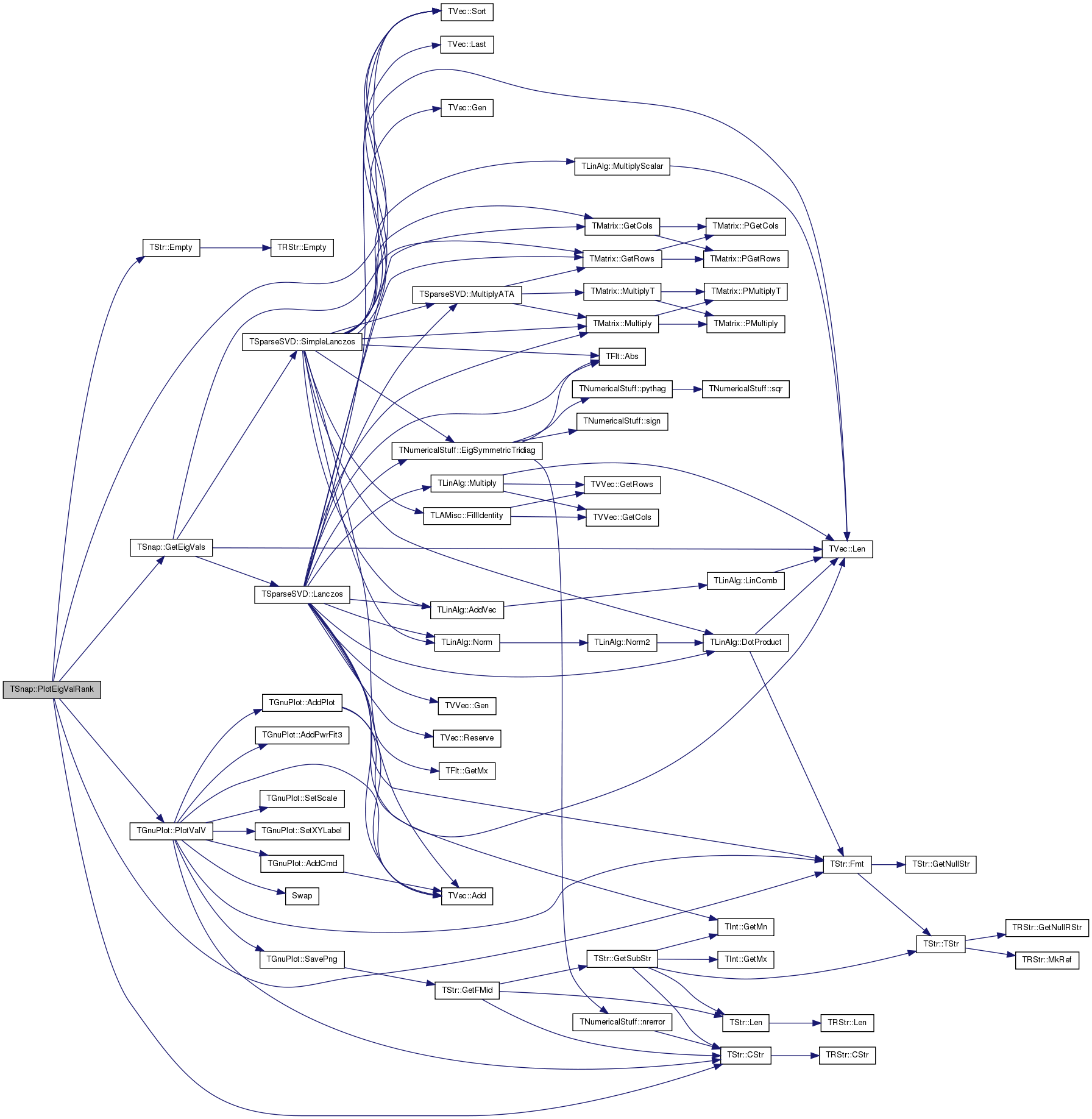
| void TSnap::PlotHops | ( | const PGraph & | Graph, |
| const TStr & | FNmPref, | ||
| const TStr & | DescStr, | ||
| const bool & | IsDir = false, |
||
| const int & | NApprox = 32 |
||
| ) |
Plots the cumulative distribution of the shortest path lengths of a Graph. Implementation is based on ANF.
| IsDir | false: ignore edge directions and consider graph as undirected. |
Definition at line 122 of file statplot.h.
References TGnuPlot::AddPlot(), TSnap::TSnapDetail::CalcEffDiam(), TStr::CStr(), TStr::Fmt(), GetAnf(), gpsLog10Y, gpwLinesPoints, TGnuPlot::SavePng(), TGnuPlot::SetScale(), and TGnuPlot::SetXYLabel().
{
TIntFltKdV DistNbrsV;
TSnap::GetAnf(Graph, DistNbrsV, -1, IsDir, NApprox);
const double EffDiam = TSnap::TSnapDetail::CalcEffDiam(DistNbrsV, 0.9);
TGnuPlot GnuPlot("hop."+FNmPref, TStr::Fmt("%s. Hop plot. EffDiam: %g, G(%d, %d)",
DescStr.CStr(), EffDiam, Graph->GetNodes(), Graph->GetEdges()));
GnuPlot.SetXYLabel("Number of hops", "Number of pairs of nodes");
GnuPlot.SetScale(gpsLog10Y);
GnuPlot.AddPlot(DistNbrsV, gpwLinesPoints, "");
GnuPlot.SavePng();
}
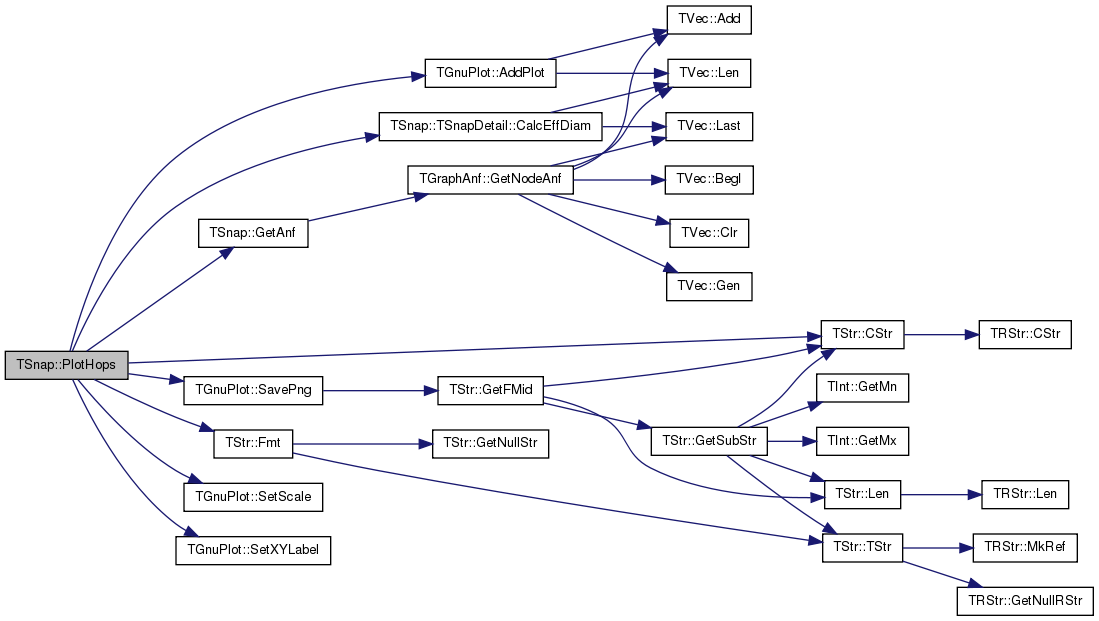
| void TSnap::PlotInDegDistr | ( | const PGraph & | Graph, |
| const TStr & | FNmPref, | ||
| TStr | DescStr = TStr(), |
||
| const bool & | PlotCCdf = false, |
||
| const bool & | PowerFit = false |
||
| ) |
Plots the in-degree distribution of a Graph.
| PlotCCdf | Plots the distribution as a Complementary Cummulative distribution function. |
| PowerFit | Fits a Power-Law to the distribution. |
Definition at line 43 of file statplot.h.
References TStr::CStr(), TStr::Empty(), TStr::Fmt(), TGUtil::GetCCdf(), GetInDegCnt(), gpsLog10XY, gpwLinesPoints, TVec< TVal >::Len(), and TGnuPlot::PlotValV().
{
TIntPrV DegCntV;
TSnap::GetInDegCnt(Graph, DegCntV);
const double AvgDeg = 2*Graph->GetEdges()/double(Graph->GetNodes());
int AboveAvg=0, Above2Avg=0;
for (int i = 0; i < DegCntV.Len(); i++) {
if (DegCntV[i].Val1 > AvgDeg) { AboveAvg += DegCntV[i].Val2; }
if (DegCntV[i].Val1 > 2*AvgDeg) { Above2Avg += DegCntV[i].Val2; }
}
if (PlotCCdf) {
DegCntV = TGUtil::GetCCdf(DegCntV); }
if (DescStr.Empty()) { DescStr = FNmPref; }
TGnuPlot::PlotValV(DegCntV, (PlotCCdf?"inDegC.":"inDeg.")+FNmPref,
TStr::Fmt("%s. G(%d, %d). %d (%.4f) nodes with in-deg > avg deg (%.1f), %d (%.4f) with >2*avg.deg", DescStr.CStr(),
Graph->GetNodes(), Graph->GetEdges(), AboveAvg, AboveAvg/double(Graph->GetNodes()), AvgDeg, Above2Avg, Above2Avg/double(Graph->GetNodes())),
"In-degree", PlotCCdf?"Count (CCDF)":"Count", gpsLog10XY, PowerFit, gpwLinesPoints);
}
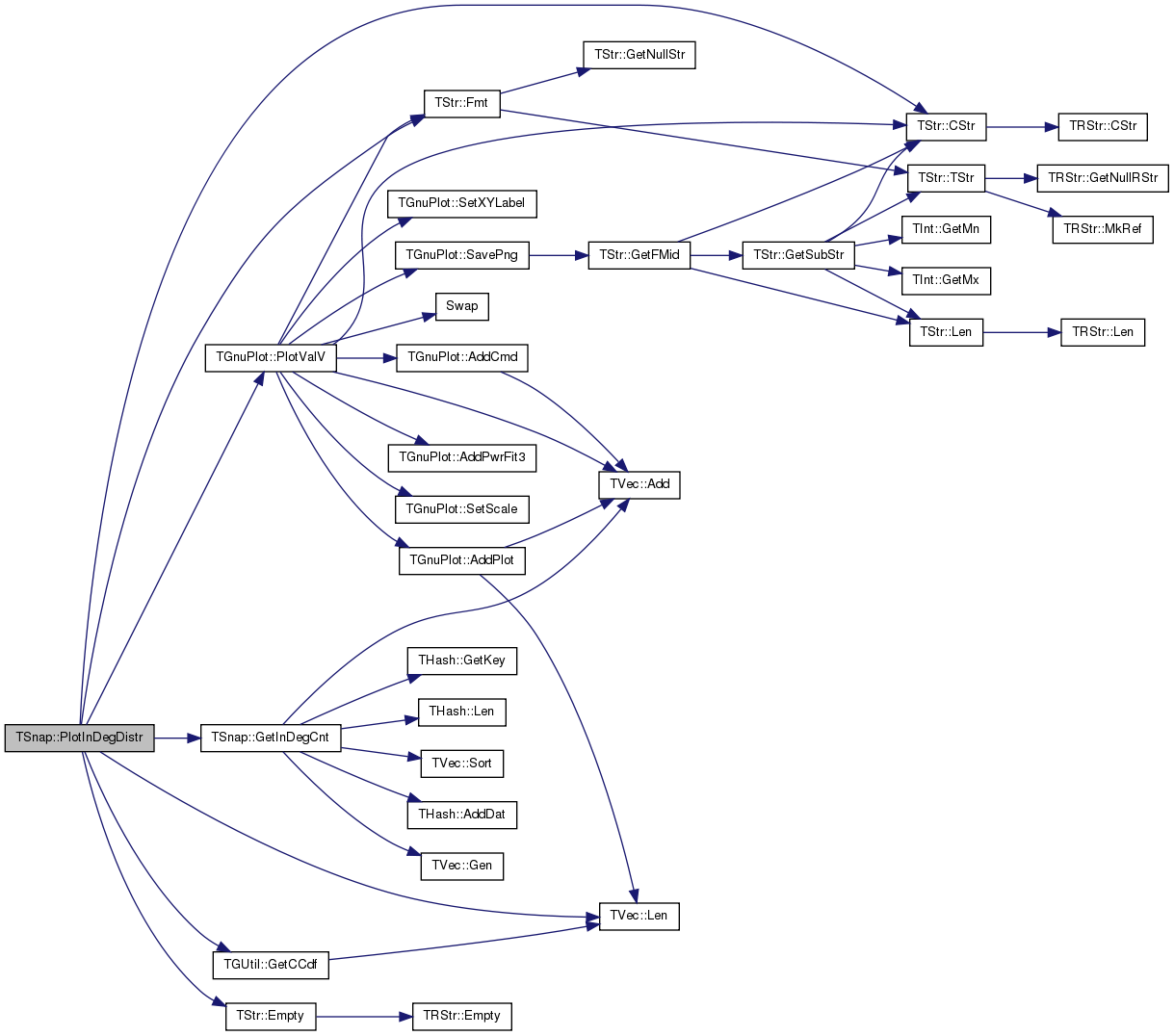
| void TSnap::PlotInvParticipRat | ( | const PUNGraph & | Graph, |
| const int & | MaxEigVecs, | ||
| const int & | TimeLimit, | ||
| const TStr & | FNmPref, | ||
| TStr | DescStr = TStr() |
||
| ) |
Plots the inverse participation ratio. See Spectra of "real-world" graphs: Beyond the semicircle law by Farkas, Derenyi, Barabasi and Vicsek.
Definition at line 39 of file statplot.cpp.
References TVec< TVal >::Add(), TStr::CStr(), TVec< TVal >::Empty(), TStr::Empty(), TStr::Fmt(), GetInvParticipRat(), gpsLog10Y, gpwPoints, TVec< TVal >::Last(), TVec< TVal >::Len(), TGnuPlot::PlotValV(), and TPair< TVal1, TVal2 >::Val1.
{
TFltPrV EigIprV;
GetInvParticipRat(Graph, MaxEigVecs, TimeLimit, EigIprV);
if (DescStr.Empty()) { DescStr = FNmPref; }
if (EigIprV.Empty()) { DescStr+=". FAIL"; EigIprV.Add(TFltPr(-1,-1)); return; }
TGnuPlot::PlotValV(EigIprV, "eigIPR."+FNmPref, TStr::Fmt("%s. G(%d, %d). Largest eig val = %f (%d values)",
DescStr.CStr(), Graph->GetNodes(), Graph->GetEdges(), EigIprV.Last().Val1(), EigIprV.Len()),
"Eigenvalue", "Inverse Participation Ratio of corresponding Eigenvector", gpsLog10Y, false, gpwPoints);
}
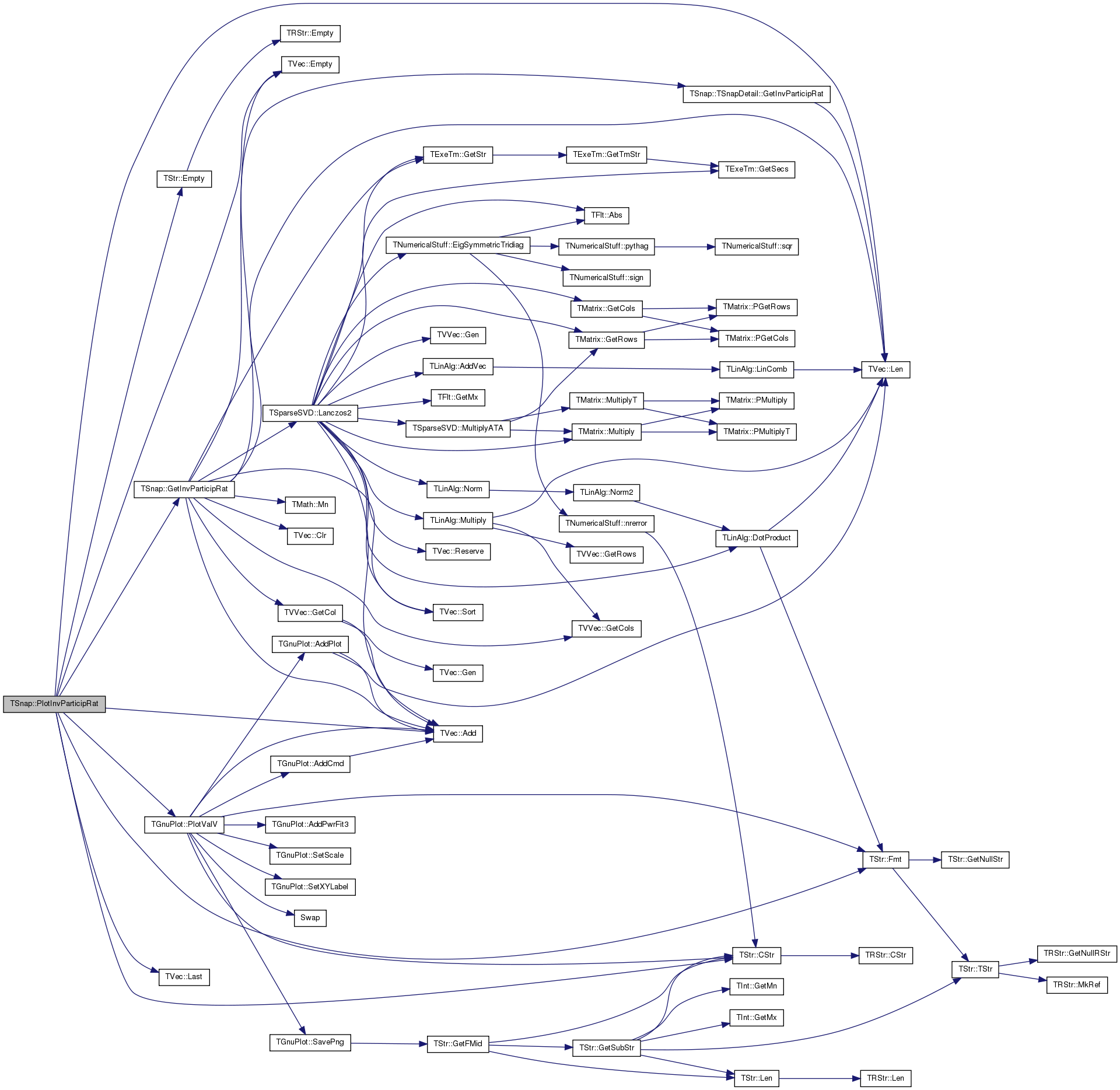
| void TSnap::PlotOutDegDistr | ( | const PGraph & | Graph, |
| const TStr & | FNmPref, | ||
| TStr | DescStr = TStr(), |
||
| const bool & | PlotCCdf = false, |
||
| const bool & | PowerFit = false |
||
| ) |
Plots the out-degree distribution of a Graph.
| PlotCCdf | Plots the distribution as a Complementary Cumulative Distribution Function (CCDF). |
| PowerFit | Fits a Power-Law to the distribution. |
Definition at line 62 of file statplot.h.
References TStr::CStr(), TStr::Empty(), TStr::Fmt(), TGUtil::GetCCdf(), GetOutDegCnt(), gpsLog10XY, gpwLinesPoints, TVec< TVal >::Len(), and TGnuPlot::PlotValV().
{
TIntPrV DegCntV;
TSnap::GetOutDegCnt(Graph, DegCntV);
const double AvgDeg = 2*Graph->GetEdges()/double(Graph->GetNodes());
int AboveAvg=0, Above2Avg=0;
for (int i = 0; i < DegCntV.Len(); i++) {
if (DegCntV[i].Val1 > AvgDeg) { AboveAvg += DegCntV[i].Val2; }
if (DegCntV[i].Val1 > 2*AvgDeg) { Above2Avg += DegCntV[i].Val2; }
}
if (PlotCCdf) {
DegCntV = TGUtil::GetCCdf(DegCntV); }
if (DescStr.Empty()) { DescStr = FNmPref; }
TGnuPlot::PlotValV(DegCntV, (PlotCCdf?"outDegC.":"outDeg.")+FNmPref,
TStr::Fmt("%s. G(%d, %d). %d (%.4f) nodes with out-deg > avg deg (%.1f), %d (%.4f) with >2*avg.deg", DescStr.CStr(),
Graph->GetNodes(), Graph->GetEdges(), AboveAvg, AboveAvg/double(Graph->GetNodes()), AvgDeg, Above2Avg, Above2Avg/double(Graph->GetNodes())),
"Out-degree", PlotCCdf?"Count (CCDF)":"Count", gpsLog10XY, PowerFit, gpwLinesPoints);
}
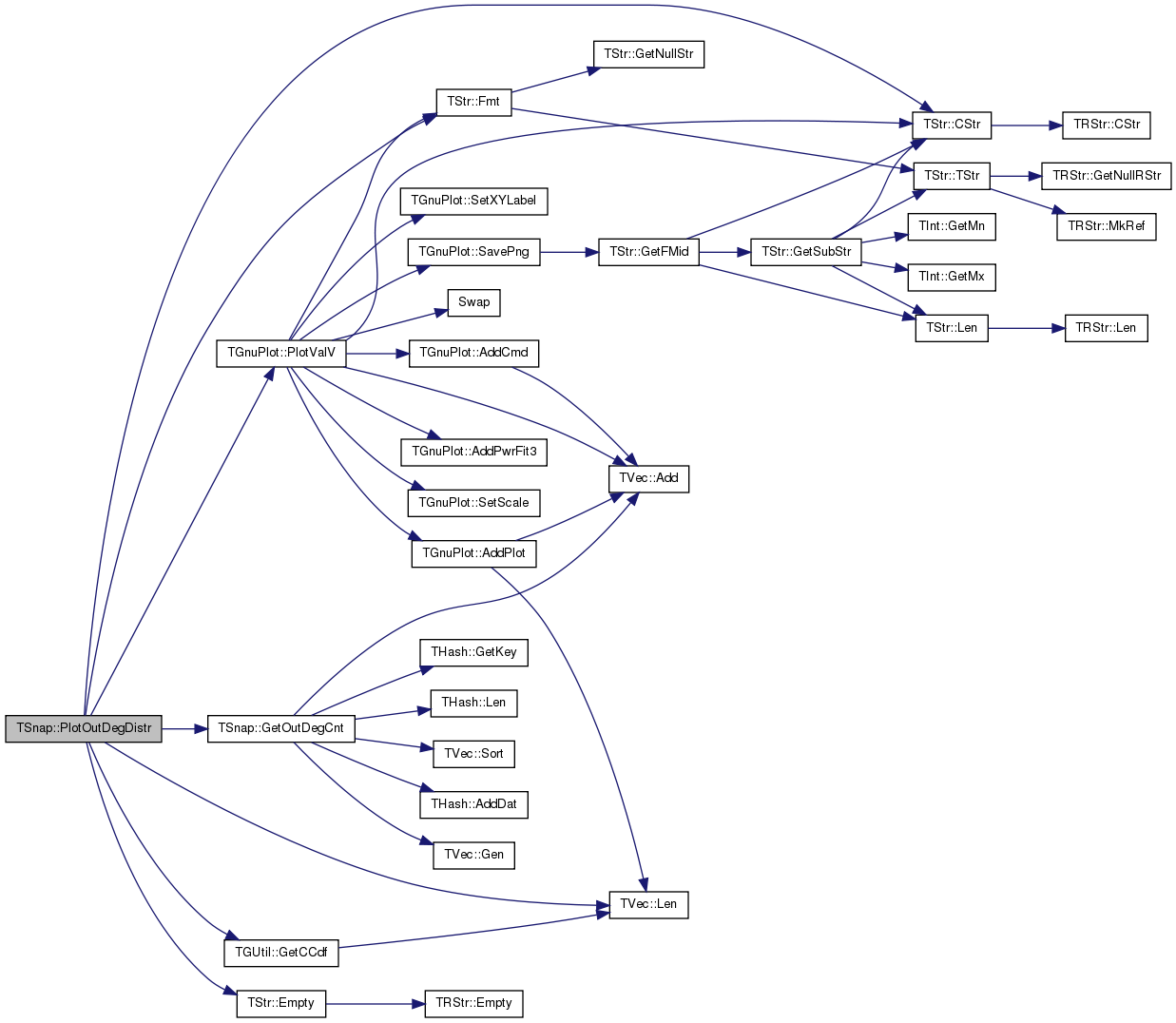
| void TSnap::PlotSccDistr | ( | const PGraph & | Graph, |
| const TStr & | FNmPref, | ||
| TStr | DescStr = TStr() |
||
| ) |
Plots the distribution of sizes of strongly connected components of a Graph.
Definition at line 94 of file statplot.h.
References TGnuPlot::AddPlot(), TStr::CStr(), TStr::Empty(), TStr::Fmt(), GetSccSzCnt(), gpsLog10XY, gpwLinesPoints, TVec< TVal >::Last(), and TPair< TVal1, TVal2 >::Val1.
{
TIntPrV SccSzCnt;
TSnap::GetSccSzCnt(Graph, SccSzCnt);
if (DescStr.Empty()) { DescStr = FNmPref; }
TGnuPlot GnuPlot("scc."+FNmPref, TStr::Fmt("%s. G(%d, %d). Largest component has %f nodes",
DescStr.CStr(), Graph->GetNodes(), Graph->GetEdges(), SccSzCnt.Last().Val1/double(Graph->GetNodes())));
GnuPlot.AddPlot(SccSzCnt, gpwLinesPoints, "", "pt 6");
GnuPlot.SetXYLabel("Size of strongly connected component", "Number of components");
GnuPlot.SetScale(gpsLog10XY);
GnuPlot.SavePng();
}
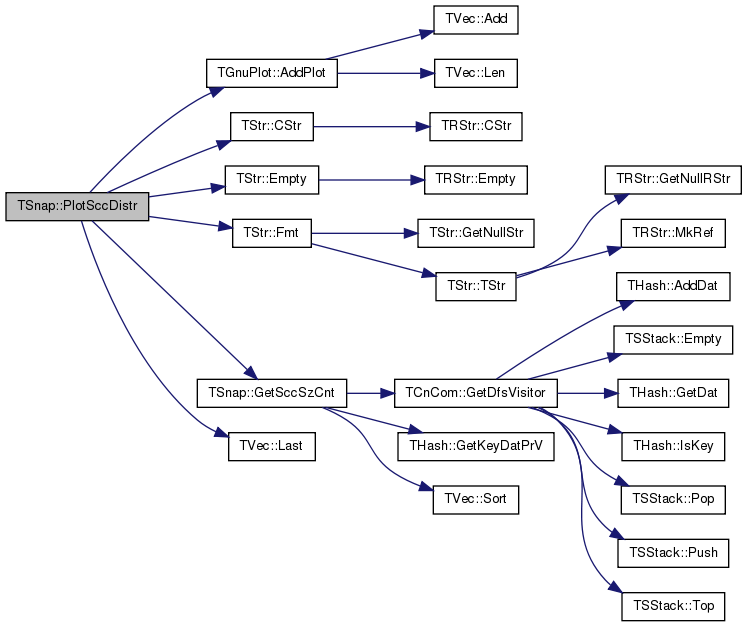
| void TSnap::PlotShortPathDistr | ( | const PGraph & | Graph, |
| const TStr & | FNmPref, | ||
| TStr | DescStr = TStr(), |
||
| int | TestNodes = TInt::Mx |
||
| ) |
Plots the distribution of the shortest path lengths of a Graph. Implementation is based on BFS.
Definition at line 135 of file statplot.h.
References TVec< TVal >::Add(), THash< TKey, TDat, THashFunc >::AddDat(), TSnap::TSnapDetail::CalcAvgDiamPdf(), TSnap::TSnapDetail::CalcEffDiamPdf(), TStr::CStr(), TBreathFS< PGraph >::DoBfs(), TStr::Empty(), TStr::Fmt(), THash< TKey, TDat, THashFunc >::GetKey(), gpsLog10Y, gpwLinesPoints, TVec< TVal >::Last(), THash< TKey, TDat, THashFunc >::Len(), TMath::Mn(), TInt::Mx, TBreathFS< PGraph >::NIdDistH, TGnuPlot::PlotValV(), TInt::Rnd, TVec< TVal >::Shuffle(), THash< TKey, TDat, THashFunc >::SortByKey(), and TPair< TVal1, TVal2 >::Val1.
{
TIntH DistToCntH;
TBreathFS<PGraph> BFS(Graph);
// shotest paths
TIntV NodeIdV;
Graph->GetNIdV(NodeIdV); NodeIdV.Shuffle(TInt::Rnd);
for (int tries = 0; tries < TMath::Mn(TestNodes, Graph->GetNodes()); tries++) {
const int NId = NodeIdV[tries];
BFS.DoBfs(NId, true, false, -1, TInt::Mx);
for (int i = 0; i < BFS.NIdDistH.Len(); i++) {
DistToCntH.AddDat(BFS.NIdDistH[i]) += 1; }
}
DistToCntH.SortByKey(true);
TFltPrV DistNbrsPdfV;
for (int i = 0; i < DistToCntH.Len(); i++) {
DistNbrsPdfV.Add(TFltPr(DistToCntH.GetKey(i)(), DistToCntH[i]()));
}
const double EffDiam = TSnap::TSnapDetail::CalcEffDiamPdf(DistNbrsPdfV, 0.9);
const double AvgDiam = TSnap::TSnapDetail::CalcAvgDiamPdf(DistNbrsPdfV);
const int FullDiam = (int) DistNbrsPdfV.Last().Val1;
if (DescStr.Empty()) { DescStr = FNmPref; }
TGnuPlot::PlotValV(DistNbrsPdfV, "diam."+FNmPref,
TStr::Fmt("%s. G(%d, %d). Diam: avg:%.2f eff:%.2f max:%d", DescStr.CStr(), Graph->GetNodes(), Graph->GetEdges(),
AvgDiam, EffDiam, FullDiam), "Number of hops", "Number of shortest paths", gpsLog10Y, false, gpwLinesPoints);
}
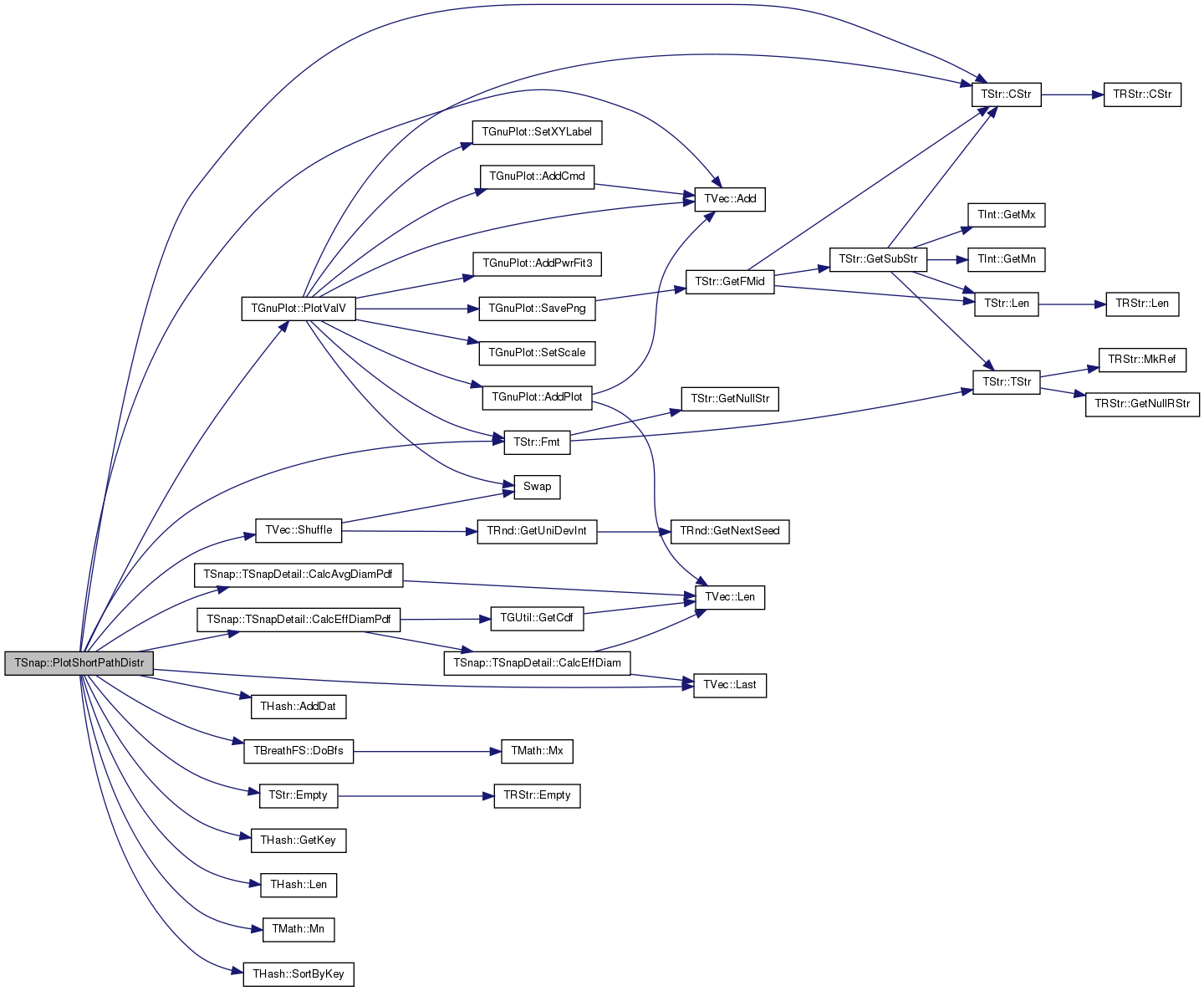
| void TSnap::PlotSngValDistr | ( | const PNGraph & | Graph, |
| const int & | SngVals, | ||
| const TStr & | FNmPref, | ||
| TStr | DescStr | ||
| ) |
Plots the rank distribution of singular values of the Graph adjacency matrix. Plots first SngVals values.
Definition at line 58 of file statplot.cpp.
References THash< TKey, TDat, THashFunc >::AddDat(), TStr::CStr(), TVec< TVal >::Empty(), TStr::Empty(), TStr::Fmt(), TNGraph::GetEdges(), THash< TKey, TDat, THashFunc >::GetKeyDatPrV(), TNGraph::GetNodes(), GetSngVals(), gpsAuto, gpwLinesPoints, TVec< TVal >::Last(), TVec< TVal >::Len(), TGnuPlot::PlotValV(), and TVec< TVal >::Sort().
{
const int NBuckets = 50;
TFltV SngValV;
for (int f = 1; SngValV.Empty() && f < 4; f++) {
TSnap::GetSngVals(Graph, f*SngVals, SngValV);
}
SngValV.Sort(true);
THash<TFlt, TFlt> BucketCntH;
double Step = (SngValV.Last()-SngValV[0]) / double(NBuckets-1);
for (int i = 0; i < NBuckets; i++) {
BucketCntH.AddDat(SngValV[0]+Step*(i+0.5), 0);
}
for (int i = 0; i < SngValV.Len(); i++) {
const int Bucket = (int) floor((SngValV[i]-SngValV[0]) / Step);
BucketCntH[Bucket] += 1;
}
TFltPrV EigCntV;
BucketCntH.GetKeyDatPrV(EigCntV);
if (DescStr.Empty()) { DescStr = FNmPref; }
TGnuPlot::PlotValV(EigCntV, "sngDistr."+FNmPref, TStr::Fmt("%s. G(%d, %d). Largest eig val = %f", DescStr.CStr(),
Graph->GetNodes(), Graph->GetEdges(), SngValV.Last().Val), "Singular value", "Count", gpsAuto, false, gpwLinesPoints);
}
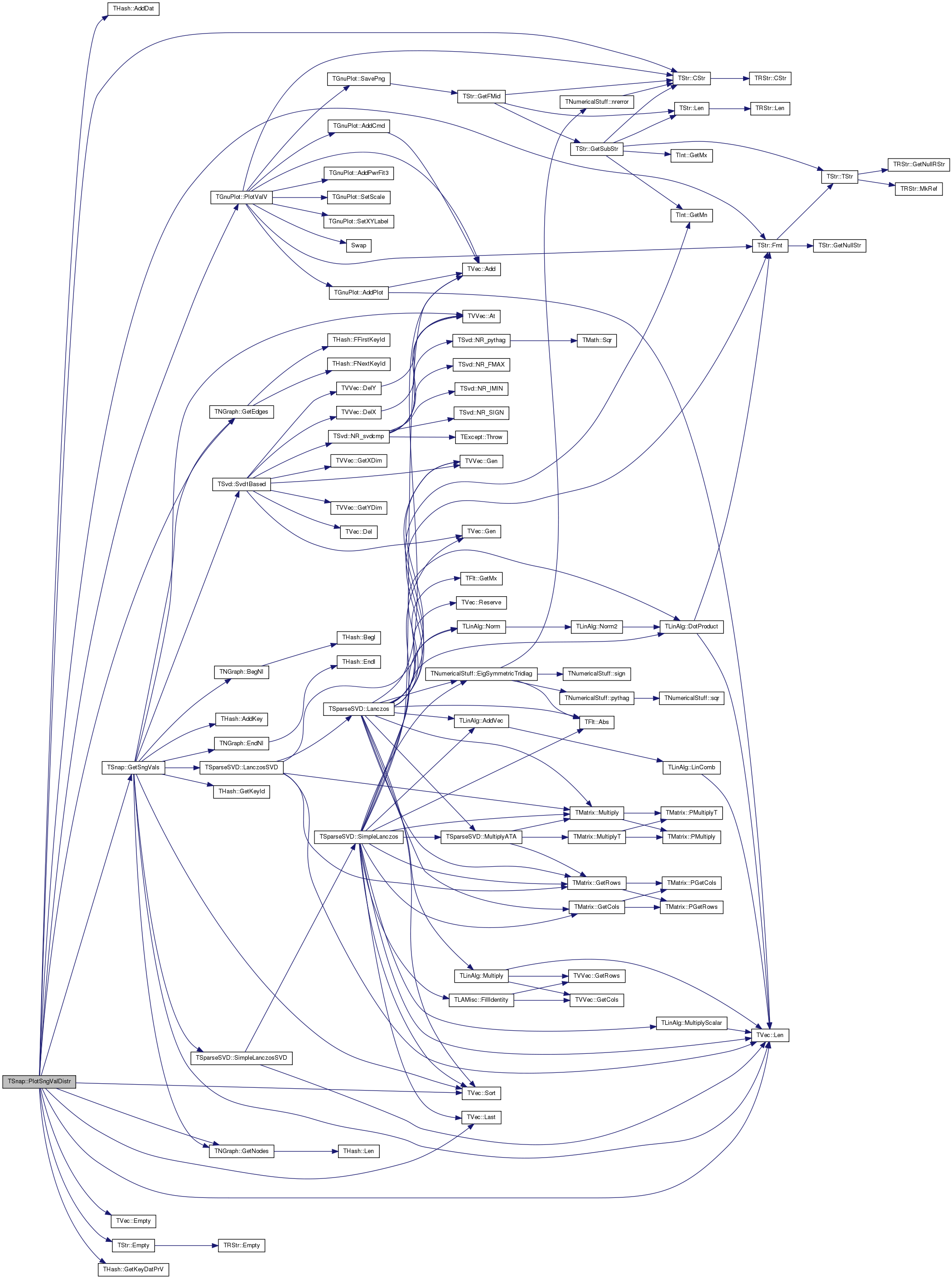
| void TSnap::PlotSngValRank | ( | const PNGraph & | Graph, |
| const int & | SngVals, | ||
| const TStr & | FNmPref, | ||
| TStr | DescStr | ||
| ) |
Plots the rank distribution of singular values of the Graph adjacency matrix. Plots first SngVals values.
Definition at line 49 of file statplot.cpp.
References TStr::CStr(), TStr::Empty(), TStr::Fmt(), TNGraph::GetEdges(), TNGraph::GetNodes(), GetSngVals(), gpsLog10XY, gpwLinesPoints, TGnuPlot::PlotValV(), and TVec< TVal >::Sort().
{
TFltV SngValV;
TSnap::GetSngVals(Graph, SngVals, SngValV);
SngValV.Sort(false);
if (DescStr.Empty()) { DescStr = FNmPref; }
TGnuPlot::PlotValV(SngValV, "sngVal."+FNmPref, TStr::Fmt("%s. G(%d, %d). Largest eig val = %f",
DescStr.CStr(), Graph->GetNodes(), Graph->GetEdges(), SngValV[0].Val), "Rank", "Singular value", gpsLog10XY, false, gpwLinesPoints);
}
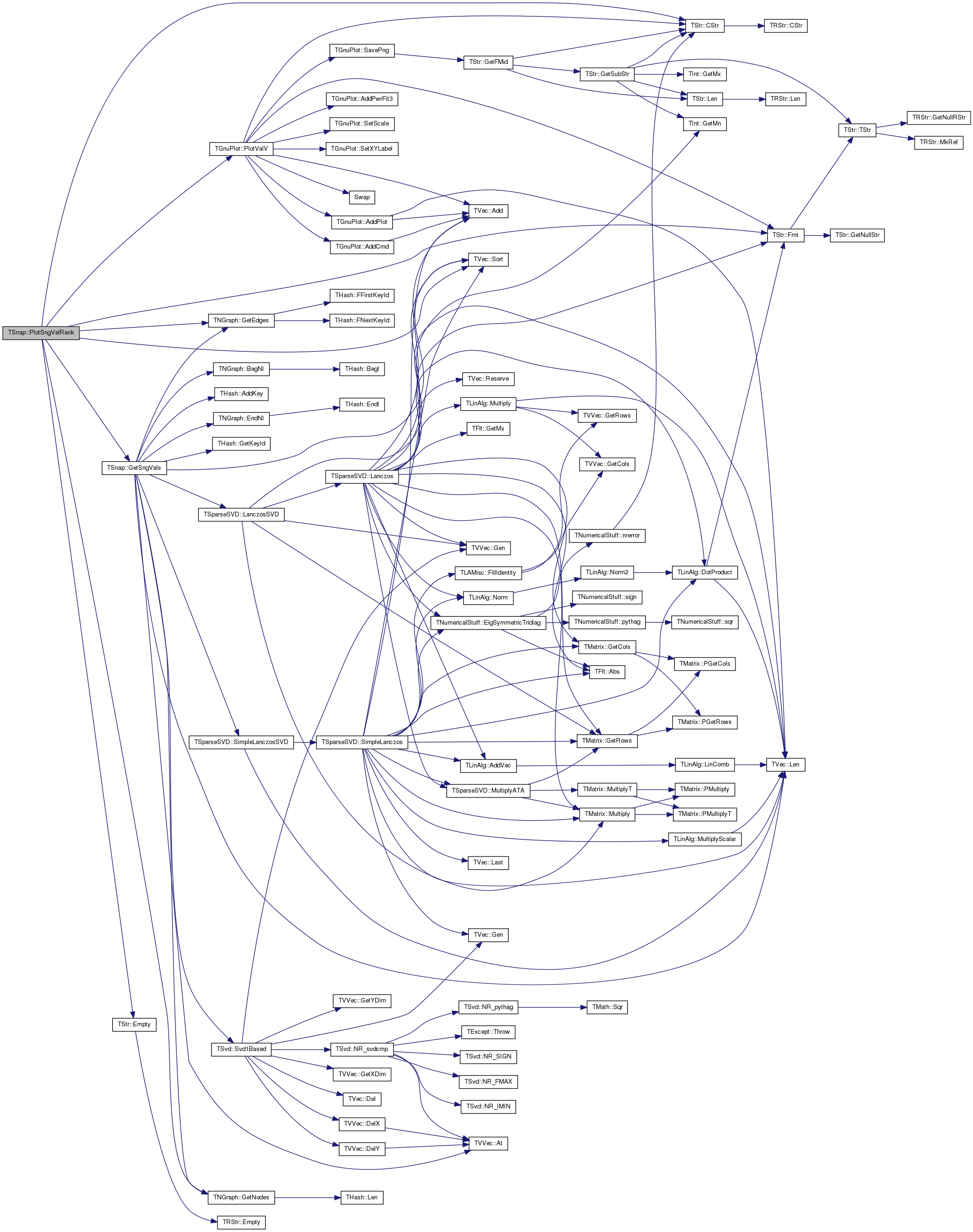
| void TSnap::PlotSngVec | ( | const PNGraph & | Graph, |
| const TStr & | FNmPref, | ||
| TStr | DescStr | ||
| ) |
Plots the distribution of the values of the leading left singular vector of the Graph adjacency matrix. Plots first SngVals values.
Definition at line 81 of file statplot.cpp.
References TStr::CStr(), TStr::Empty(), TStr::Fmt(), TNGraph::GetEdges(), TNGraph::GetNodes(), GetSngVec(), gpsLog10XY, gpwLinesPoints, TGUtil::MakeExpBins(), TGnuPlot::PlotValV(), and TVec< TVal >::Sort().
{
TFltV LeftSV, RightSV;
TSnap::GetSngVec(Graph, LeftSV, RightSV);
LeftSV.Sort(false);
RightSV.Sort(false);
TFltV BinV;
if (DescStr.Empty()) { DescStr = FNmPref; }
TGUtil::MakeExpBins(LeftSV, BinV, 1.01);
TGnuPlot::PlotValV(BinV, "sngVecL."+FNmPref, TStr::Fmt("%s. G(%d, %d). Left signular vector",
DescStr.CStr(), Graph->GetNodes(), Graph->GetEdges()), "Rank", "Component of left singular vector", gpsLog10XY, false, gpwLinesPoints);
TGnuPlot::PlotValV(BinV, "sngVecL."+FNmPref, TStr::Fmt("%s. G(%d, %d). Right signular vector",
DescStr.CStr(), Graph->GetNodes(), Graph->GetEdges()), "Rank", "Component of right singular vector", gpsLog10XY, false, gpwLinesPoints);
}
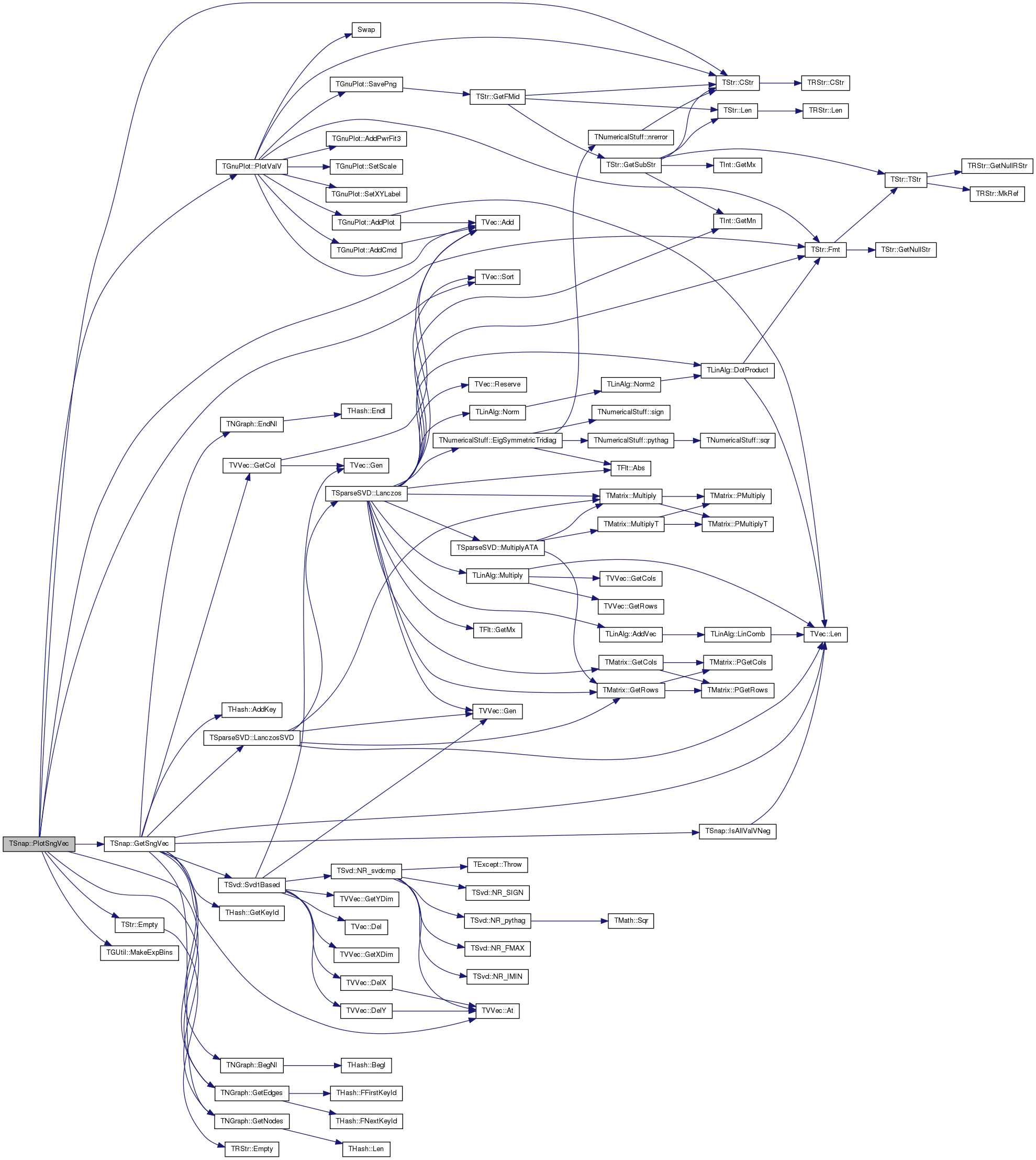
| void TSnap::PlotWccDistr | ( | const PGraph & | Graph, |
| const TStr & | FNmPref, | ||
| TStr | DescStr = TStr() |
||
| ) |
Plots the distribution of sizes of weakly connected components of a Graph.
Definition at line 81 of file statplot.h.
References TGnuPlot::AddPlot(), TStr::CStr(), TStr::Empty(), TStr::Fmt(), GetWccSzCnt(), gpsLog10XY, gpwLinesPoints, TVec< TVal >::Last(), and TPair< TVal1, TVal2 >::Val1.
{
TIntPrV WccSzCnt;
TSnap::GetWccSzCnt(Graph, WccSzCnt);
if (DescStr.Empty()) { DescStr = FNmPref; }
TGnuPlot GnuPlot("wcc."+FNmPref, TStr::Fmt("%s. G(%d, %d). Largest component has %f nodes",
DescStr.CStr(), Graph->GetNodes(), Graph->GetEdges(), WccSzCnt.Last().Val1/double(Graph->GetNodes())));
GnuPlot.AddPlot(WccSzCnt, gpwLinesPoints, "", "pt 6");
GnuPlot.SetXYLabel("Size of weakly connected component", "Number of components");
GnuPlot.SetScale(gpsLog10XY);
GnuPlot.SavePng();
}
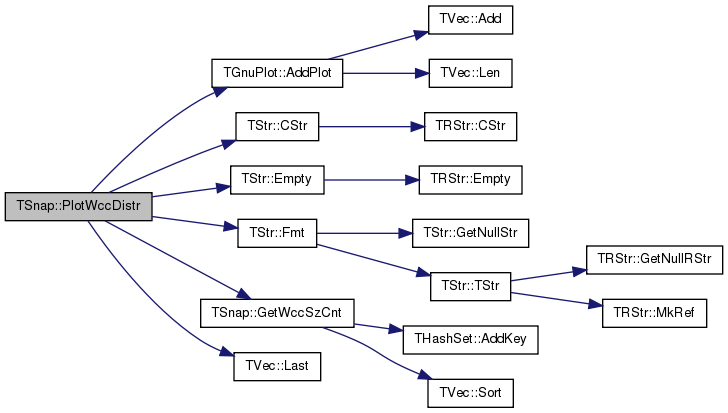
| void TSnap::PrintInfo | ( | const PGraph & | Graph, |
| const TStr & | Desc = "", |
||
| const TStr & | OutFNm = "", |
||
| const bool & | Fast = true |
||
| ) |
Prints basic graph statistics.
| Fast | true: only computes basic statistics (that can be computed fast). For more extensive information (and longer execution times) set Fast = false. |
Definition at line 73 of file gbase.h.
References THash< TKey, TDat, THashFunc >::AddKey(), TStr::CStr(), TStr::Empty(), GetFlagStr(), TInt::GetMn(), TInt::GetMx(), GetTriads(), gfMx, gfUndef, HasGraphFlag, and THash< TKey, TDat, THashFunc >::Len().
Referenced by main(), and TKronMomentsFit::Test().
{
int BiDirEdges=0, ZeroNodes=0, ZeroInNodes=0, ZeroOutNodes=0, SelfEdges=0, NonZIODegNodes=0;
THash<TIntPr, TInt> UniqDirE, UniqUnDirE;
FILE *F = stdout;
if (! OutFNm.Empty()) F = fopen(OutFNm.CStr(), "wt");
if (! Desc.Empty()) { fprintf(F, "%s:", Desc.CStr()); }
else { fprintf(F, "Graph:"); }
for (int f = gfUndef; f < gfMx; f++) {
if (HasGraphFlag(typename PGraph::TObj, TGraphFlag(f))) {
fprintf(F, " %s", TSnap::GetFlagStr(TGraphFlag(f)).CStr()); }
}
// calc stat
for (typename PGraph::TObj::TNodeI NI = Graph->BegNI(); NI < Graph->EndNI(); NI++) {
if (NI.GetDeg()==0) ZeroNodes++;
if (NI.GetInDeg()==0) ZeroInNodes++;
if (NI.GetOutDeg()==0) ZeroOutNodes++;
if (NI.GetInDeg()!=0 && NI.GetOutDeg()!=0) NonZIODegNodes++;
if (! Fast || Graph->GetNodes() < 1000) {
const int NId = NI.GetId();
for (int edge = 0; edge < NI.GetOutDeg(); edge++) {
const int DstNId = NI.GetOutNId(edge);
if (Graph->IsEdge(DstNId, NId)) BiDirEdges++;
if (NId == DstNId) SelfEdges++;
UniqDirE.AddKey(TIntPr(NId, DstNId));
UniqUnDirE.AddKey(TIntPr(TInt::GetMn(NId, DstNId), TInt::GetMx(NId, DstNId)));
}
}
}
int Closed=0, Open=0;
if (! Fast) { TSnap::GetTriads(Graph, Closed, Open); }
// print info
fprintf(F, "\n");
fprintf(F, " Nodes: %d\n", Graph->GetNodes());
fprintf(F, " Edges: %d\n", Graph->GetEdges());
fprintf(F, " Zero Deg Nodes: %d\n", ZeroNodes);
fprintf(F, " Zero InDeg Nodes: %d\n", ZeroInNodes);
fprintf(F, " Zero OutDeg Nodes: %d\n", ZeroOutNodes);
fprintf(F, " NonZero In-Out Deg Nodes: %d\n", NonZIODegNodes);
if (! Fast) {
fprintf(F, " Unique directed edges: %d\n", UniqDirE.Len());
fprintf(F, " Unique undirected edges: %d\n", UniqUnDirE.Len());
fprintf(F, " Self Edges: %d\n", SelfEdges);
fprintf(F, " BiDir Edges: %d\n", BiDirEdges);
fprintf(F, " Closed triangles %d\n", Closed);
fprintf(F, " Open triangles %d\n", Open);
fprintf(F, " Frac. of closed triads %f\n", Closed/double(Closed+Open));
}
if (! OutFNm.Empty()) { fclose(F); }
}
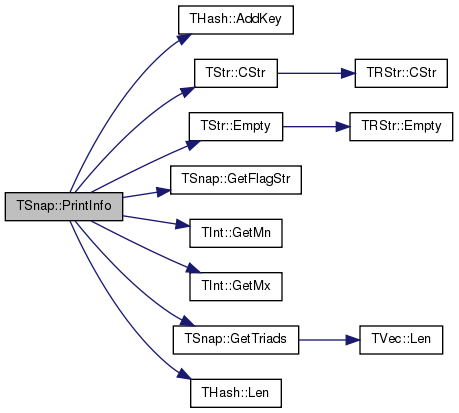

| void TSnap::SaveEdgeList | ( | const PGraph & | Graph, |
| const TStr & | OutFNm, | ||
| const TStr & | Desc = TStr() |
||
| ) |
Saves a graph into a text file. Each line contains two columns and encodes a single edge: <source node="" id>=""><tab><destination node="" id>="">
Definition at line 227 of file gio.h.
References TStr::CStr(), TStr::Empty(), gfDirected, and HasGraphFlag.
Referenced by main().
{
FILE *F = fopen(OutFNm.CStr(), "wt");
if (HasGraphFlag(typename PGraph::TObj, gfDirected)) { fprintf(F, "# Directed graph: %s \n", OutFNm.CStr()); }
else { fprintf(F, "# Undirected graph (each unordered pair of nodes is saved once): %s\n", OutFNm.CStr()); }
if (! Desc.Empty()) { fprintf(F, "# %s\n", Desc.CStr()); }
fprintf(F, "# Nodes: %d Edges: %d\n", Graph->GetNodes(), Graph->GetEdges());
if (HasGraphFlag(typename PGraph::TObj, gfDirected)) { fprintf(F, "# FromNodeId\tToNodeId\n"); }
else { fprintf(F, "# NodeId\tNodeId\n"); }
for (typename PGraph::TObj::TEdgeI ei = Graph->BegEI(); ei < Graph->EndEI(); ei++) {
fprintf(F, "%d\t%d\n", ei.GetSrcNId(), ei.GetDstNId());
}
fclose(F);
}


| void TSnap::SaveGViz | ( | const PGraph & | Graph, |
| const TStr & | OutFNm, | ||
| const TStr & | Desc = TStr(), |
||
| const bool & | NodeLabels = false, |
||
| const TIntStrH & | NIdColorH = TIntStrH() |
||
| ) |
Save a graph in GraphVizp .DOT format.
Save a graph in GraphVizp .DOT format.
| NIdColorH | Maps node ids to node colors (see GraphViz documentation for more details). |
Definition at line 369 of file gio.h.
References TStr::CStr(), TStr::Empty(), THash< TKey, TDat, THashFunc >::GetDat(), gfDirected, HasGraphFlag, and THash< TKey, TDat, THashFunc >::IsKey().
Referenced by DrawGViz().
{
const bool IsDir = HasGraphFlag(typename PGraph::TObj, gfDirected);
FILE *F = fopen(OutFNm.CStr(), "wt");
if (! Desc.Empty()) fprintf(F, "/*****\n%s\n*****/\n\n", Desc.CStr());
if (IsDir) { fprintf(F, "digraph G {\n"); } else { fprintf(F, "graph G {\n"); }
fprintf(F, " graph [splines=false overlap=false]\n"); //size=\"12,10\" ratio=fill
// node [width=0.3, height=0.3, label=\"\", style=filled, color=black]
// node [shape=box, width=0.3, height=0.3, label=\"\", style=filled, fillcolor=red]
fprintf(F, " node [shape=ellipse, width=0.3, height=0.3%s]\n", NodeLabels?"":", label=\"\"");
// node colors
//for (int i = 0; i < NIdColorH.Len(); i++) {
for (typename PGraph::TObj::TNodeI NI = Graph->BegNI(); NI < Graph->EndNI(); NI++) {
if (NIdColorH.IsKey(NI.GetId())) {
fprintf(F, " %d [style=filled, fillcolor=\"%s\"];\n", NI.GetId(), NIdColorH.GetDat(NI.GetId()).CStr()); }
else {
fprintf(F, " %d ;\n", NI.GetId());
}
}
// edges
for (typename PGraph::TObj::TNodeI NI = Graph->BegNI(); NI < Graph->EndNI(); NI++) {
if (NI.GetOutDeg()==0 && NI.GetInDeg()==0 && !NIdColorH.IsKey(NI.GetId())) {
fprintf(F, "%d;\n", NI.GetId()); }
else {
for (int e = 0; e < NI.GetOutDeg(); e++) {
if (! IsDir && NI.GetId() > NI.GetOutNId(e)) { continue; }
fprintf(F, " %d %s %d;\n", NI.GetId(), IsDir?"->":"--", NI.GetOutNId(e));
}
}
}
if (! Desc.Empty()) {
fprintf(F, " label = \"\\n%s\\n\";", Desc.CStr());
fprintf(F, " fontsize=24;\n");
}
fprintf(F, "}\n");
fclose(F);
}
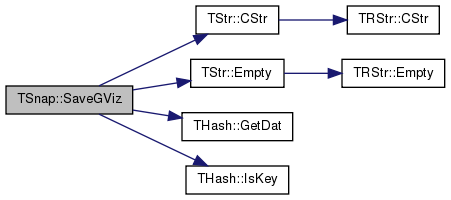

| void TSnap::SaveGViz | ( | const PGraph & | Graph, |
| const TStr & | OutFNm, | ||
| const TStr & | Desc, | ||
| const TIntStrH & | NIdLabelH | ||
| ) |
Save a graph in GraphVizp .DOT format.
Save a graph in GraphVizp .DOT format.
| NIdLabelH | Maps node ids to node string labels. |
Definition at line 407 of file gio.h.
References TStr::CStr(), TStr::Empty(), THash< TKey, TDat, THashFunc >::GetDat(), gfDirected, and THash< TKey, TDat, THashFunc >::IsKey().
{
const bool IsDir = Graph->HasFlag(gfDirected);
FILE *F = fopen(OutFNm.CStr(), "wt");
if (! Desc.Empty()) fprintf(F, "/*****\n%s\n*****/\n\n", Desc.CStr());
if (IsDir) { fprintf(F, "digraph G {\n"); } else { fprintf(F, "graph G {\n"); }
fprintf(F, " graph [splines=true overlap=false]\n"); //size=\"12,10\" ratio=fill
fprintf(F, " node [shape=ellipse, width=0.3, height=0.3]\n");
// node colors
//for (int i = 0; i < NodeLabelH.Len(); i++) {
for (typename PGraph::TObj::TNodeI NI = Graph->BegNI(); NI < Graph->EndNI(); NI++) {
fprintf(F, " %d [label=\"%s\"];\n", NI.GetId(), NIdLabelH.GetDat(NI.GetId()).CStr());
}
// edges
for (typename PGraph::TObj::TNodeI NI = Graph->BegNI(); NI < Graph->EndNI(); NI++) {
if (NI.GetOutDeg()==0 && NI.GetInDeg()==0 && ! NIdLabelH.IsKey(NI.GetId())) {
fprintf(F, "%d;\n", NI.GetId()); }
else {
for (int e = 0; e < NI.GetOutDeg(); e++) {
if (! IsDir && NI.GetId() > NI.GetOutNId(e)) { continue; }
fprintf(F, " %d %s %d;\n", NI.GetId(), IsDir?"->":"--", NI.GetOutNId(e));
}
}
}
if (! Desc.Empty()) {
fprintf(F, " label = \"\\n%s\\n\";", Desc.CStr());
fprintf(F, " fontsize=24;\n");
}
fprintf(F, "}\n");
fclose(F);
}
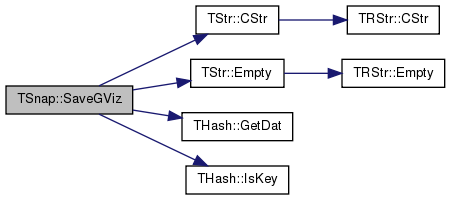
| void TSnap::SaveMatlabSparseMtx | ( | const PGraph & | Graph, |
| const TStr & | OutFNm | ||
| ) |
Saves a graph in a MATLAB sparse matrix format.
Each line contains a tuple of 3 values: <source node="" id>=""><tab><destination node="" id>=""><tab>1.
Definition at line 351 of file gio.h.
References THashSet< TKey, THashFunc >::AddKey(), TStr::CStr(), gfDirected, and HasGraphFlag.
{
FILE *F = fopen(OutFNm.CStr(), "wt");
TIntSet NIdSet(Graph->GetNodes()); // so that
for (typename PGraph::TObj::TNodeI NI = Graph->BegNI(); NI < Graph->EndNI(); NI++) {
NIdSet.AddKey(NI.GetId());
}
for (typename PGraph::TObj::TEdgeI EI = Graph->BegEI(); EI < Graph->EndEI(); EI++) {
const int Src = NIdSet.GetKeyId(EI.GetSrcNId())+1;
const int Dst = NIdSet.GetKeyId(EI.GetDstNId())+1;
fprintf(F, "%d\t%d\t1\n", Src, Dst);
if (! HasGraphFlag(typename PGraph::TObj, gfDirected) && Src!=Dst) {
fprintf(F, "%d\t%d\t1\n", Dst, Src);
}
}
fclose(F);
}

| void TSnap::SavePajek | ( | const PGraph & | Graph, |
| const TStr & | OutFNm | ||
| ) |
Saves a graph in a Pajek .NET format.
Definition at line 242 of file gio.h.
References THash< TKey, TDat, THashFunc >::AddDat(), TStr::CStr(), gfDirected, and HasGraphFlag.
{
TIntH NIdToIdH(Graph->GetNodes(), true);
FILE *F = fopen(OutFNm.CStr(), "wt");
fprintf(F, "*Vertices %d\n", Graph->GetNodes());
int i = 0;
for (typename PGraph::TObj::TNodeI NI = Graph->BegNI(); NI < Graph->EndNI(); NI++, i++) {
fprintf(F, "%d \"%d\" ic Red fos 10\n", i+1, NI.GetId()); // ic: internal color, fos: font size
NIdToIdH.AddDat(NI.GetId(), i+1);
}
if (HasGraphFlag(typename PGraph::TObj, gfDirected)) {
fprintf(F, "*Arcs %d\n", Graph->GetEdges()); } // arcs are directed, edges are undirected
else {
fprintf(F, "*Edges %d\n", Graph->GetEdges());
}
for (typename PGraph::TObj::TEdgeI EI = Graph->BegEI(); EI < Graph->EndEI(); EI++) {
const int SrcNId = NIdToIdH.GetDat(EI.GetSrcNId());
const int DstNId = NIdToIdH.GetDat(EI.GetDstNId());
fprintf(F, "%d %d %d c Black\n", SrcNId, DstNId, 1); // width=1
}
fclose(F);
}

| void TSnap::SavePajek | ( | const PGraph & | Graph, |
| const TStr & | OutFNm, | ||
| const TIntStrH & | NIdColorH | ||
| ) |
Saves a graph in a Pajek .NET format.
NIdColorH maps node ids to node colors. Default node color is Red. See http://vlado.fmf.uni-lj.si/pub/networks/pajek/doc/pajekman.pdf for a list of supported color names.
Definition at line 267 of file gio.h.
References THash< TKey, TDat, THashFunc >::AddDat(), TStr::CStr(), THash< TKey, TDat, THashFunc >::GetDat(), gfDirected, HasGraphFlag, and THash< TKey, TDat, THashFunc >::IsKey().
{
TIntH NIdToIdH(Graph->GetNodes(), true);
FILE *F = fopen(OutFNm.CStr(), "wt");
fprintf(F, "*Vertices %d\n", Graph->GetNodes());
int i = 0;
for (typename PGraph::TObj::TNodeI NI = Graph->BegNI(); NI < Graph->EndNI(); NI++, i++) {
fprintf(F, "%d \"%d\" ic %s fos 10\n", i+1, NI.GetId(),
NIdColorH.IsKey(NI.GetId()) ? NIdColorH.GetDat(NI.GetId()).CStr() : "Red");
NIdToIdH.AddDat(NI.GetId(), i+1);
}
if (HasGraphFlag(typename PGraph::TObj, gfDirected)) {
fprintf(F, "*Arcs %d\n", Graph->GetEdges()); } // arcs are directed, edges are undirected
else {
fprintf(F, "*Edges %d\n", Graph->GetEdges());
}
for (typename PGraph::TObj::TEdgeI EI = Graph->BegEI(); EI < Graph->EndEI(); EI++) {
const int SrcNId = NIdToIdH.GetDat(EI.GetSrcNId());
const int DstNId = NIdToIdH.GetDat(EI.GetDstNId());
fprintf(F, "%d %d %d c Black\n", SrcNId, DstNId, 1);
}
fclose(F);
}
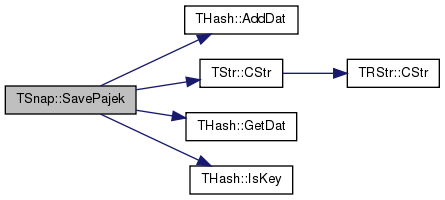
| void TSnap::SavePajek | ( | const PGraph & | Graph, |
| const TStr & | OutFNm, | ||
| const TIntStrH & | NIdColorH, | ||
| const TIntStrH & | NIdLabelH | ||
| ) |
Saves a graph in a Pajek .NET format.
NIdColorH maps node ids to node colors. Default node color is Red. NIdLabelH maps node ids to node string labels. See http://vlado.fmf.uni-lj.si/pub/networks/pajek/doc/pajekman.pdf for a list of supported color names.
Definition at line 294 of file gio.h.
References THash< TKey, TDat, THashFunc >::AddDat(), TStr::CStr(), TStr::Fmt(), THash< TKey, TDat, THashFunc >::GetDat(), gfDirected, HasGraphFlag, and THash< TKey, TDat, THashFunc >::IsKey().
{
TIntH NIdToIdH(Graph->GetNodes(), true);
FILE *F = fopen(OutFNm.CStr(), "wt");
fprintf(F, "*Vertices %d\n", Graph->GetNodes());
int i = 0;
for (typename PGraph::TObj::TNodeI NI = Graph->BegNI(); NI < Graph->EndNI(); NI++, i++) {
fprintf(F, "%d \"%s\" ic %s fos 10\n", i+1,
NIdLabelH.IsKey(NI.GetId()) ? NIdLabelH.GetDat(NI.GetId()).CStr() : TStr::Fmt("%d", NI.GetId()).CStr(),
NIdColorH.IsKey(NI.GetId()) ? NIdColorH.GetDat(NI.GetId()).CStr() : "Red");
NIdToIdH.AddDat(NI.GetId(), i+1);
}
if (HasGraphFlag(typename PGraph::TObj, gfDirected)) {
fprintf(F, "*Arcs %d\n", Graph->GetEdges()); } // arcs are directed, edges are undirected
else {
fprintf(F, "*Edges %d\n", Graph->GetEdges());
}
for (typename PGraph::TObj::TEdgeI EI = Graph->BegEI(); EI < Graph->EndEI(); EI++) {
const int SrcNId = NIdToIdH.GetDat(EI.GetSrcNId());
const int DstNId = NIdToIdH.GetDat(EI.GetDstNId());
fprintf(F, "%d %d %d c Black\n", SrcNId, DstNId, 1);
}
fclose(F);
}
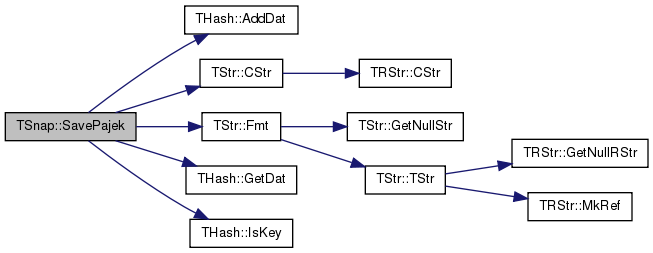
| void TSnap::SavePajek | ( | const PGraph & | Graph, |
| const TStr & | OutFNm, | ||
| const TIntStrH & | NIdColorH, | ||
| const TIntStrH & | NIdLabelH, | ||
| const TIntStrH & | EIdColorH | ||
| ) |
Saves a graph in a Pajek .NET format.
NIdColorH maps node ids to node colors. Default node color is Red. NIdLabelH maps node ids to node string labels. EIdColorH maps edge ids to node colors. Default edge color is Black. See http://vlado.fmf.uni-lj.si/pub/networks/pajek/doc/pajekman.pdf for a list of supported color names.
Definition at line 323 of file gio.h.
References THash< TKey, TDat, THashFunc >::AddDat(), CAssert, TStr::CStr(), TStr::Fmt(), THash< TKey, TDat, THashFunc >::GetDat(), gfDirected, gfMultiGraph, HasGraphFlag, and THash< TKey, TDat, THashFunc >::IsKey().
{
CAssert(HasGraphFlag(typename PGraph::TObj, gfMultiGraph)); // network needs to have edge ids
TIntH NIdToIdH(Graph->GetNodes(), true);
FILE *F = fopen(OutFNm.CStr(), "wt");
fprintf(F, "*Vertices %d\n", Graph->GetNodes());
int i = 0;
for (typename PGraph::TObj::TNodeI NI = Graph->BegNI(); NI < Graph->EndNI(); NI++, i++) {
fprintf(F, "%d \"%s\" ic %s fos 10\n", i+1,
NIdLabelH.IsKey(NI.GetId()) ? NIdLabelH.GetDat(NI.GetId()).CStr() : TStr::Fmt("%d", NI.GetId()).CStr(),
NIdColorH.IsKey(NI.GetId()) ? NIdColorH.GetDat(NI.GetId()).CStr() : "Red");
NIdToIdH.AddDat(NI.GetId(), i+1);
}
if (HasGraphFlag(typename PGraph::TObj, gfDirected)) {
fprintf(F, "*Arcs %d\n", Graph->GetEdges()); } // arcs are directed, edges are undirected
else {
fprintf(F, "*Edges %d\n", Graph->GetEdges());
}
for (typename PGraph::TObj::TEdgeI EI = Graph->BegEI(); EI < Graph->EndEI(); EI++) {
const int SrcNId = NIdToIdH.GetDat(EI.GetSrcNId());
const int DstNId = NIdToIdH.GetDat(EI.GetDstNId());
fprintf(F, "%d %d 1 c %s\n", SrcNId, DstNId, 1,
EIdColorH.IsKey(EI.GetId()) ? EIdColorH.GetDat(EI.GetId()).CStr() : "Black");
}
fclose(F);
}
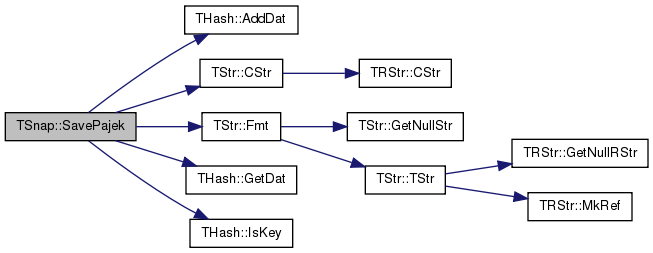
| void TSnap::SetAllInvertSign | ( | TFltV & | ValV, |
| const double & | Val | ||
| ) |
Definition at line 158 of file gsvd.cpp.
References TVec< TVal >::Len().
{
for (int i = 0; i < ValV.Len(); i++) {
ValV[i] = -ValV[i];
}
}

| void TSnap::TestAnf | ( | ) |
Definition at line 241 of file anf.h.
References TVec< TVal >::Add(), TGraphAnf< PGraph >::GetGraphAnf(), TMom::GetMean(), TMom::GetSDev(), TVec< TVal >::Last(), and TVec< TVal >::Len().
{
PGraph Graph = PGraph::TObj::New();
//Graph:
// 0 2 ----> 3
// ^ |
// | |
// | ^
// 1 5 <---- 4
for (int v = 0; v < 6; v++) { Graph->AddNode(v); }
Graph->AddEdge(2, 3);
Graph->AddEdge(3, 4);
Graph->AddEdge(4, 5);
Graph->AddEdge(5, 2);
TFltV AnfV;
for (int t = 0; t < 10; t++) {
TGraphAnf<PGraph> Anf(Graph, 128, 5, t+1);
TIntFltKdV DistToNbrsV;
Anf.GetGraphAnf(DistToNbrsV, 5, true);
printf("\n--seed: %d---------------------\n", t+1);
for (int i = 0; i < DistToNbrsV.Len(); i++) {
printf("dist: %d\t hops:%f\n", DistToNbrsV[i].Key(), DistToNbrsV[i].Dat());
}
AnfV.Add(DistToNbrsV.Last().Dat);
}
TMom Mom(AnfV);
printf("-----------\nAvgAnf: %f StDev: %f\n", Mom.GetMean(), Mom.GetSDev());//*/
// const int NApprox = 32;
/*printf("\nANF vs. SAMPLE diam test (10 runs of ANF, NApprox=%d):\n", NApprox);
//Graph = TGGen<PGraph>::GenGrid(20, 20);
Graph = TGAlg::GetMxWcc(TGGen<PGraph>::GenRnd(1000, 10000));
TFltV FullAnf, EffAnf;
for (int tryn = 0; tryn < 10; tryn++) {
FullAnf.Add(GetEffDiam(Graph, false, 1.0, NApprox));
EffAnf.Add(GetEffDiam(Graph, false, 0.9, NApprox));
}
TMom FullMom(FullAnf);
TMom AnfMom(EffAnf);
printf(" Sample FullDiam: %d\n", TGAlg::GetBfsFullDiam(Graph, 100, false));
printf(" Anf FullDiam: %f [%f]\n", FullMom.GetMean(), FullMom.GetSDev());
printf(" Sample EffDiam [90%%]: %f\n", TGAlg::GetBfsEffDiam(Graph, 100, false));
printf(" Anf EffDiam [90%%]: %f [%f]\n", AnfMom.GetMean(), AnfMom.GetSDev());
// epinions
printf("\nEpinions graph:\n");
{ typedef PNGraph PGraph;
PGraph G = TGGen<PGraph>::GenEpinions();
TIntFltKdV DistToPairsV;
GetAnf(G, DistToPairsV, 50, true);
for(int i = 0; i < DistToPairsV.Len(); i++) {
printf("\t%d\t%f\n", DistToPairsV[i].Key, DistToPairsV[i].Dat); }
printf("\nUndir\n");
TAnf<PGraph>::GetAnf(G, DistToPairsV, 50, false);
for(int j = 0; j < DistToPairsV.Len(); j++) {
printf("\t%d\t%f\n", DistToPairsV[j].Key, DistToPairsV[j].Dat); }
}//*/
}
